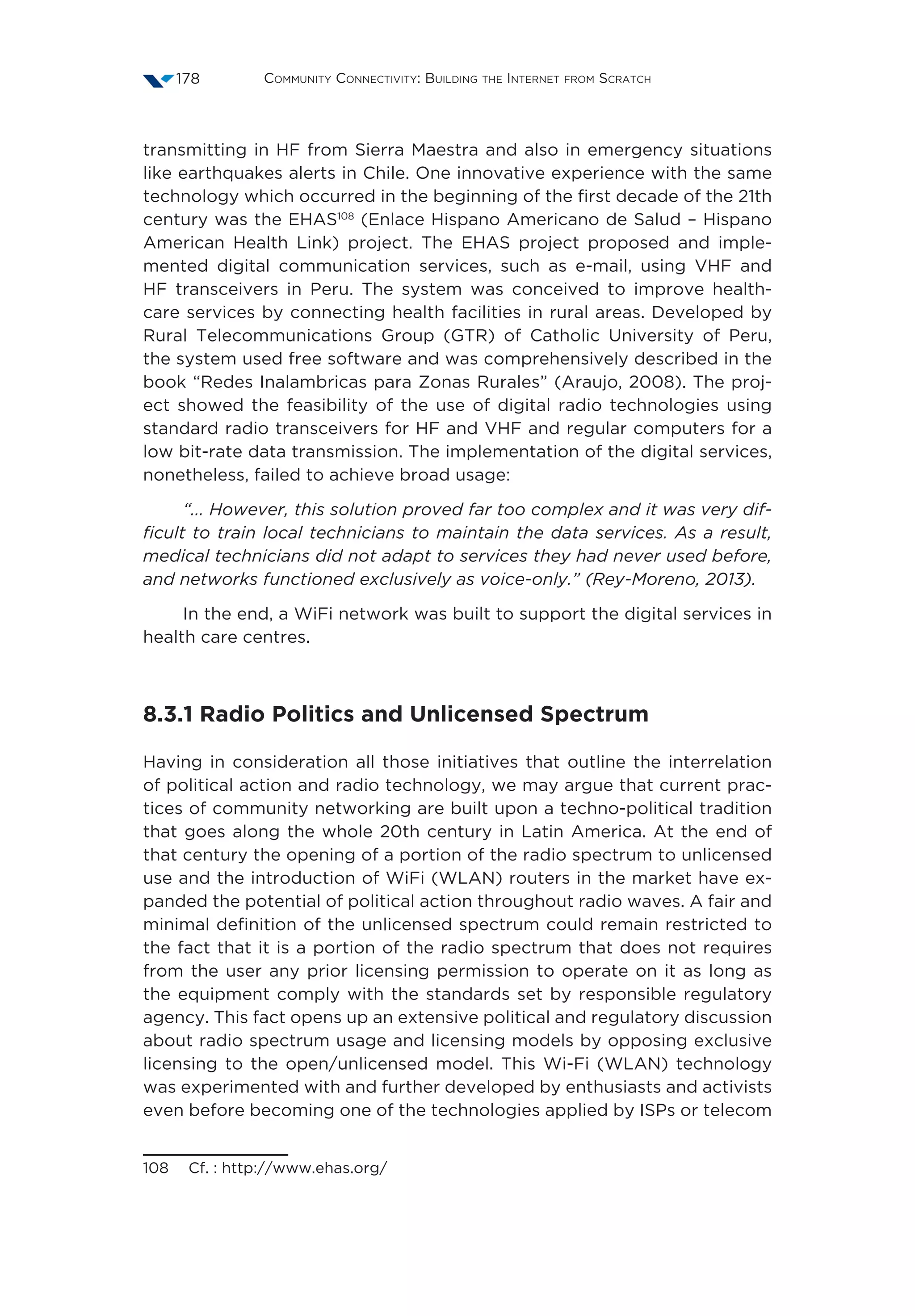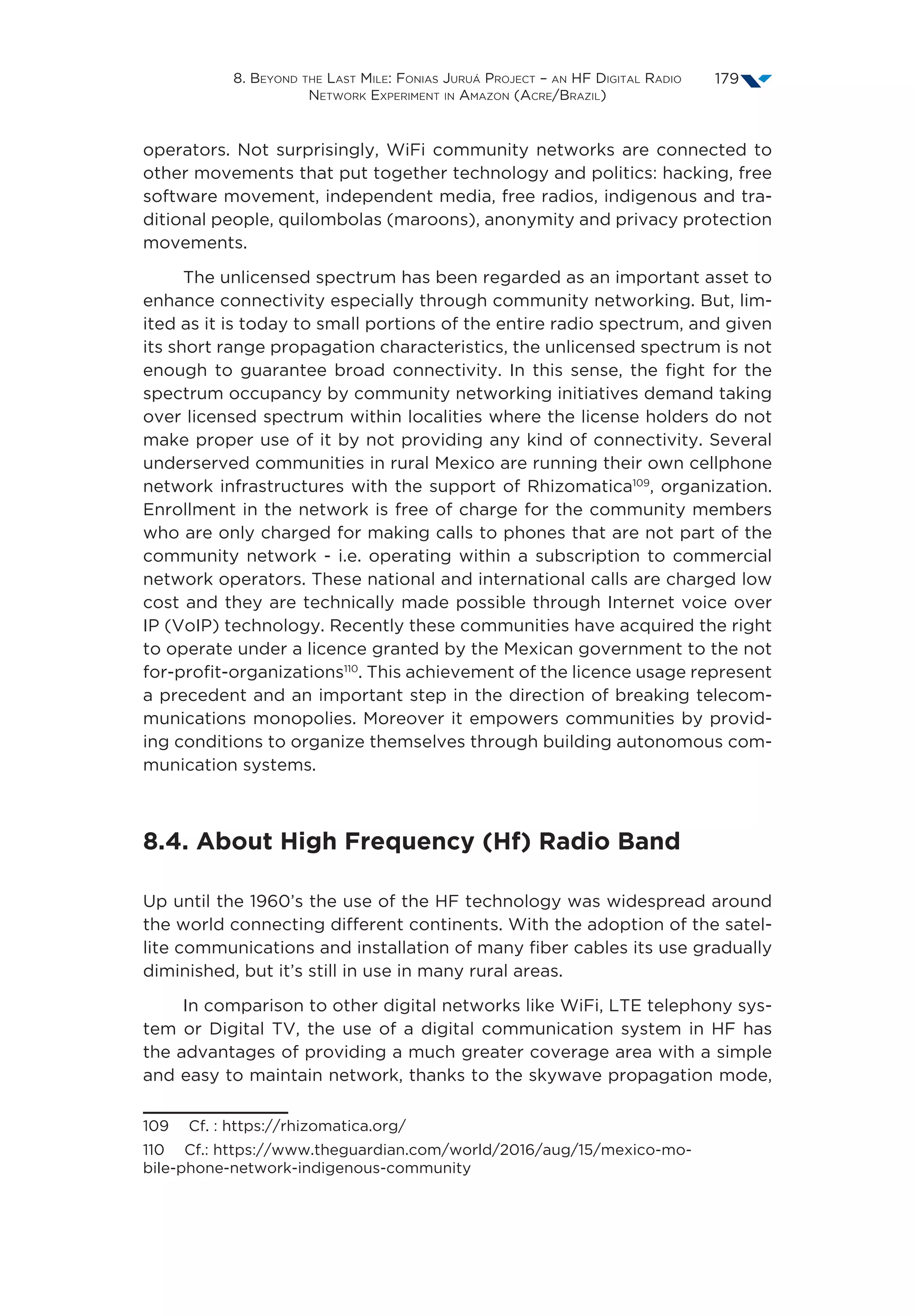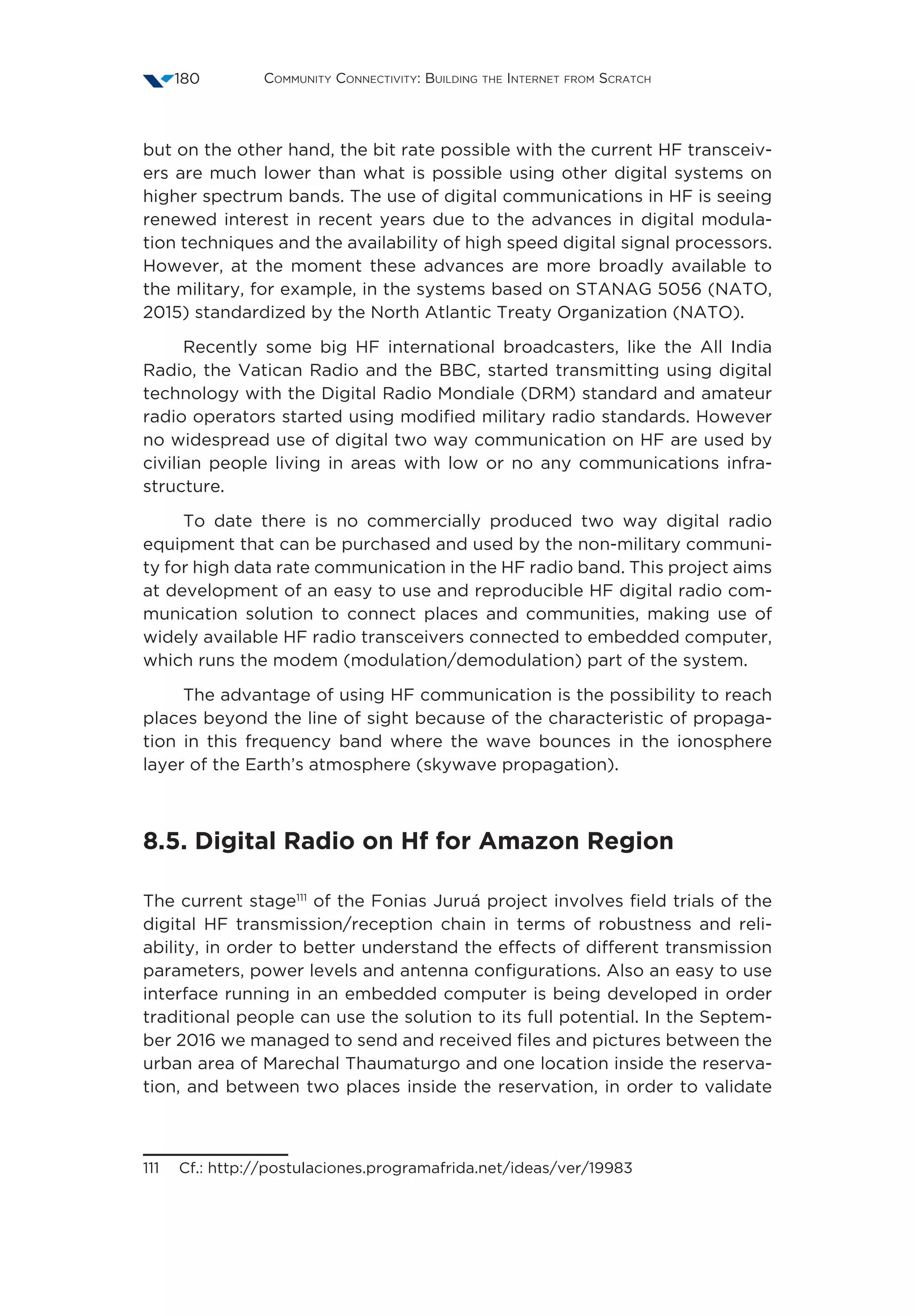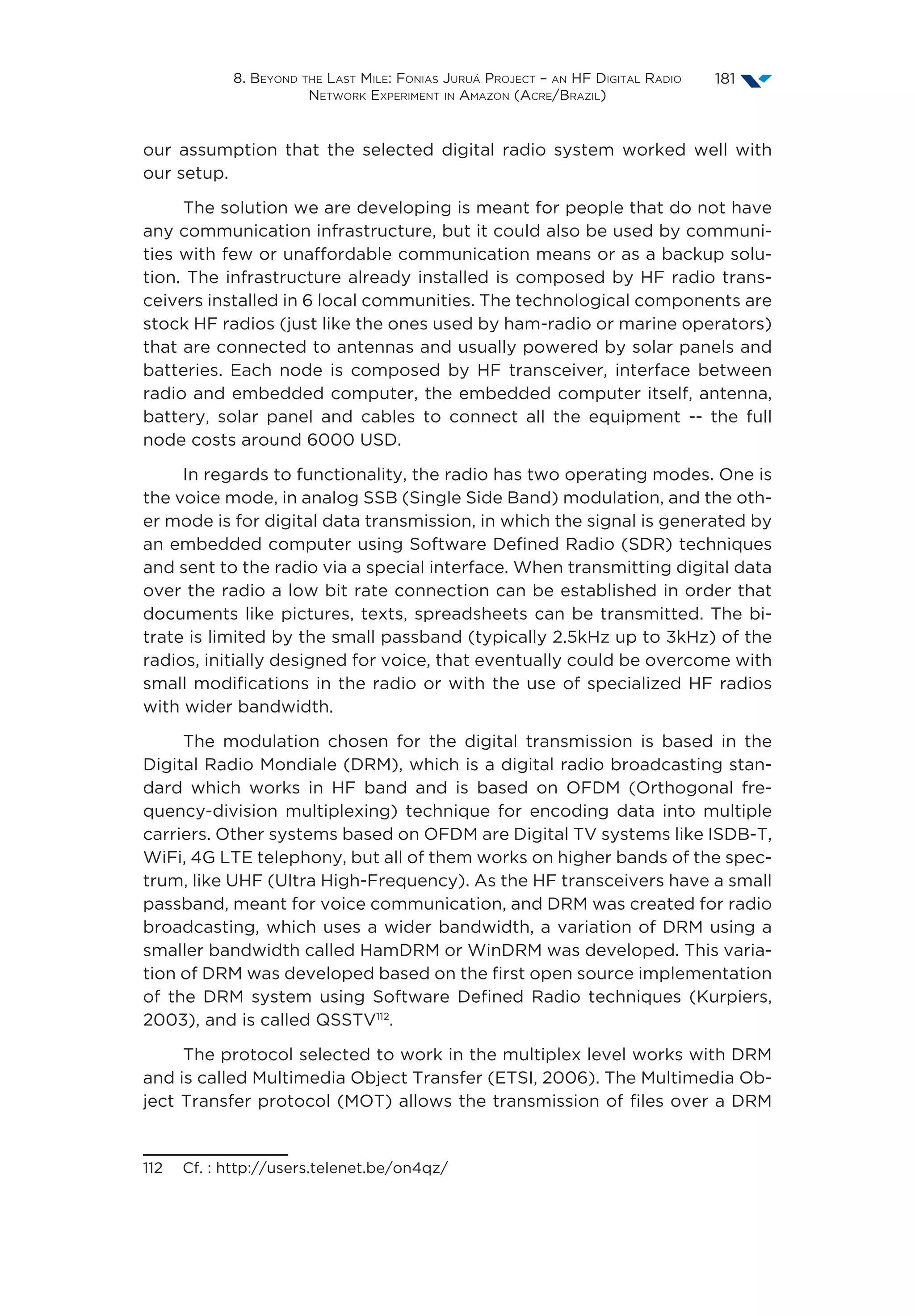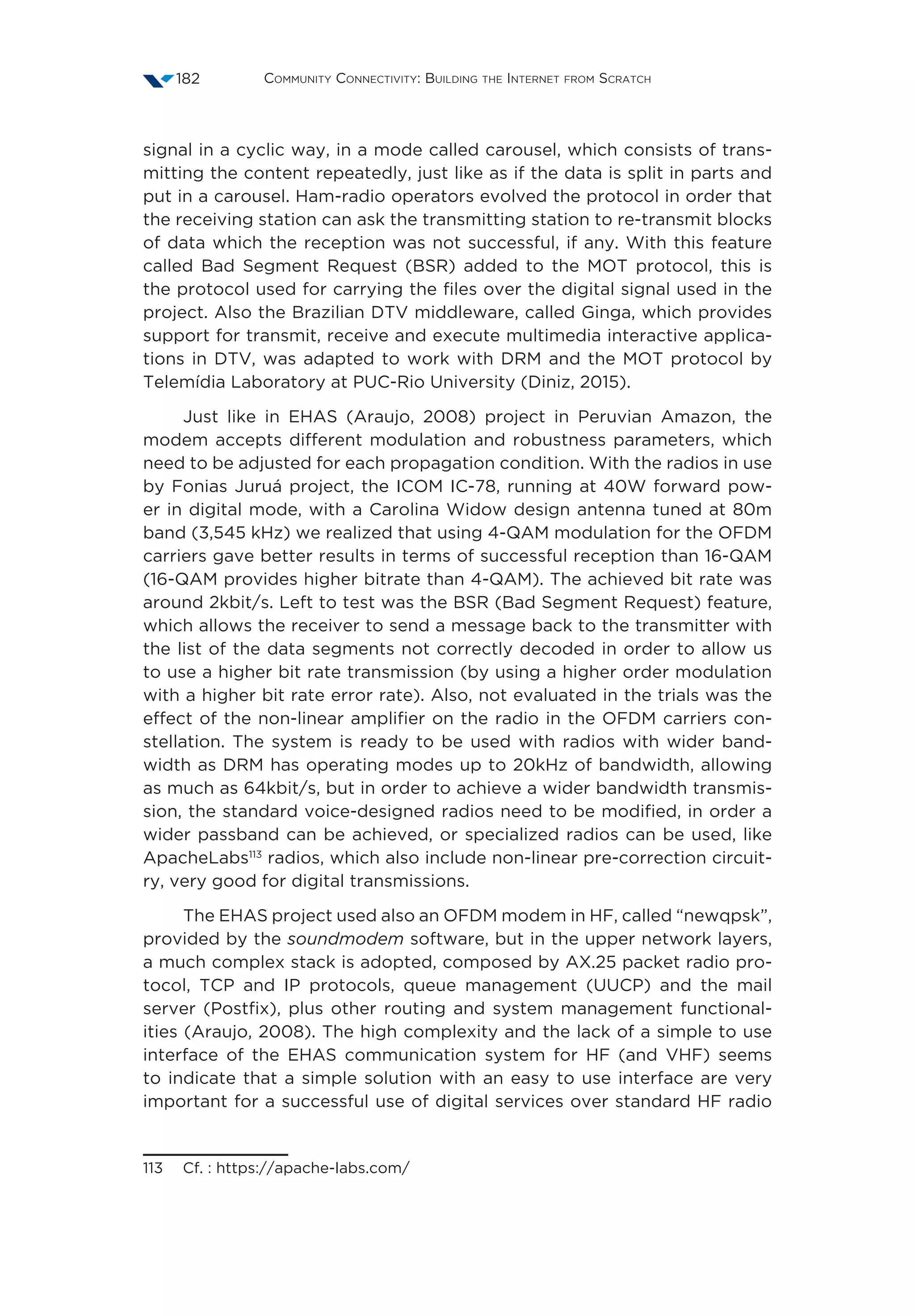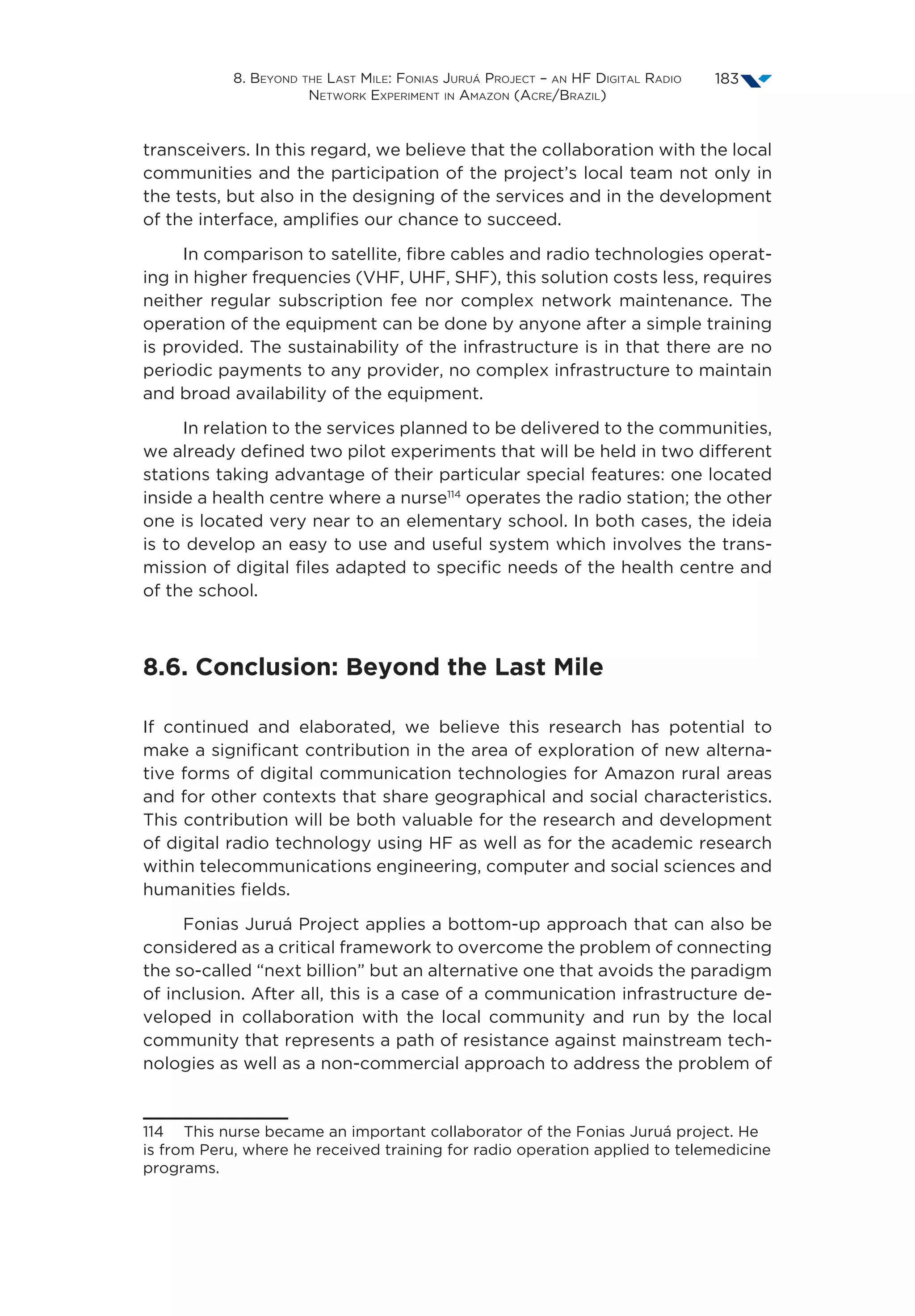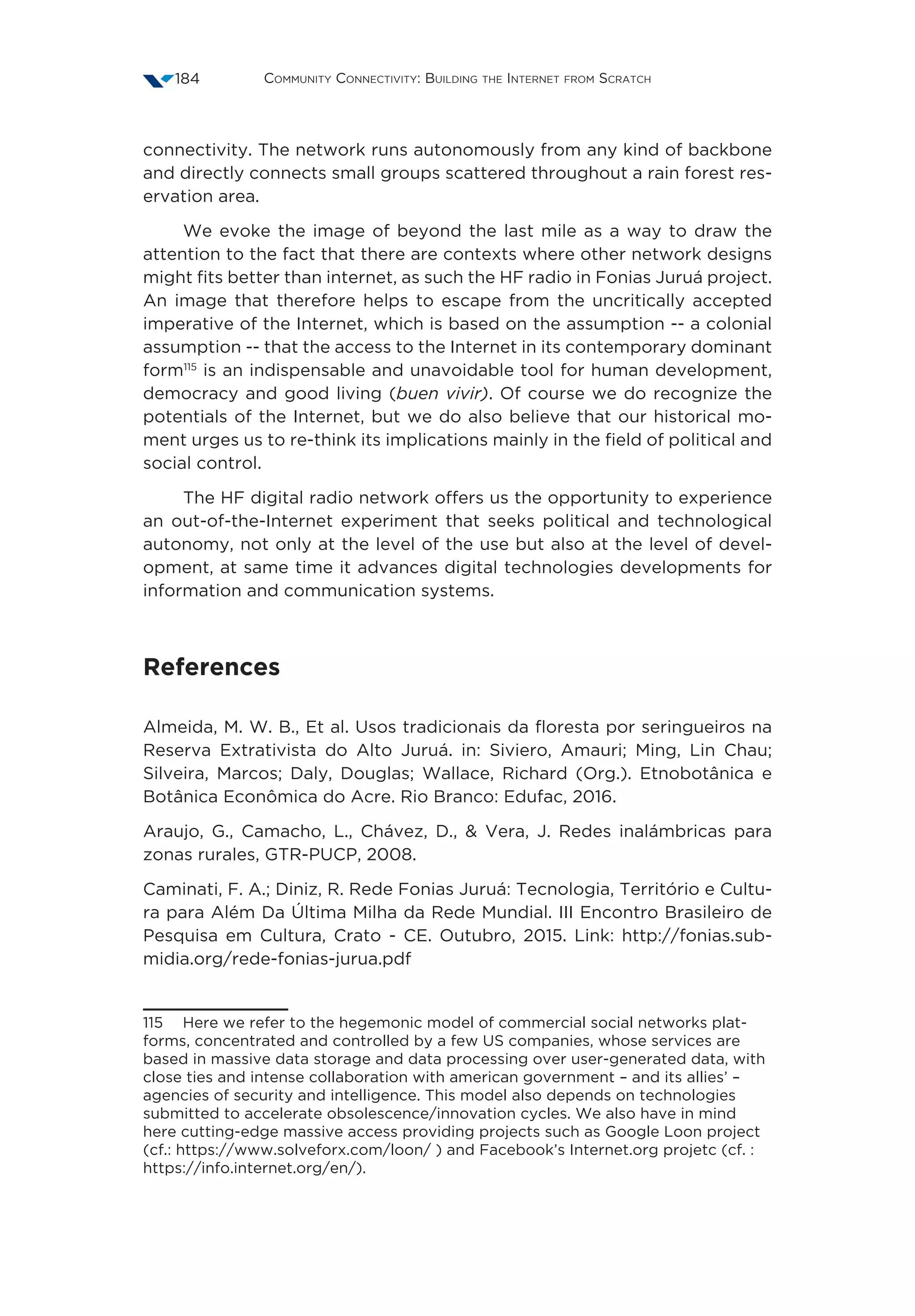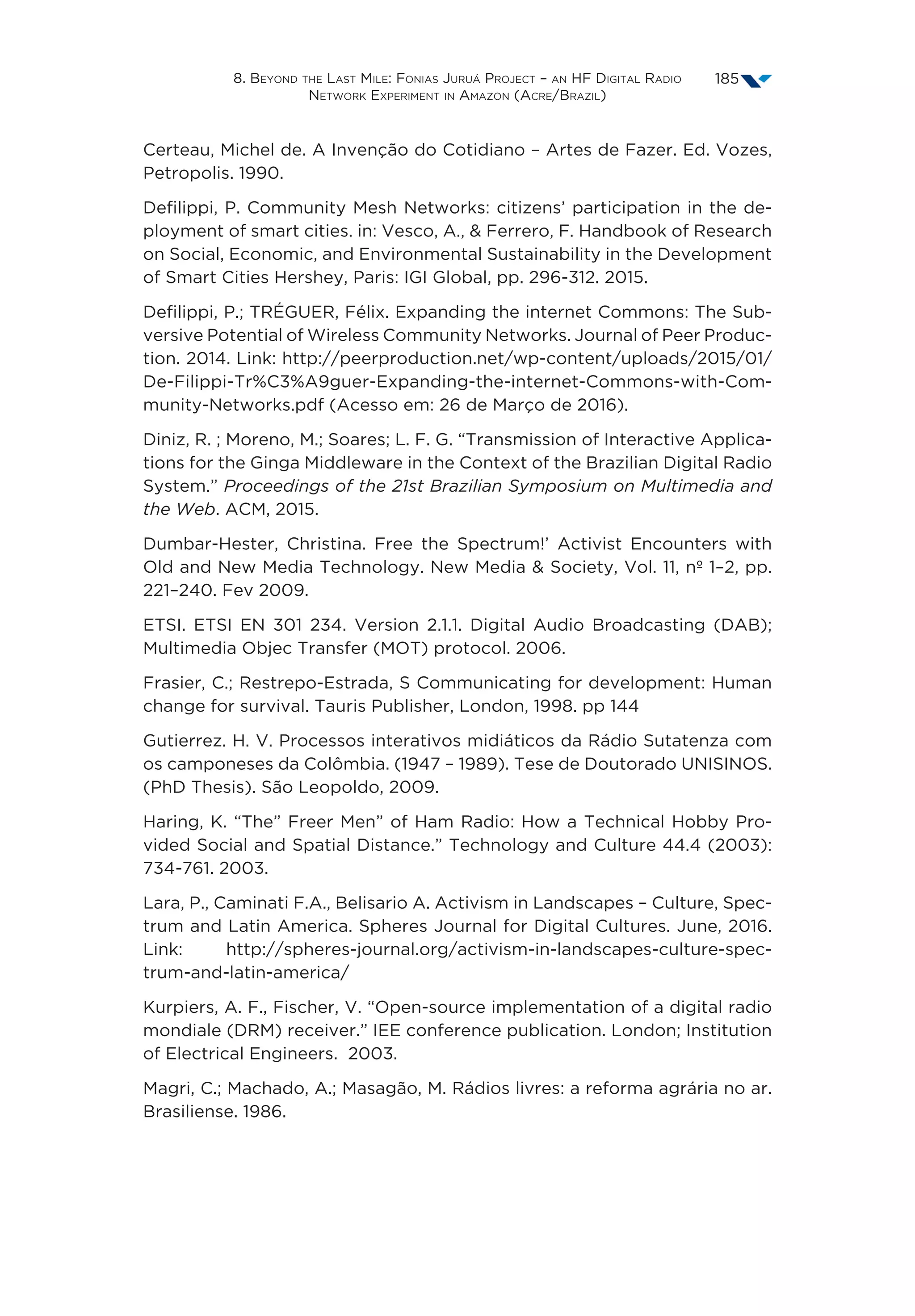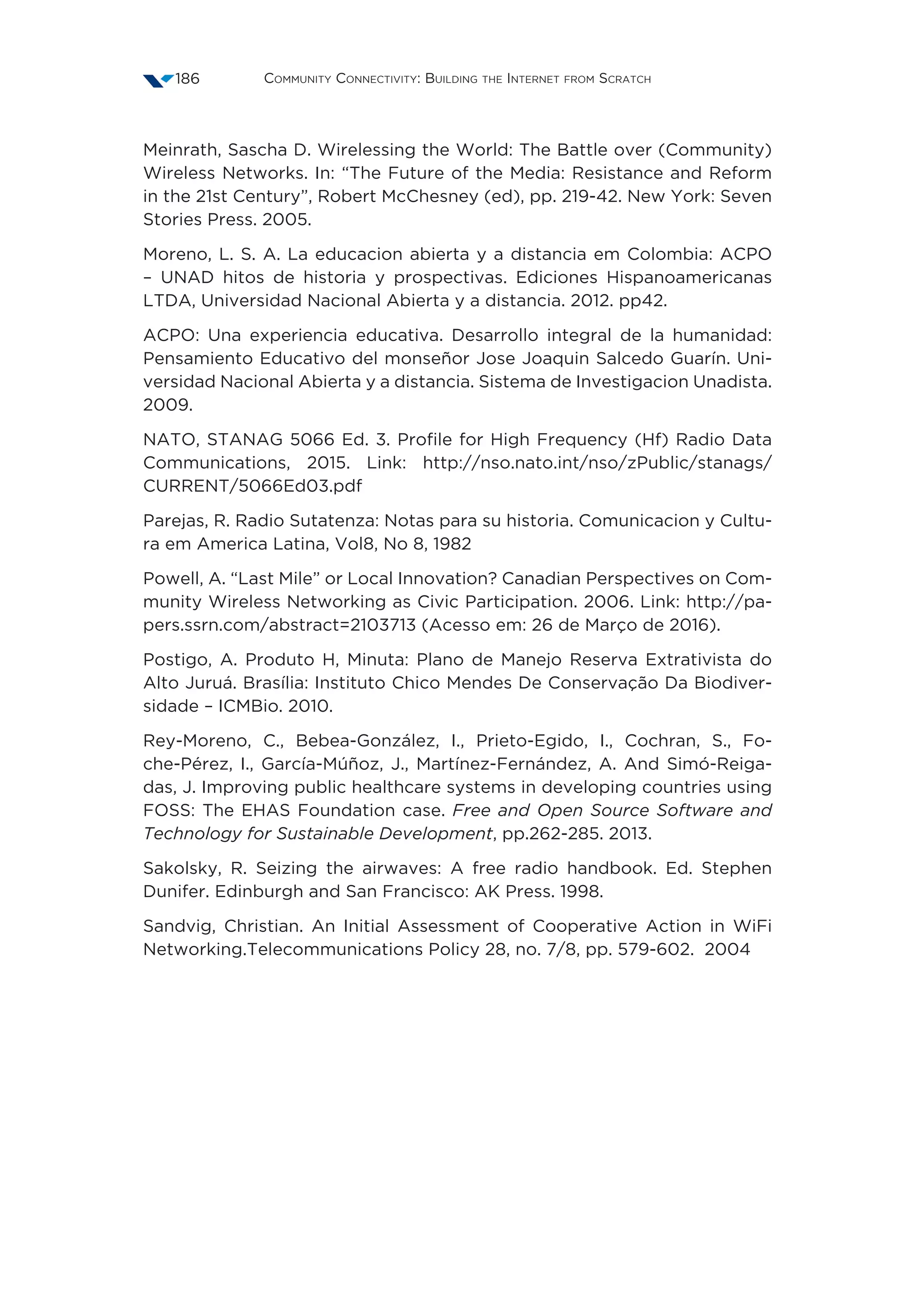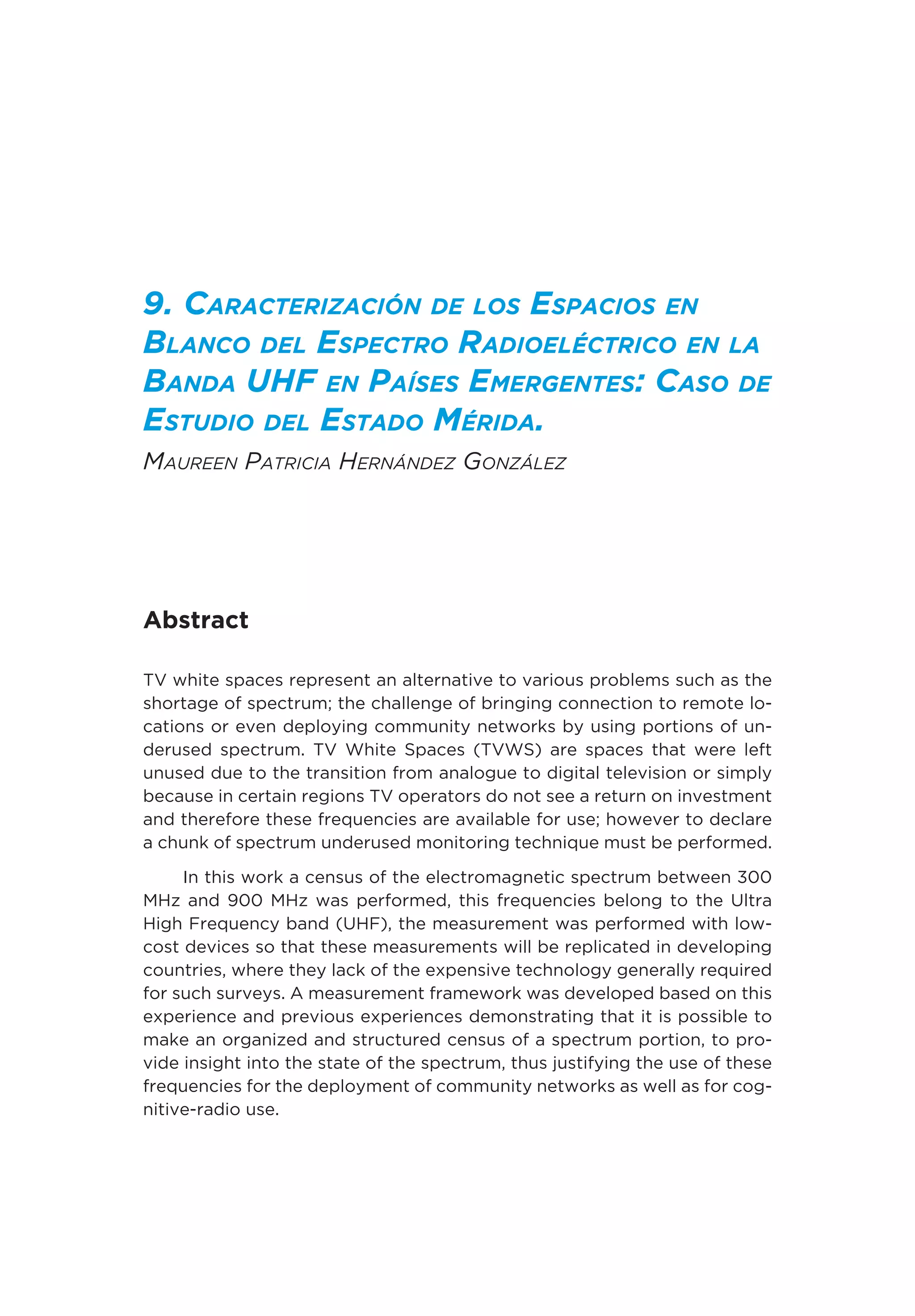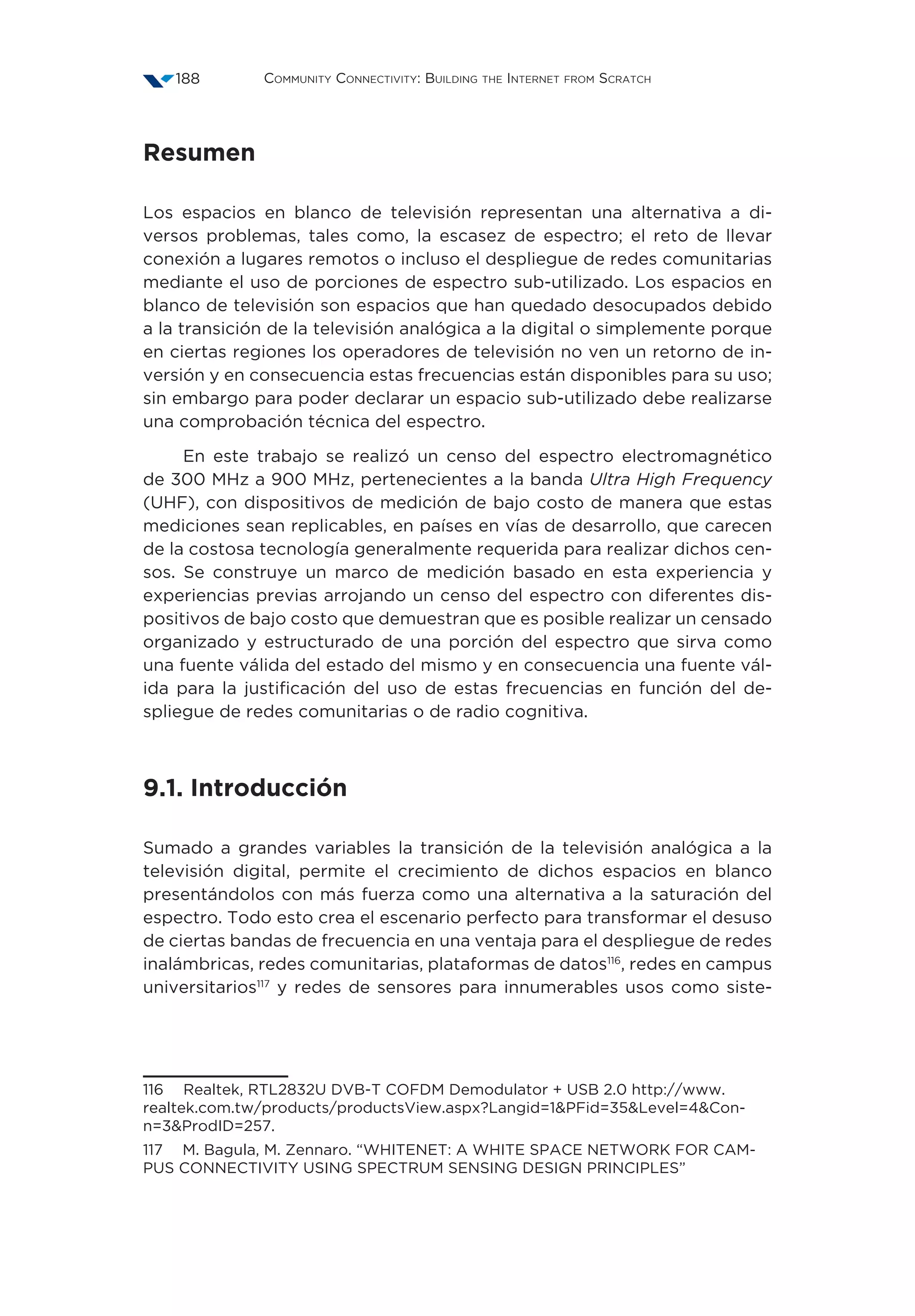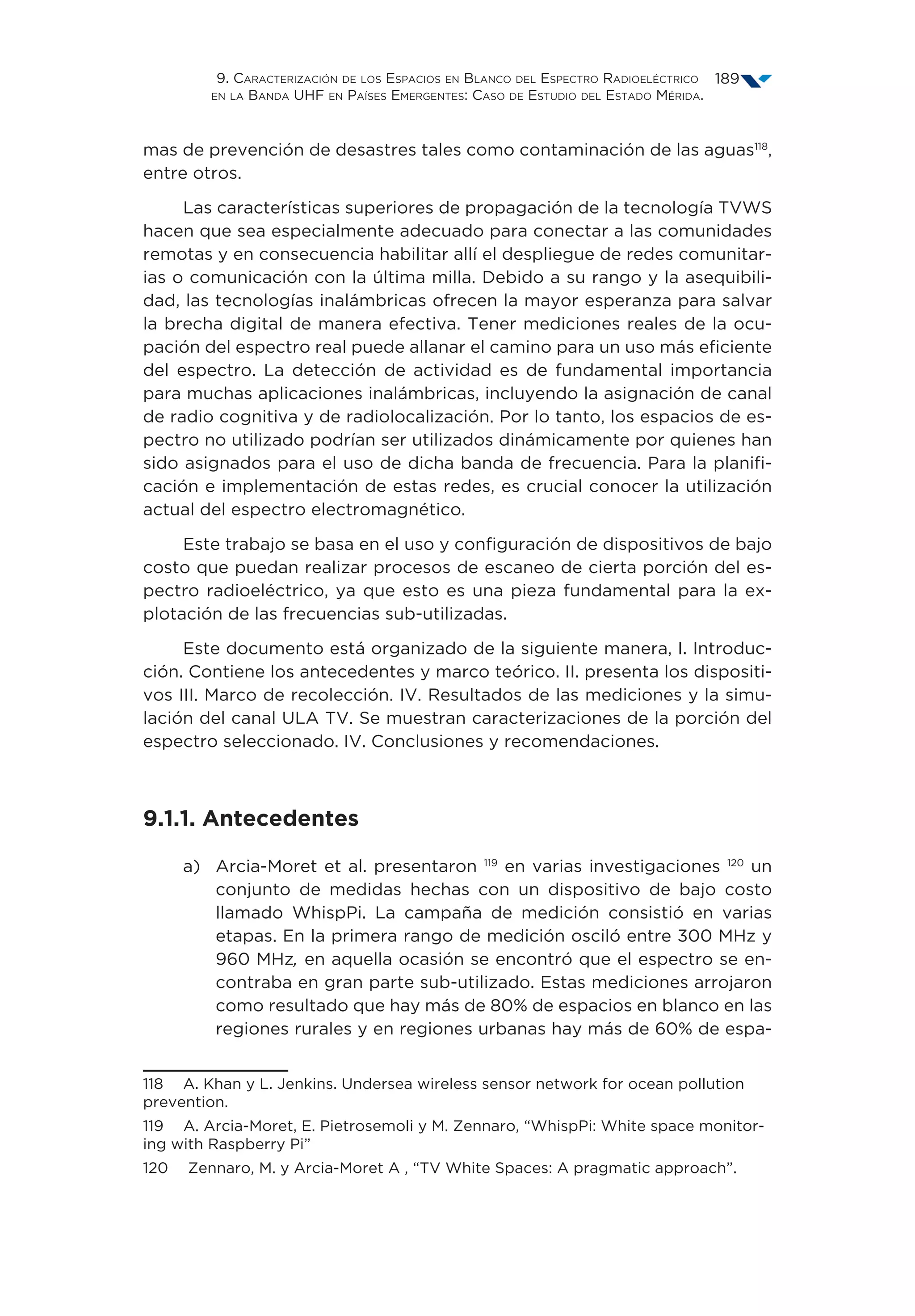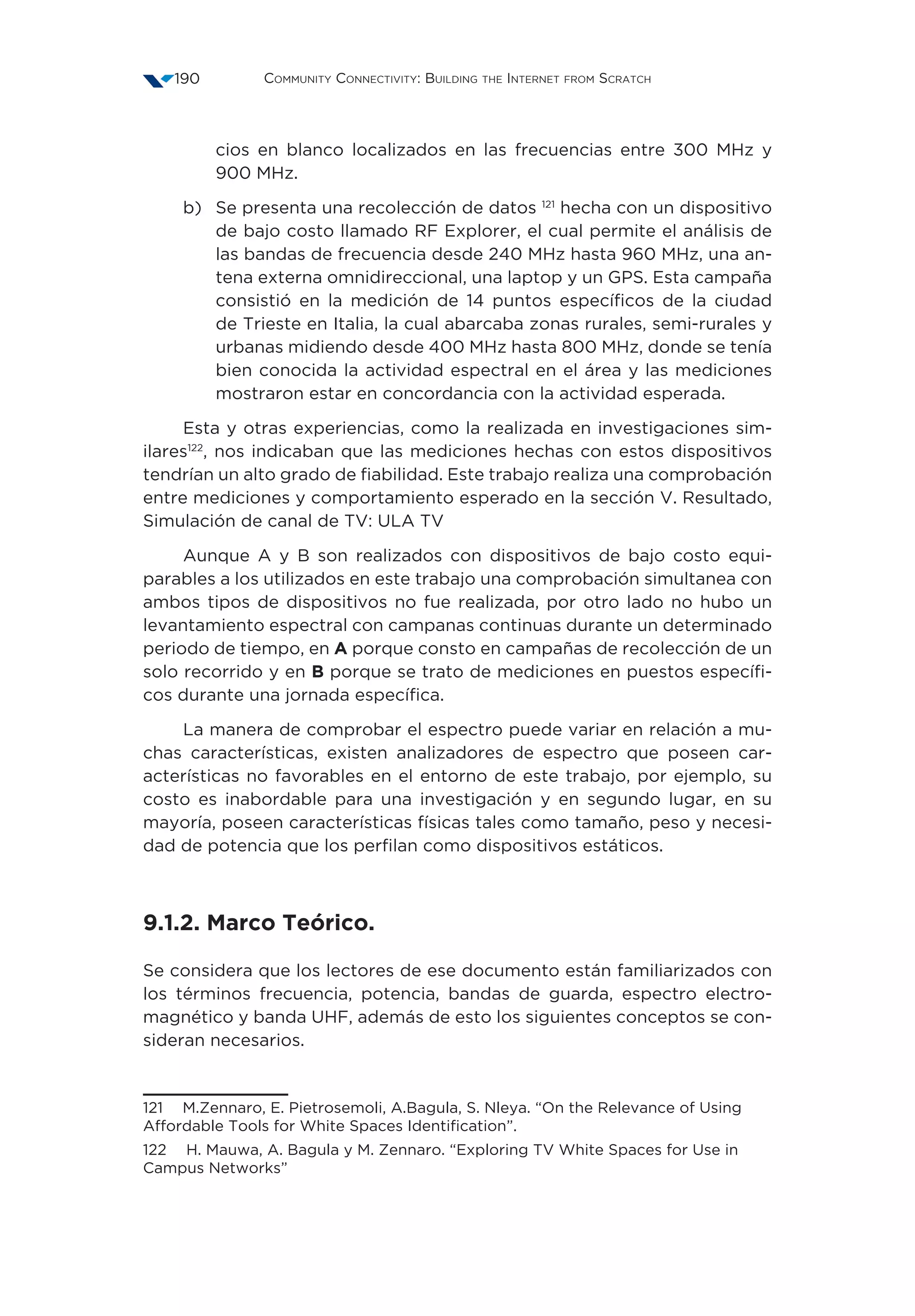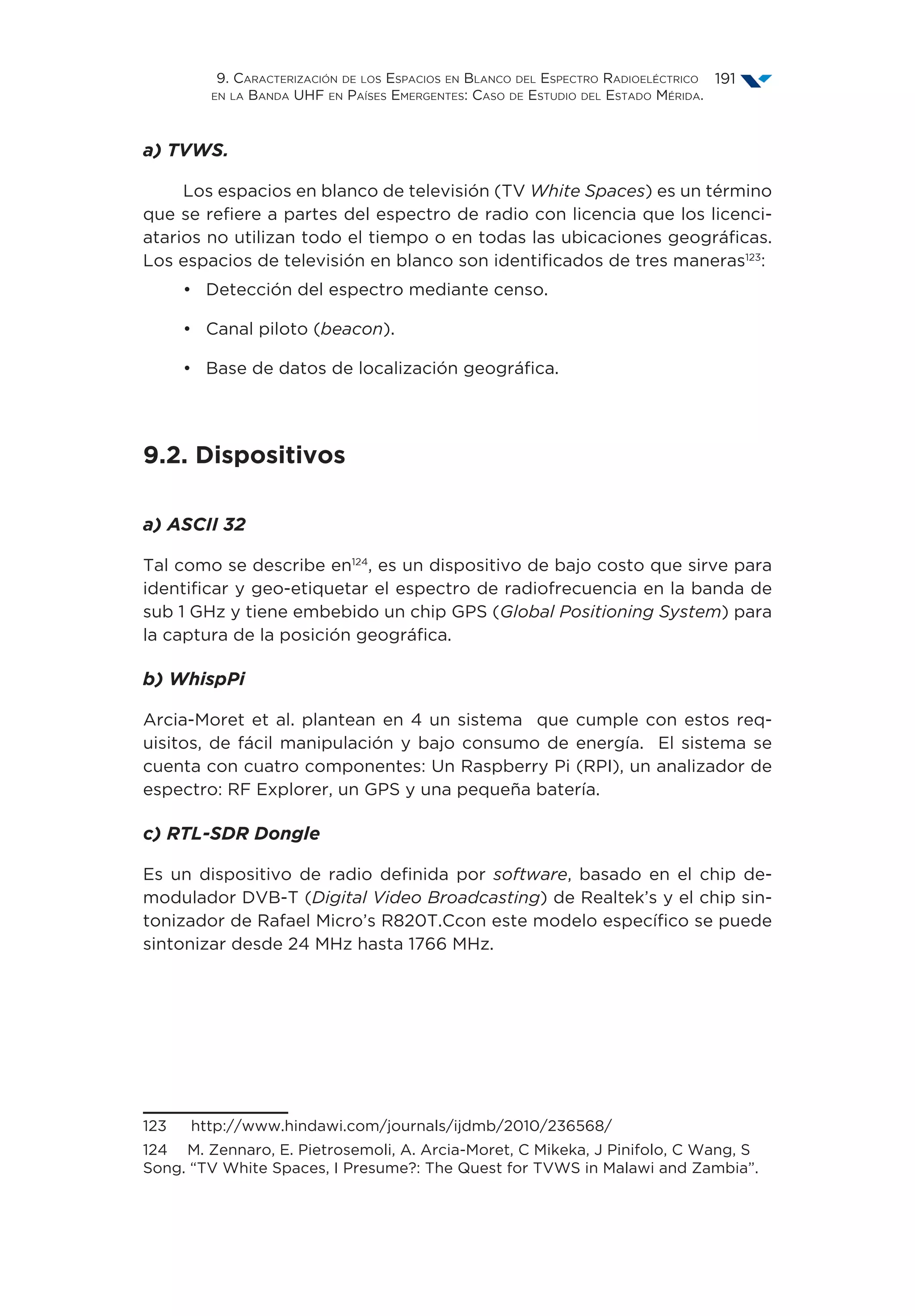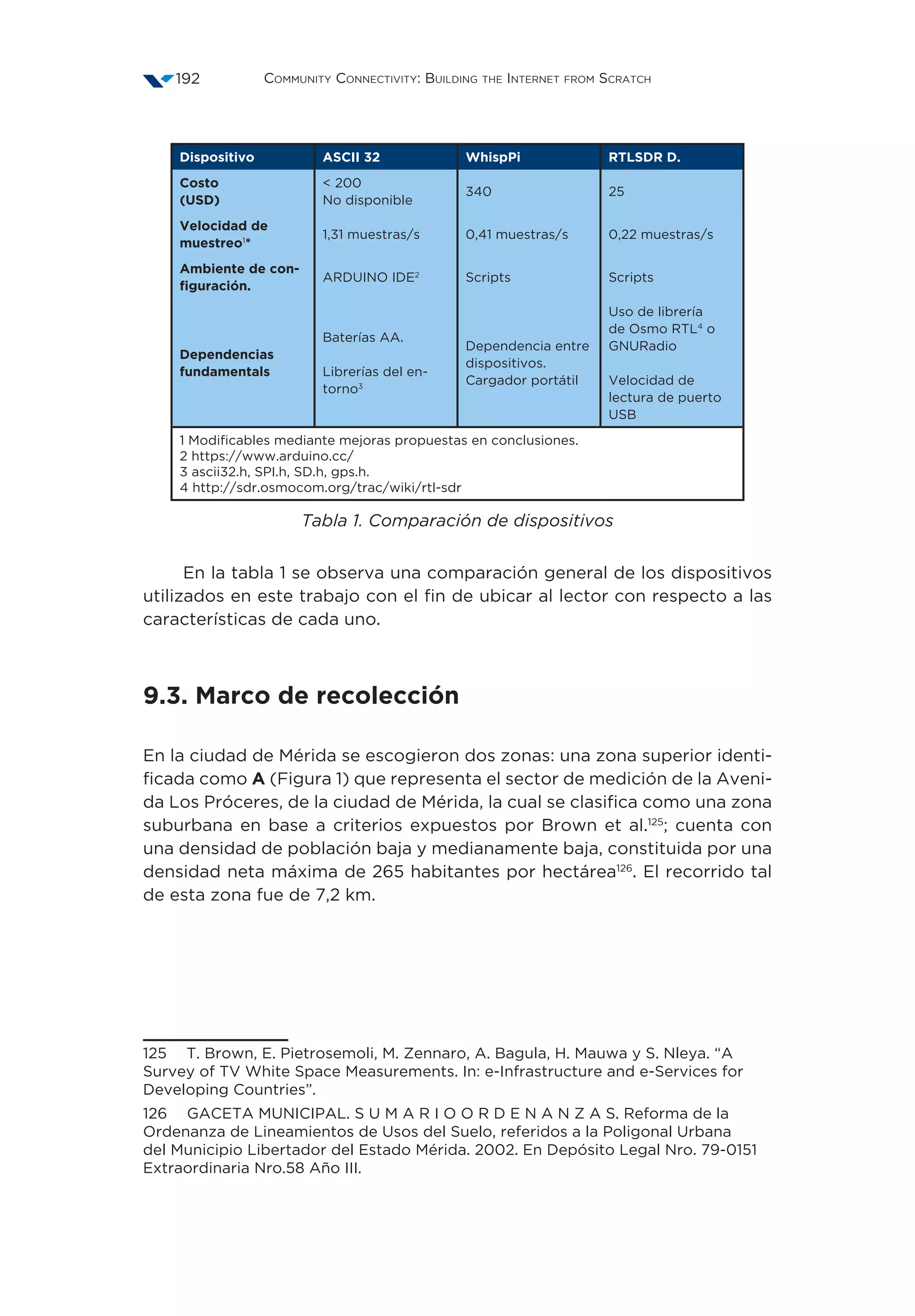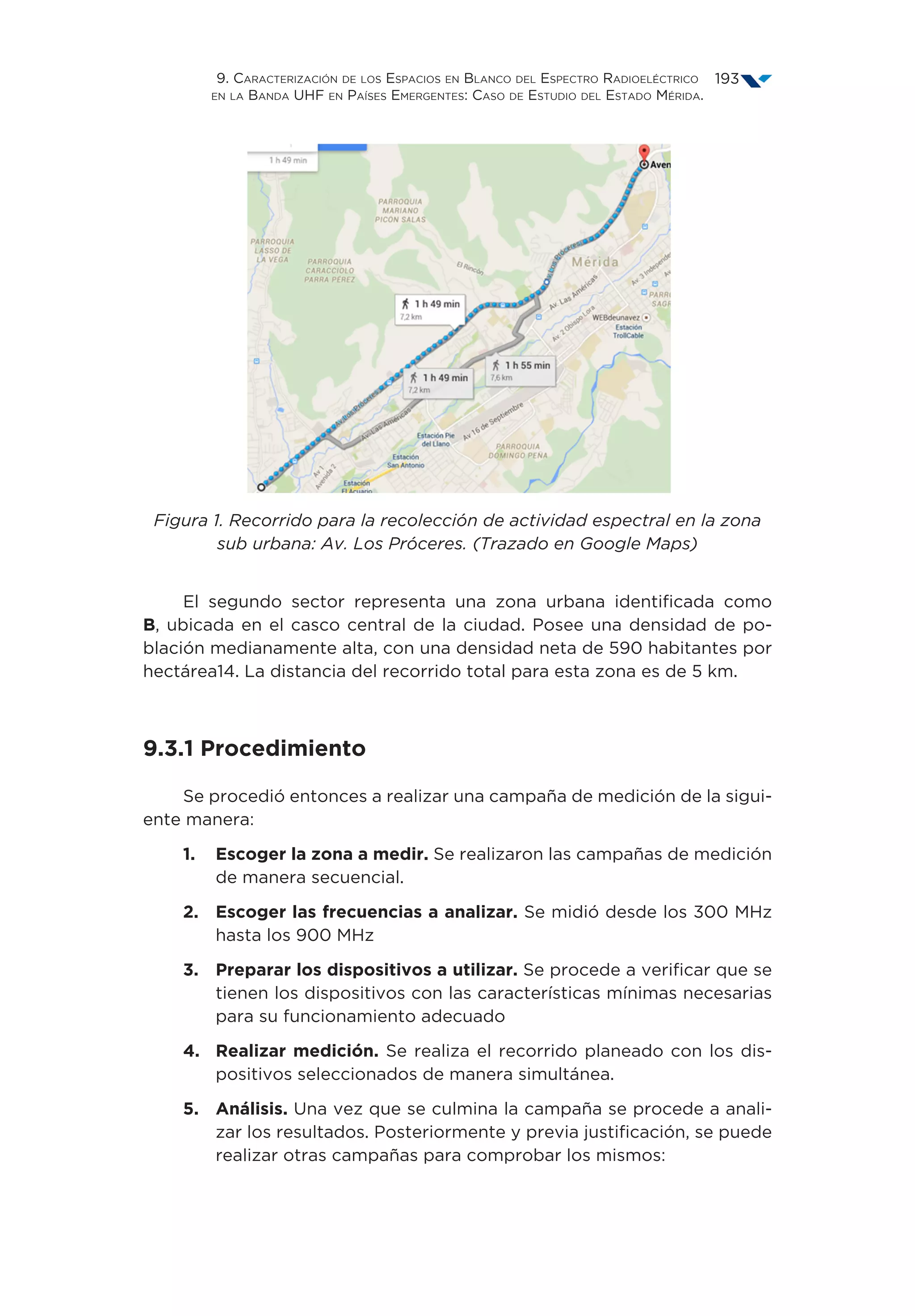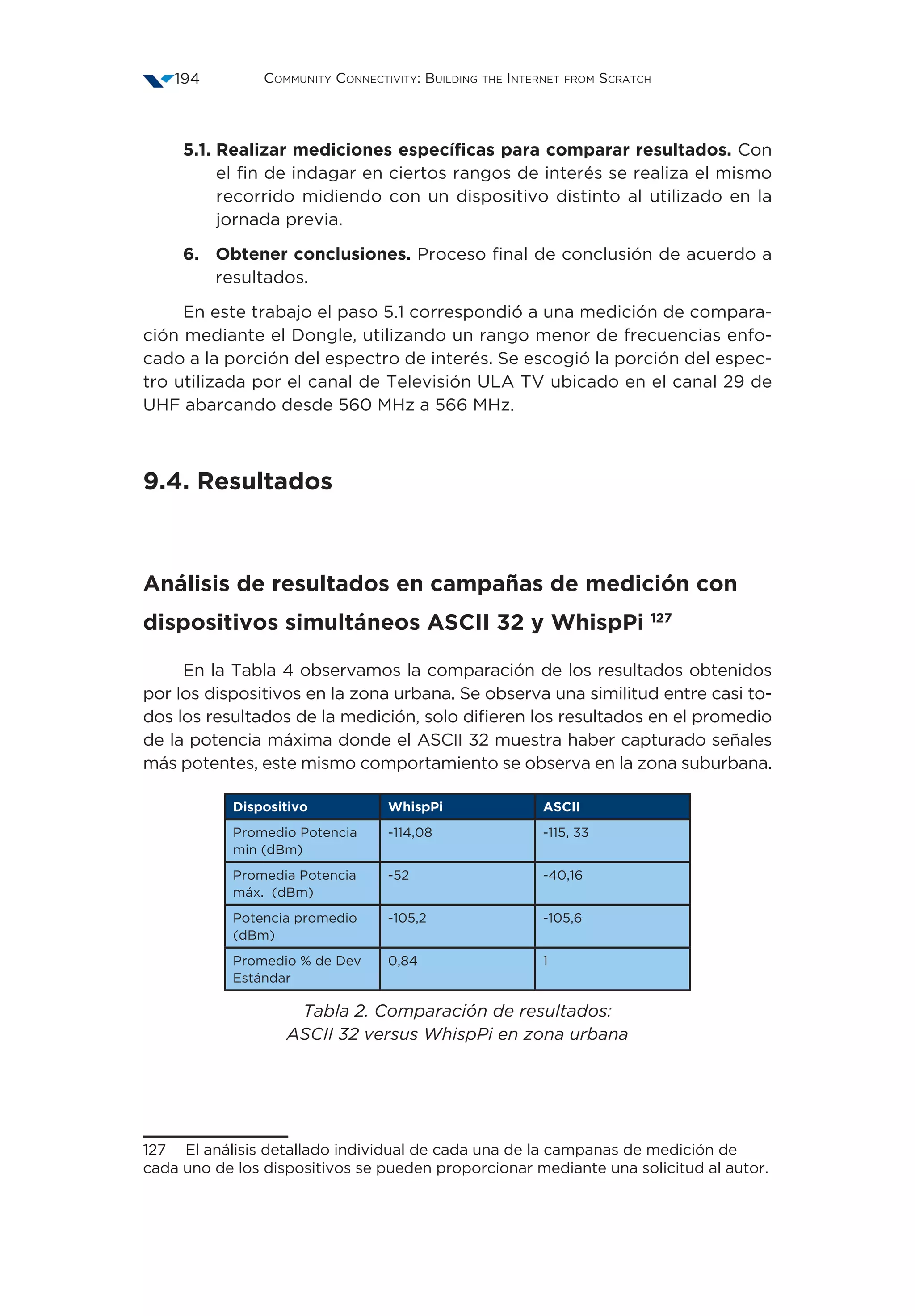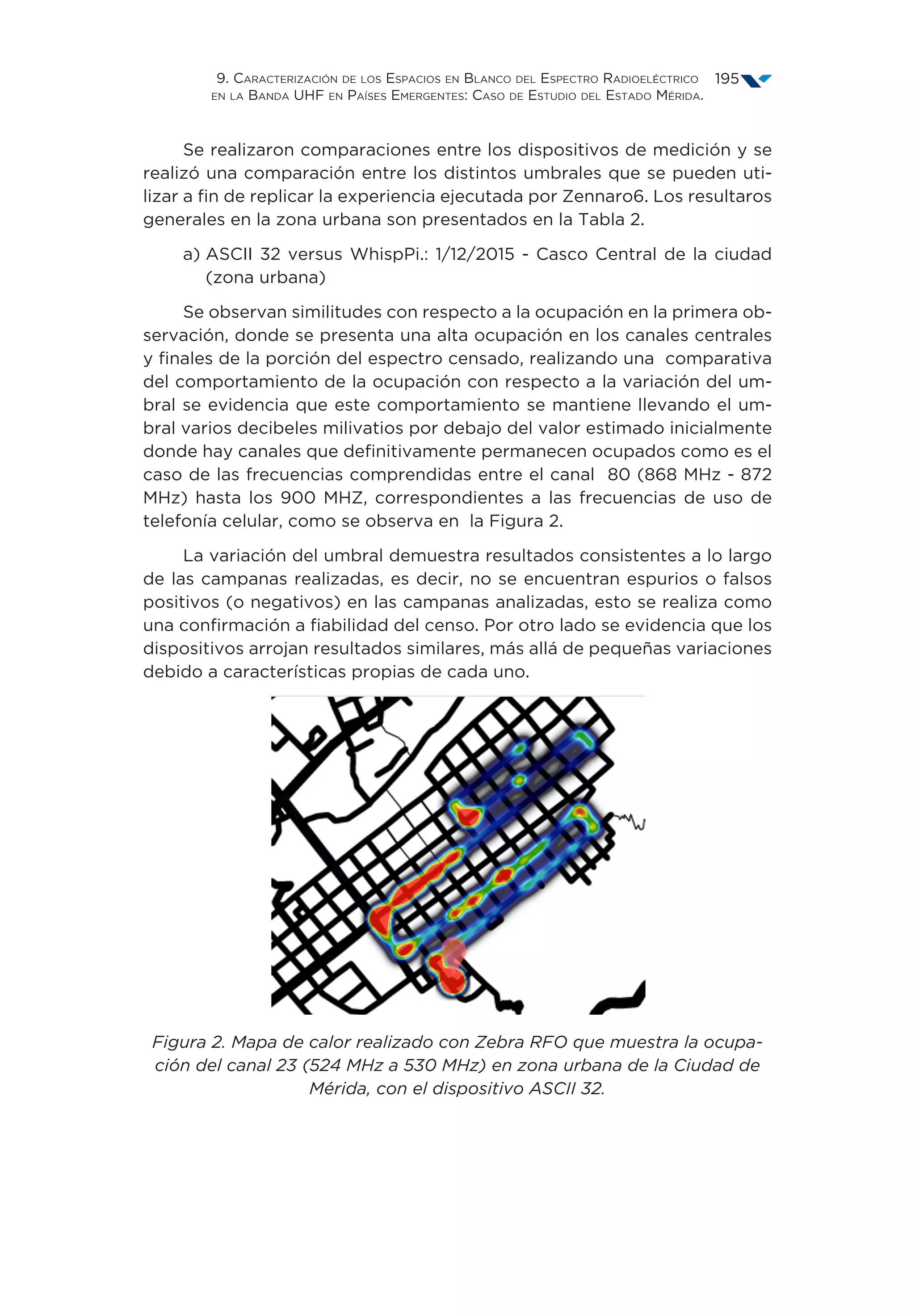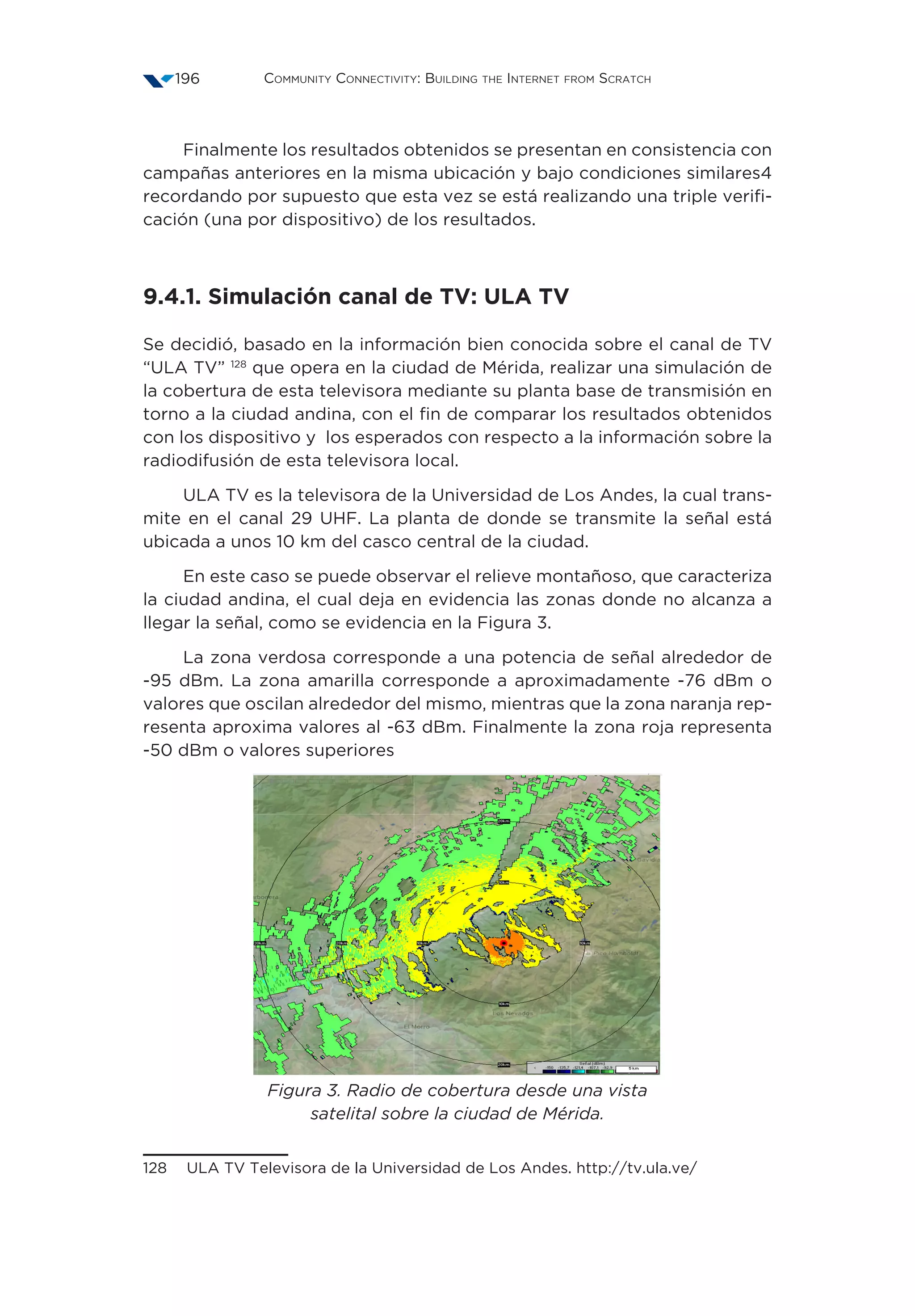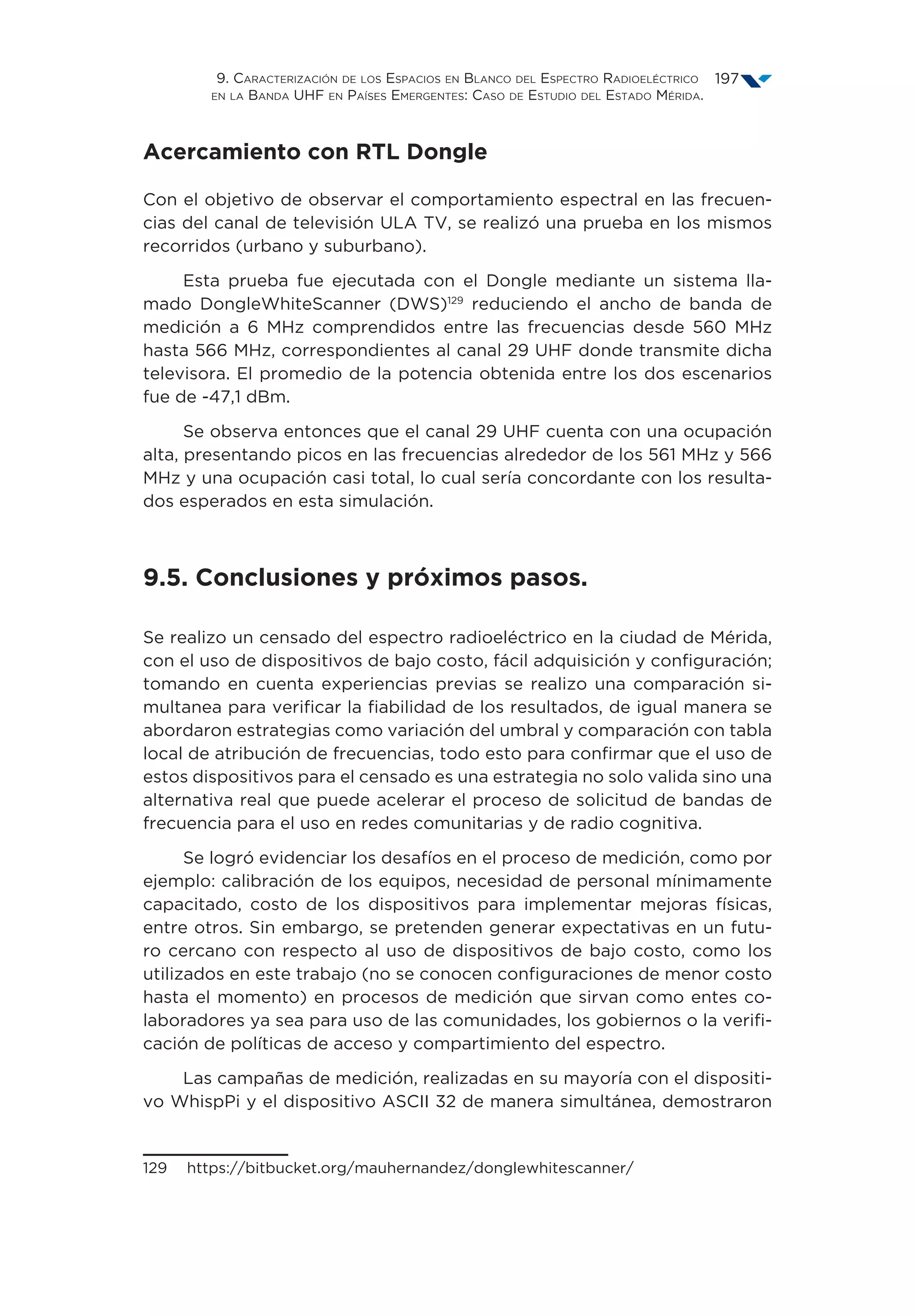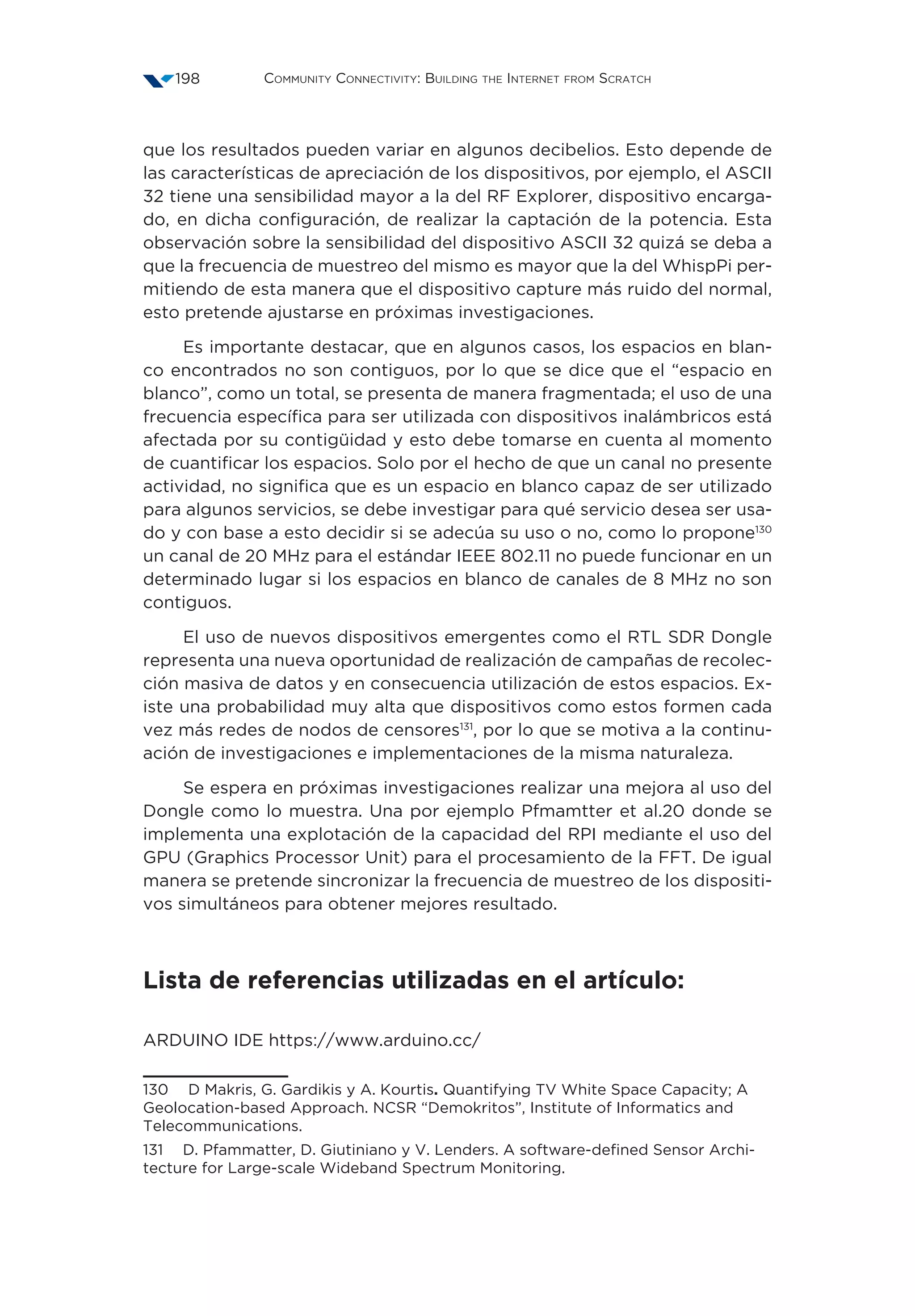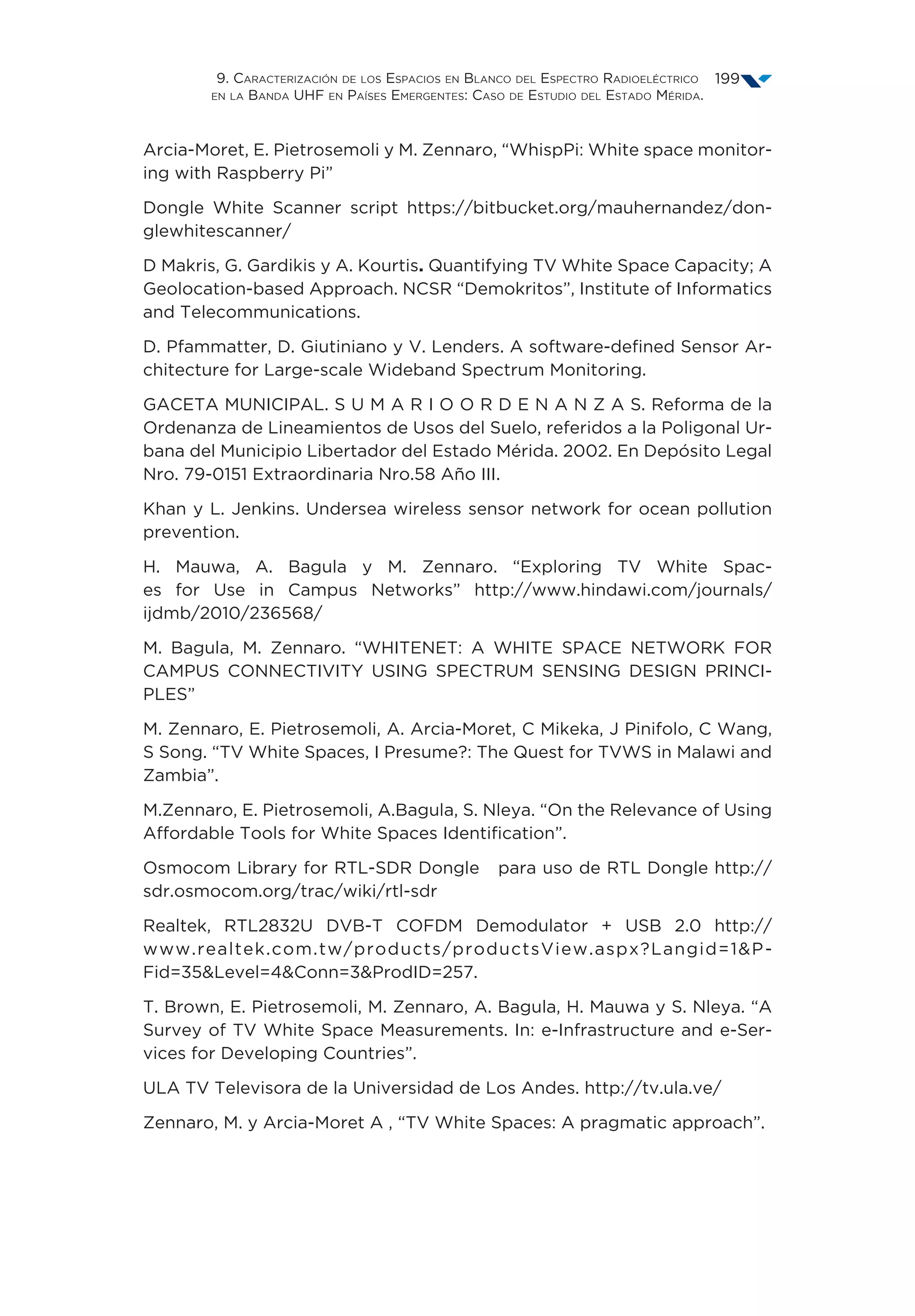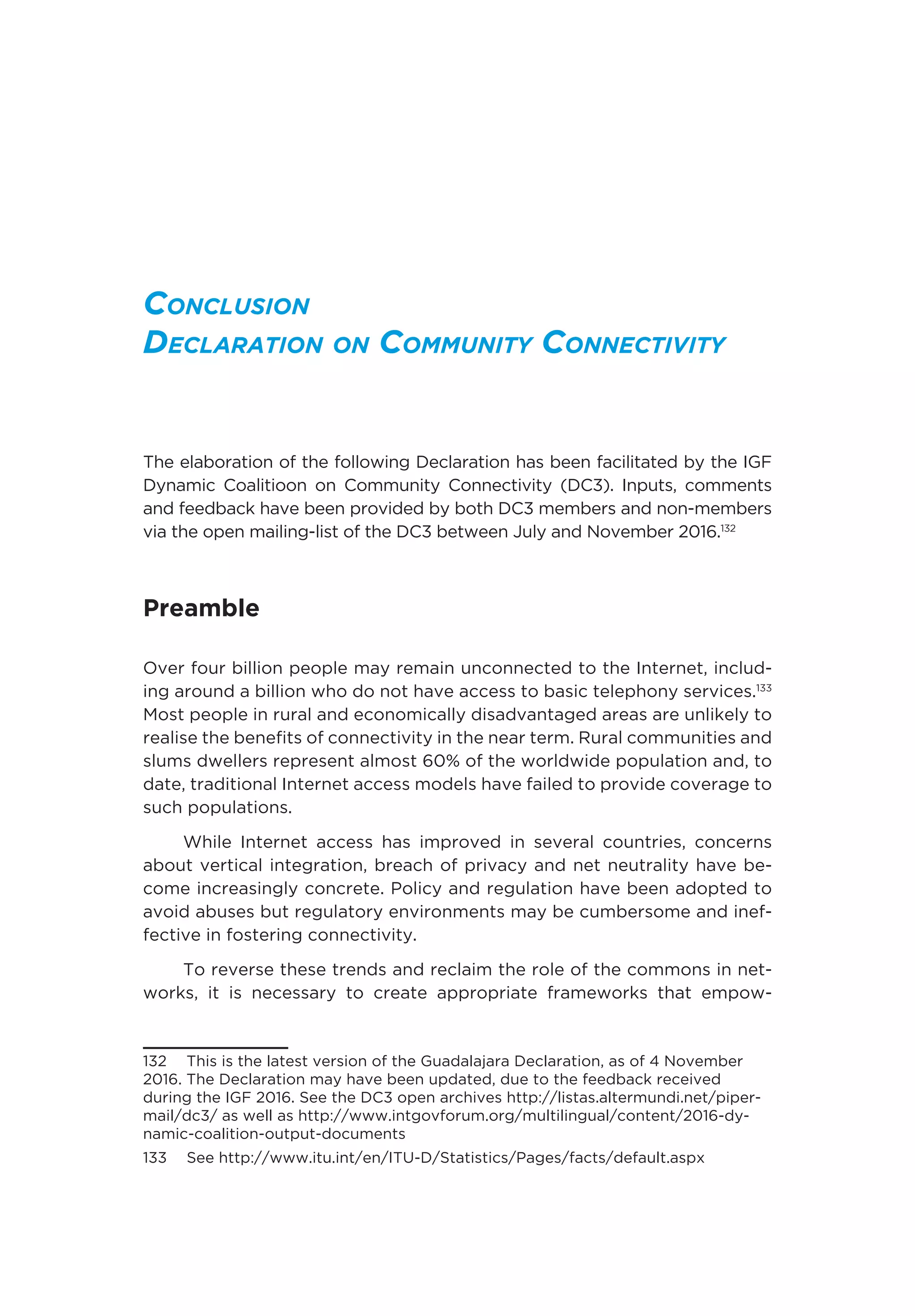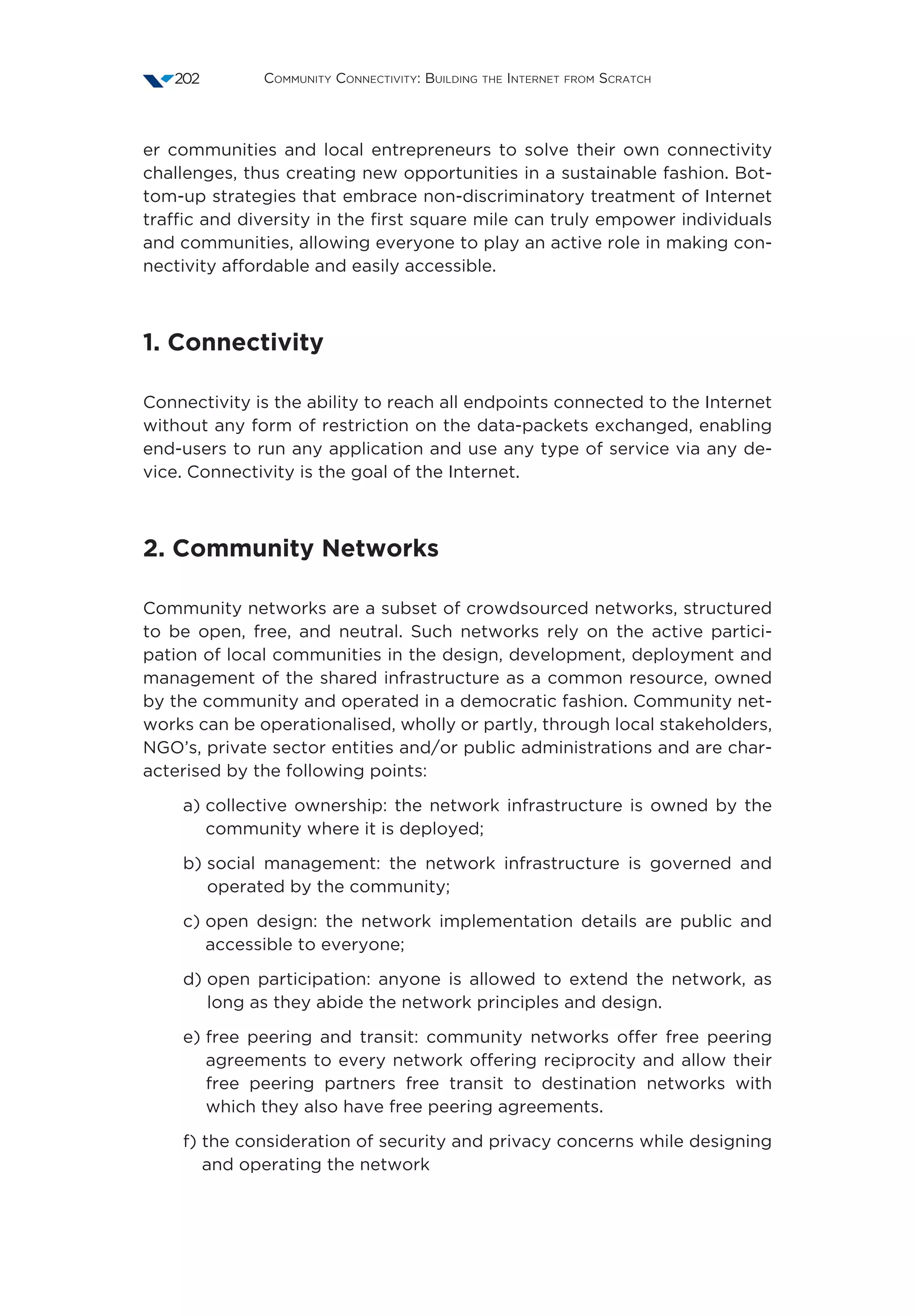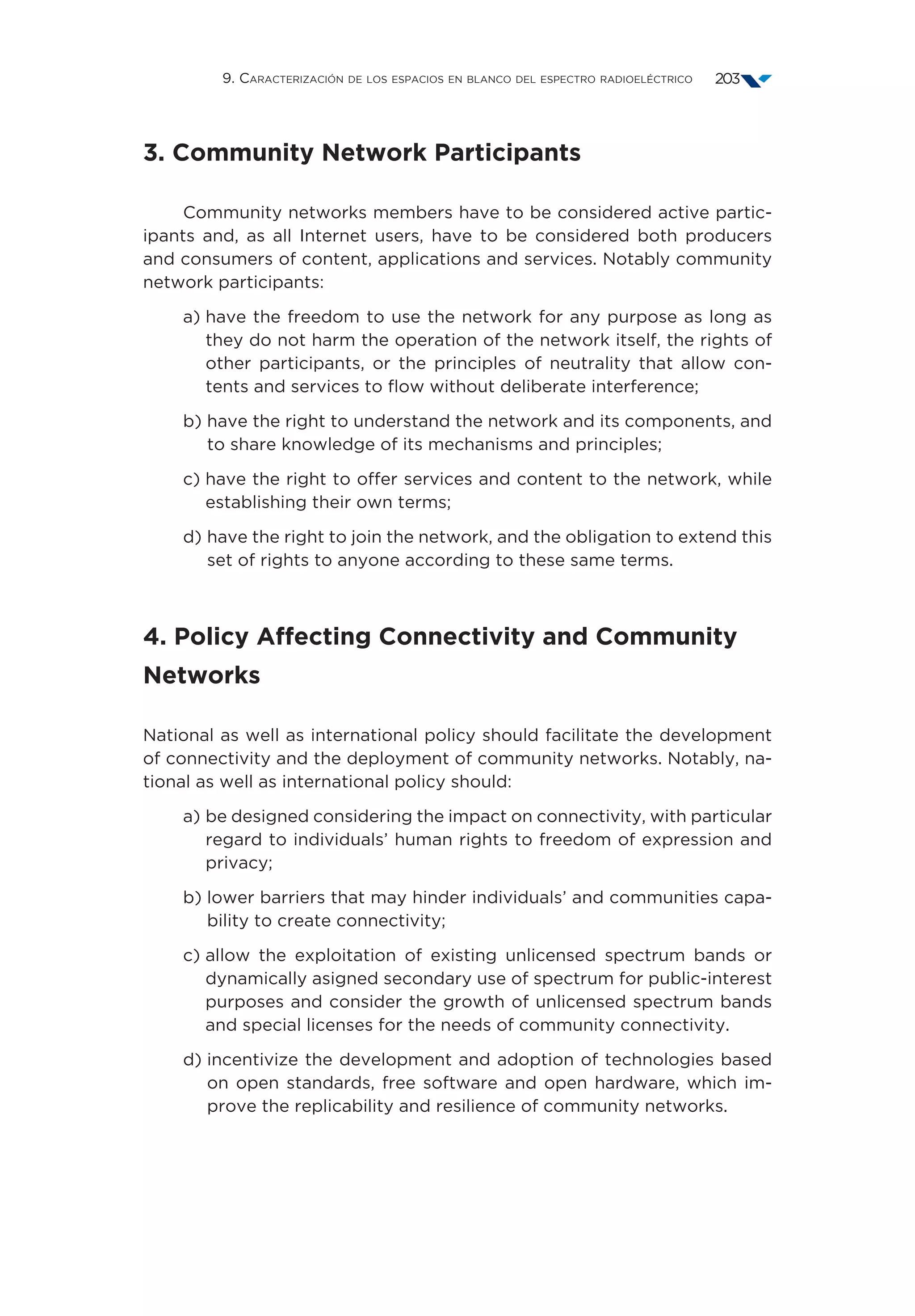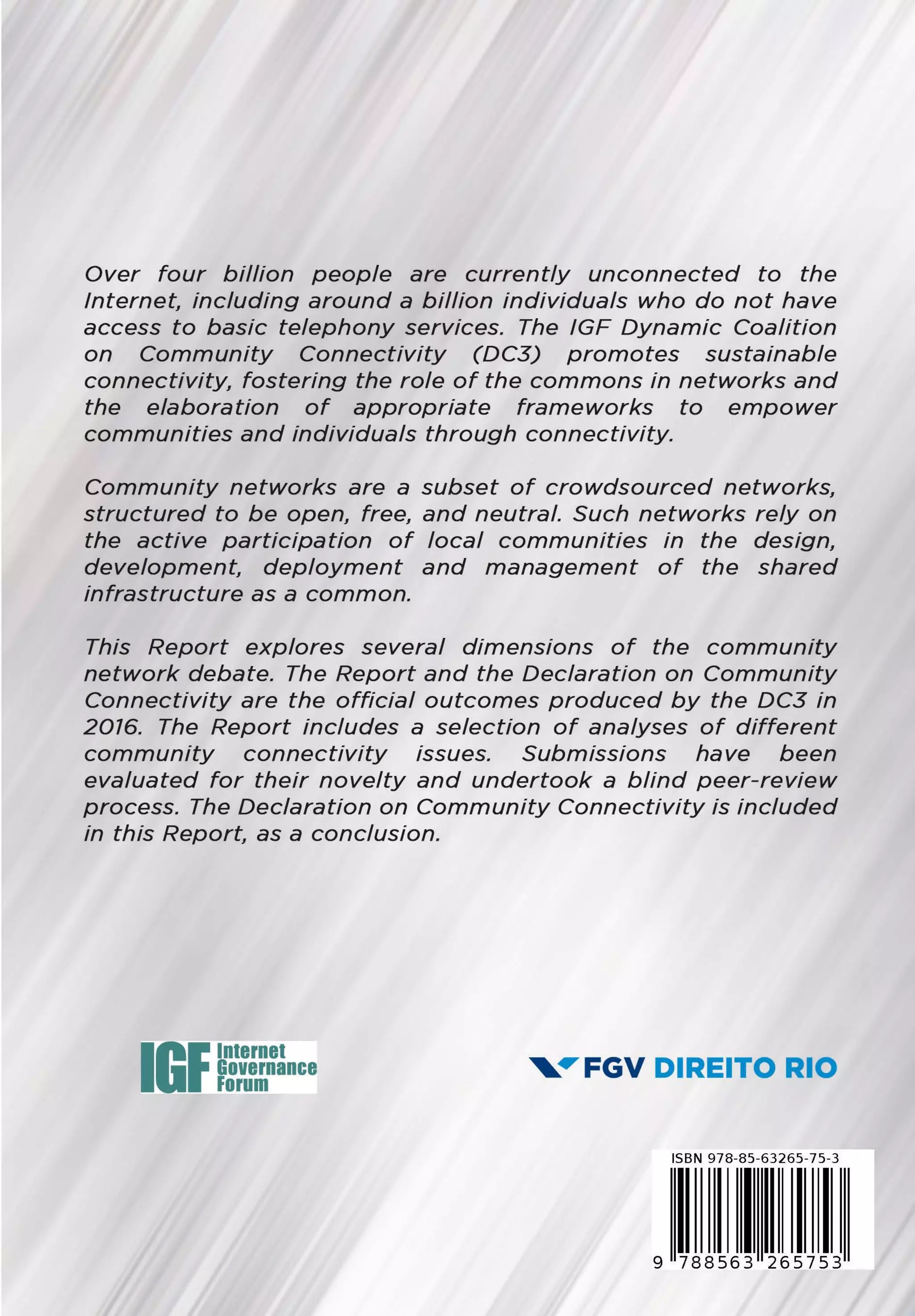The document is the annual report of the UN IGF Dynamic Coalition on Community Connectivity, focusing on building internet infrastructure from grassroots initiatives. It highlights the importance of achieving ambient connectivity to support innovations in technology and community-driven solutions without relying on traditional profit-driven telecommunications models. The report discusses various contributions from experts and advocates for collaborative efforts in creating accessible and inclusive internet services.
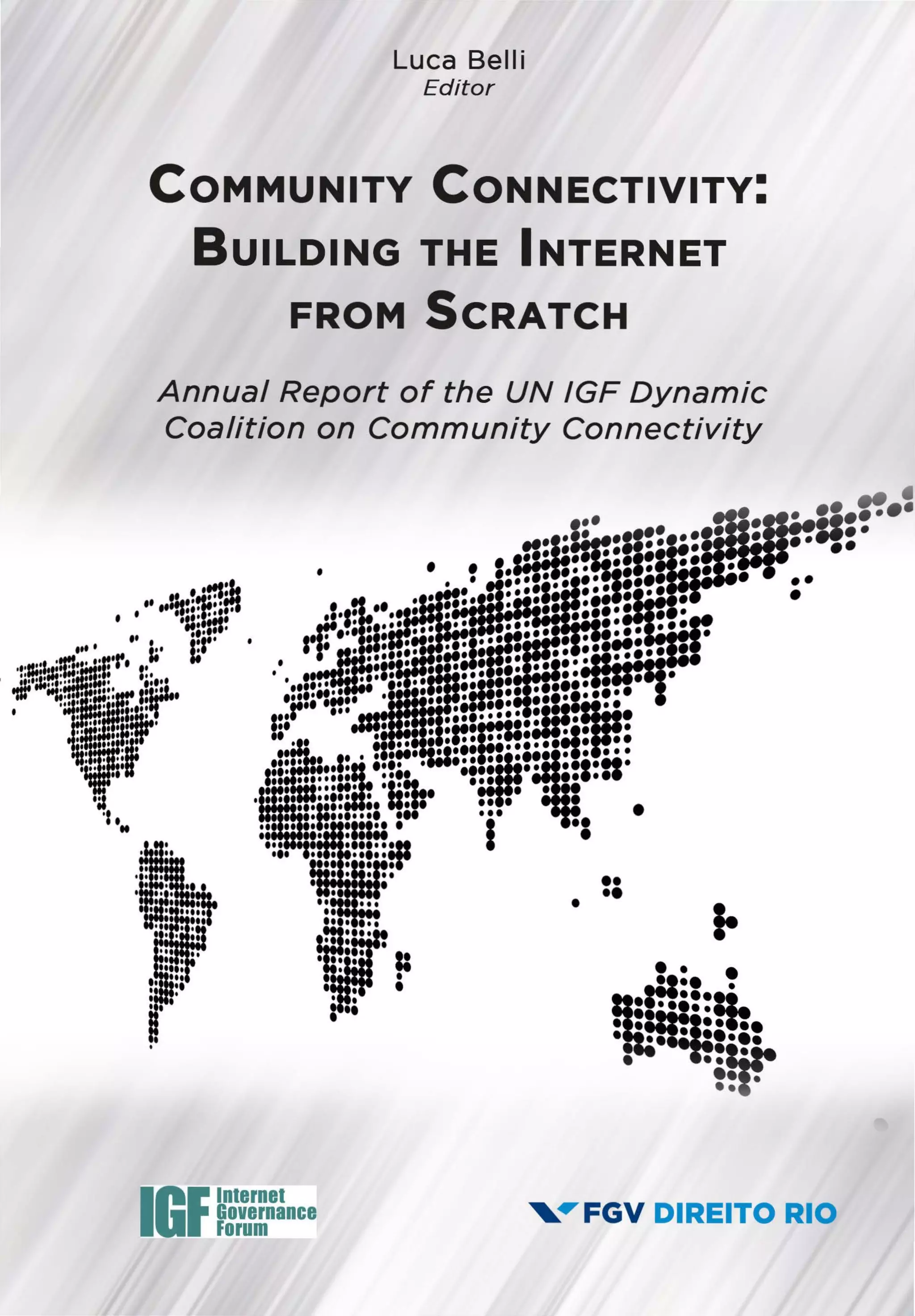

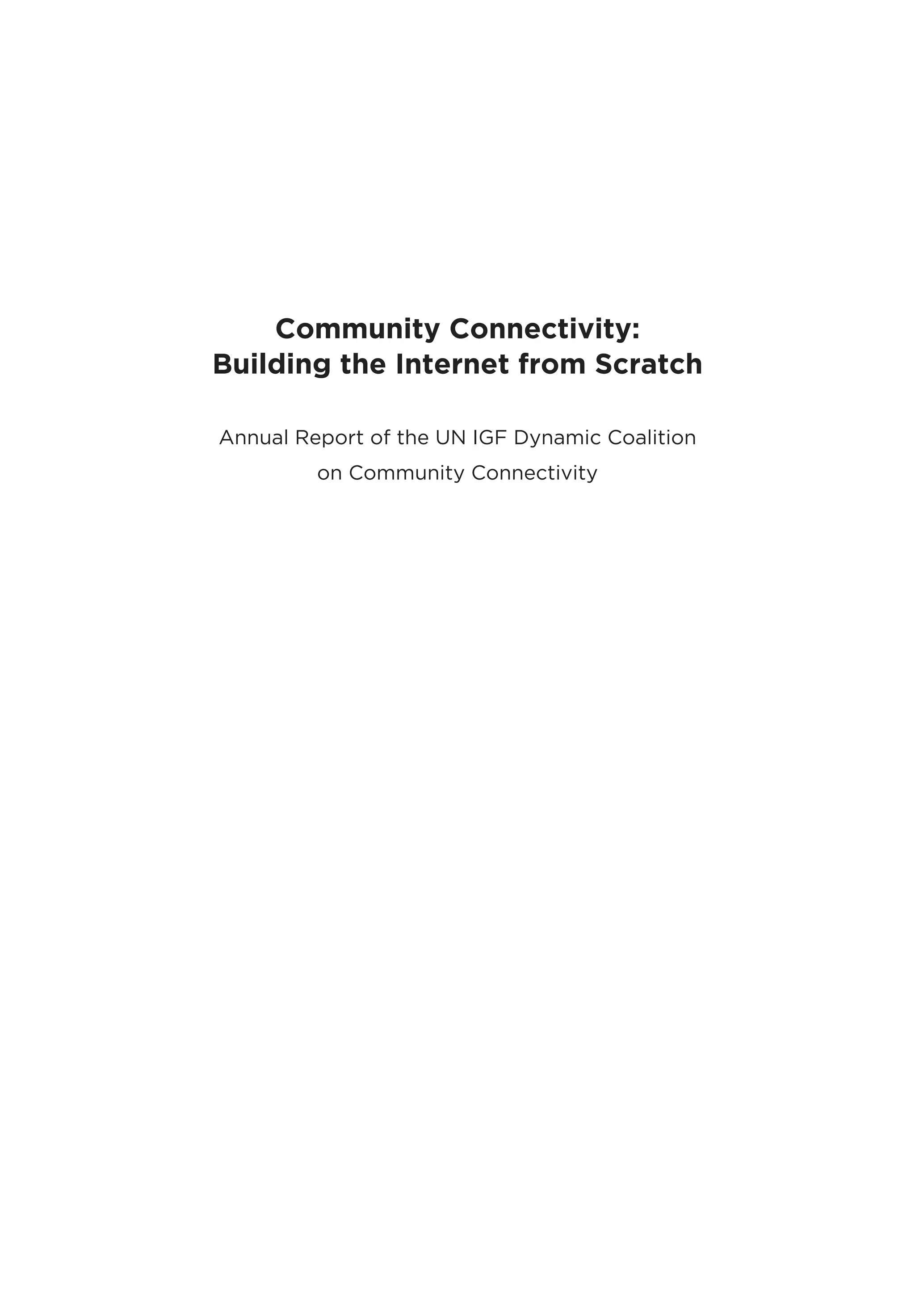


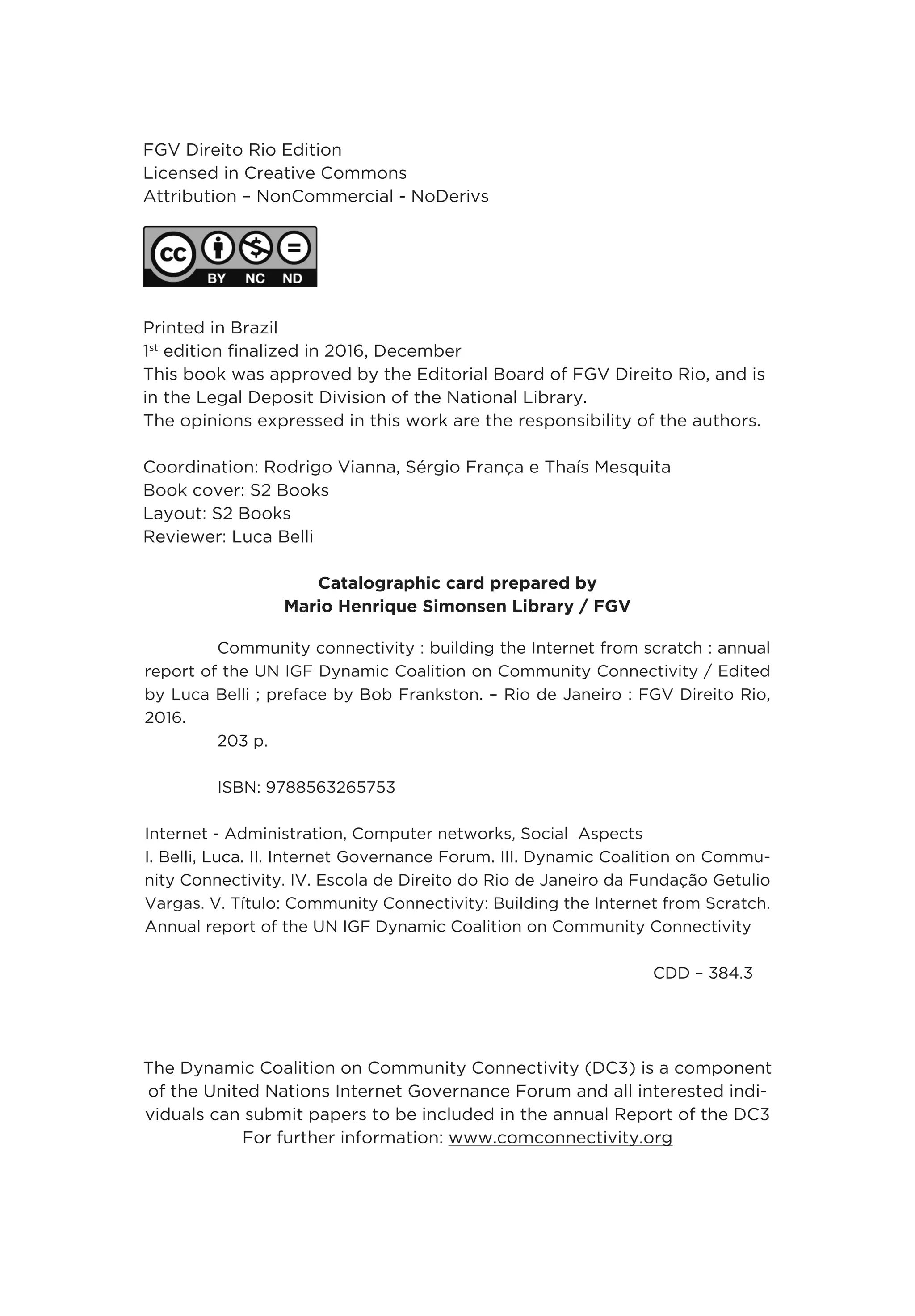


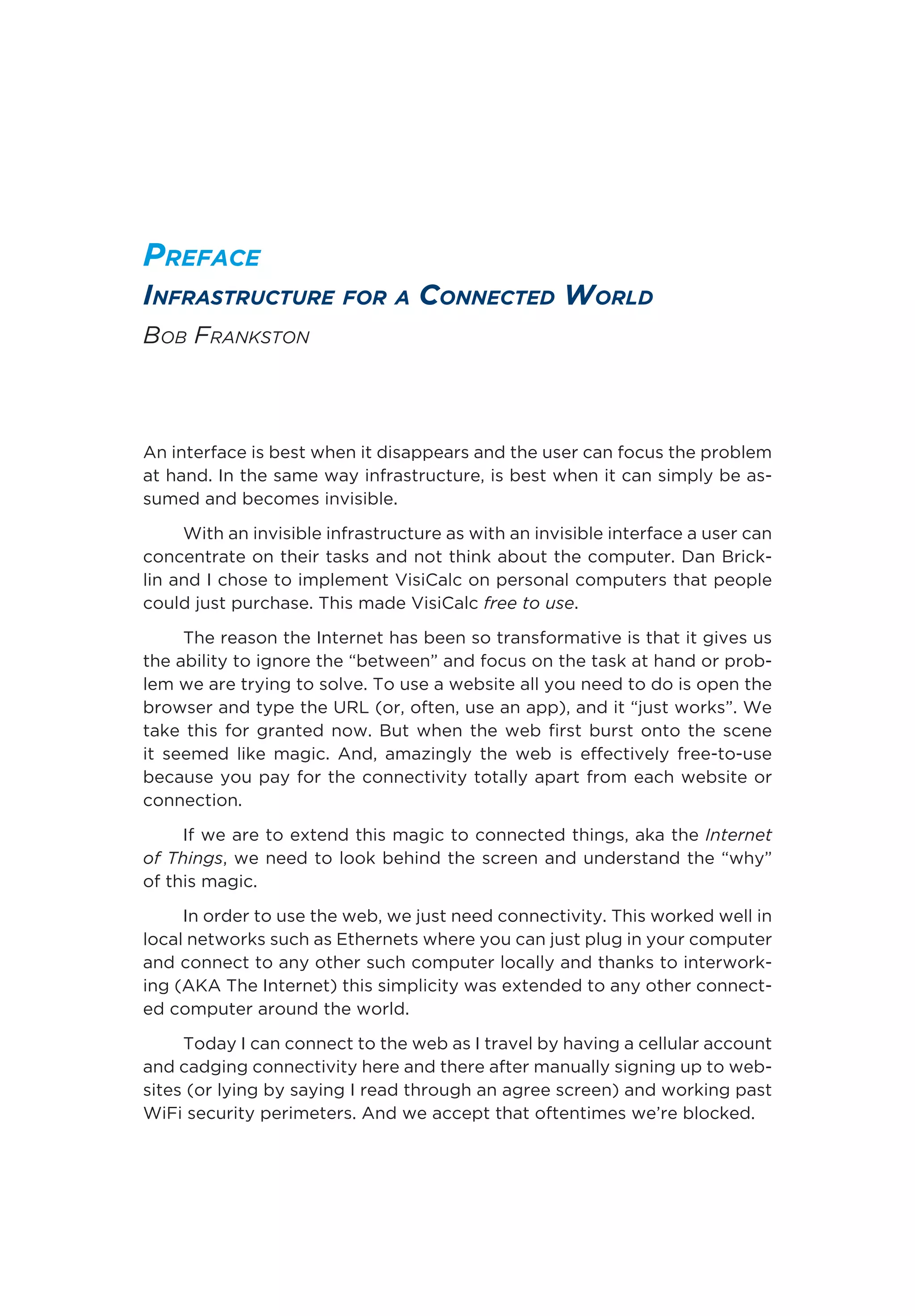
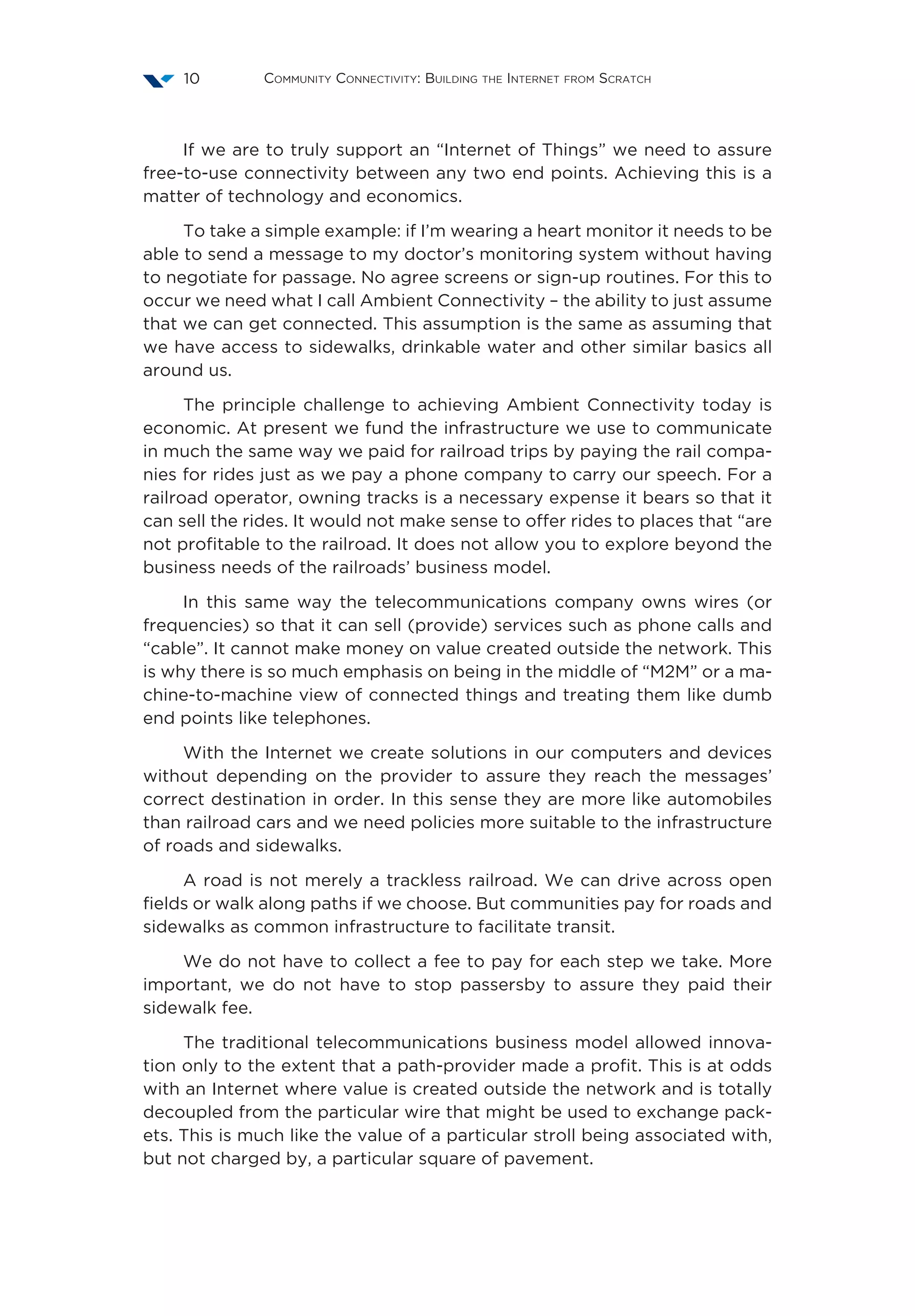
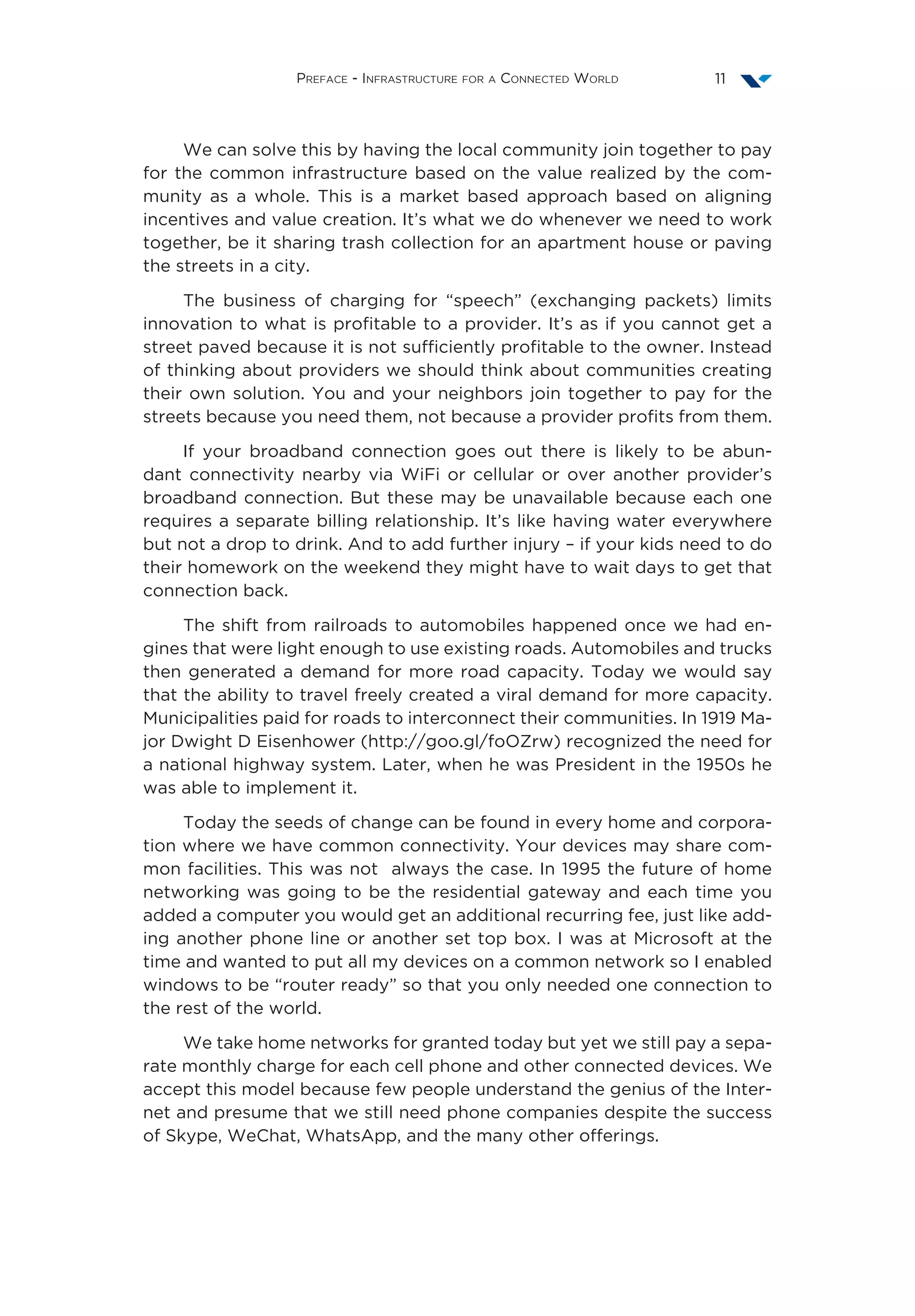
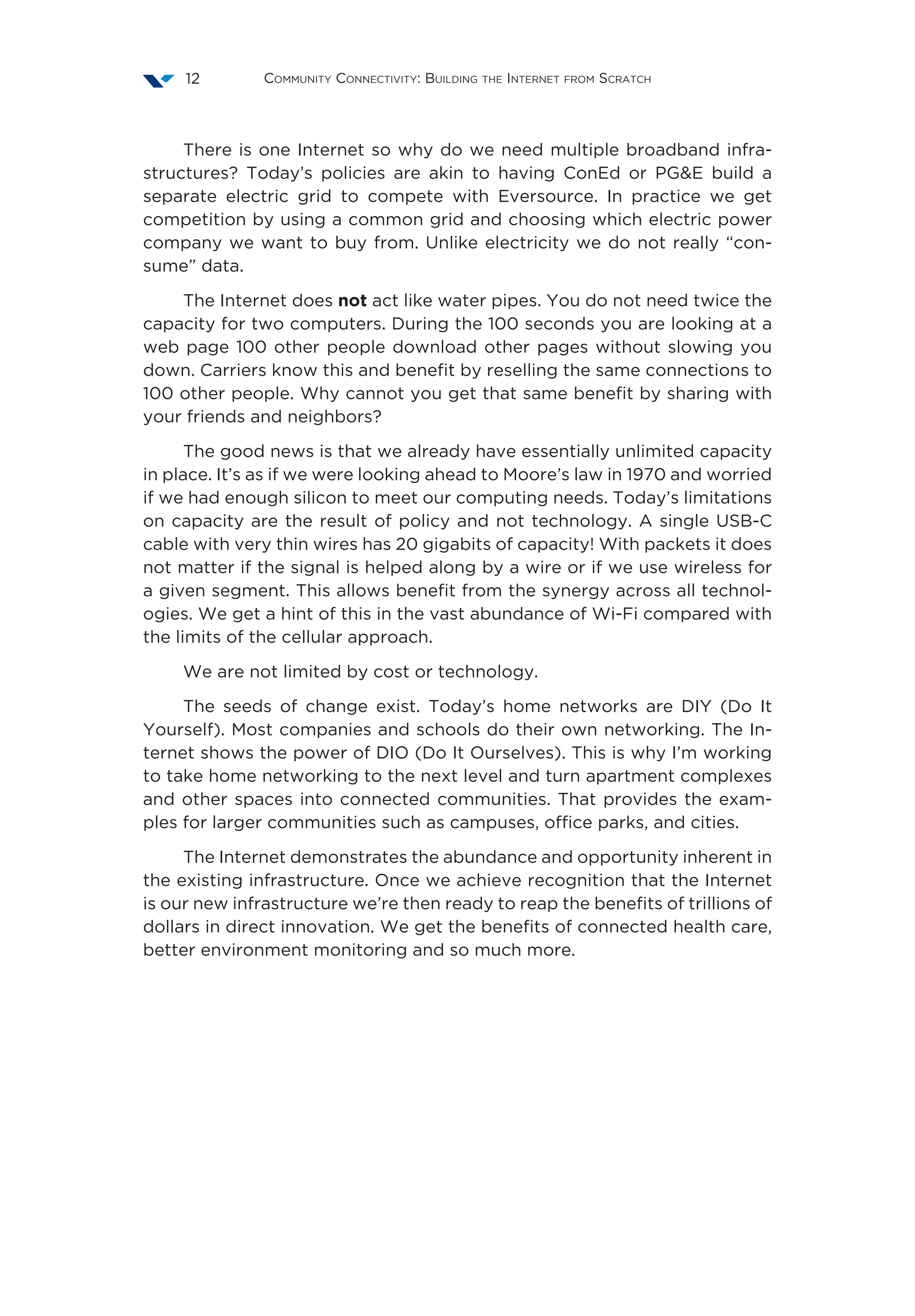
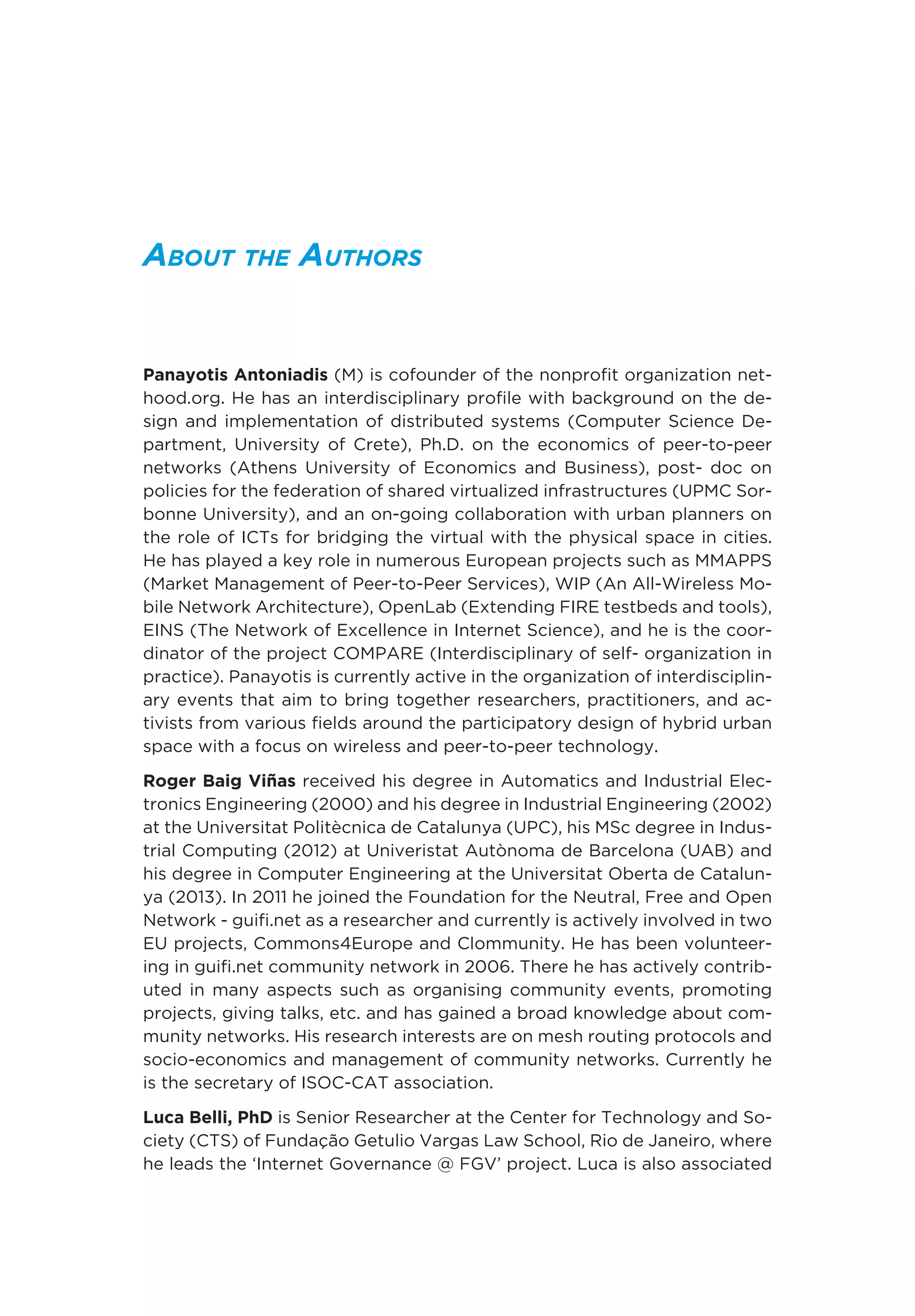
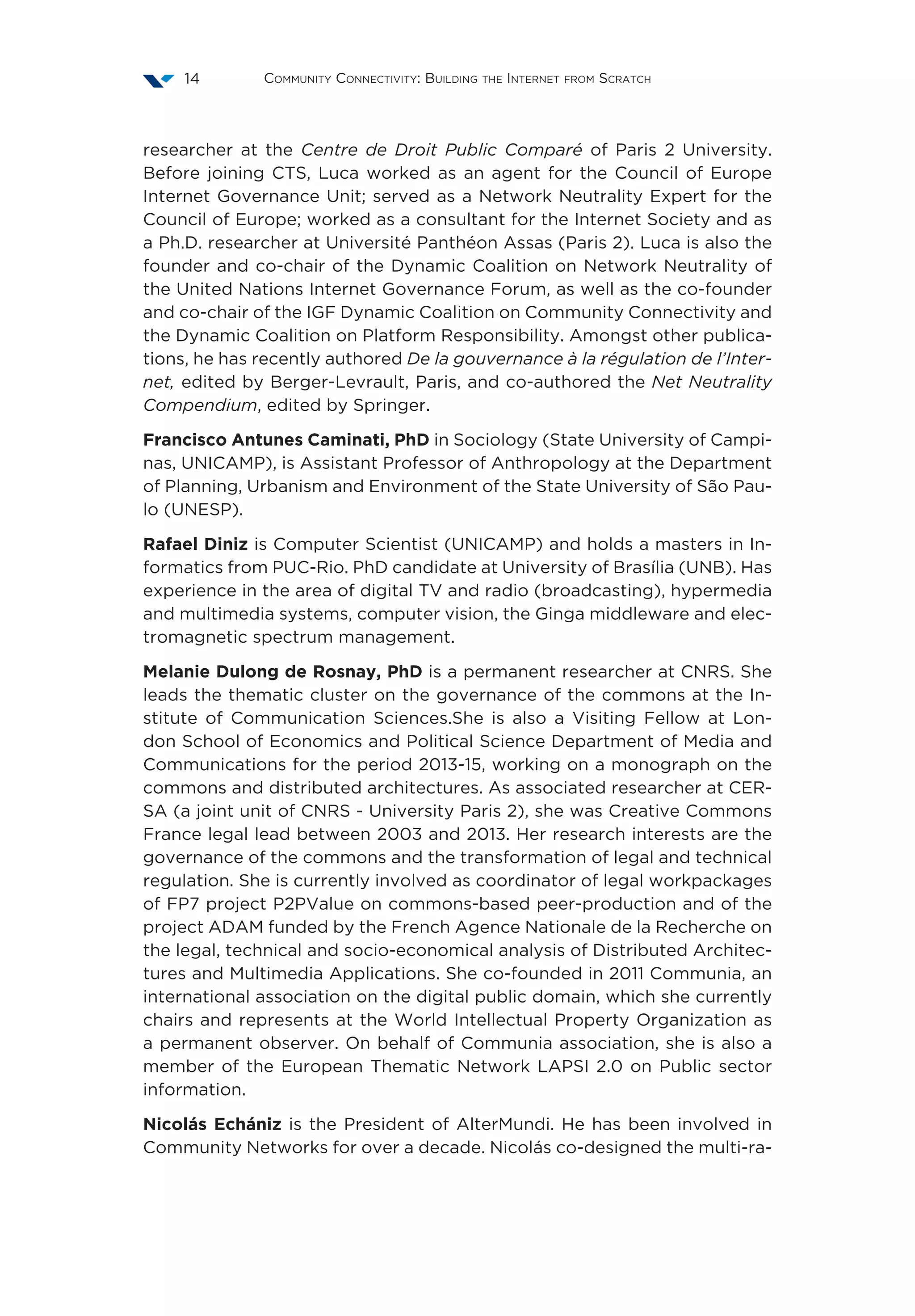
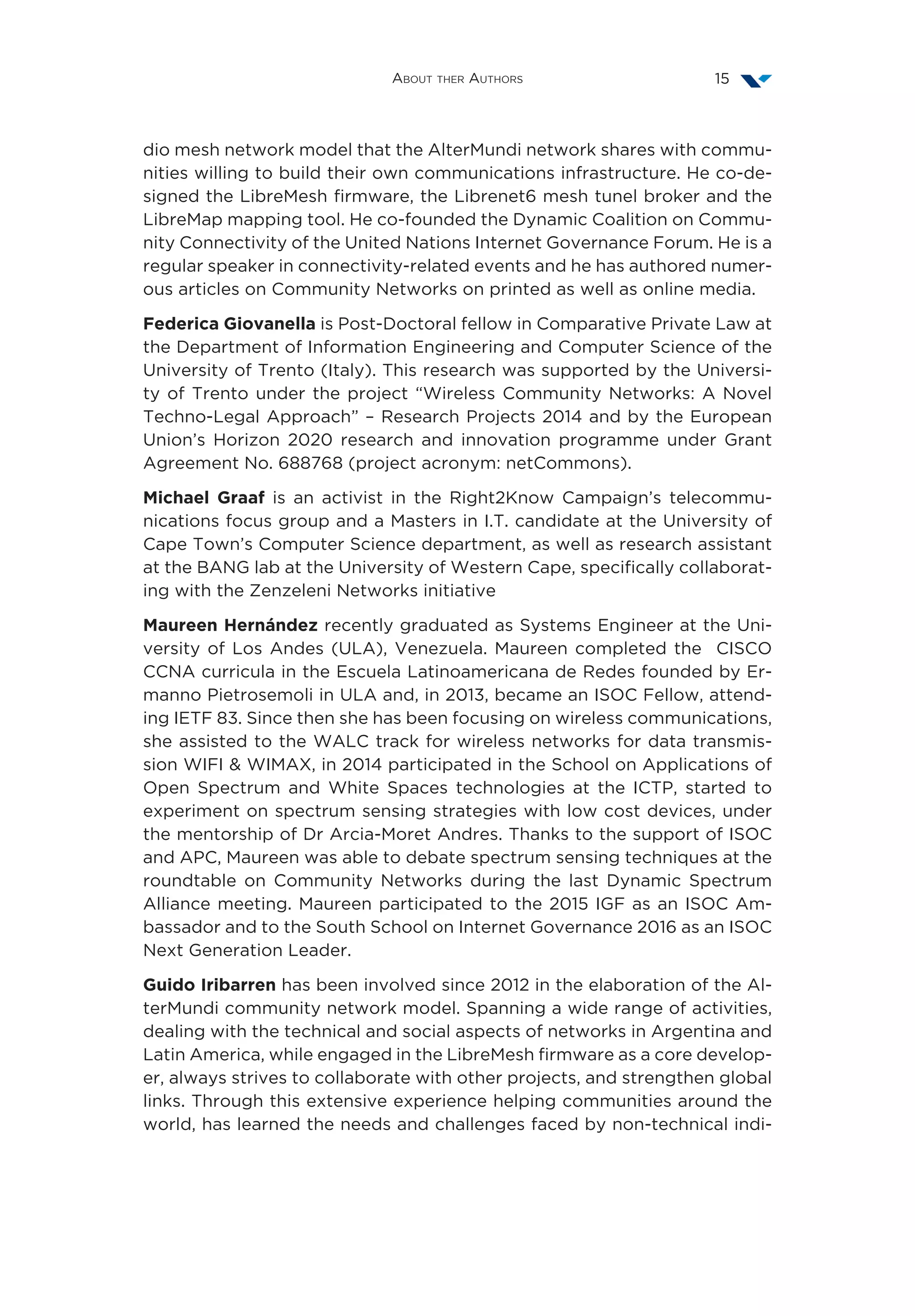
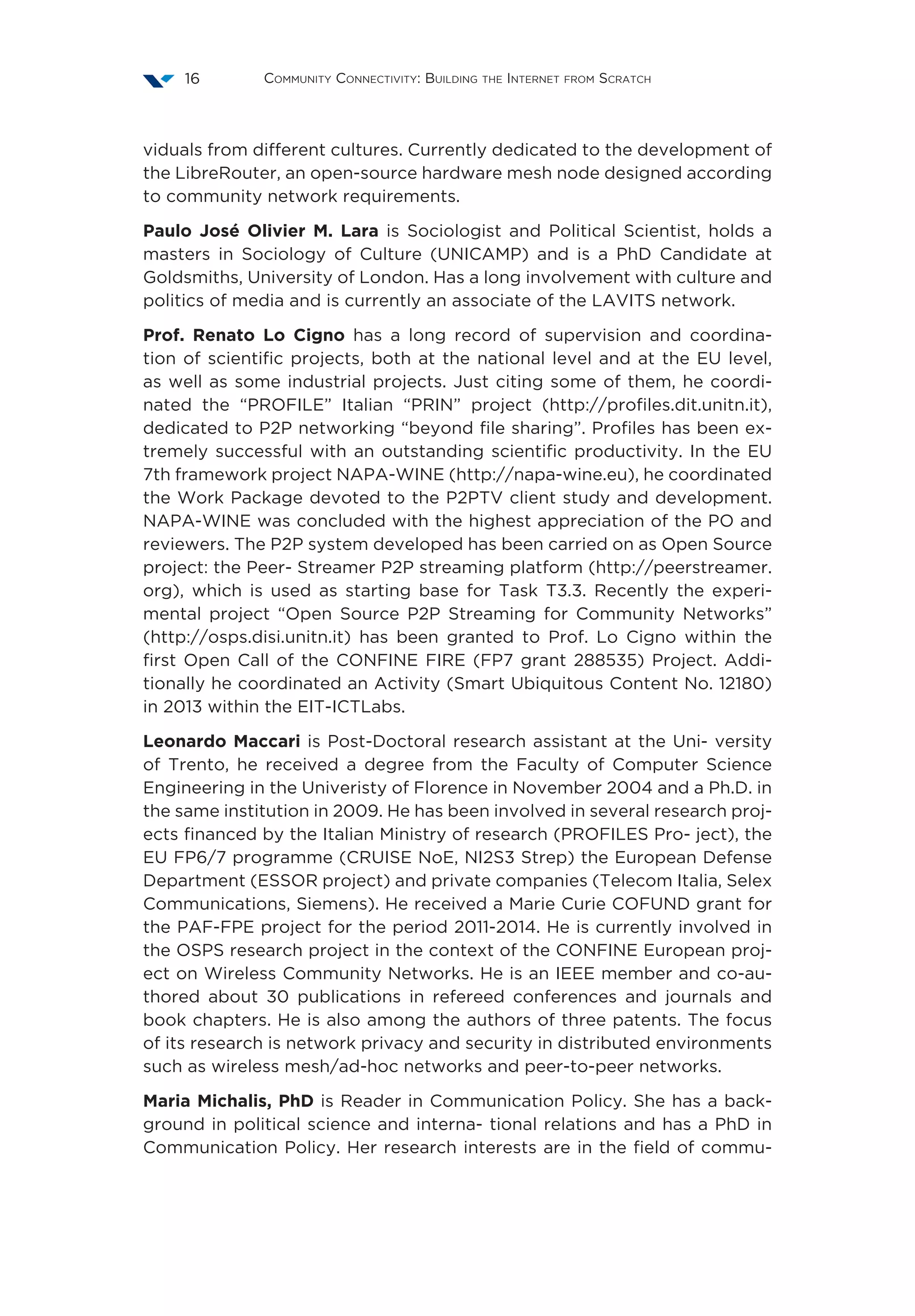
![About ther Authors 17
nication policy and regulation with a view to advance understanding of
how technological, market, social, political and ideological changes impact
upon and are negotiated through power relations and structures as mani-
fested in policy and regulation, primarily in the European Union but within
a comparative context. Her current research focus is on the interplay be-
tween the technological convergence of television and telecommunica-
tions/Internet, policy and business models. Her main research aim is to
explain how transmission issues (including exchange and termination of
digital traffic) shape access to content and audiences and, in turn, the user
experience. In doing so, she points to the societal significance of the need
to consider the interdependence between transmission and content. She
is author of Governing European Communications (Lexington, 2007) and
numerous book chapters and academic articles in journals. She was an
invited expert to the European Social and Economic Committee’s hear-
ing on the European Commission’s consultation on Connected TV (2013)
and contributed to the VLV’s submission to the same consultation. She is
General Secre- tary (elect) of the International Association for Media and
Communication Research (2012- present).
Leandro Navarro is associate Professor at the Computer Architecture De-
partment of UPC. He received his Ph.D. from UPC in 1992. Research inter-
ests include the design of scalable and cooperative Internet services and
applications. He coordinates the CNDS (Computer Networks and Distrib-
uted Systems) research group at UPC. He is responsible for the Erasmus
Mundus Master in Distributed Computing at UPC. He coordinates the CON-
FINE IP project and the Erasmus Mundus Joint Doctorate in Distributed
Computing (EMJD-DC), the national project P2PGrid (www.p2pgrid.info)
and, among others, has participated in the FET Catnet, FET Catnets, SOR-
MA, Grid4All FP6 EU projects. He is also council member of the Associa-
tion for Progressive Communications (www.apc.org).
Cristiana Gonzalez is Ph.D. candidate at the University of São Paulo and
researcher at Center for Technology and Society (CTS) of Fundação Getu-
lio Vargas Law School, Rio de Janeiro. Before jining CTS, she was technical
adviser at the Brazilian Internet Steering Committe (CGI.br), researcher at
Brazilian Institute for Consumers Rights (IDEC) and project coordinator
for the Association for Progressive Communications (APC). She worked
for six years at GPOPAI – Research Group in Public Policies for Access to
Information – at University of São Paulo.
Anna Orlova, MA in psychology and sociology at St-Petersburg State Uni-
versity, (PhD Candidate at FREIE University of Berlin) is Researcher and
facilitator of Digital [x] Working Group of Cooperation and Development
Network - Eastern Europe (cdnee.org), researching alternative forms of
digital activism and advocacy, online community management in regards
to severe forms of digital discrimination.](https://image.slidesharecdn.com/communityconnectivity-buildingtheinternetfromscratch-170106183237/75/Community-connectivity-building-the-Internet-from-scratch-17-2048.jpg)
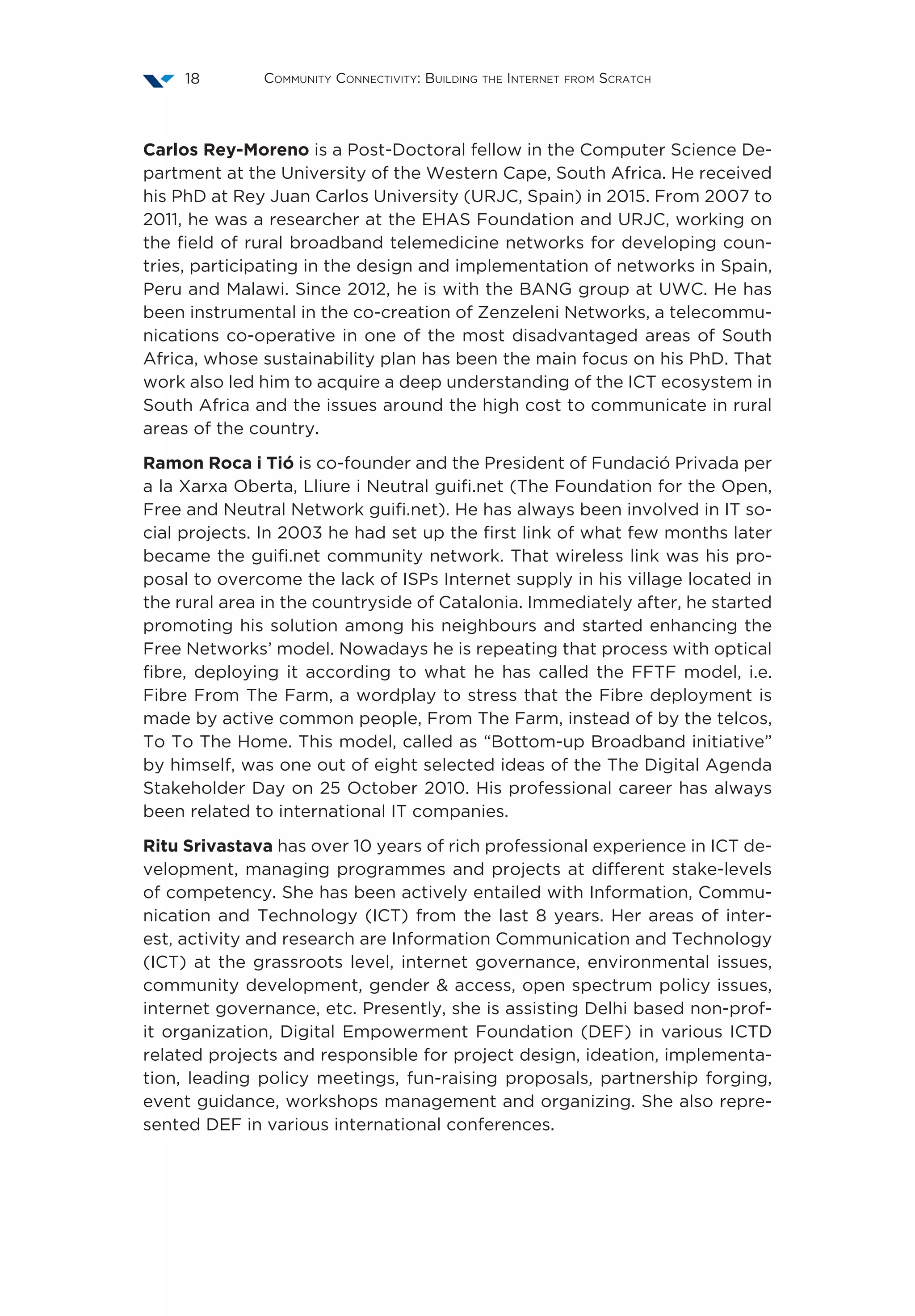
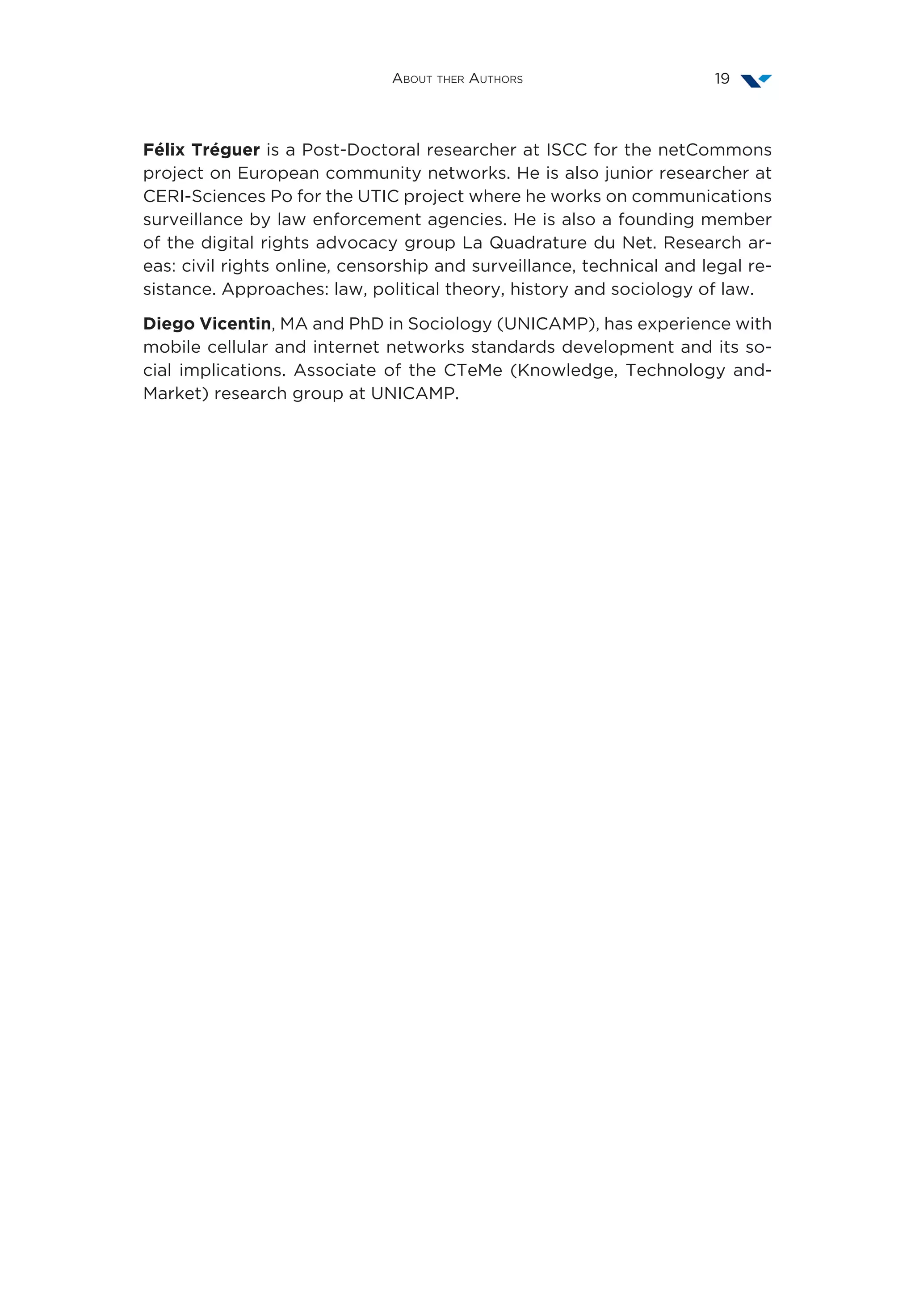

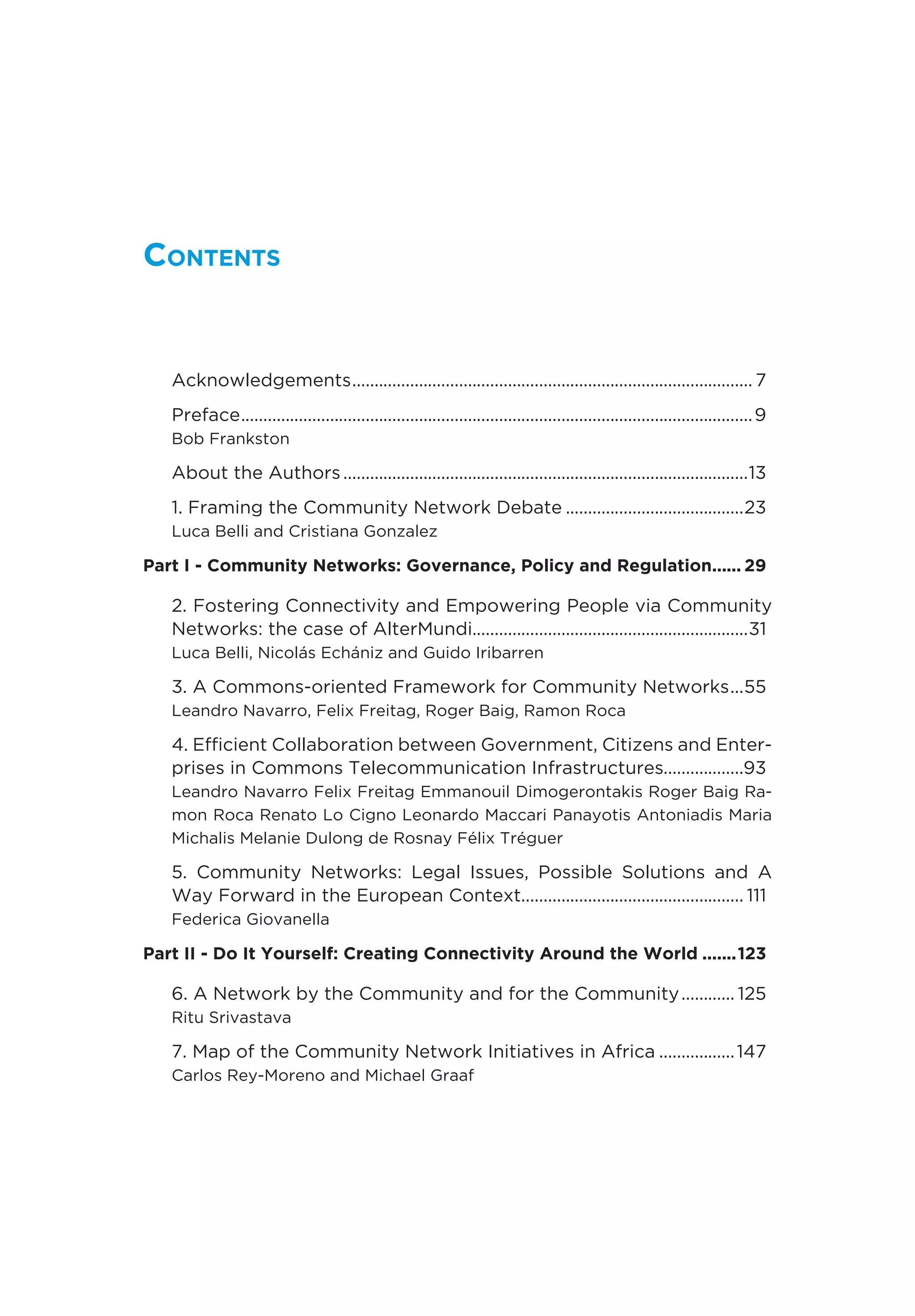
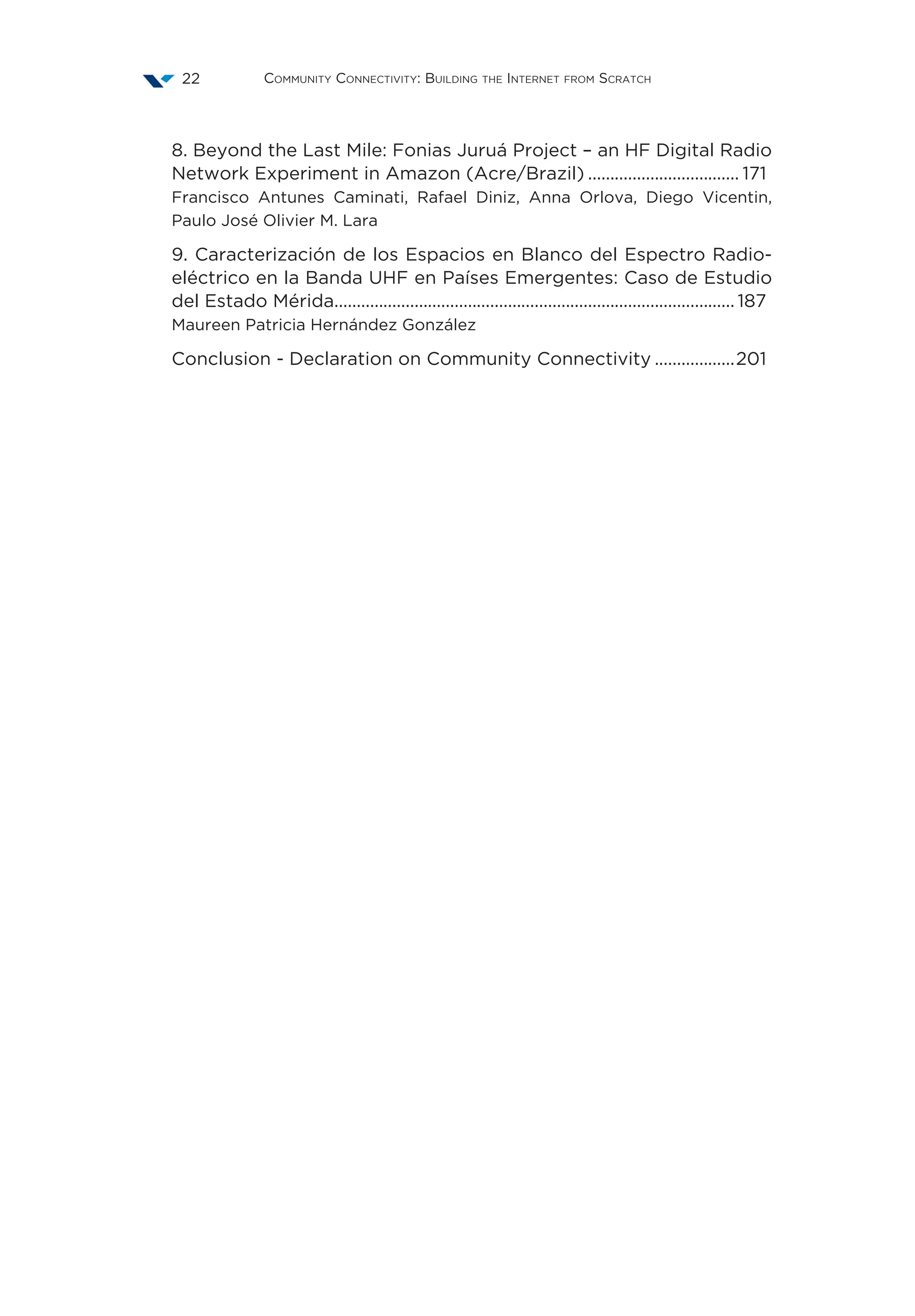
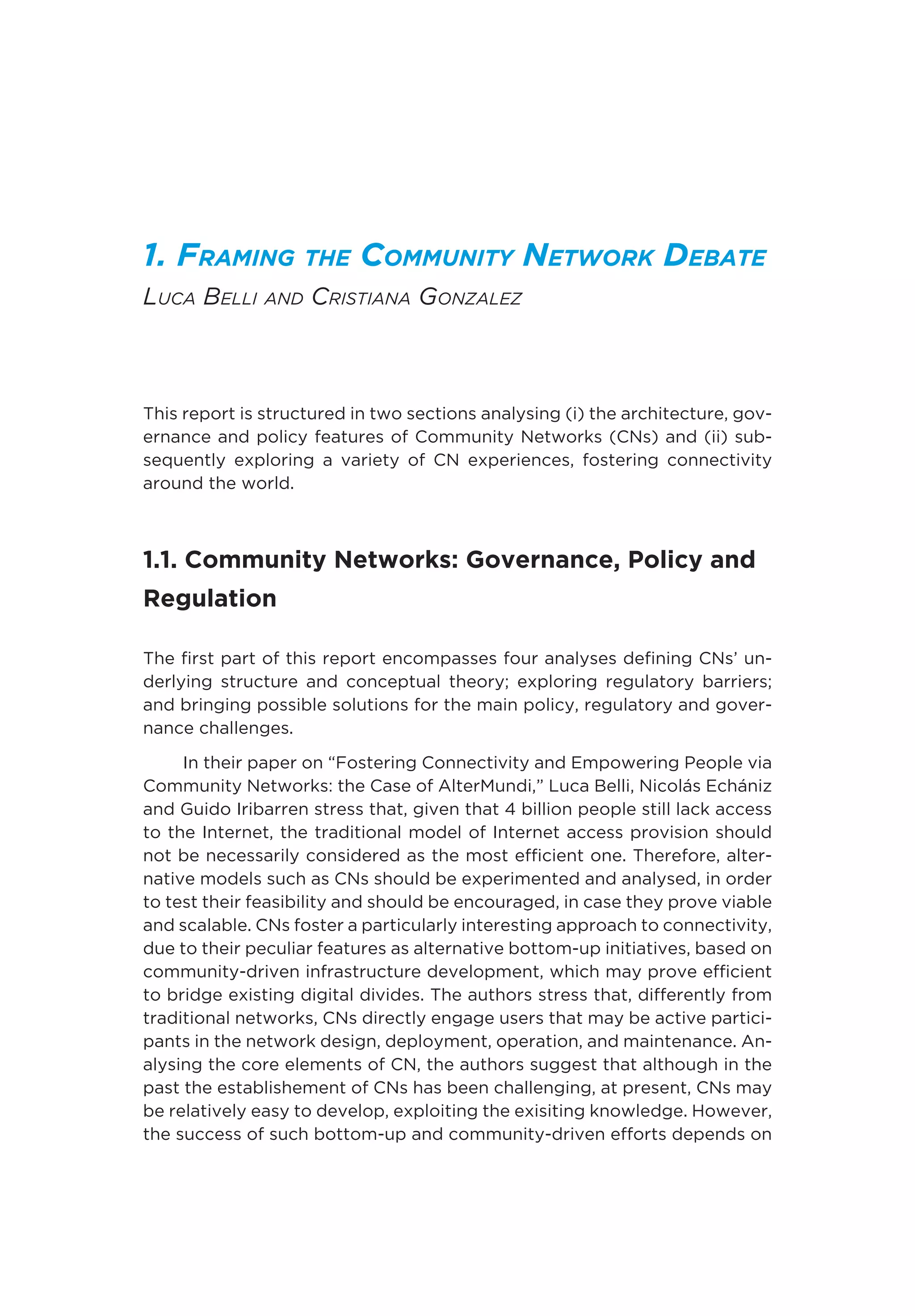
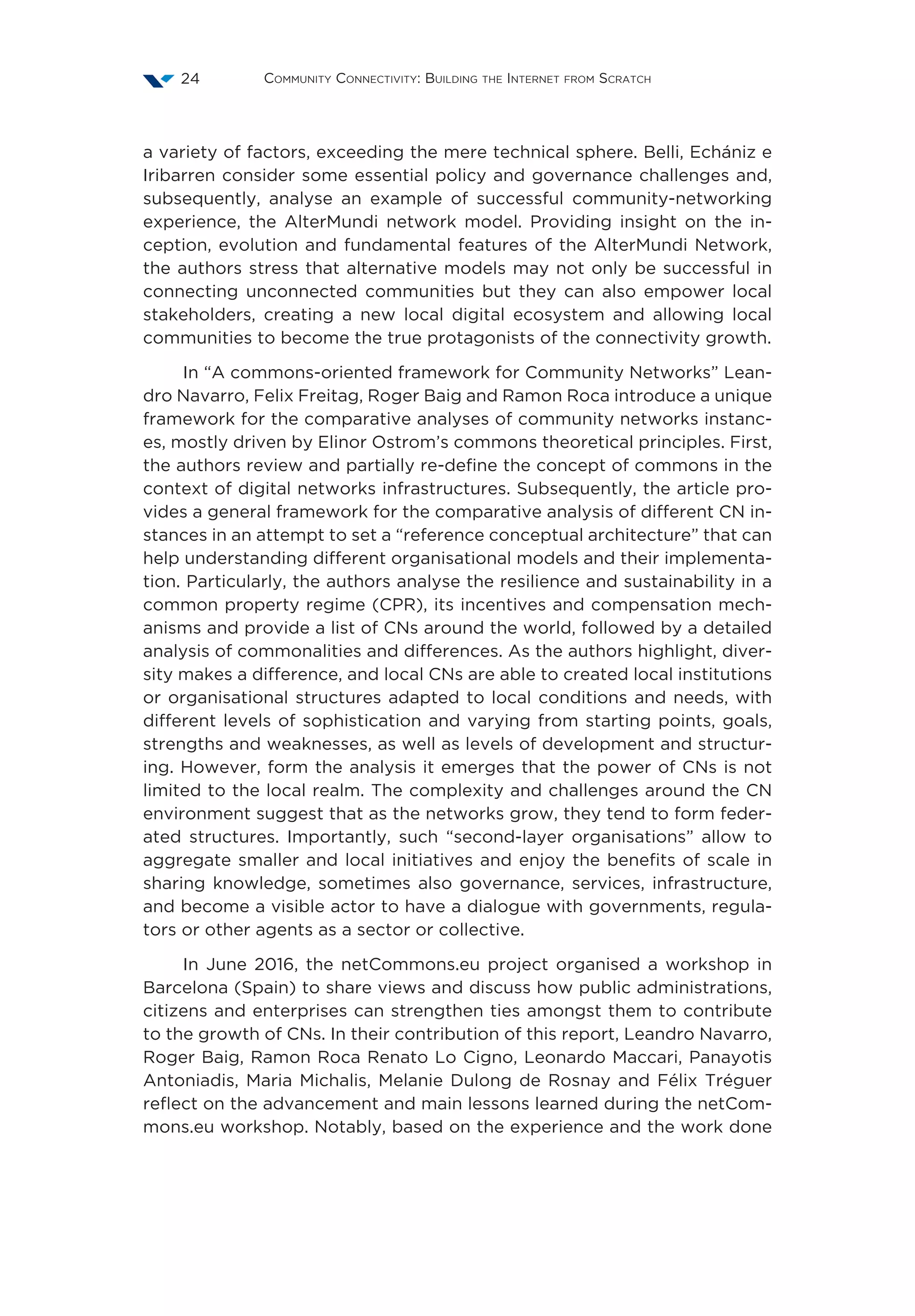
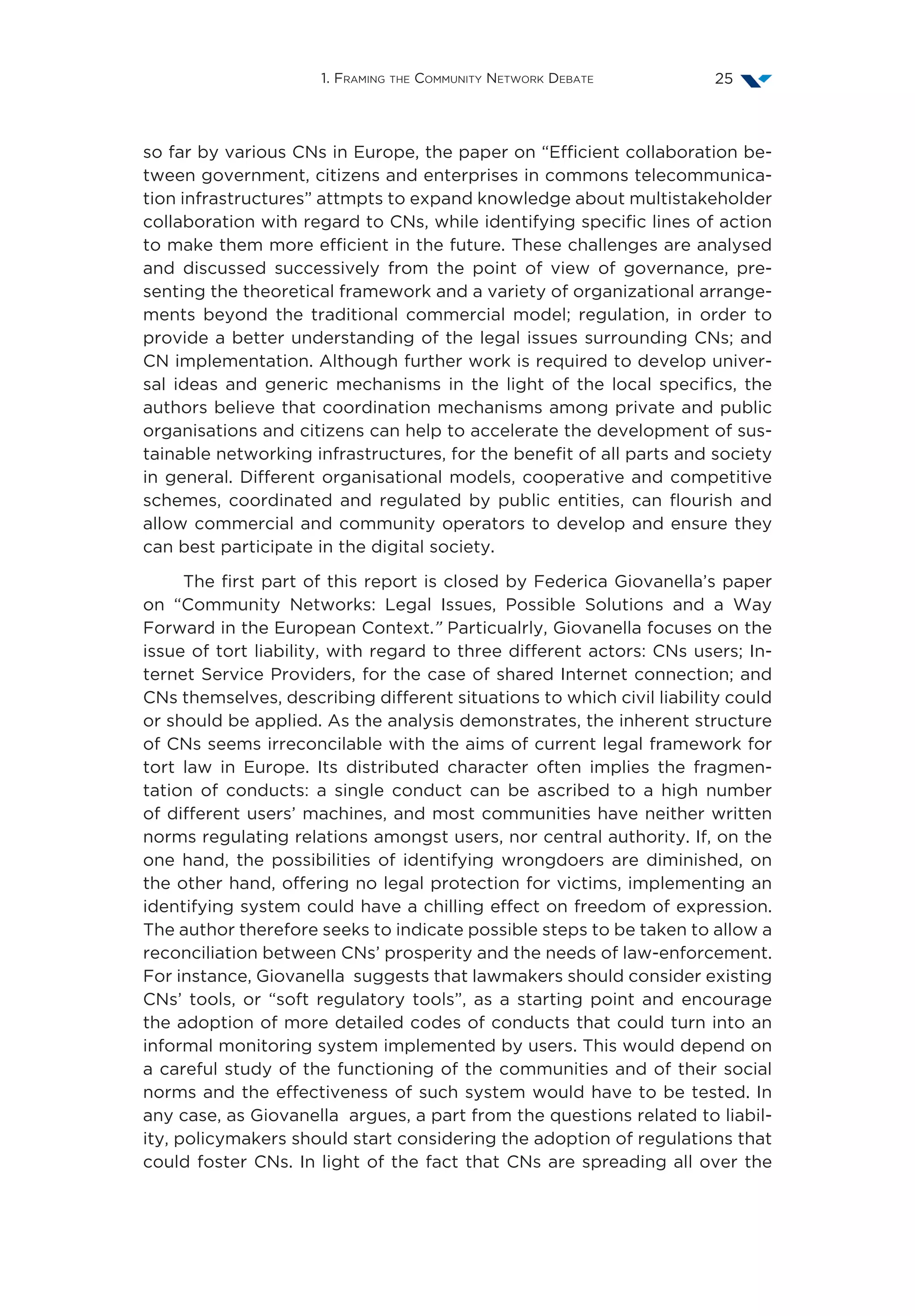
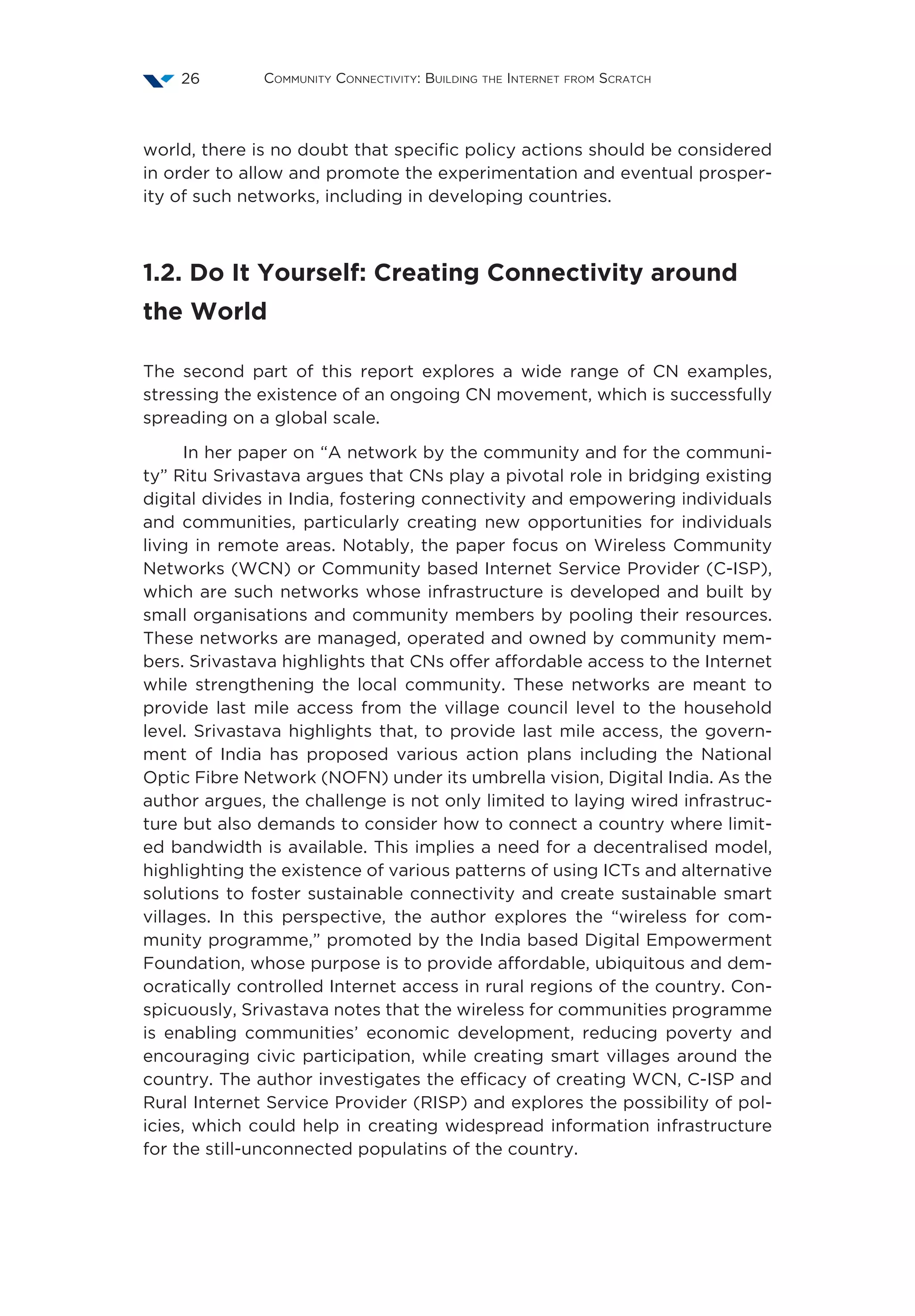
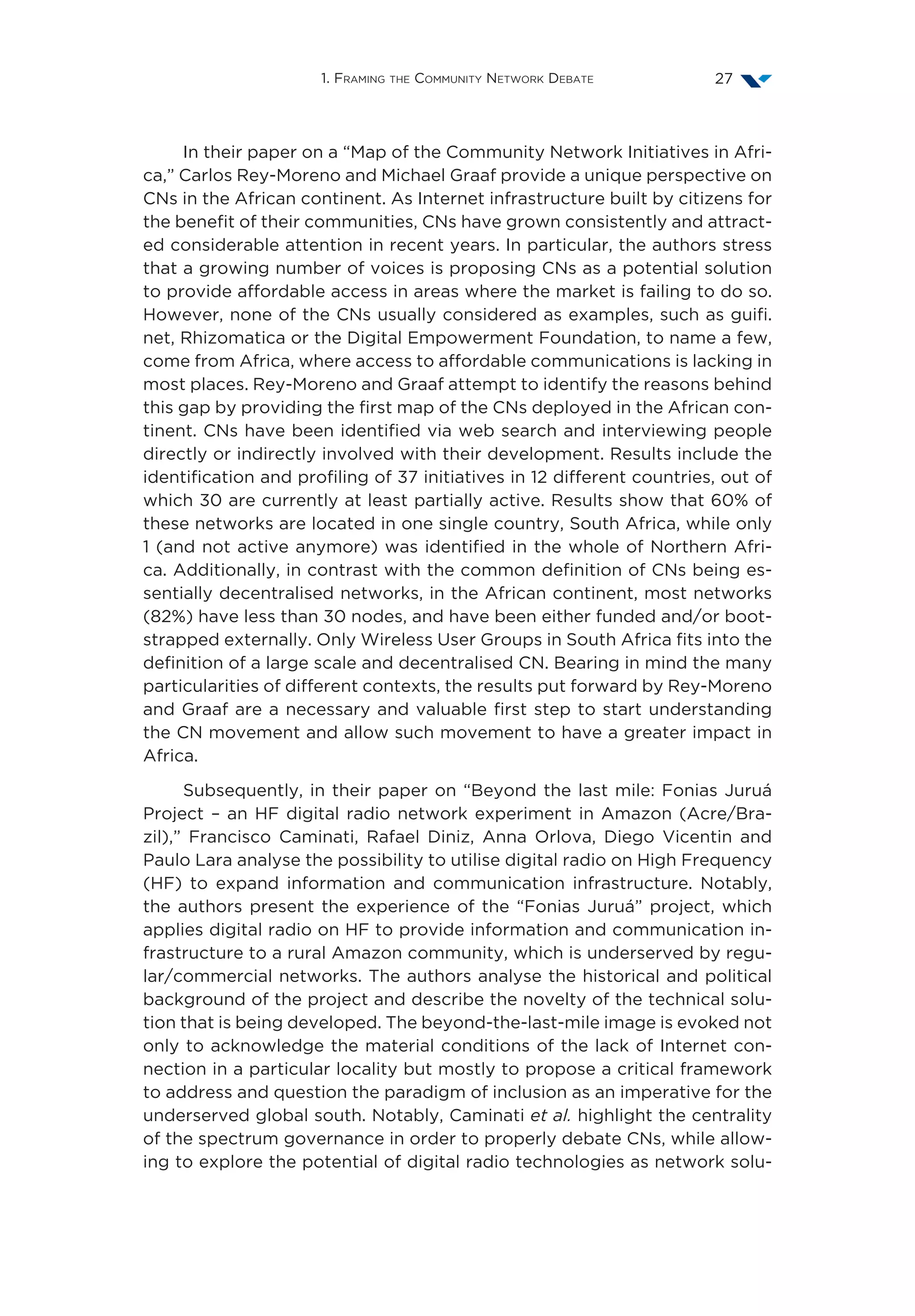
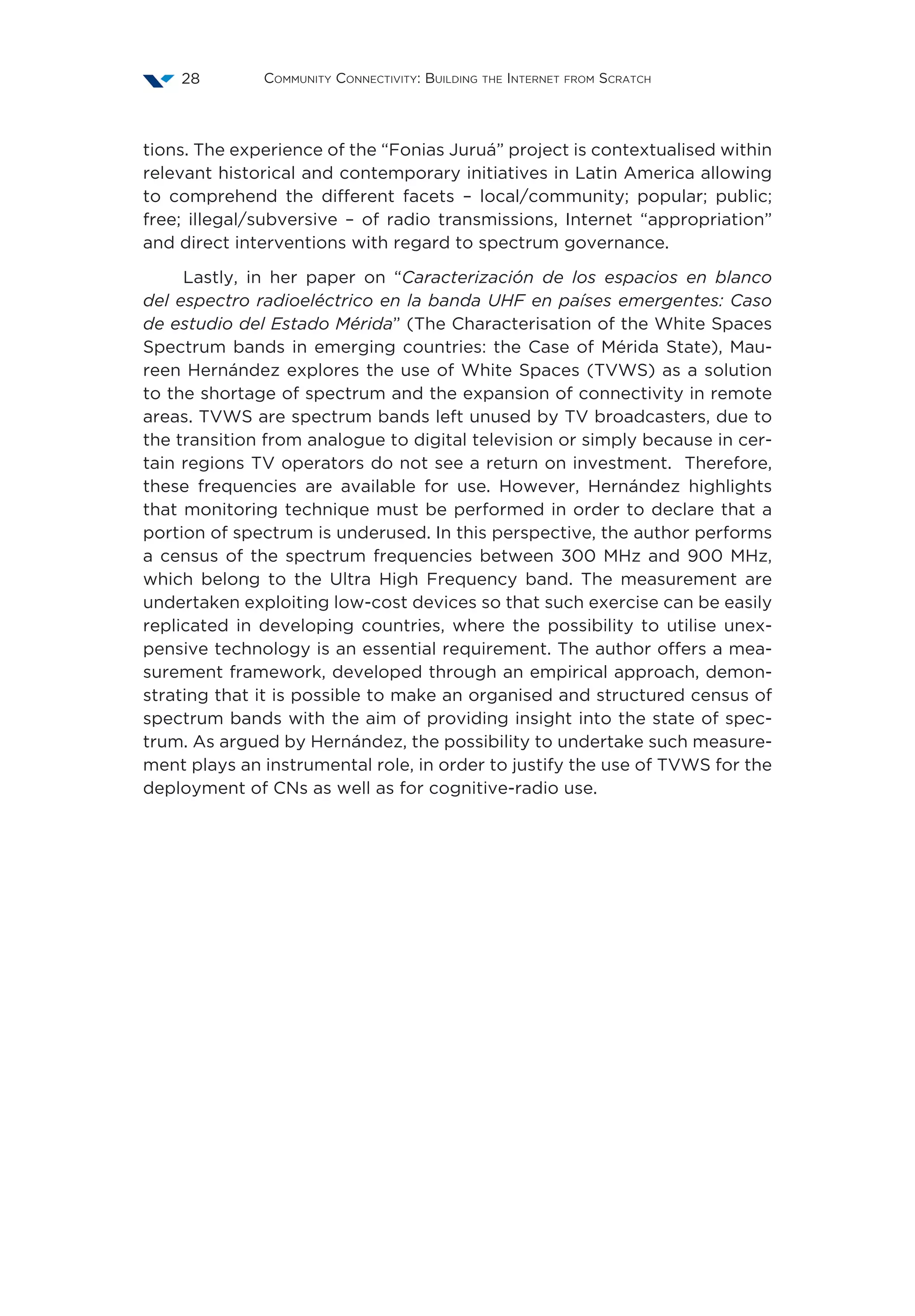
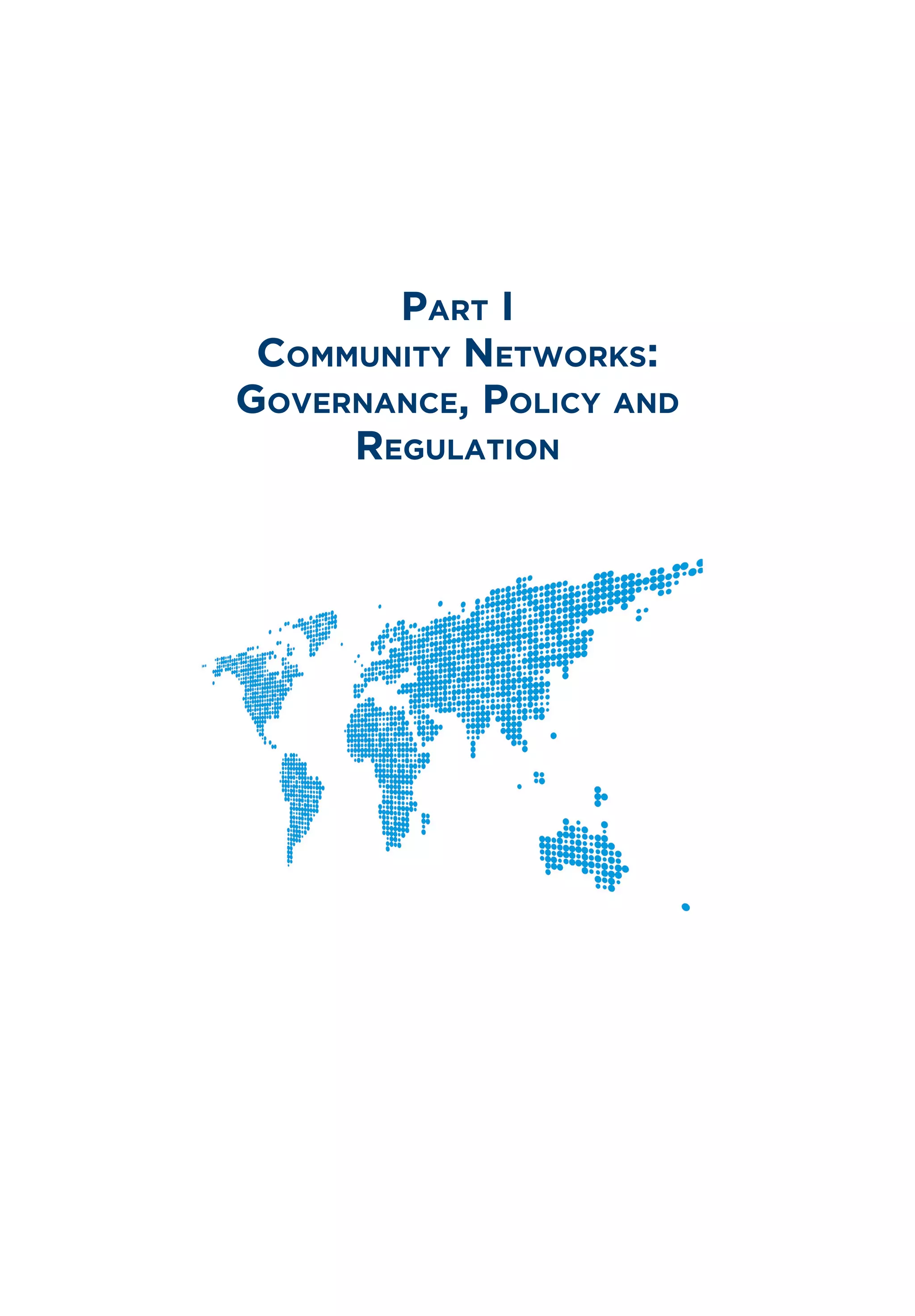

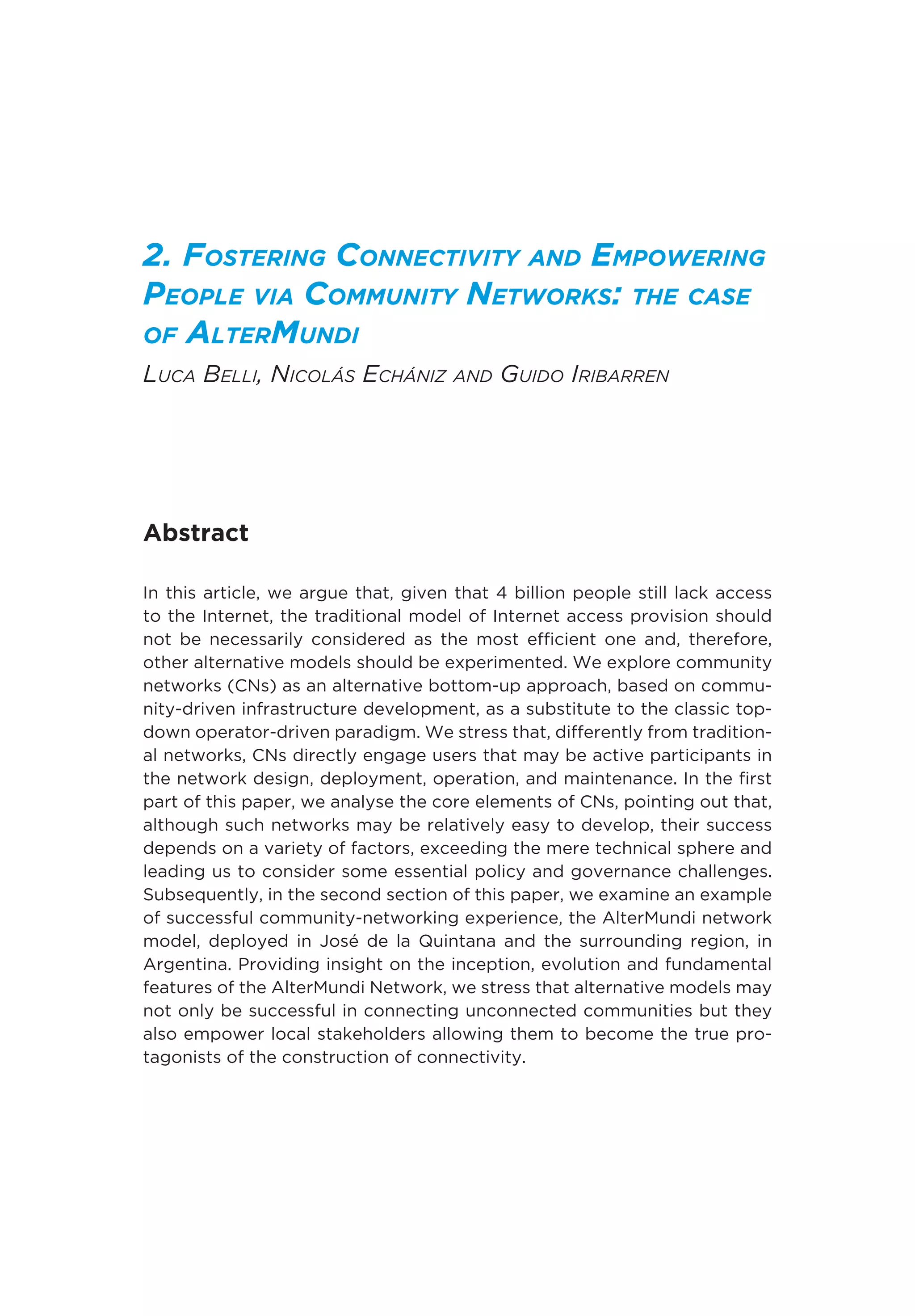
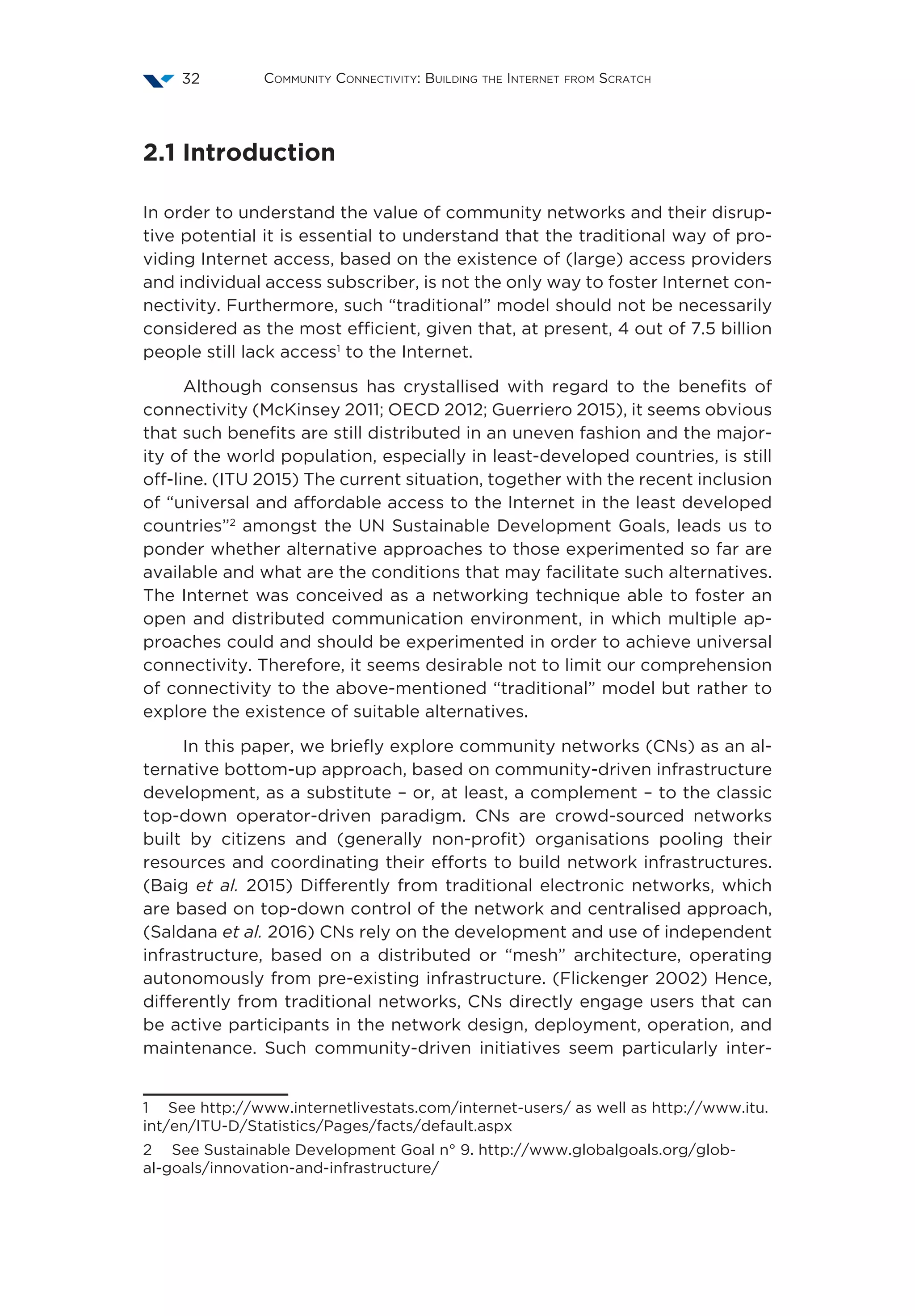
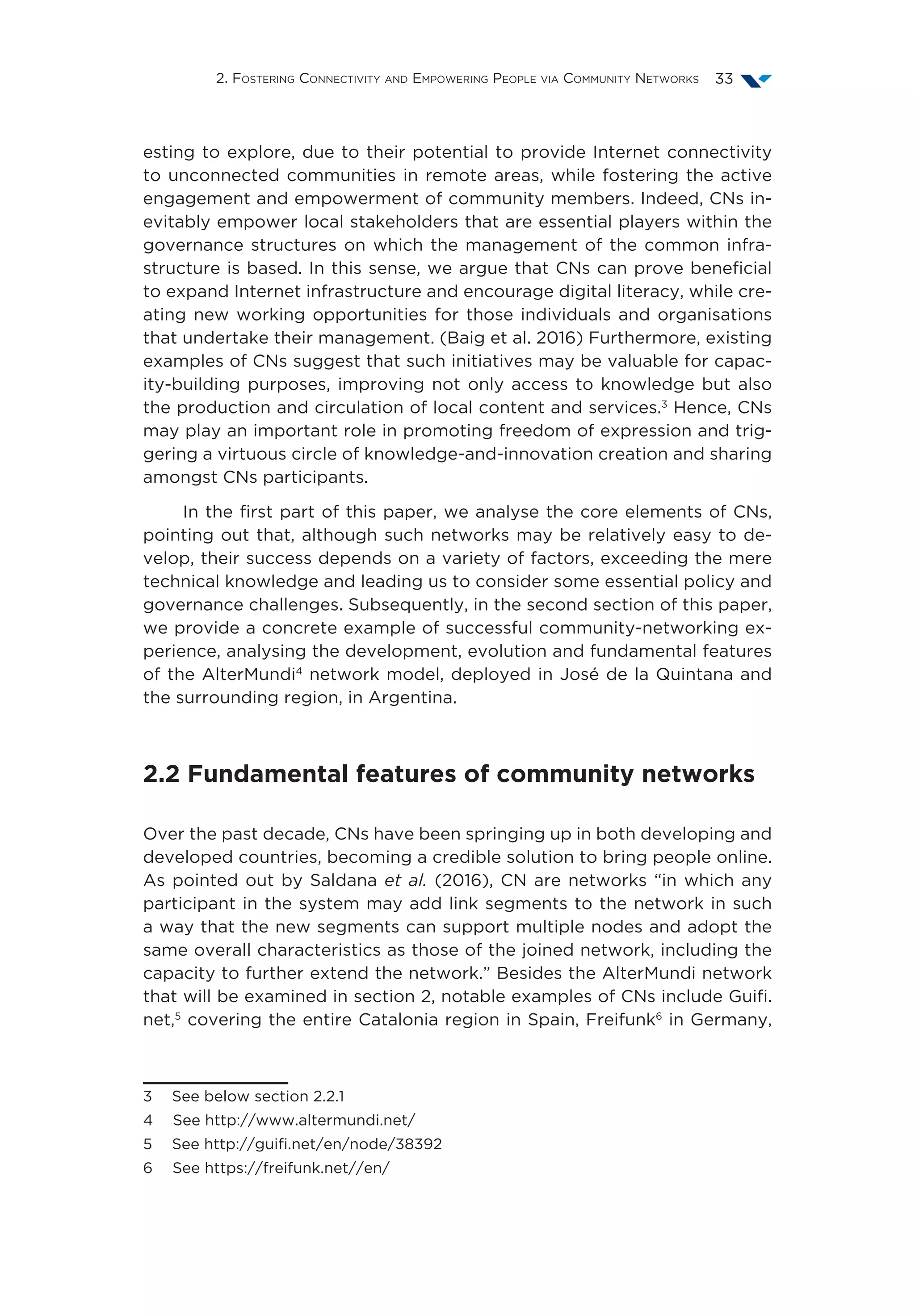
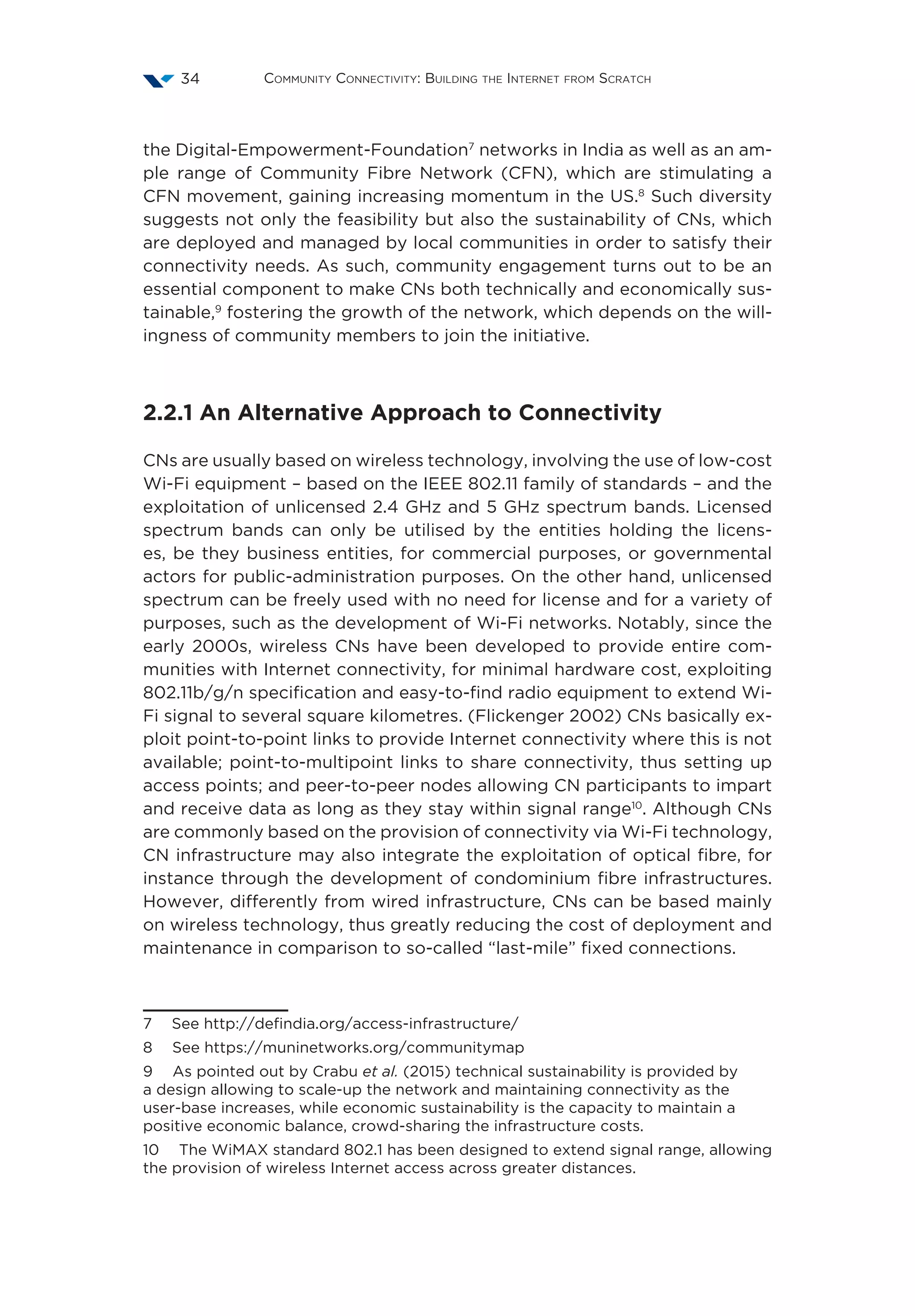
![2. Fostering Connectivity and Empowering People via Community Networks 35
Both Wi-Fi and fibre-based CNs rely on community-driven efforts and
aim at creating new infrastructure that can be entirely autonomous from
the existing one, which is managed by traditional operators. Indeed, as
argued by Bar and Galperin (2004), one of the main reasons leading to the
development of CNs is the emergence of “bottom up dynamics […], where
multiple network players are independently pursuing the development of
wireless infrastructure.” In such context, CN participants – the ones that
the traditional paradigm for Internet access provision considers as mere
customers – undertake an active role operating and maintaining the CN,
while traditional operators are not needed anymore to provide Internet
access to individuals, but rather undertake a function of backbone-con-
nectivity providers, in order to connect the various CNs.
Such model has proved to be well suited to meet the needs of small
communities where CN participants have a say in the CN management and
can directly perceive the benefits of connectivity. Notably, the side effects
of the community engagement in the construction and maintenance of the
new infrastructure are the promotion of the local (digital) economy and
digital inclusion. However, it is important to note that CNs are not limit-
ed to small realities. On the contrary, existing examples such as Guifi.net
and the Freifunk network show that these initiatives may be scalable and
cover quite extended geographic areas. Furthermore, it seems important
to stress that such initiatives do not imply a lower level of quality. Indeed,
CN members may be keen and capable to deploy state of the art technol-
ogies that cannot only compete but also have much higher performances
than traditional providers’ networks, particularly in rural areas.11
Besides
facilitating community cohesion, the bottom-up dynamics at the core of
CNs incentivise the experimentation of innovative mechanisms allowing
the participation of local-community members into the new socio-techni-
cal network established by and through the CN. Hence, although CNs were
initially born to provide a solution to existing digital divides, their evolution
has prompted the exploitation of connectivity to create new socio-eco-
nomic environments in a bottom-up fashion.
In In this sense, CNs may be an effective stimulator of Internet gener-
ativity,12
reinforcing Internet users’ peculiar role of prosumers, i.e. both pro-
ducers and consumers of content and applications. In fact, CNs seem to
foster a particular type of generativity, based on the collaborative elabora-
tion and implementation of new applications and services. As an instance,
11 See e.g. Altermundi. Multiple hop mesh performance with multi-band dual-ra-
dio routers. https://blog.altermundi.net/article/multiple-hop-mesh-performance-
with-multi-band-dual/
12 Generativity is generally referred to as “a system’s capacity to produce unan-
ticipated change through unfiltered contributions from broad and varied audienc-
es.” See Zittrain (2008), p. 70.](https://image.slidesharecdn.com/communityconnectivity-buildingtheinternetfromscratch-170106183237/75/Community-connectivity-building-the-Internet-from-scratch-35-2048.jpg)
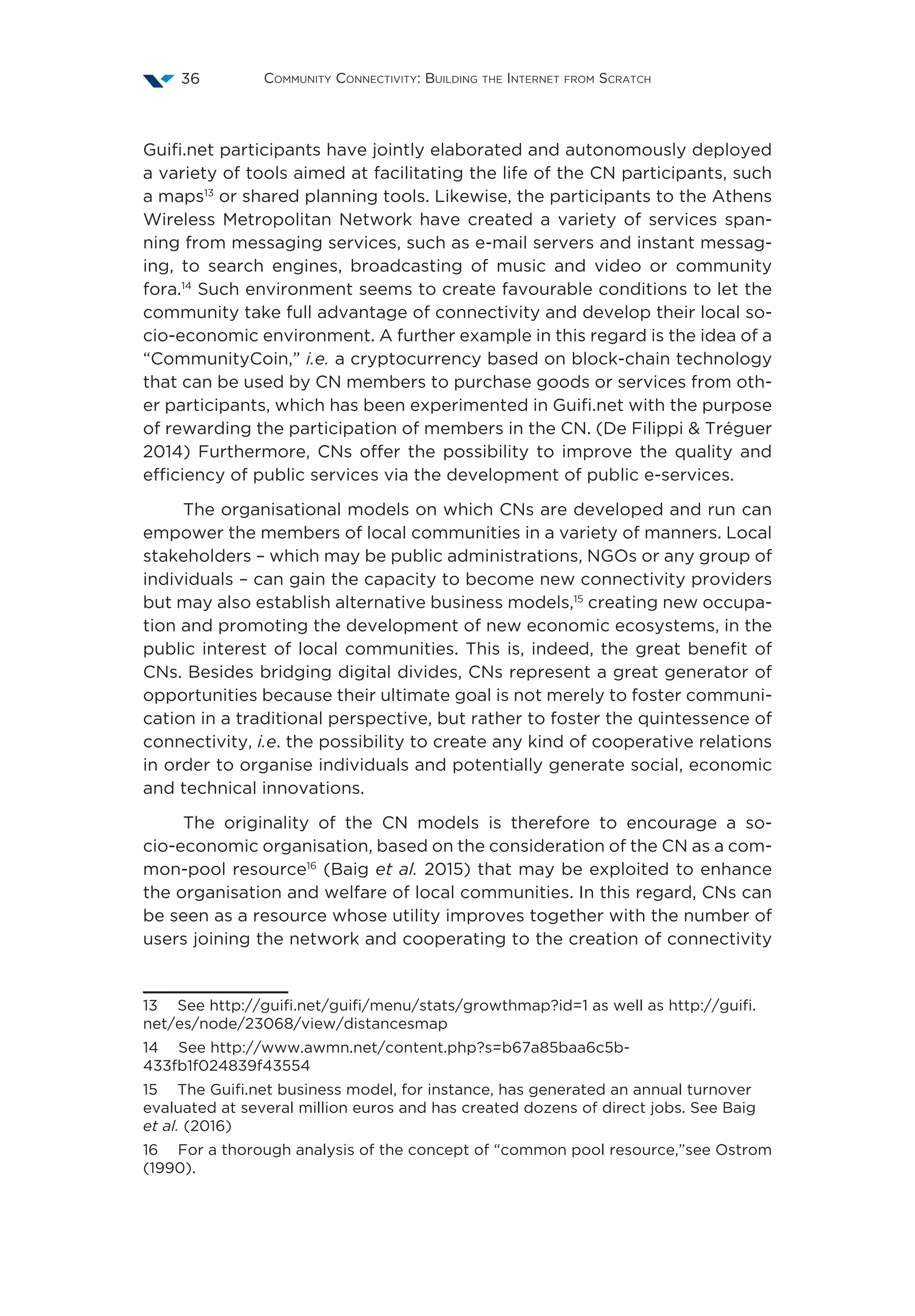
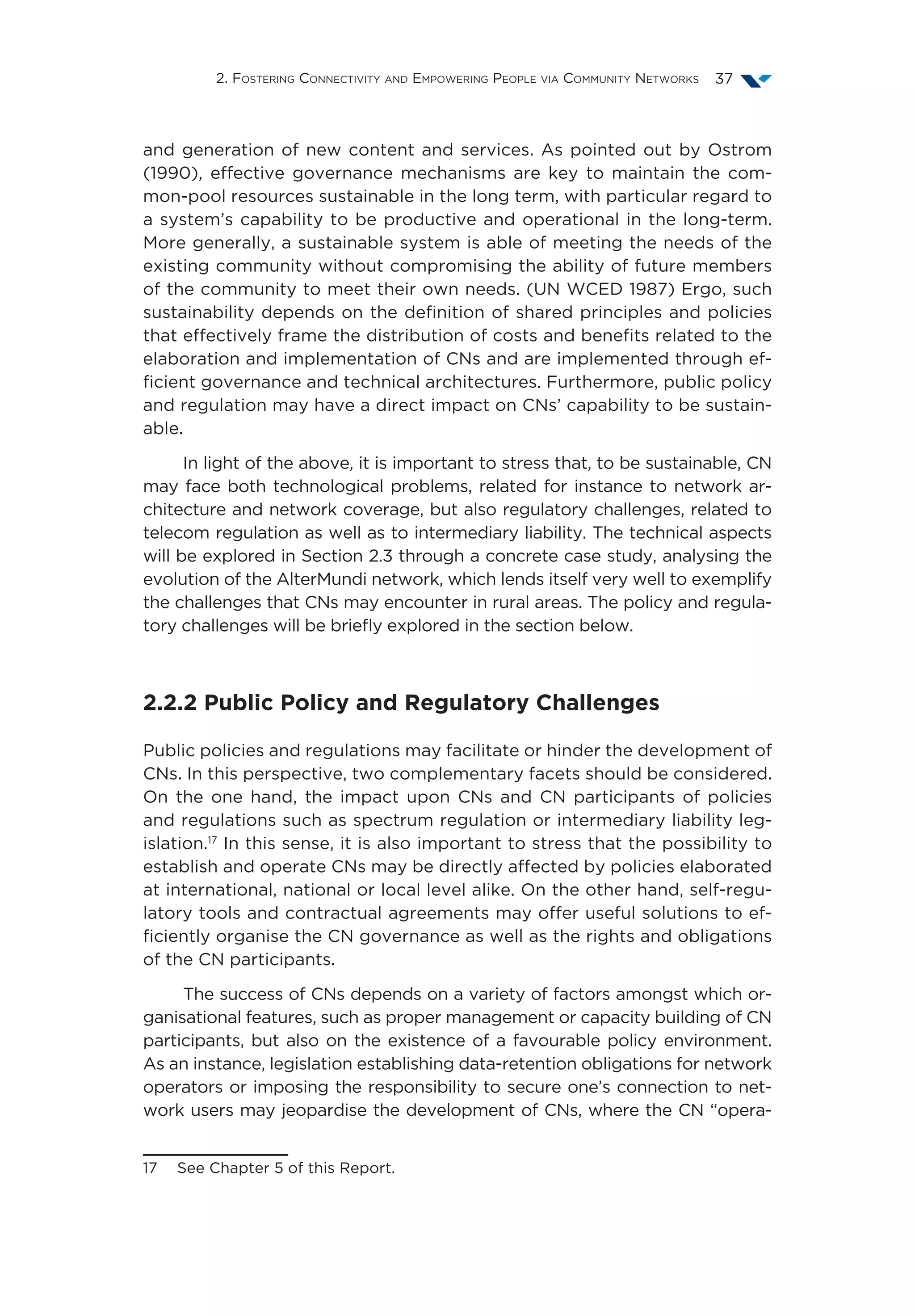
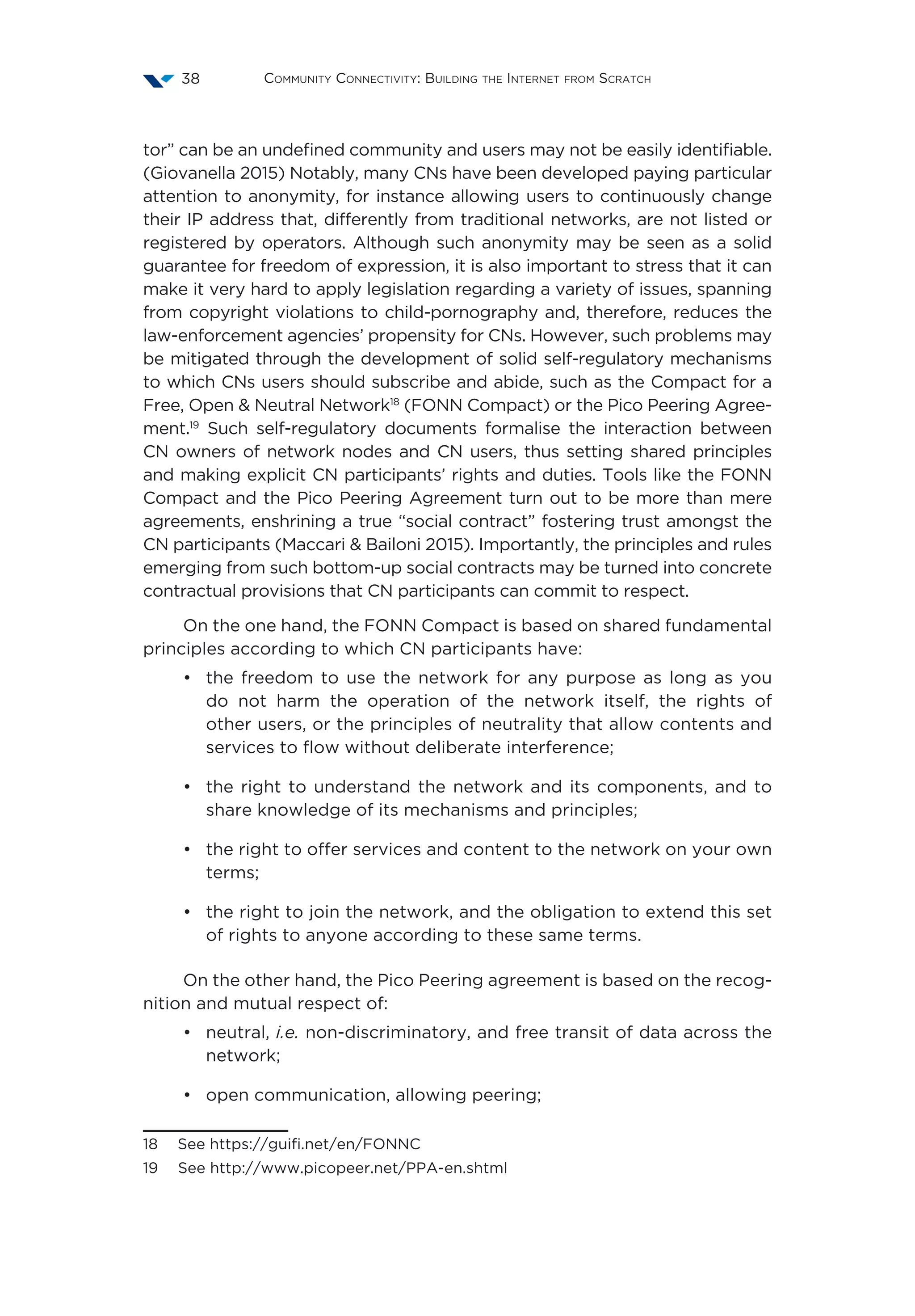
![• best effort delivery, i.e. no guarantee of quality of service;
• the possibility for the node’s owner to establish ‘acceptable use
policy’ as long as it does not contradict the abovementioned points.
In addition, national and international policies and regulations con-
cerning issues such as spectrum allocation may have a direct impact on CN
development. Indeed CNs critically rely on the availability of unlicensed
spectrum or unused spectrum bands such as TV white spaces20
as a critical
resource for inexpensive connectivity through the use of wireless technol-
ogy. In this perspective, rules favouring the use of unlicensed or unused
spectrum bands are key to allow the development of wireless CNs and
bridge digital divides, connecting marginalised (and frequently rural) ar-
eas. Conversely, scarcity of spectrum may challenge the stability of CNs
and the services they provide. For this reason, existence of unlicensed
spectrum and the possibility to utilise dynamic spectrum solutions21
to ex-
ploit TV white spaces play a key role in facilitating the deployment and
well-functioning of CNs. (Saladana et al. 2016)
In this sense, CNs rely on national regulators’ willingness to maintain
part of the spectrum unlicensed, rather than entirely licensing it to private
providers, and to allow secondary use TV white spaces. Furthermore, the
deployment of wireless CNs is clearly incentivised by regulations allowing
municipalities to actively use unlicensed spectrum and spectrum reserved
for public safety for wireless CN development.
2.2.3 The importance of Public Stakeholders
It is important to stress that, although CNs usually emerge from bottom-up
efforts driven by individuals or NGOs, local governments play a key func-
tion with regard to facilitating the development of CNs. Notably, Gillett
20 The term “white spaces” is generally used to describe “VHF and UHF tele-
vision frequencies […] to be exploited on a secondary use basis. There are two
dominant standards for TV White Space communication: (i) the 802.11af standard
[IEEE.802.11AF] -- an adaptation of the 802.11 standard for TV White Space bands
-- and (ii) the IEEE 802.22 standard [IEEE.802.22] for long-range rural communica-
tion.” See Saldana et al. (2016).
21 In the locations where licensed users do not exploit their UHF and VHF
television frequencies, CN users may act as secondary users, making use of the
unexploited TV White Spaces. In order to do so, Saldana et al. (2016) highlight that
specific equipment “is required to detect the presence of existing unused TV chan-
nels by means of a spectrum database and/or spectrum sensing in order to ensure
that no harmful interference is caused to primary users. In order to smartly allocate
interference-free channels to the devices, cognitive radios are used that are able
to modify their frequency, power, and modulation techniques to meet the strict
operating conditions required for secondary users.”](https://image.slidesharecdn.com/communityconnectivity-buildingtheinternetfromscratch-170106183237/75/Community-connectivity-building-the-Internet-from-scratch-39-2048.jpg)
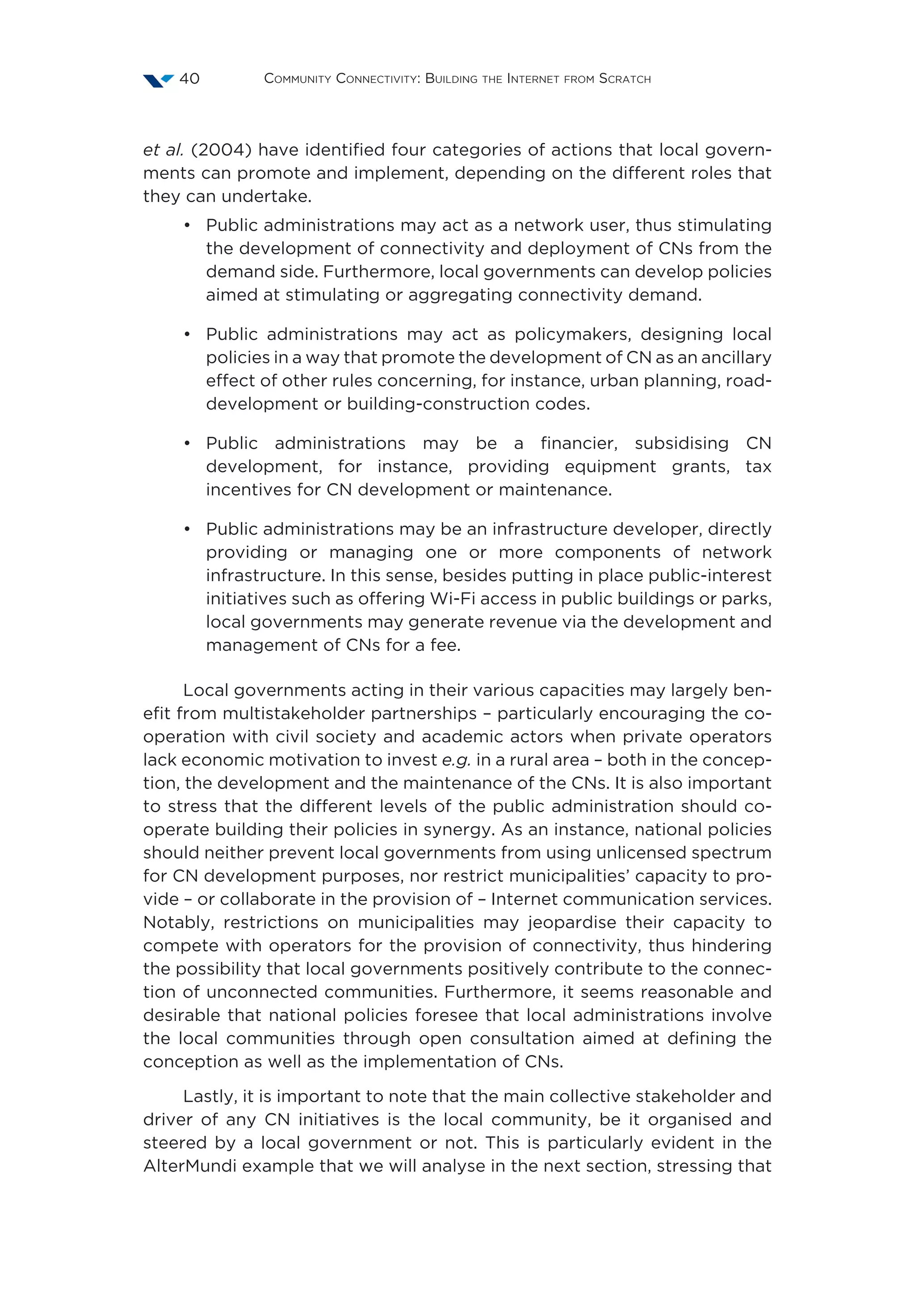
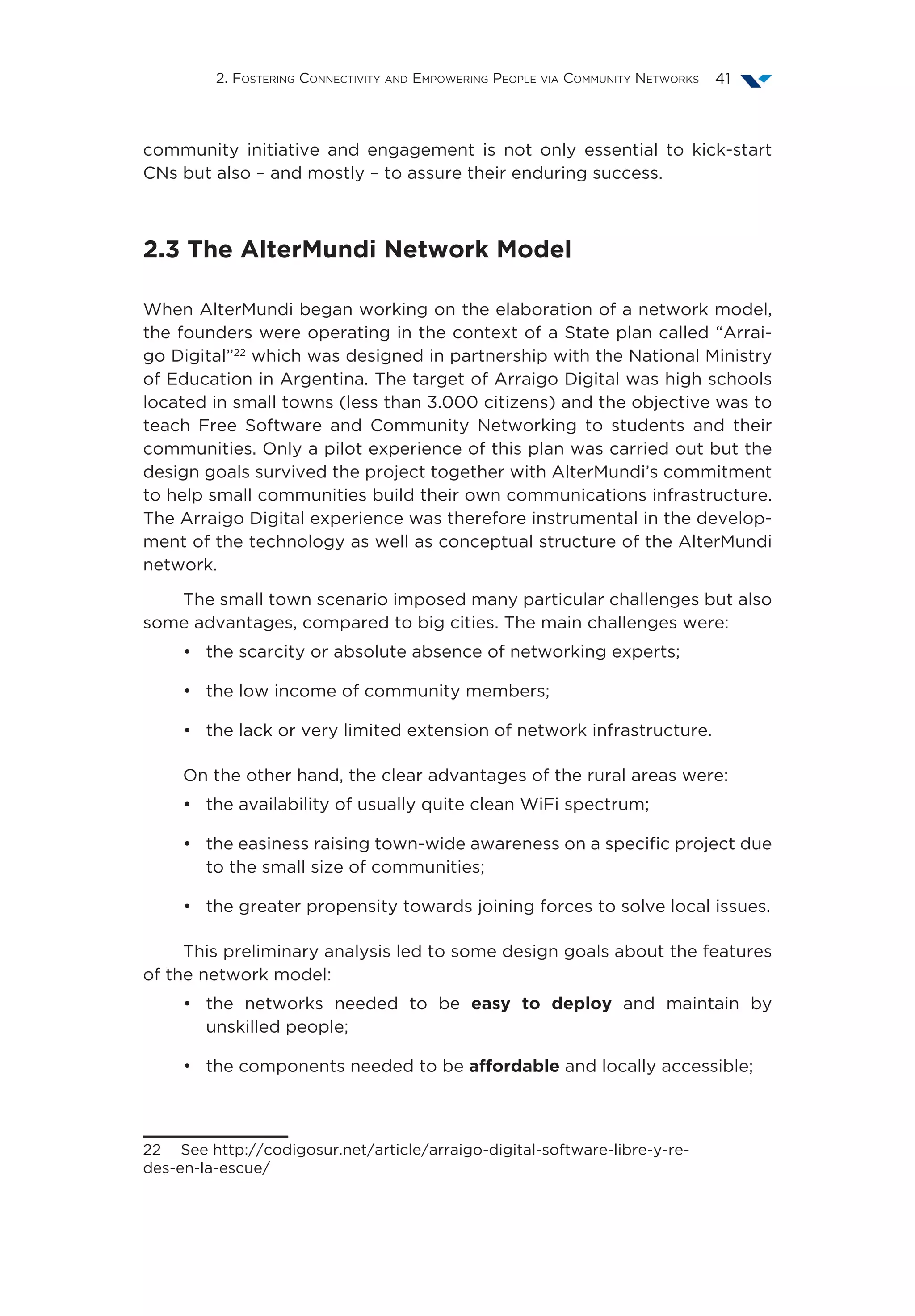
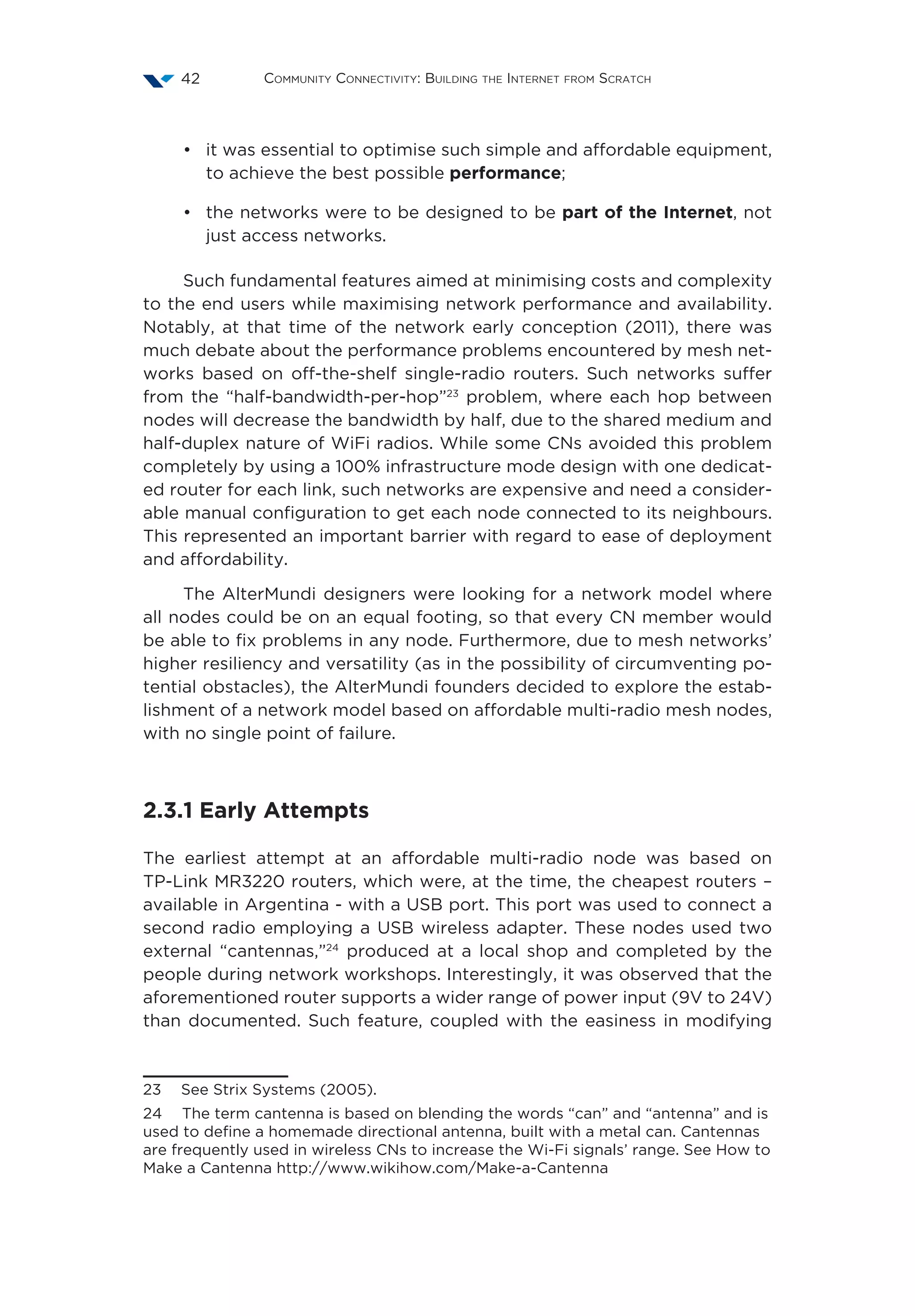

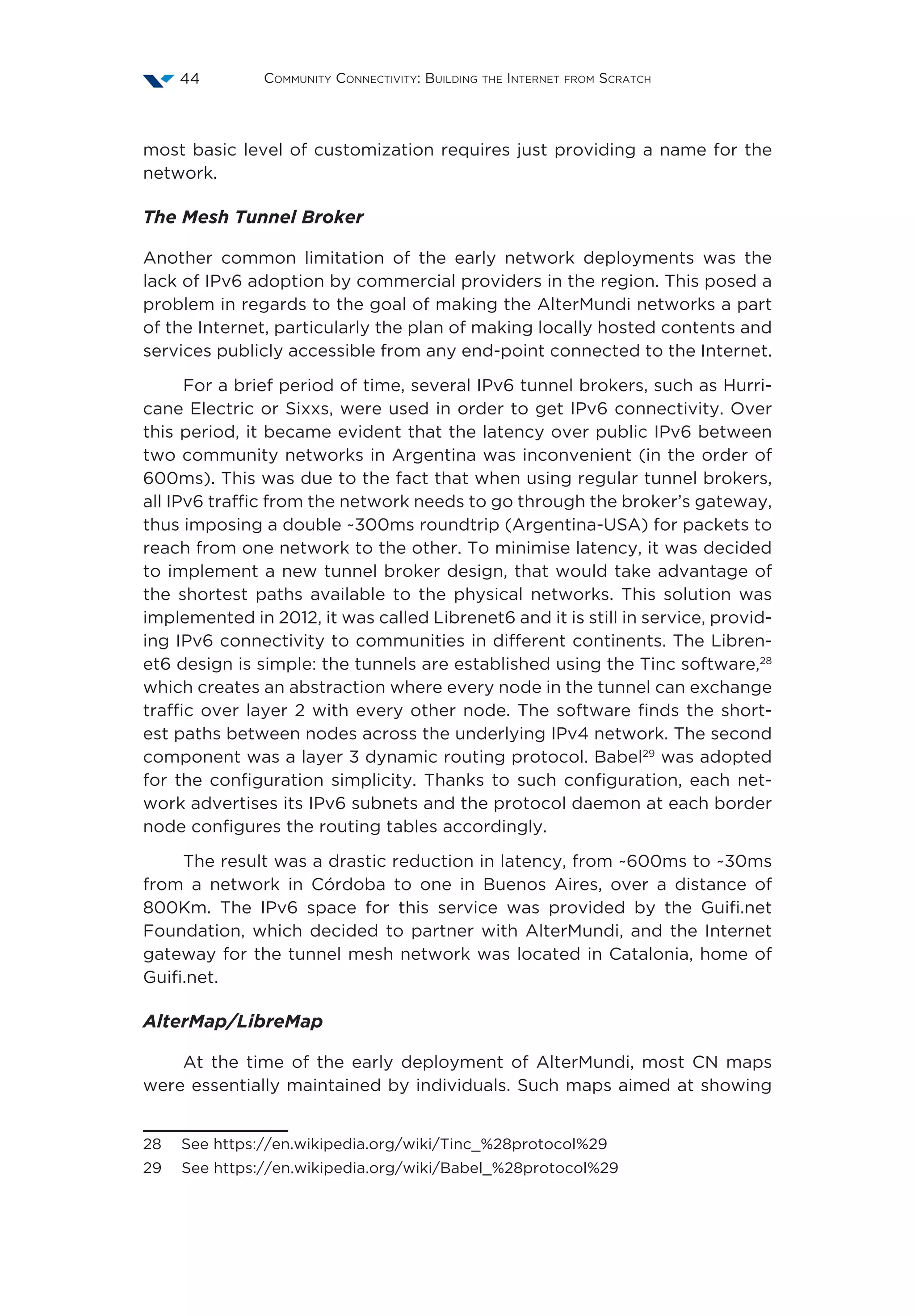

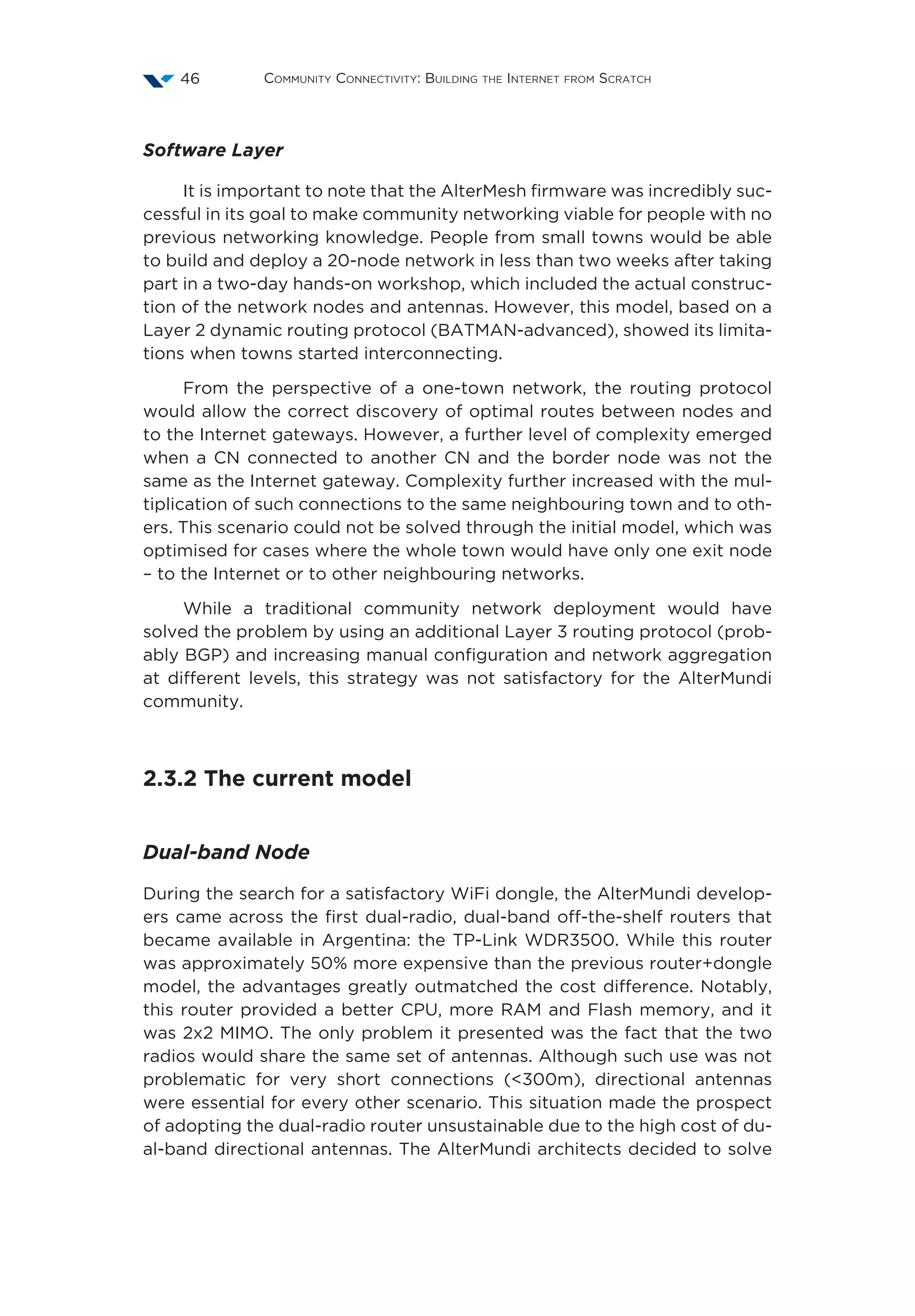
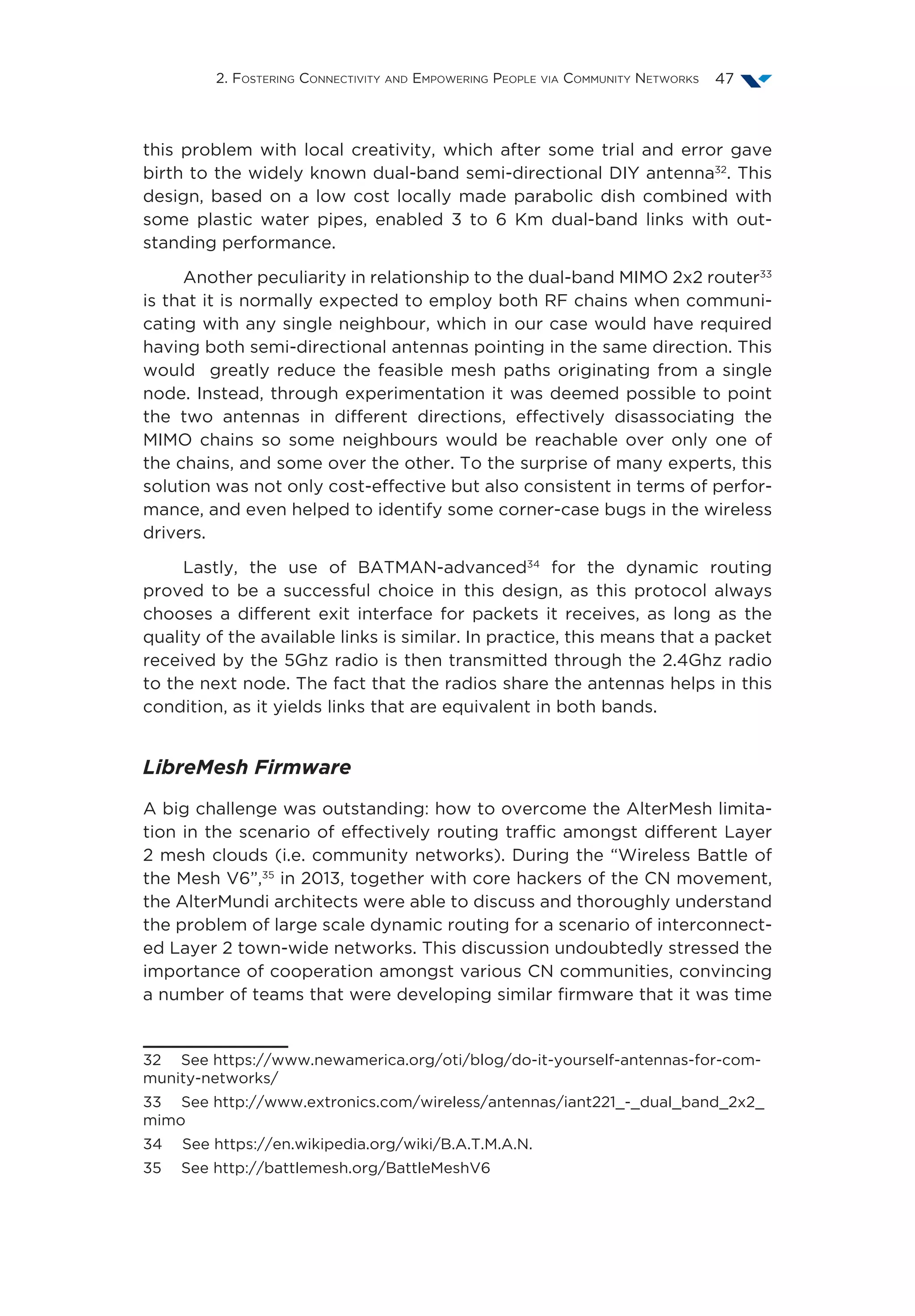
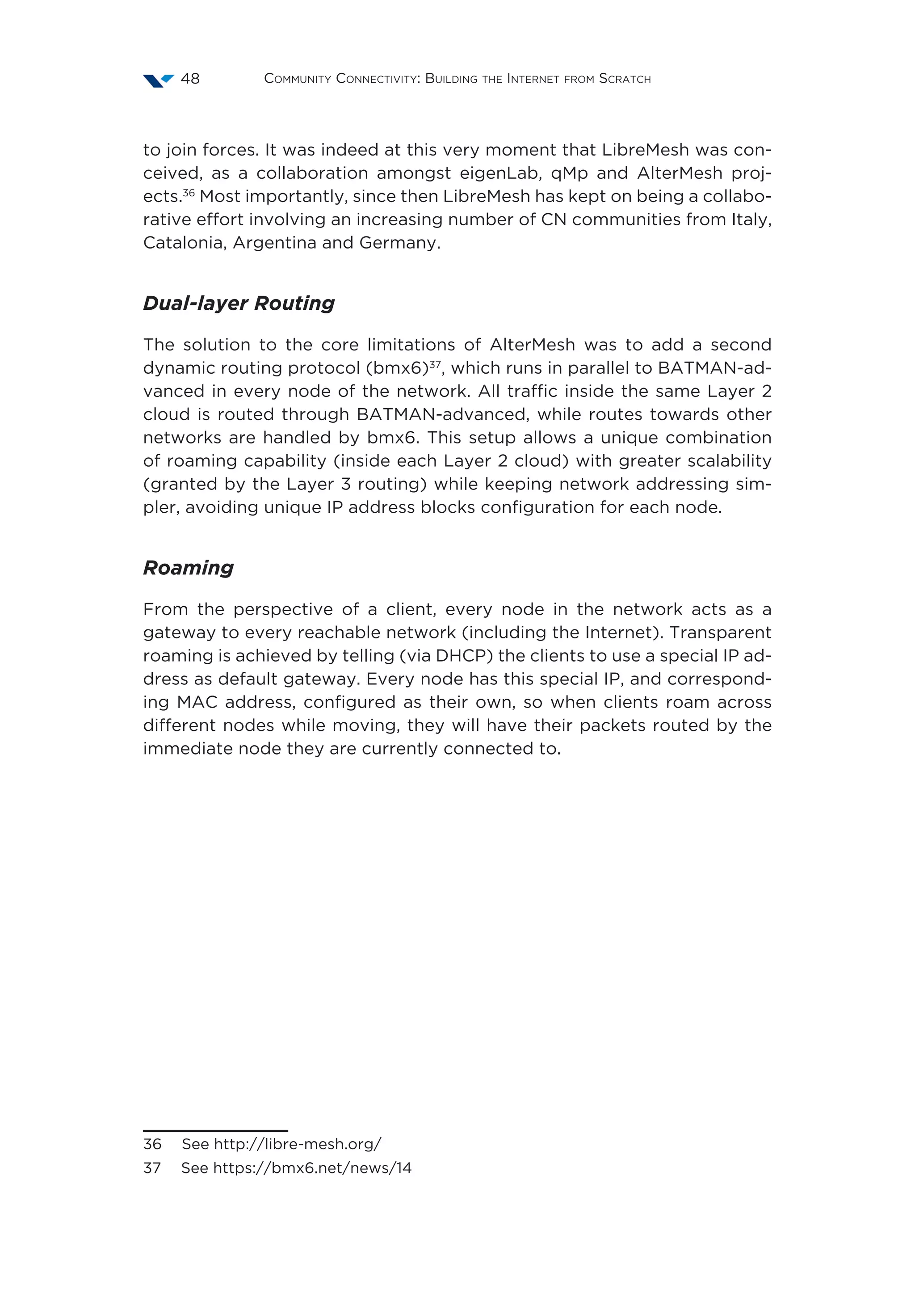
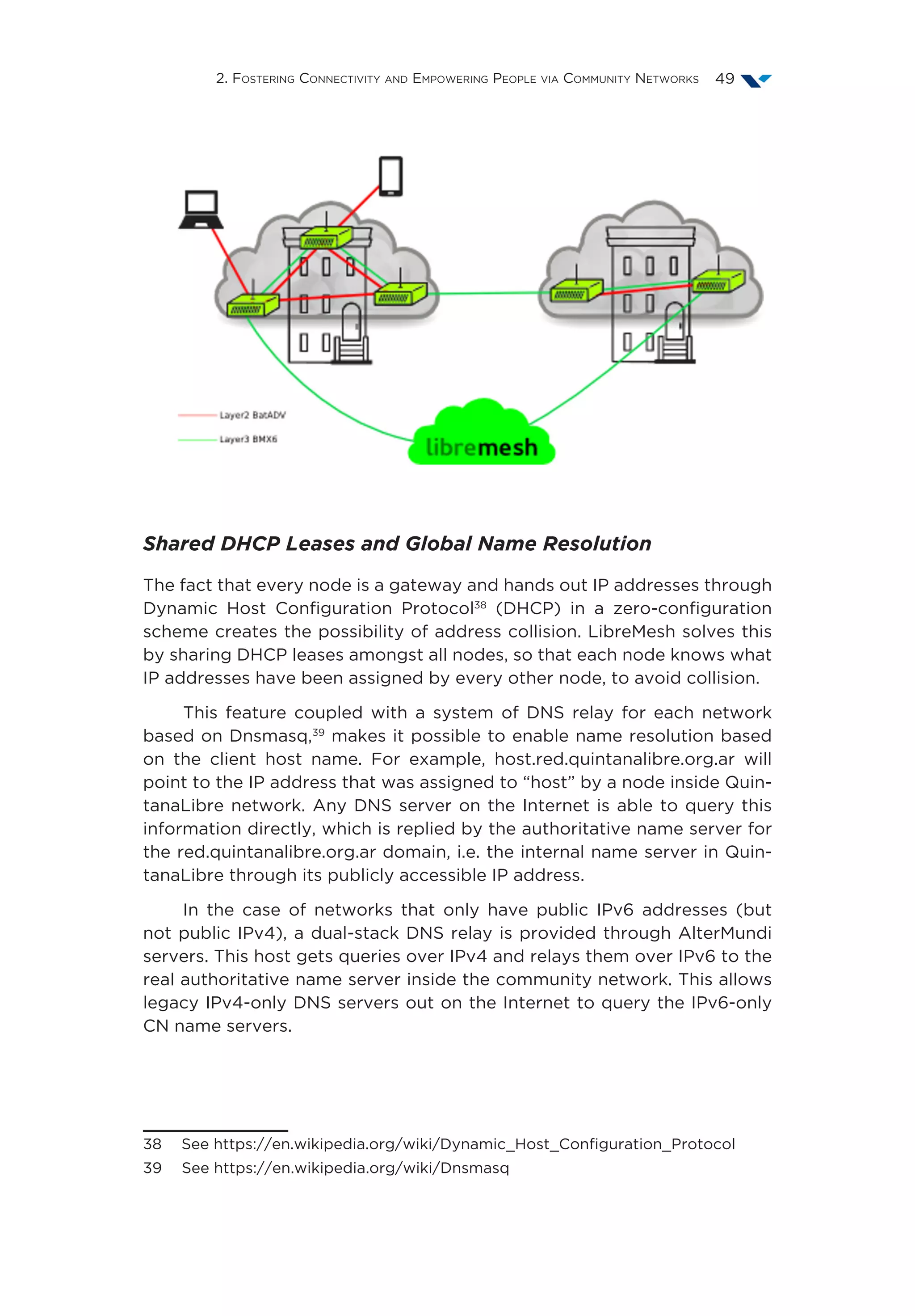

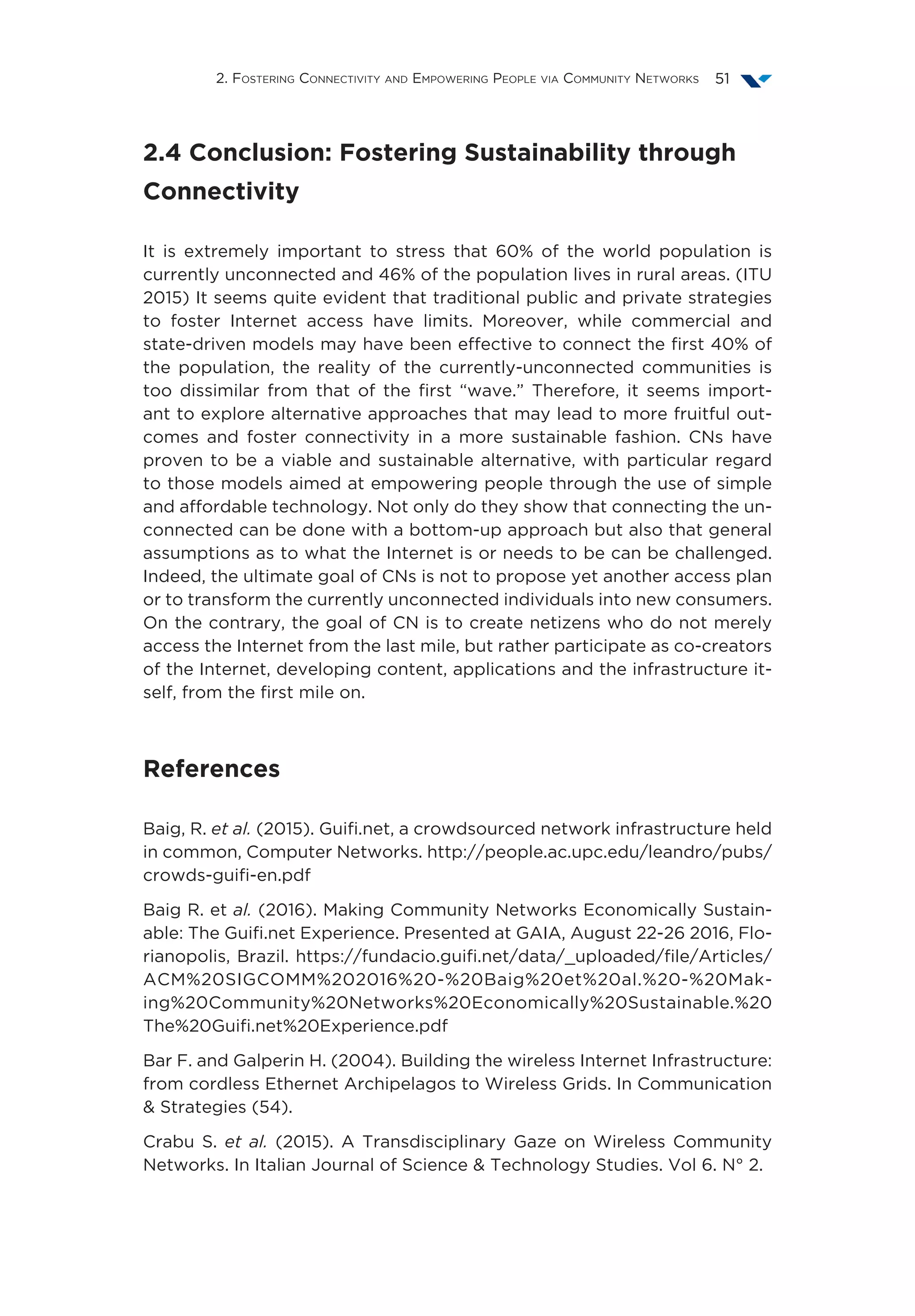
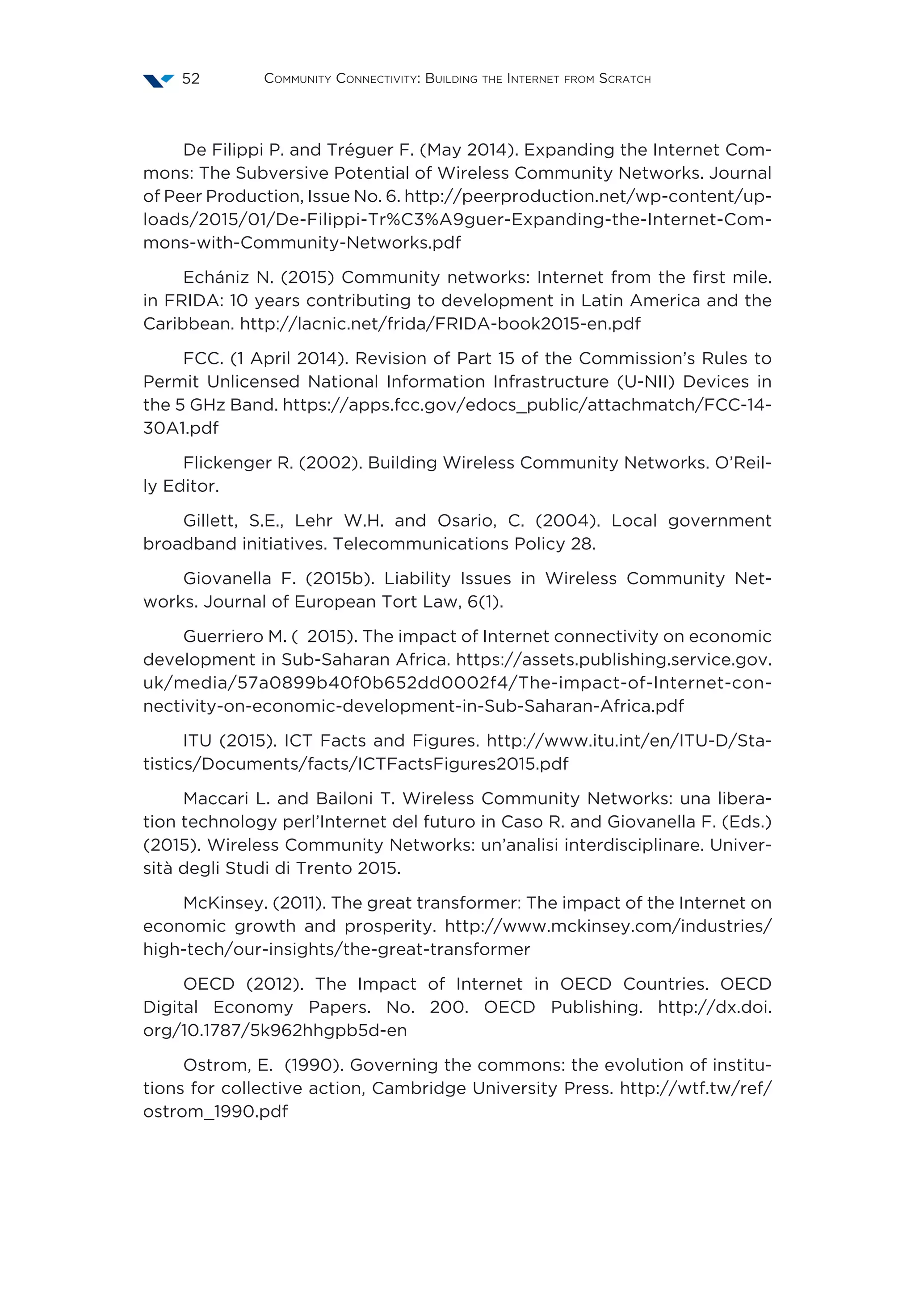


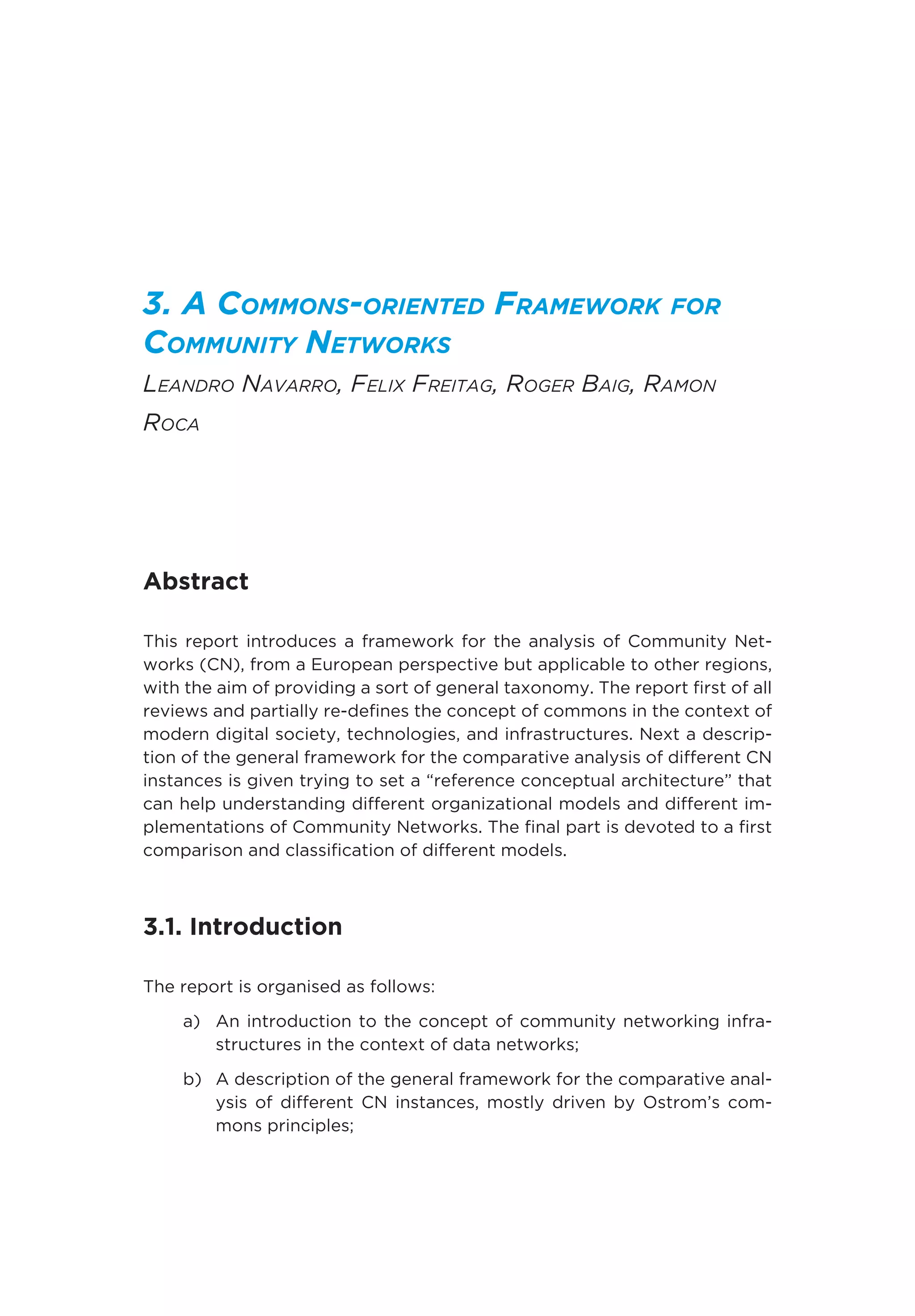
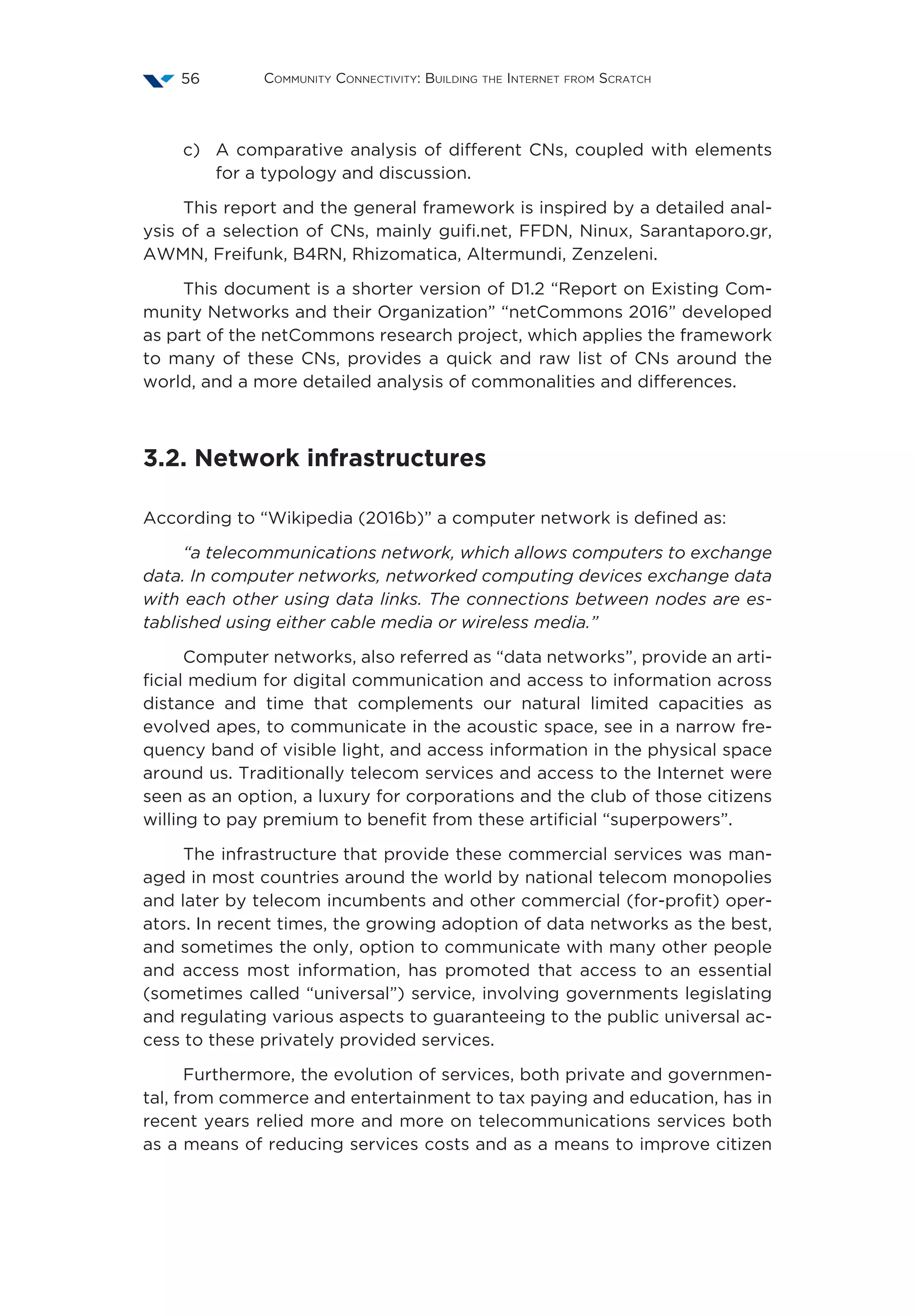
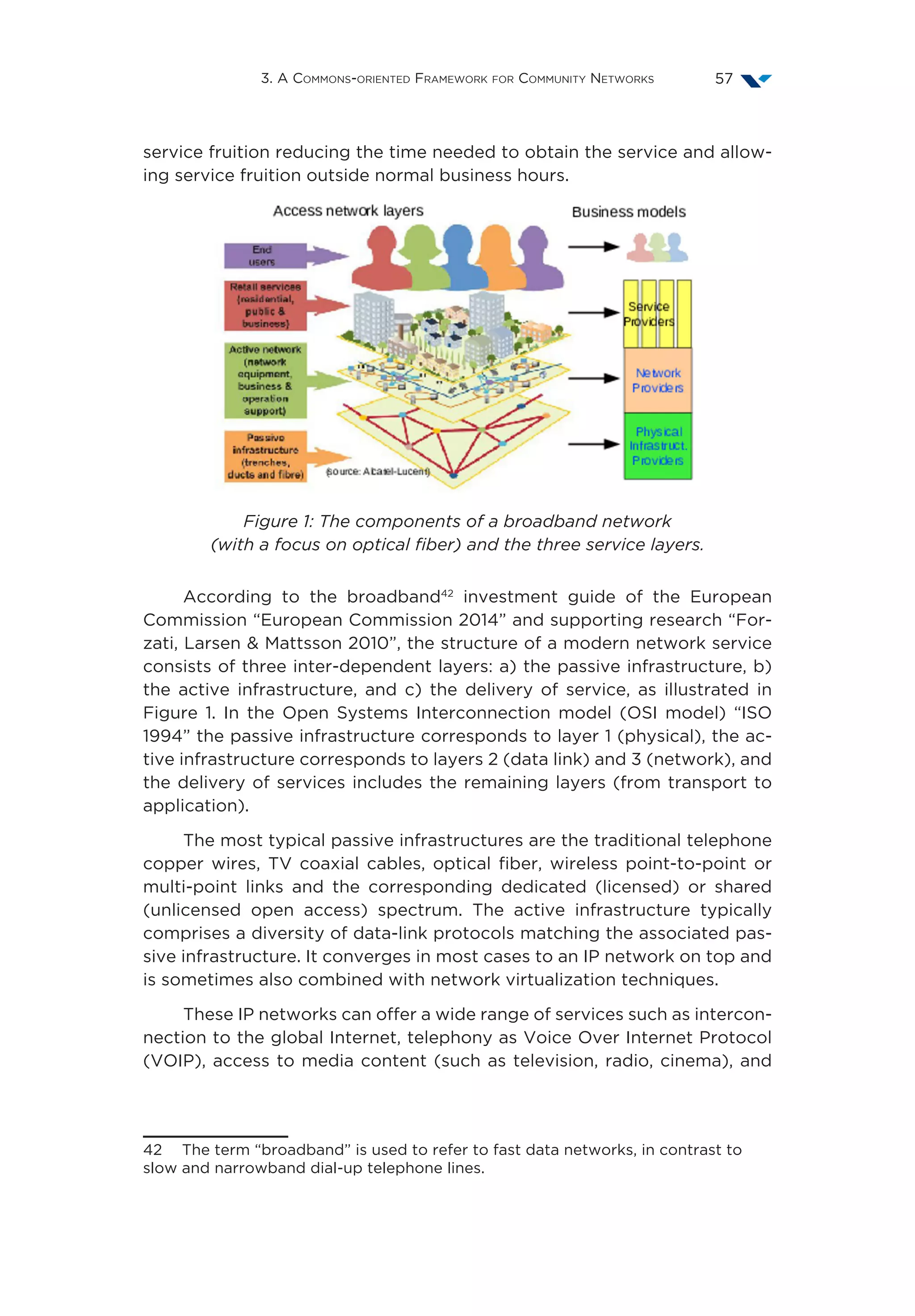
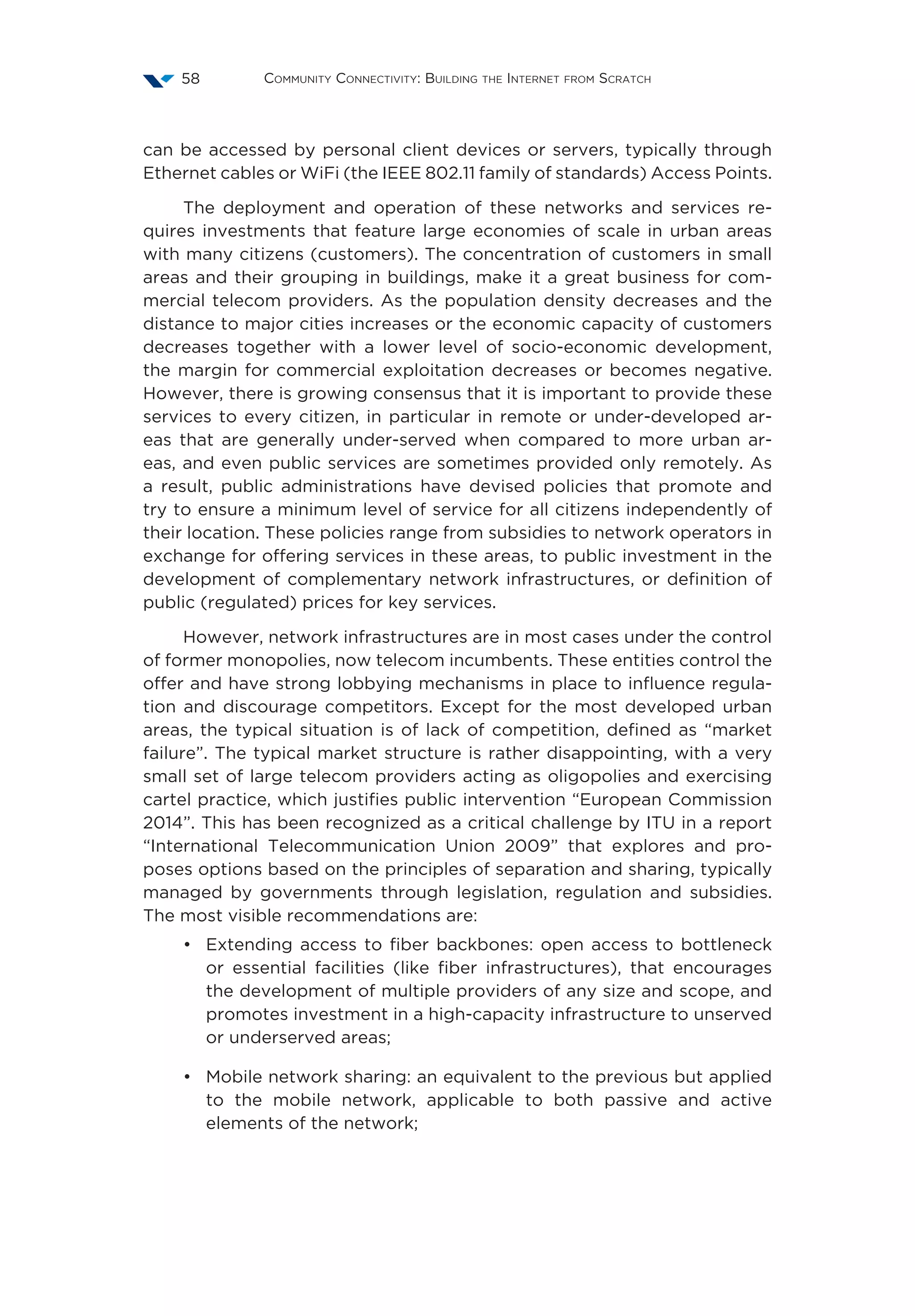
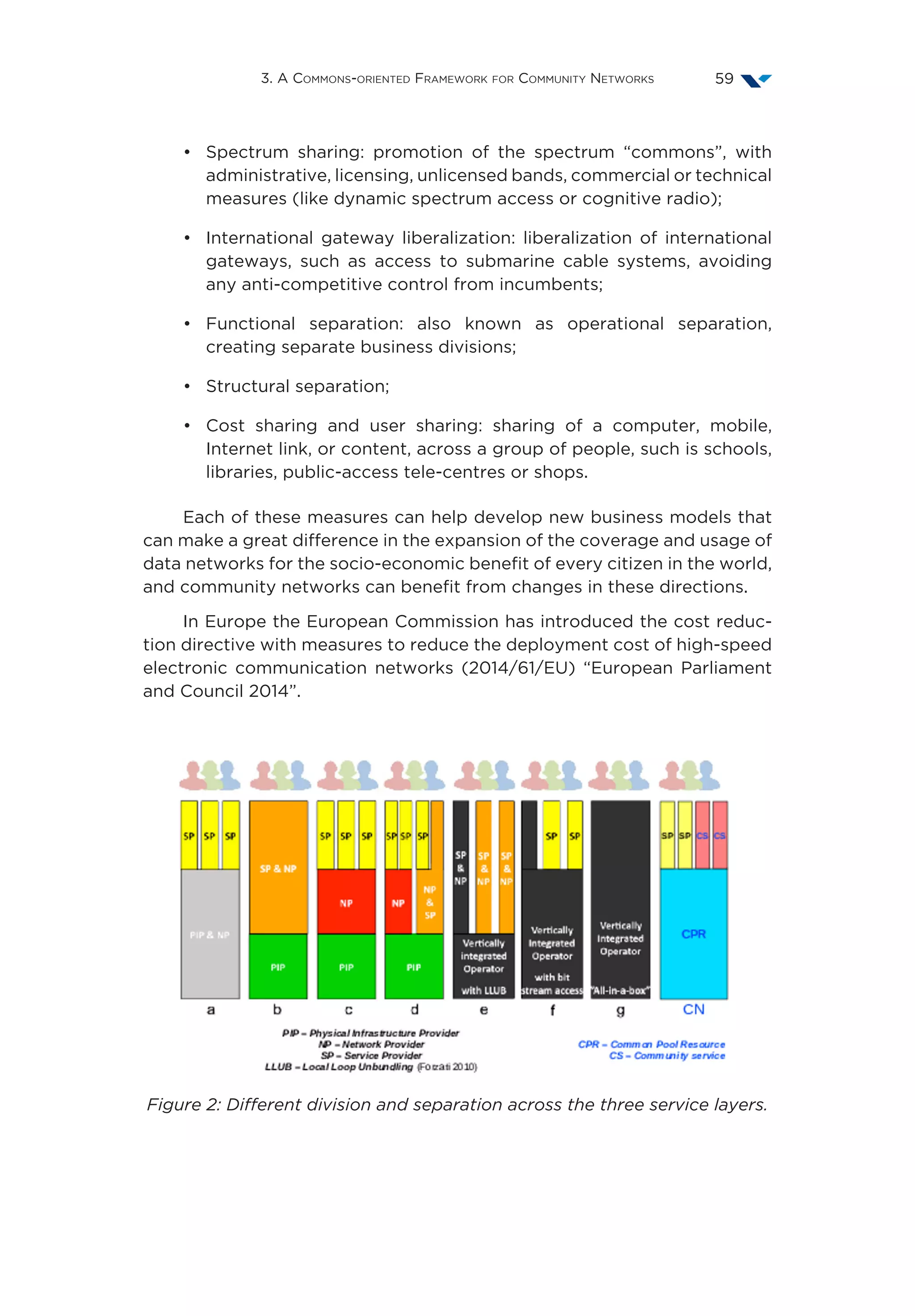
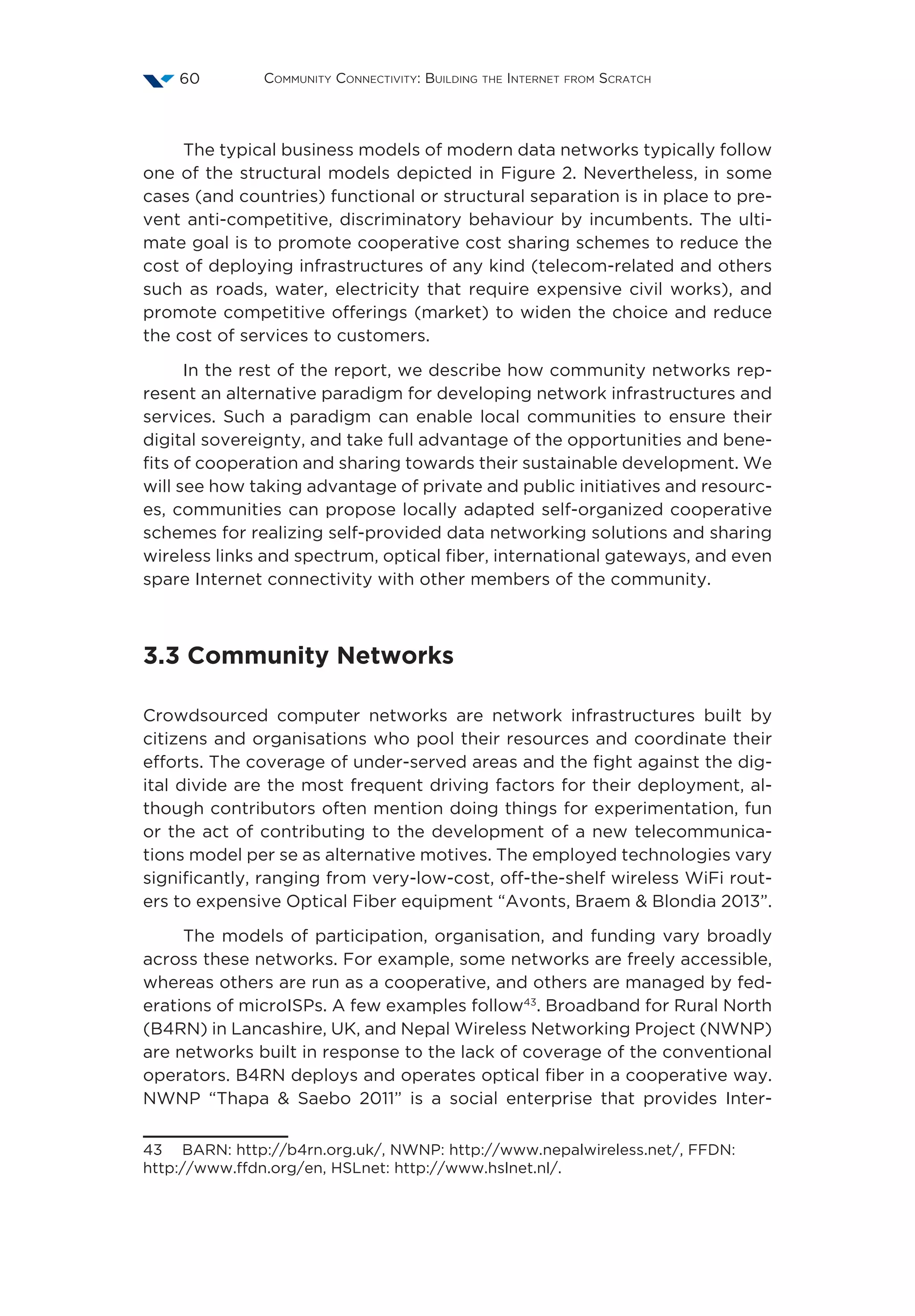
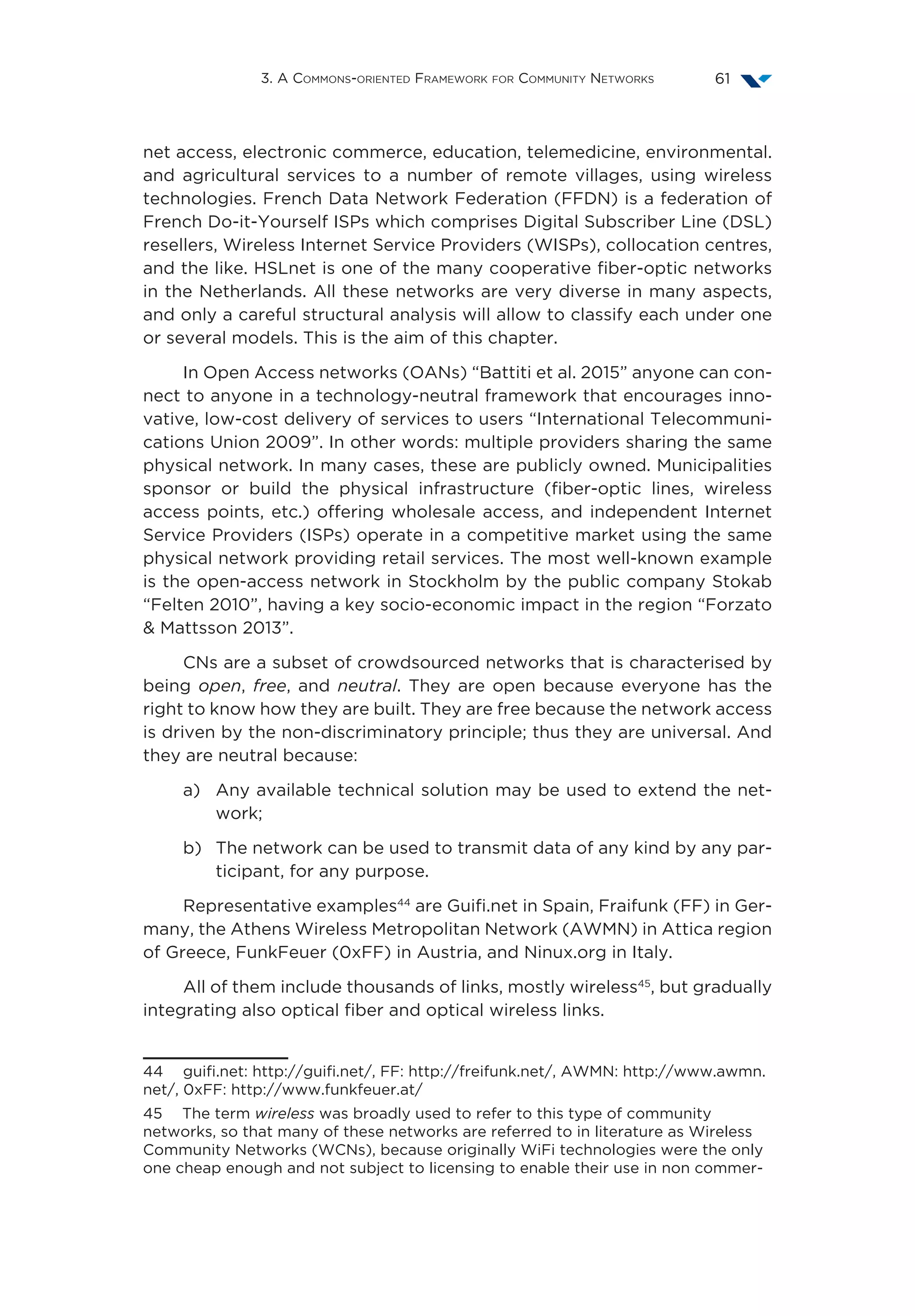
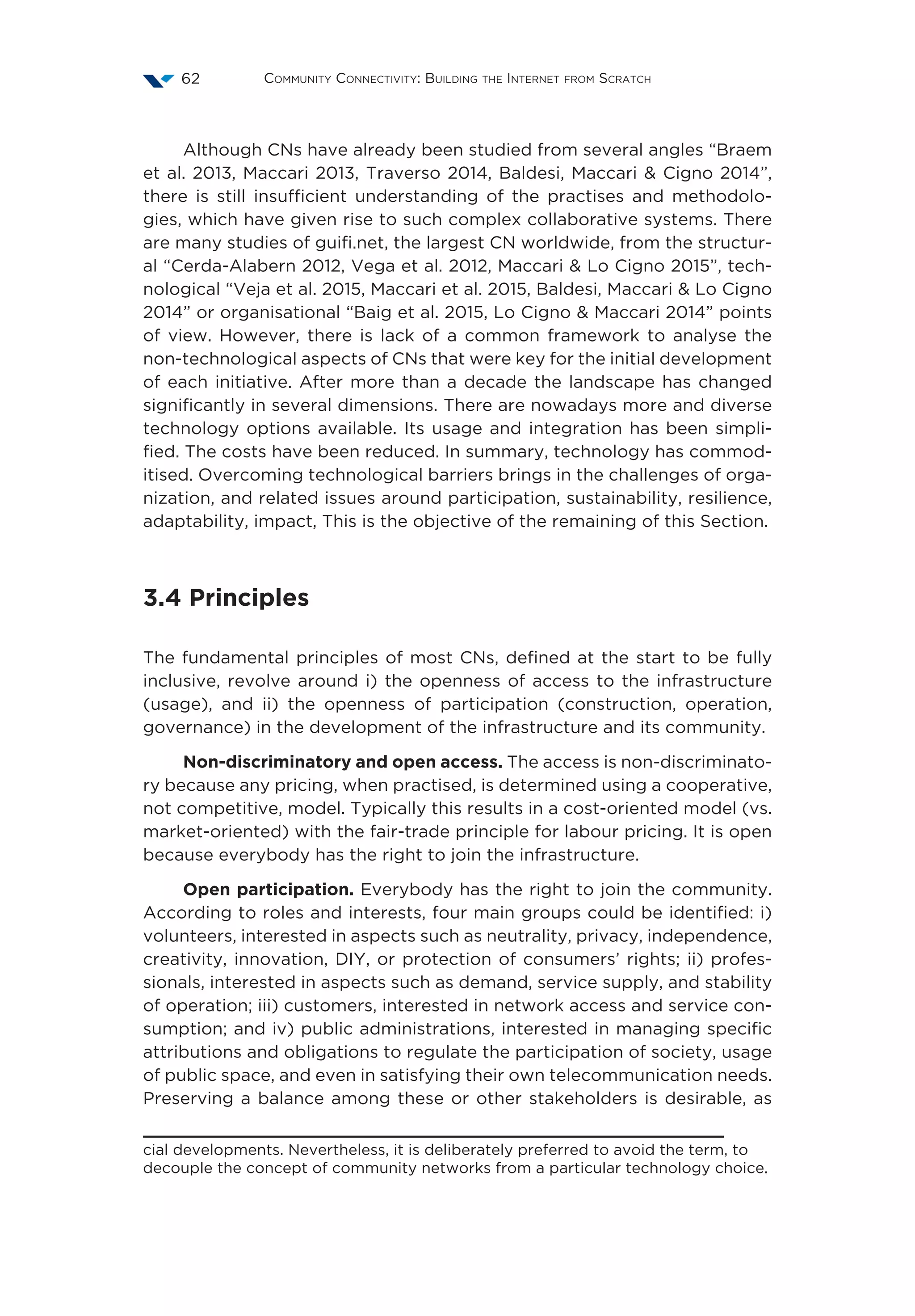
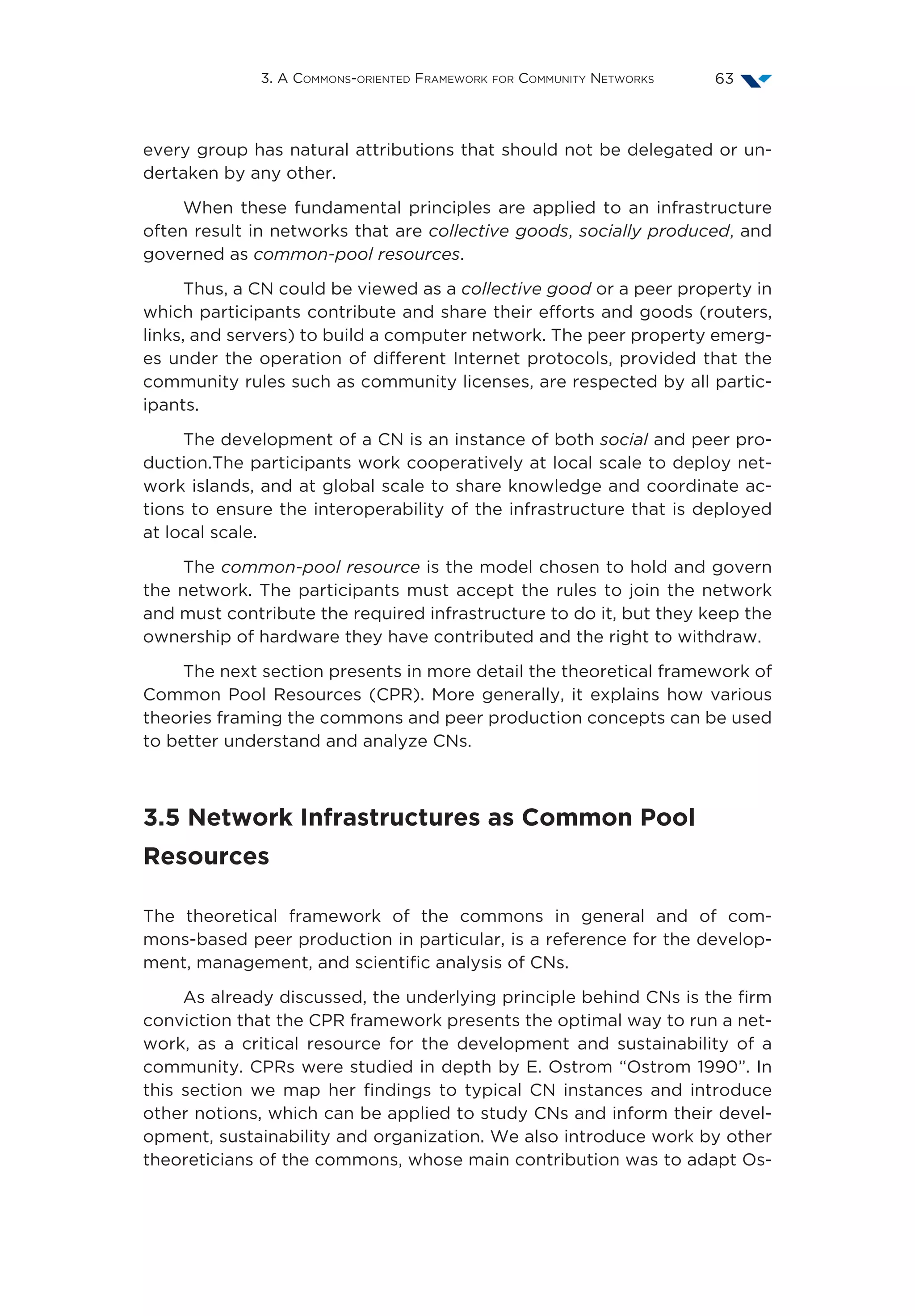
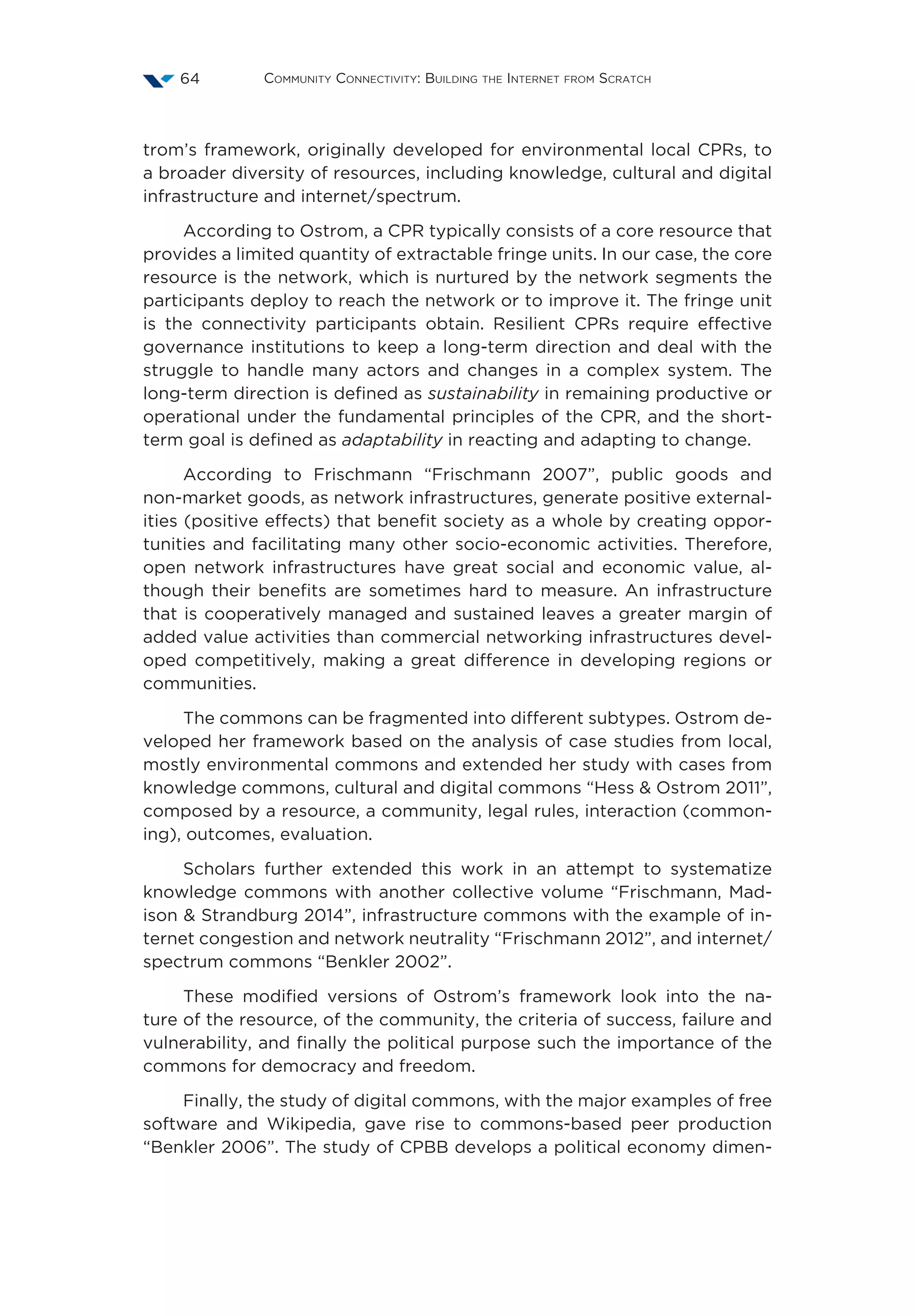
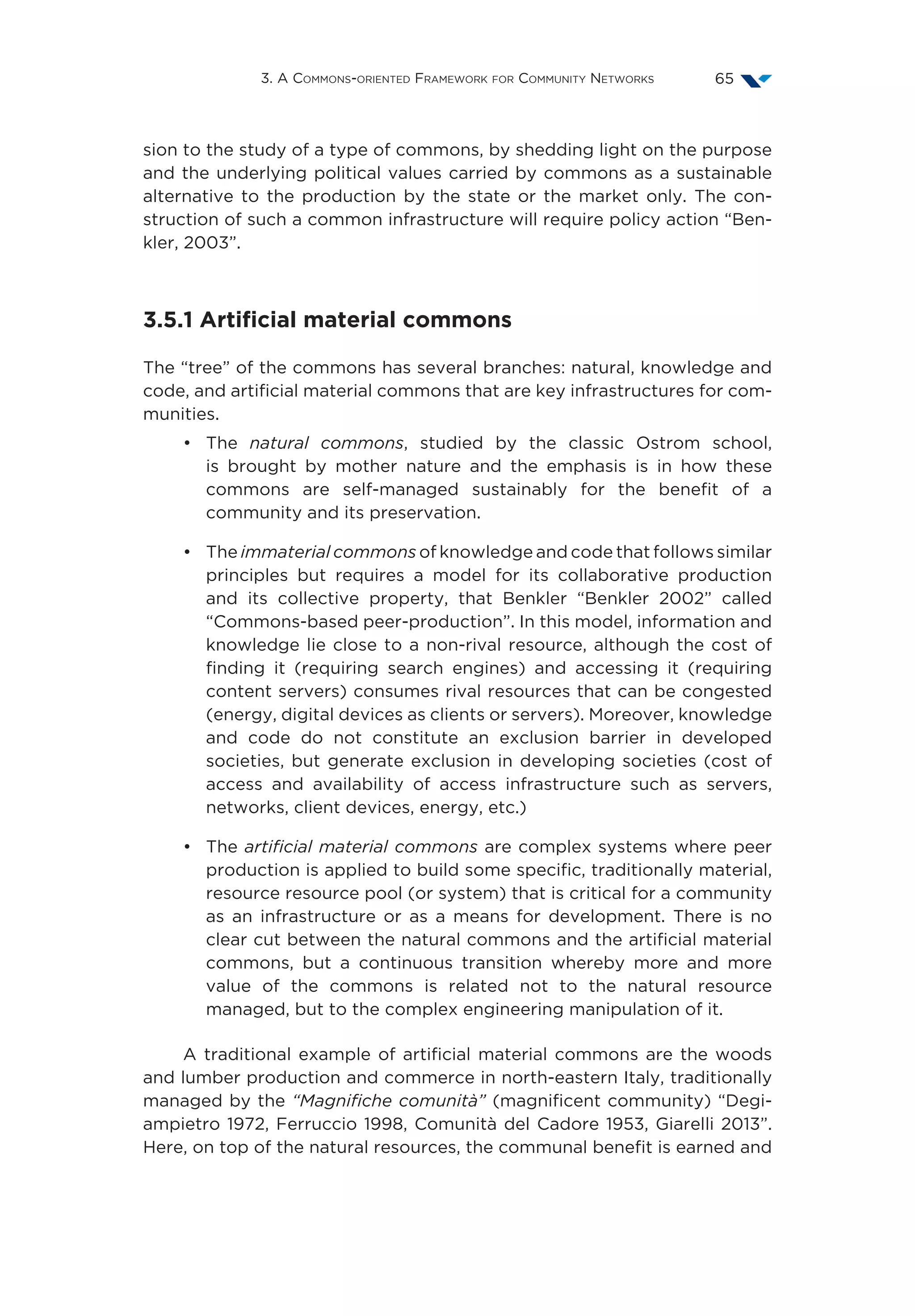
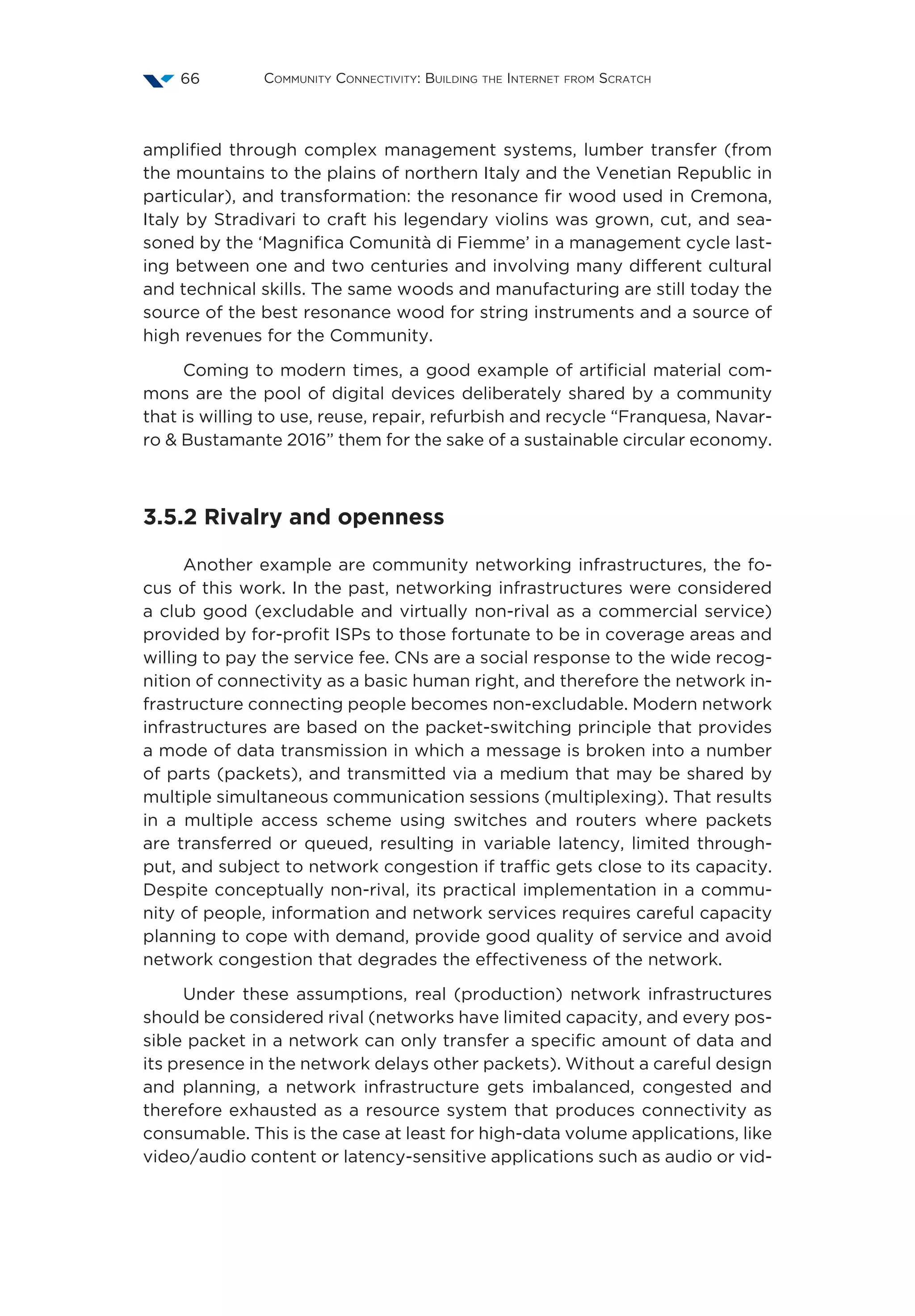
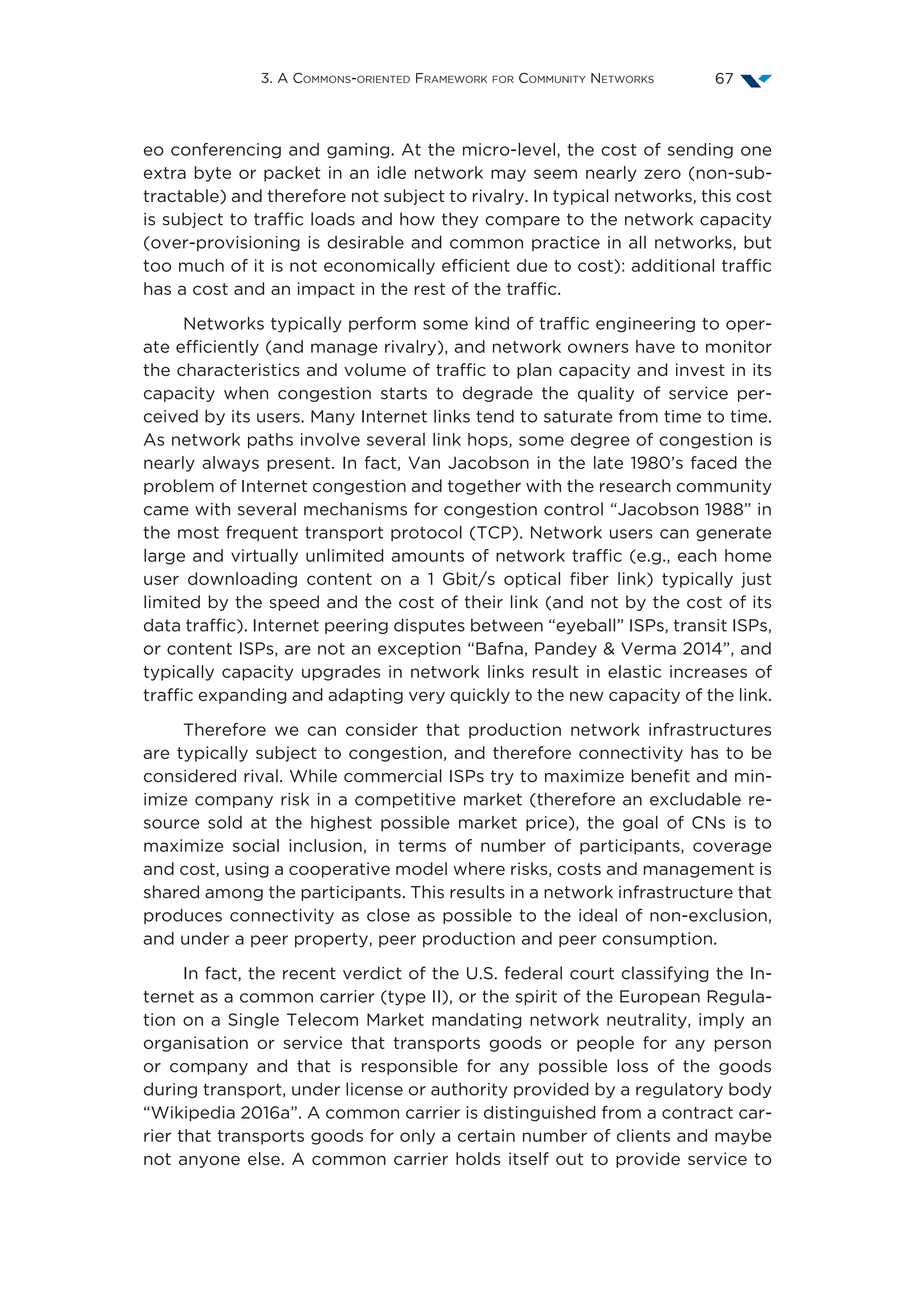
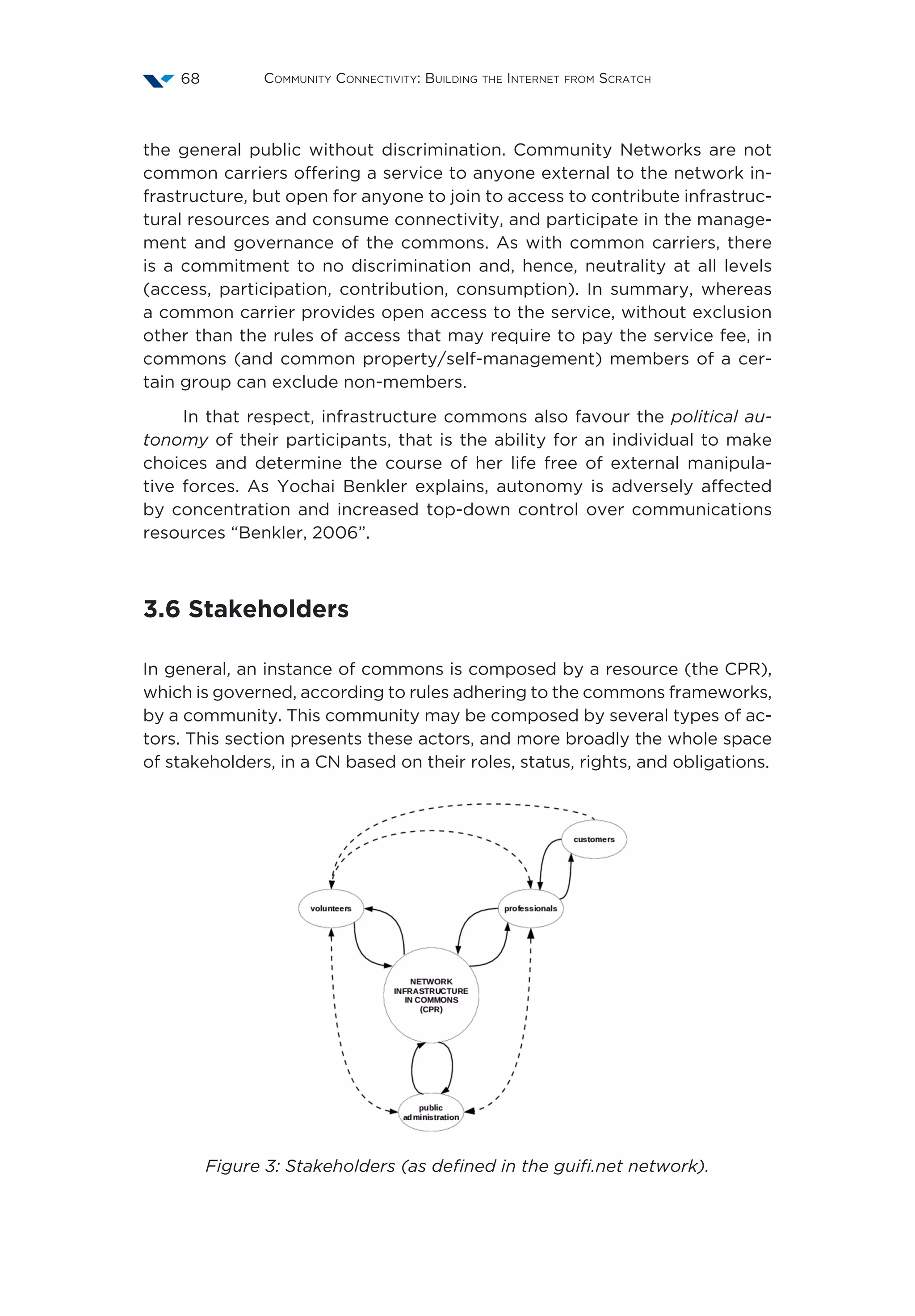
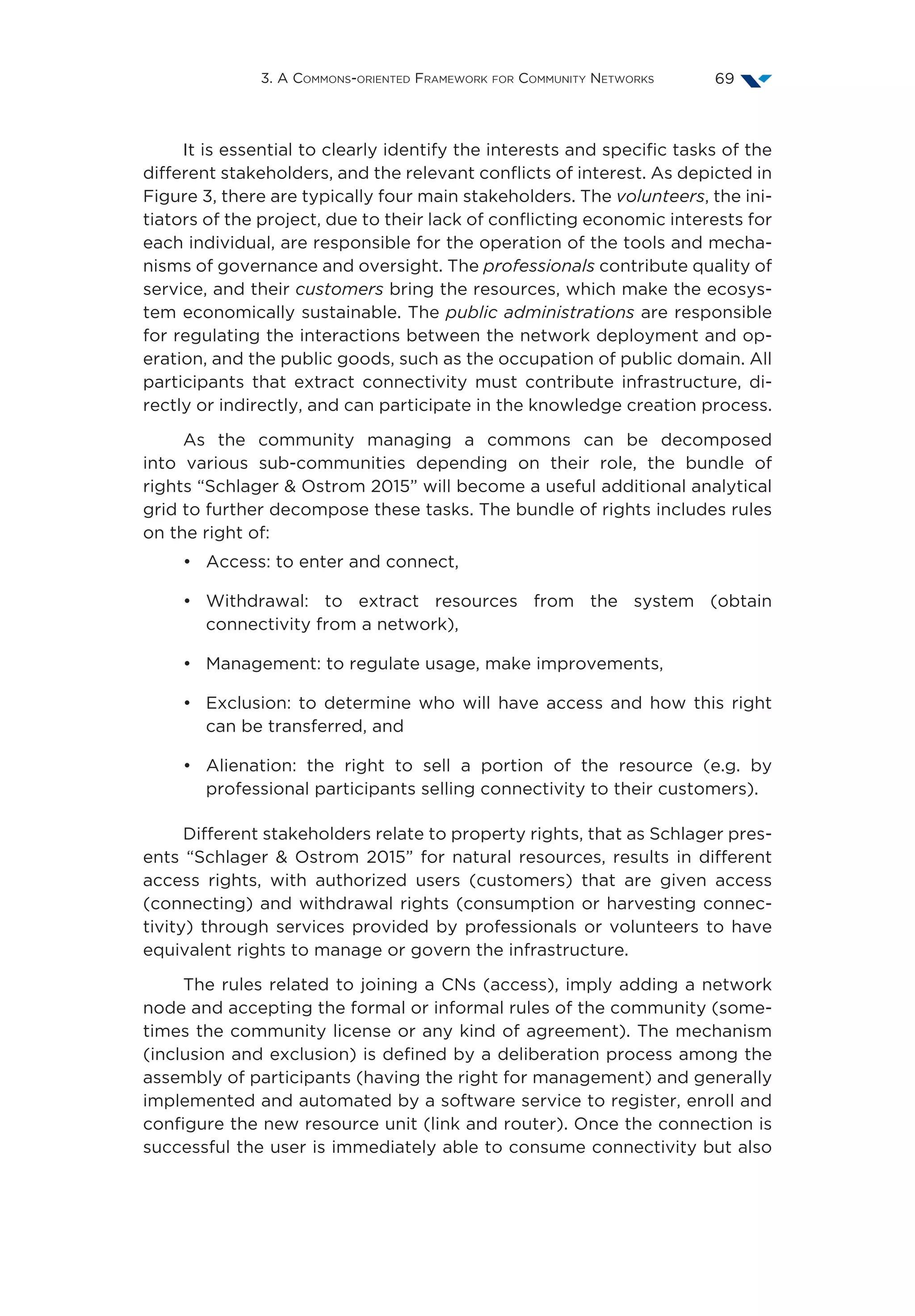
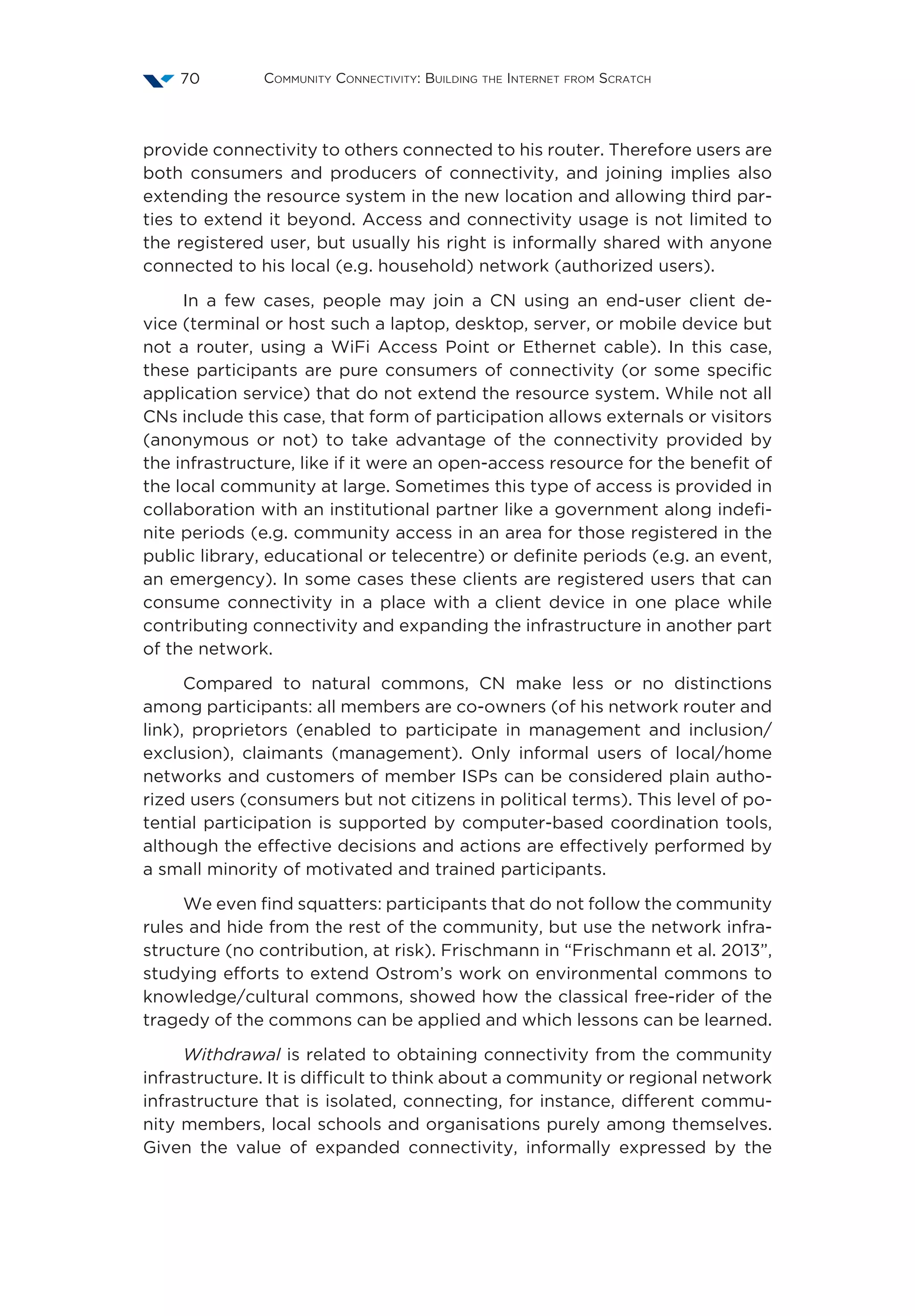
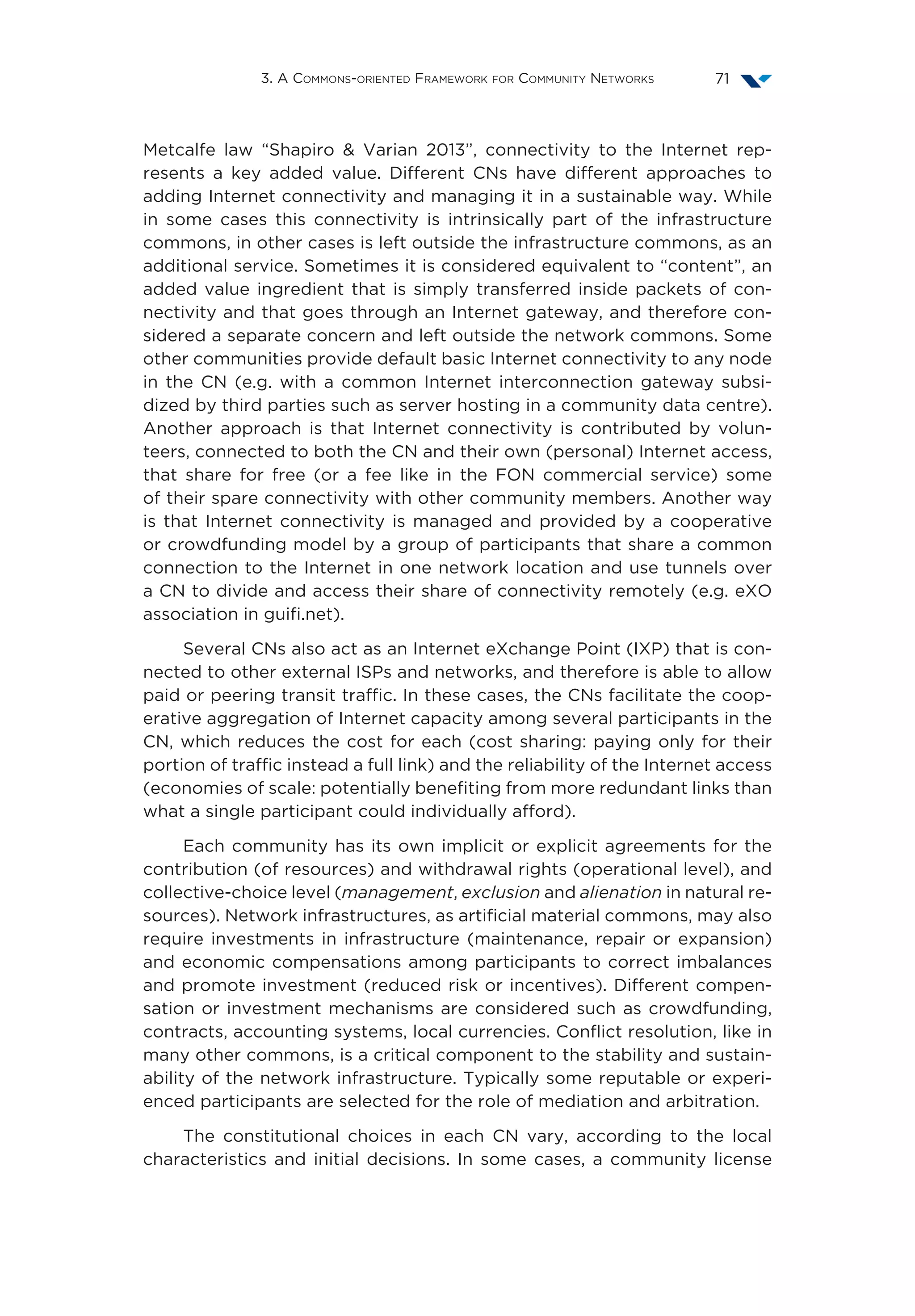
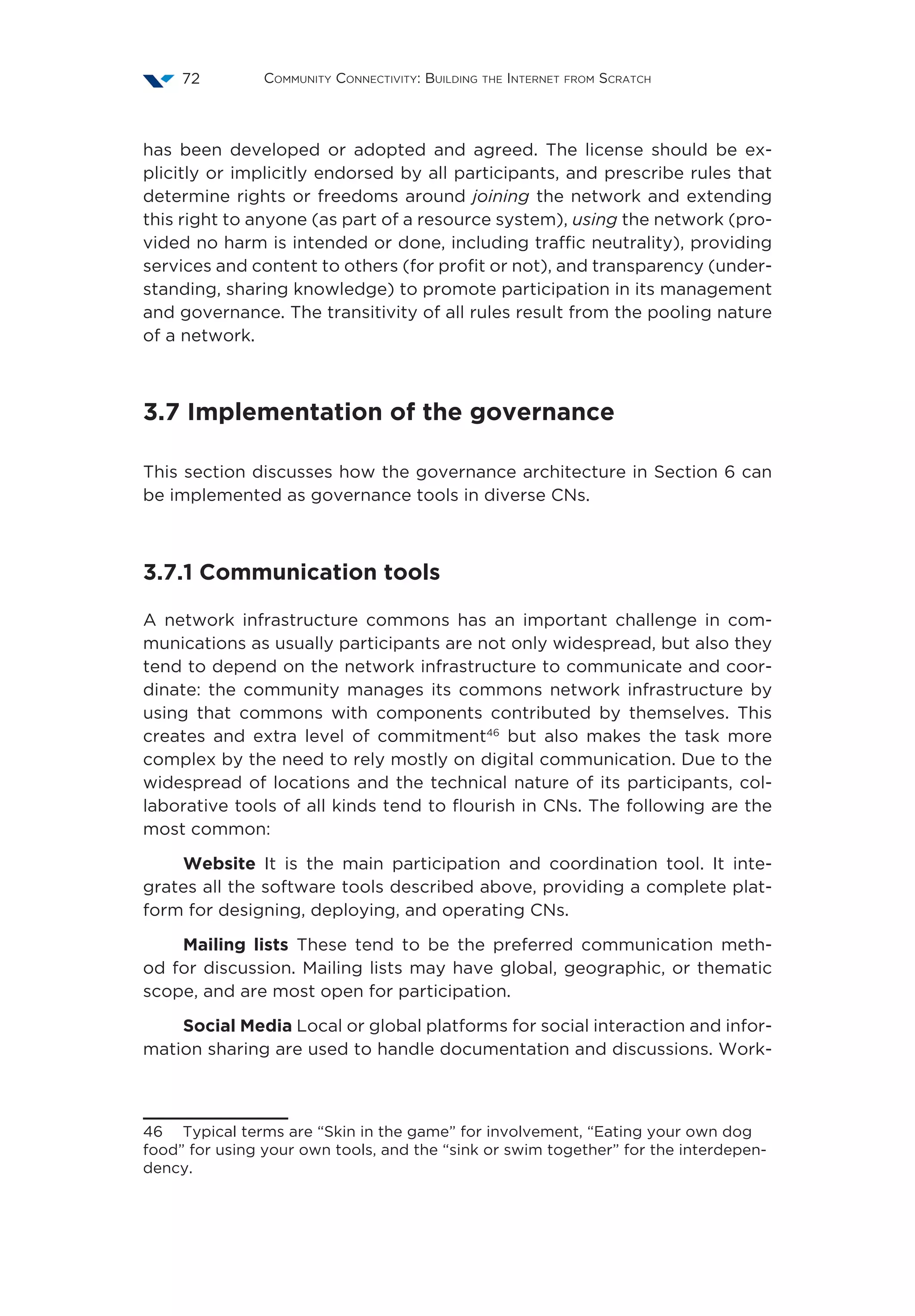
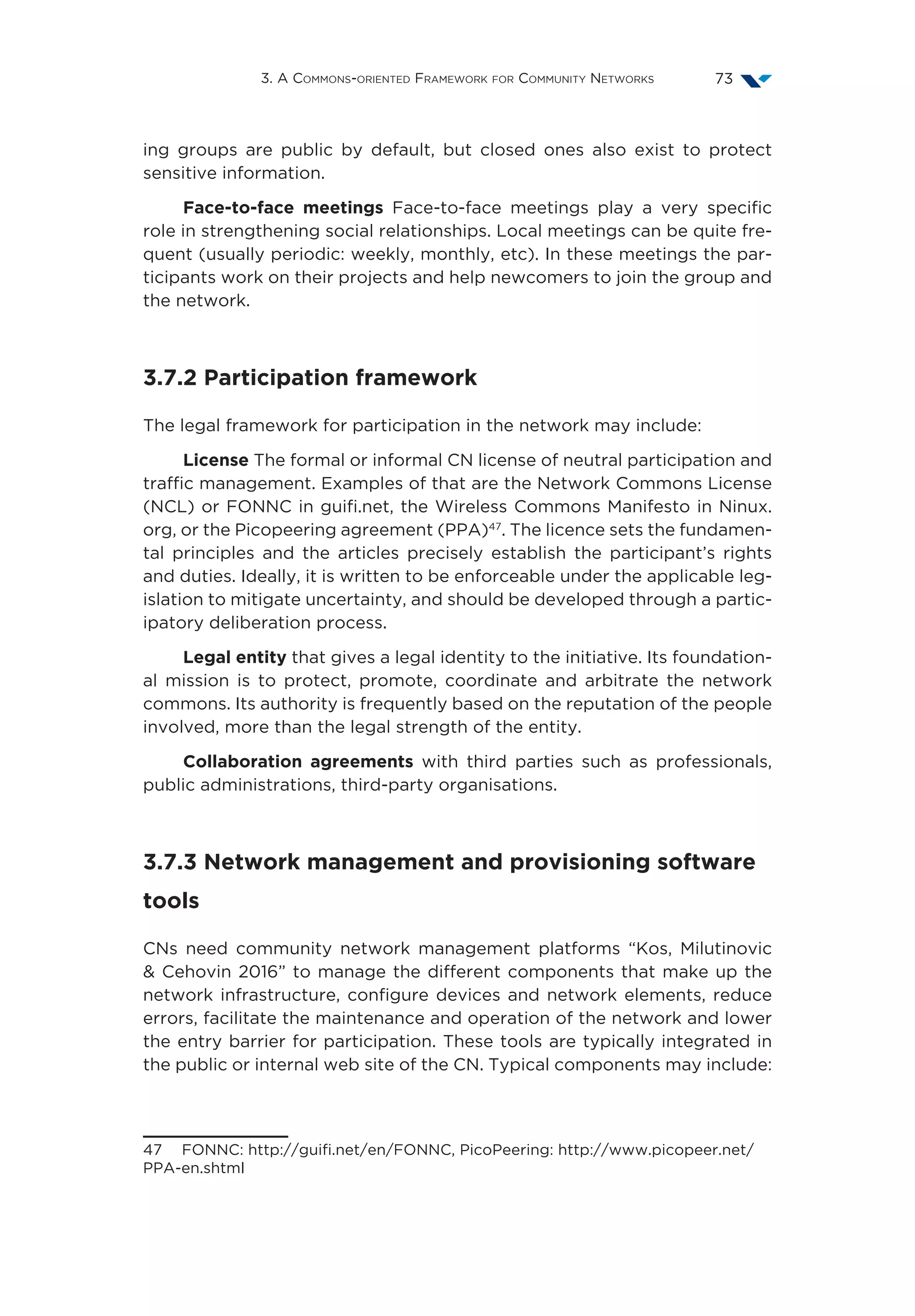
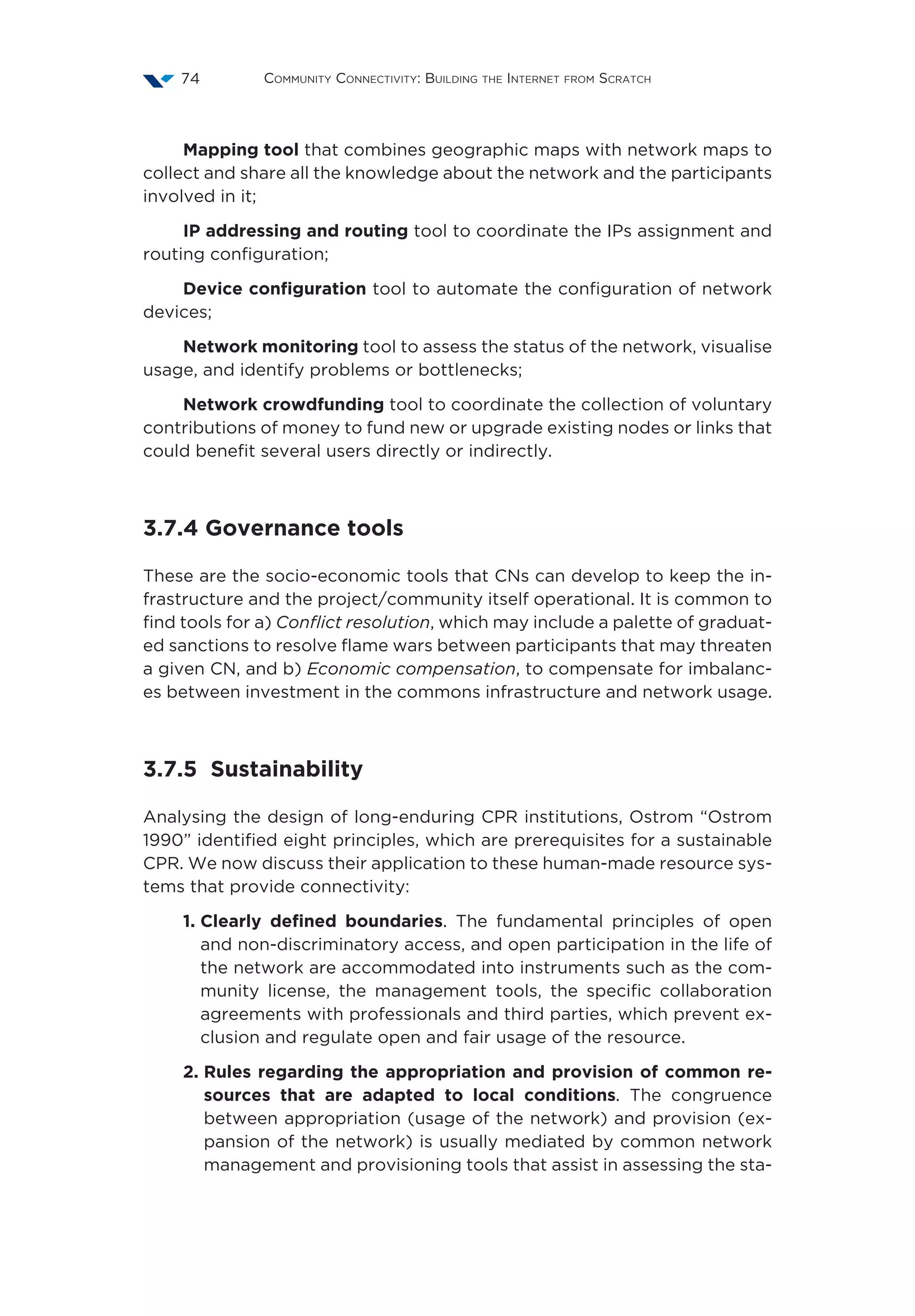
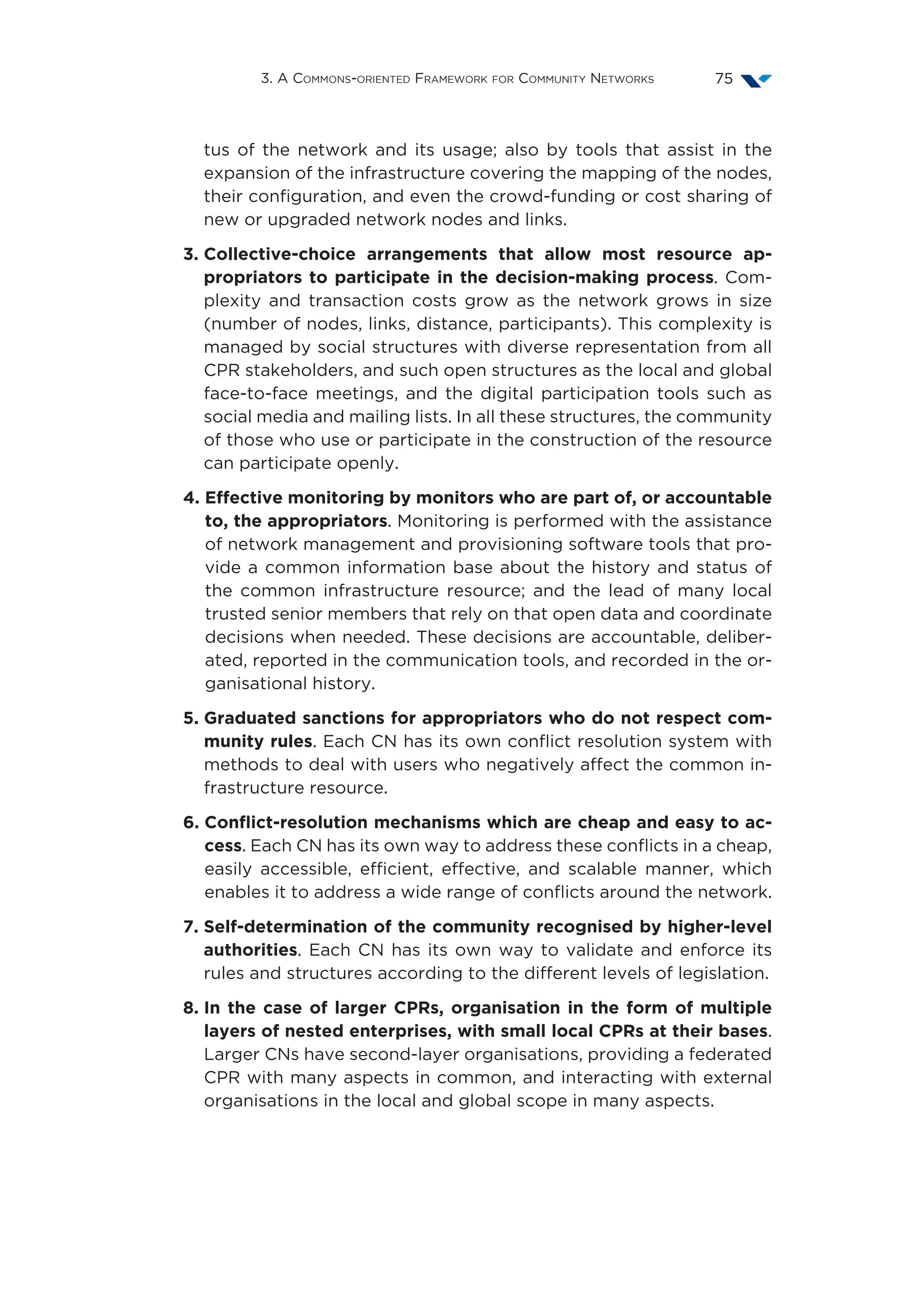
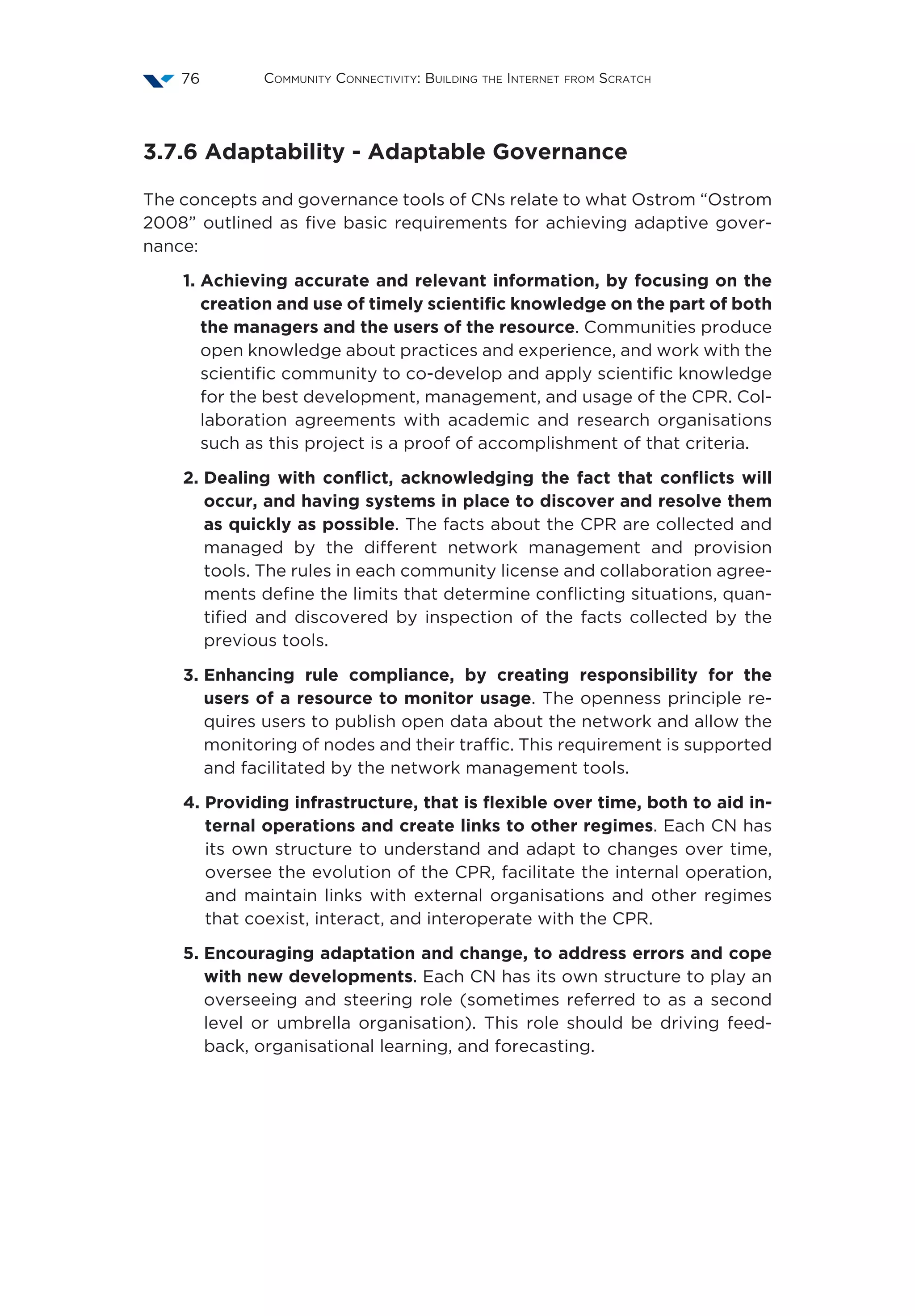
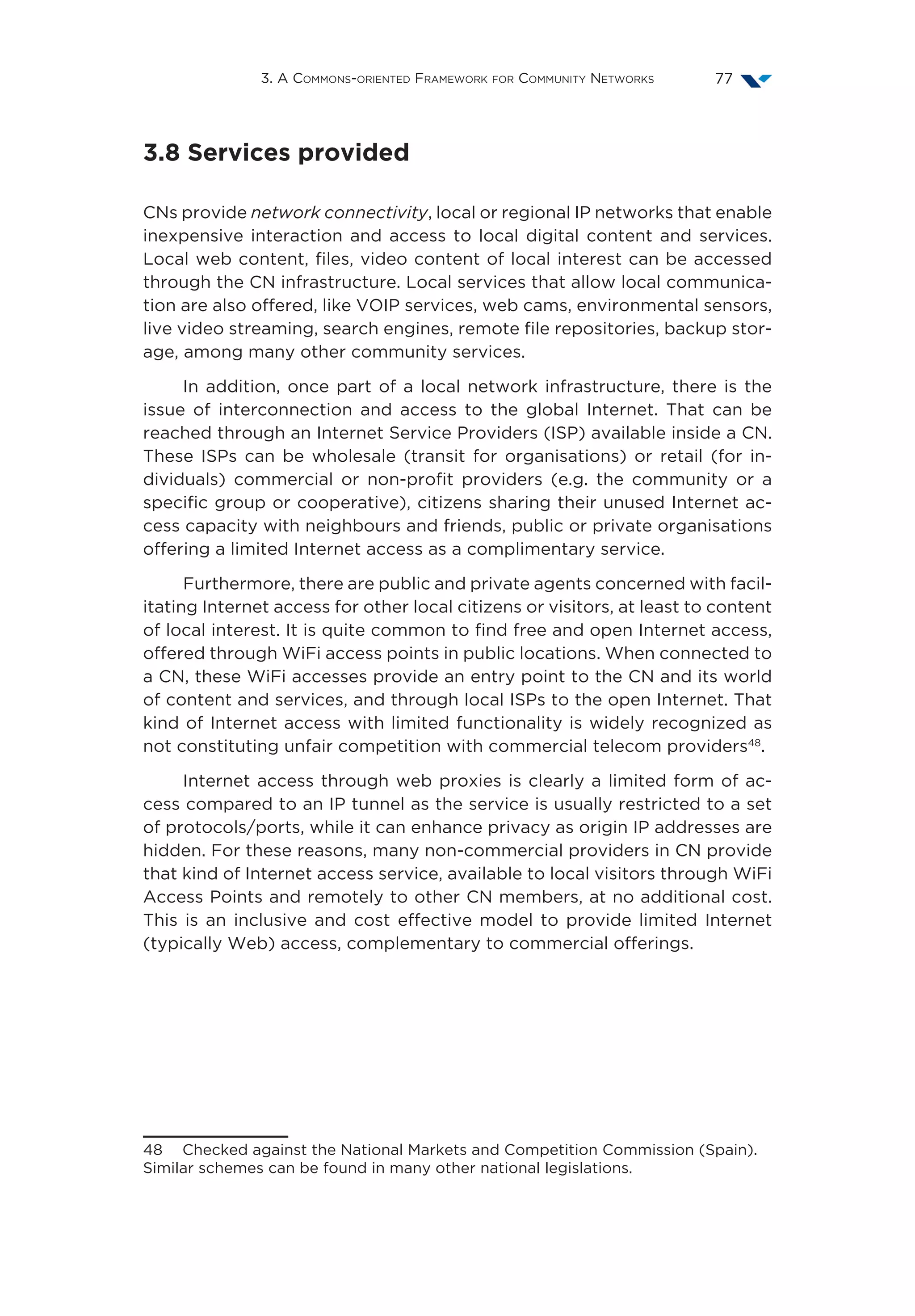
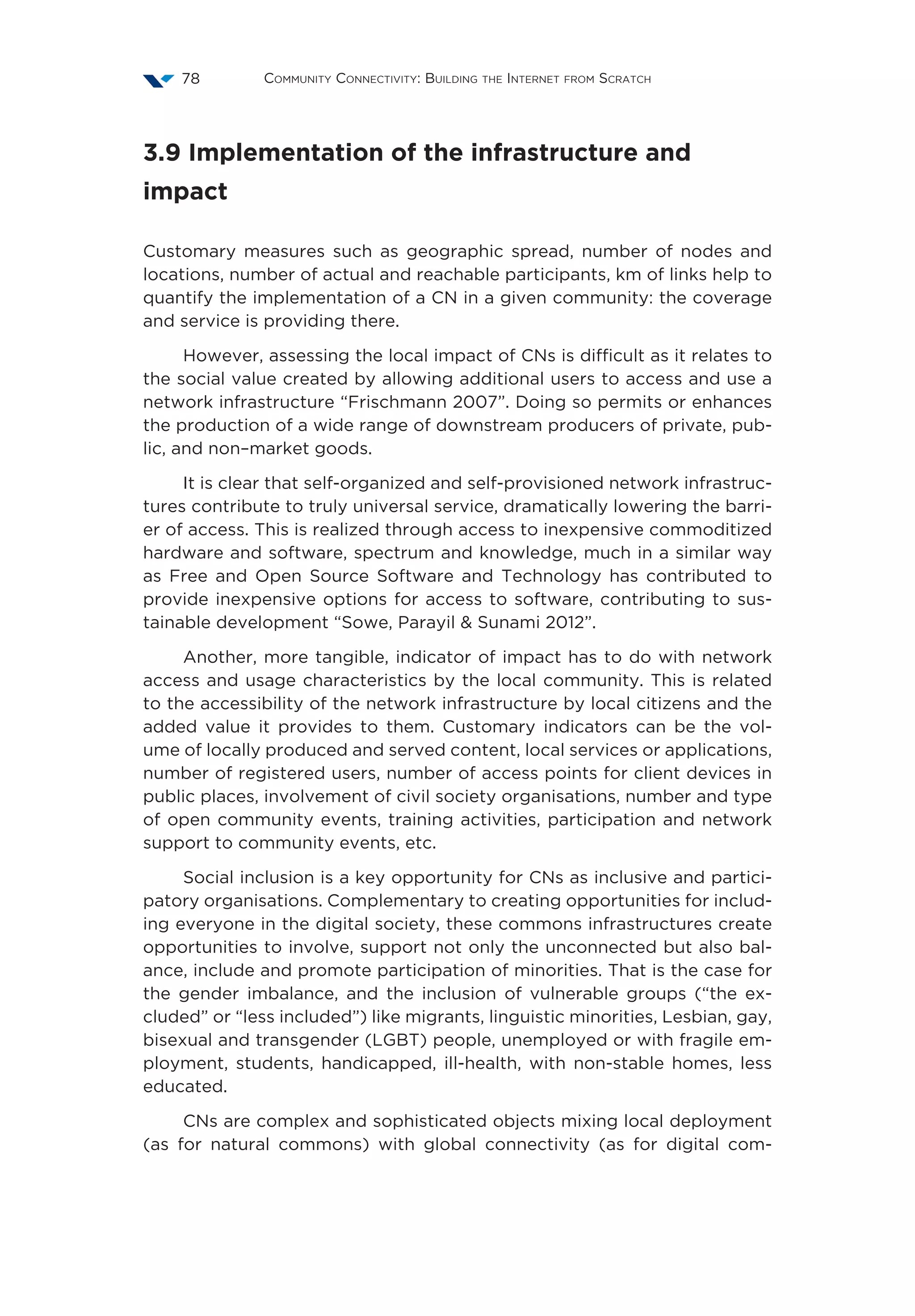
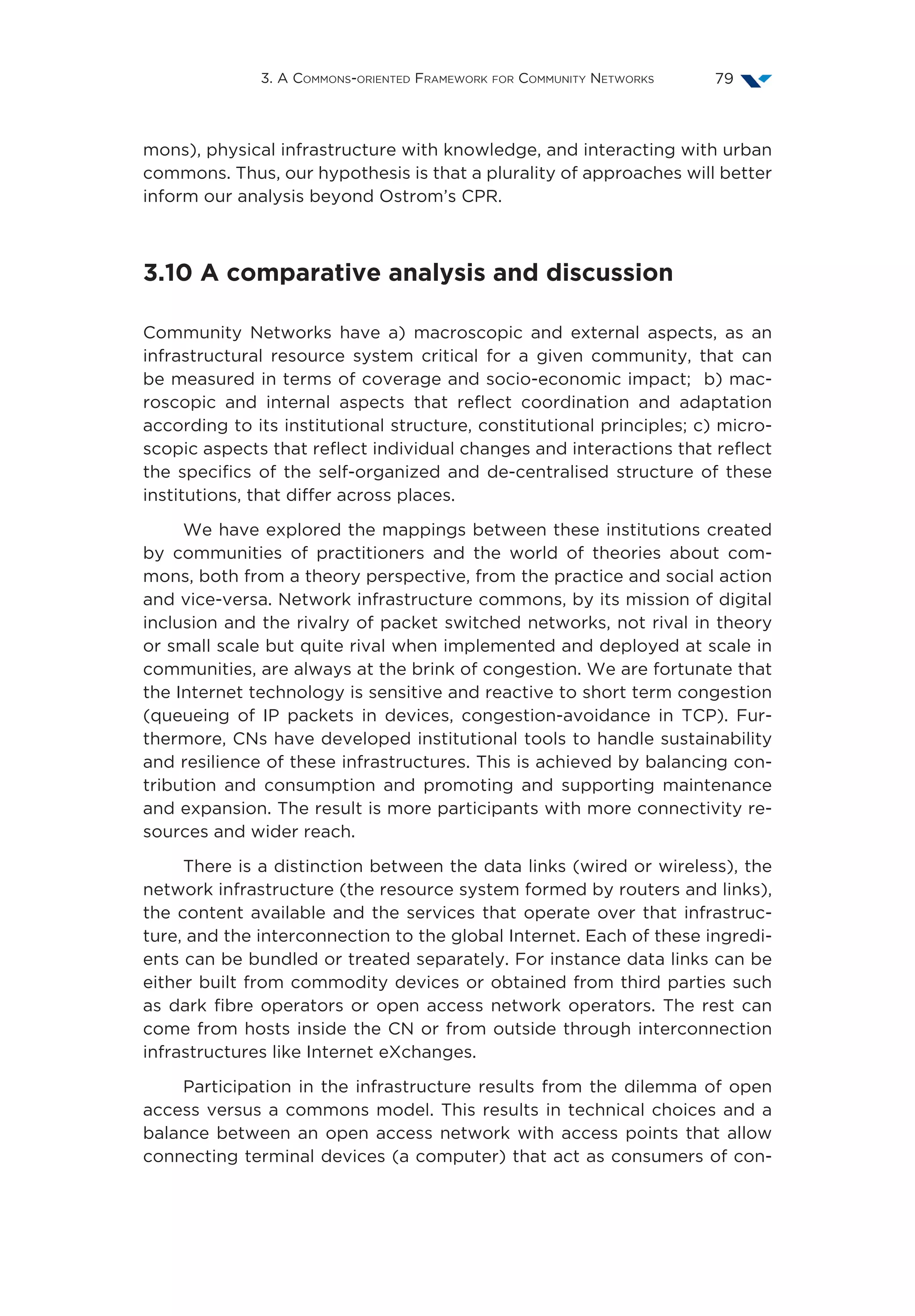
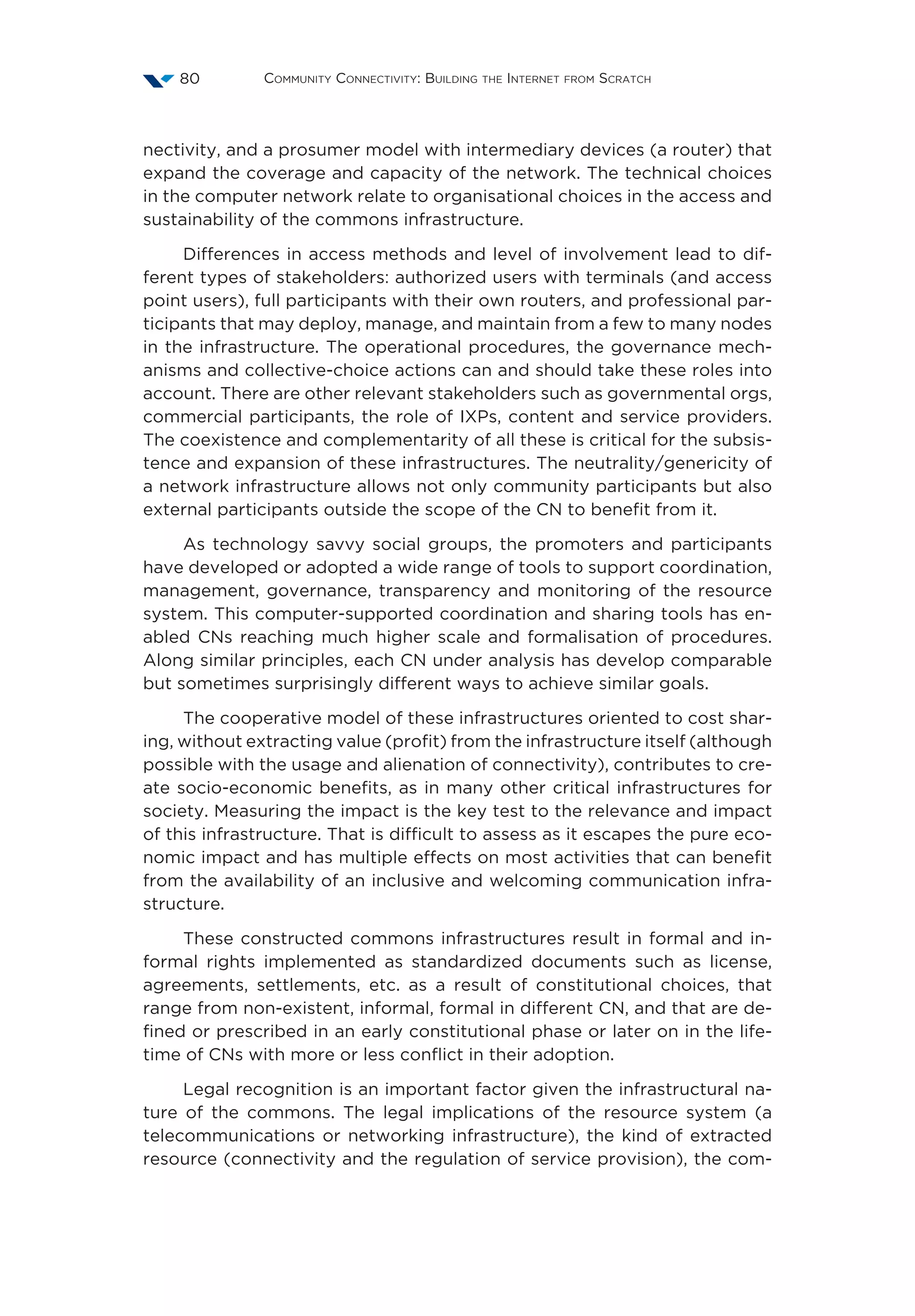
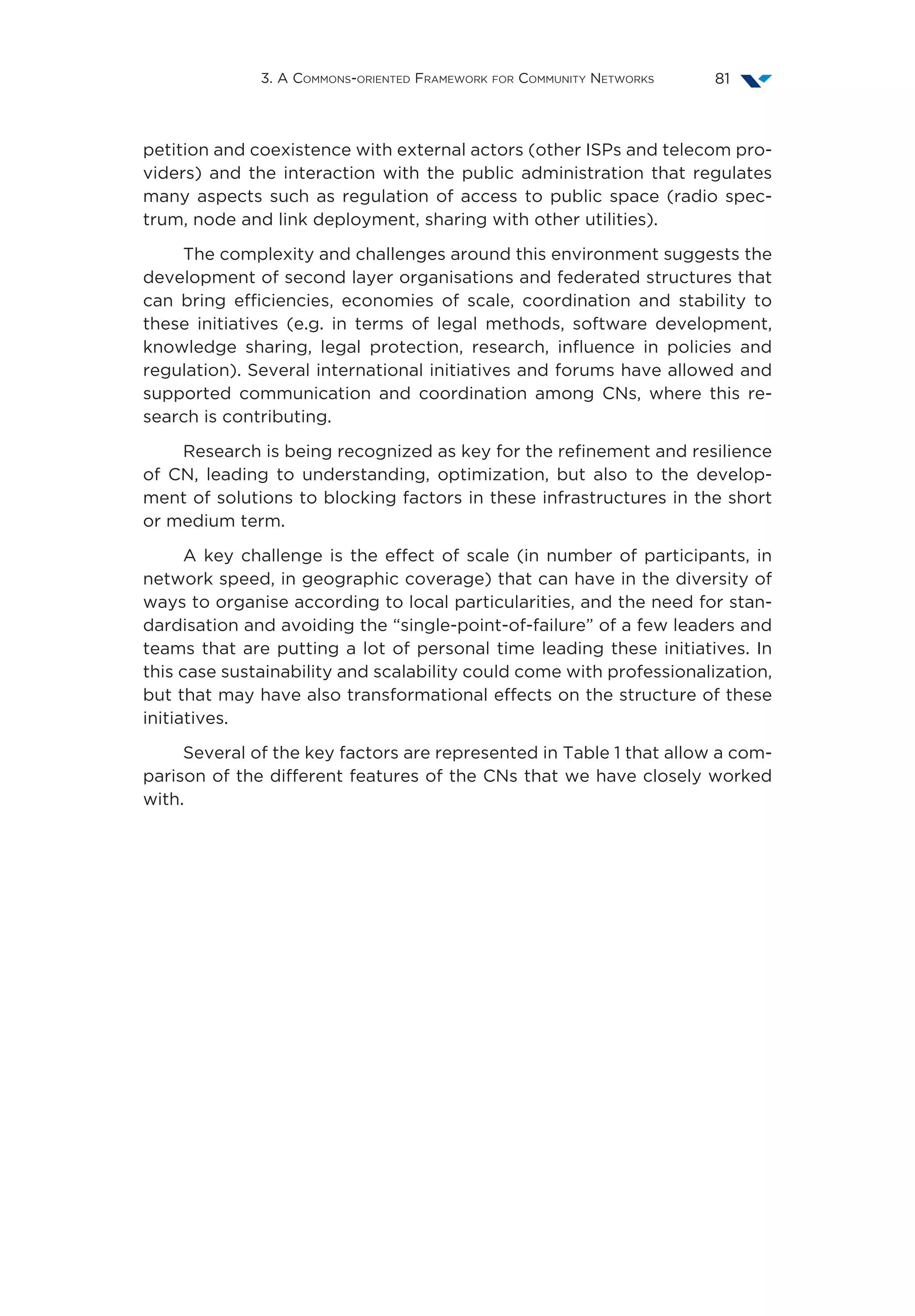
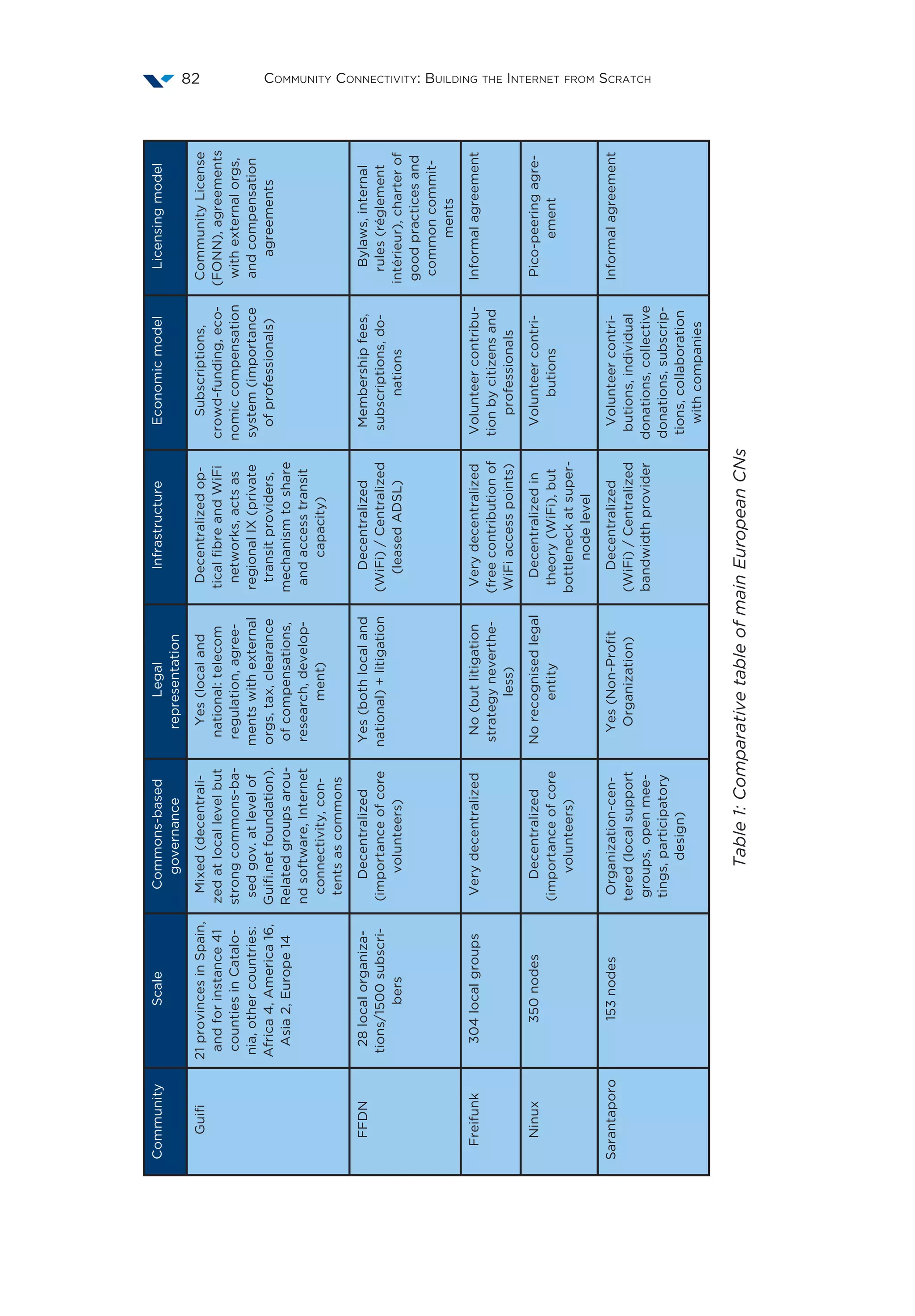
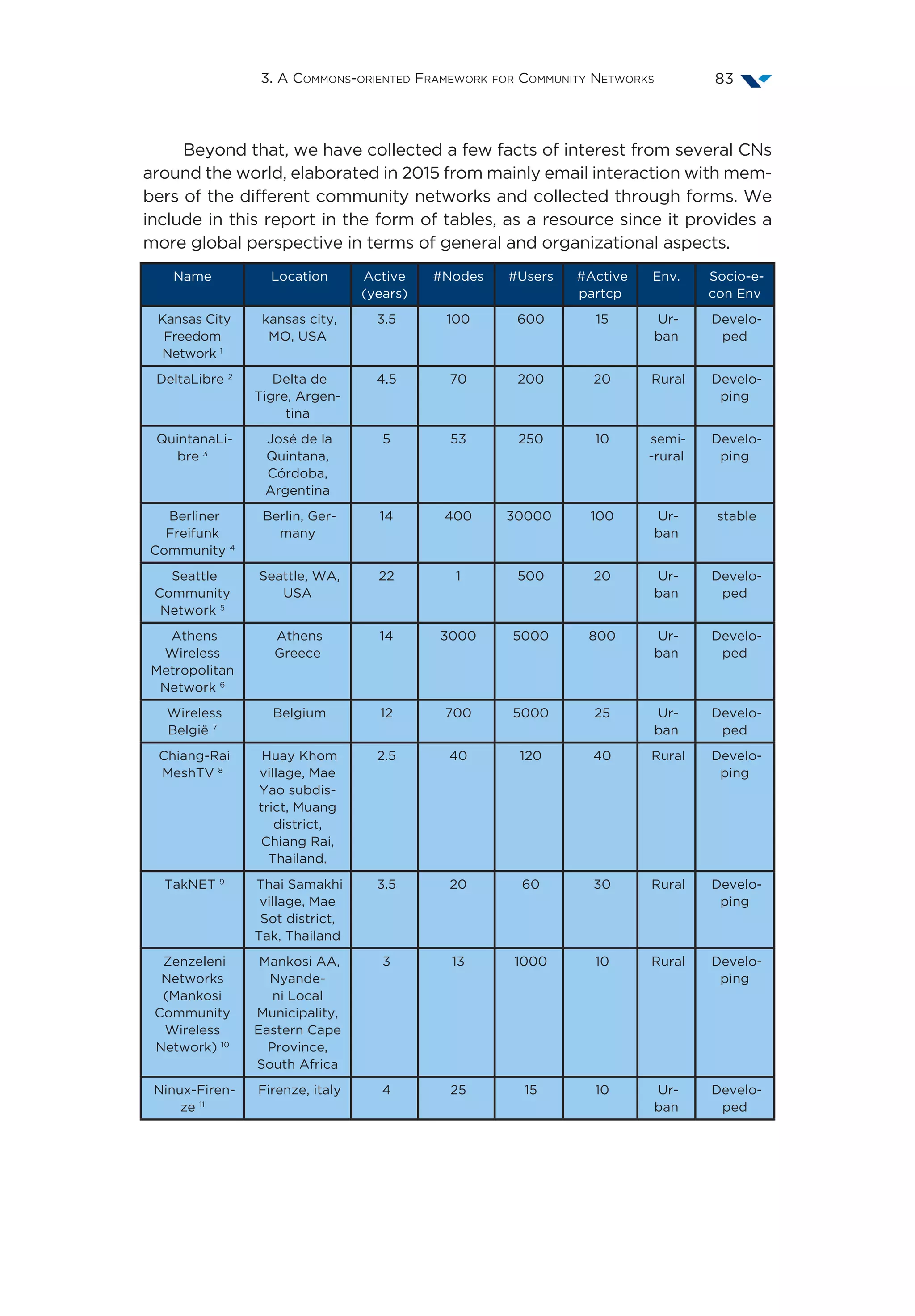
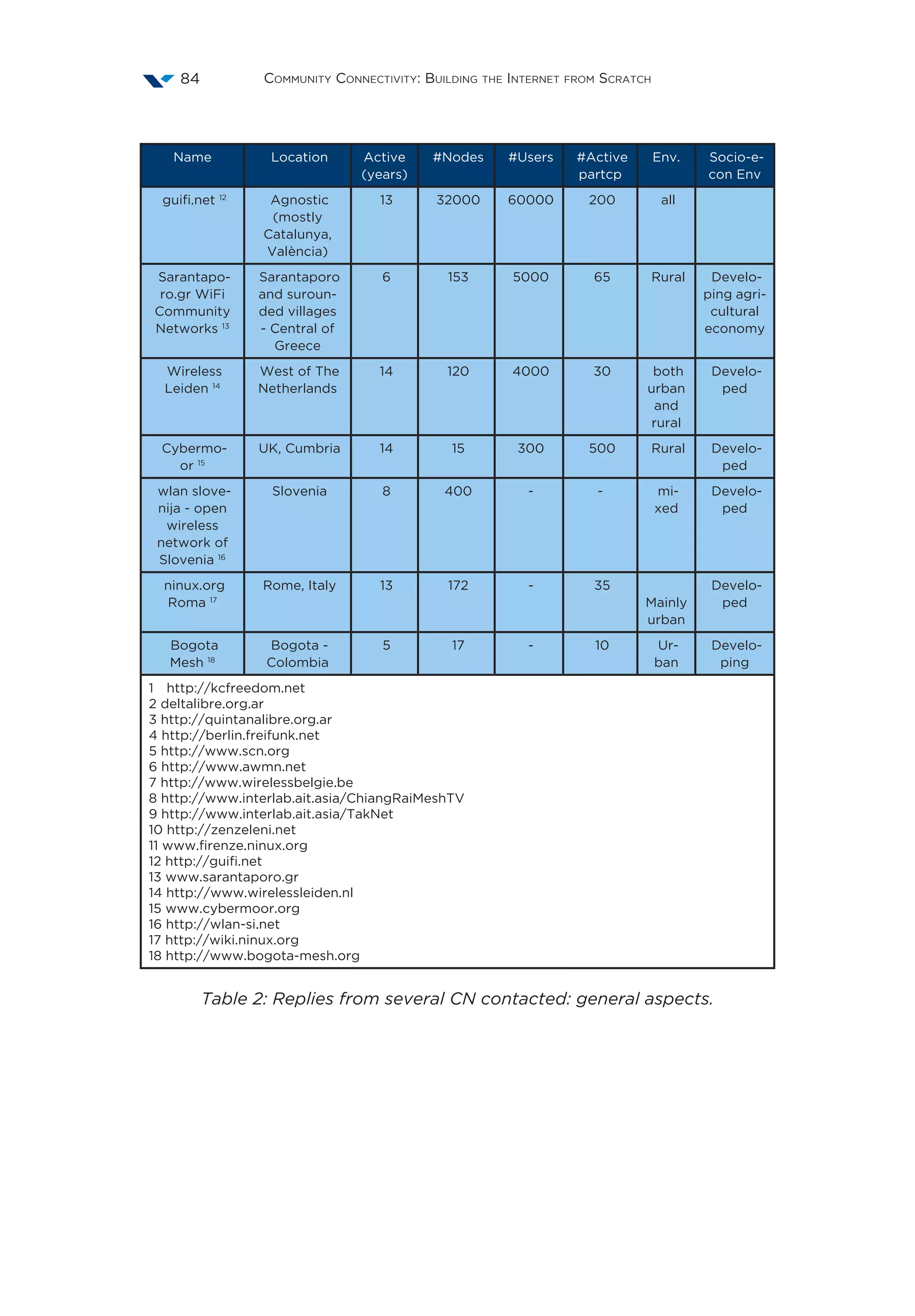
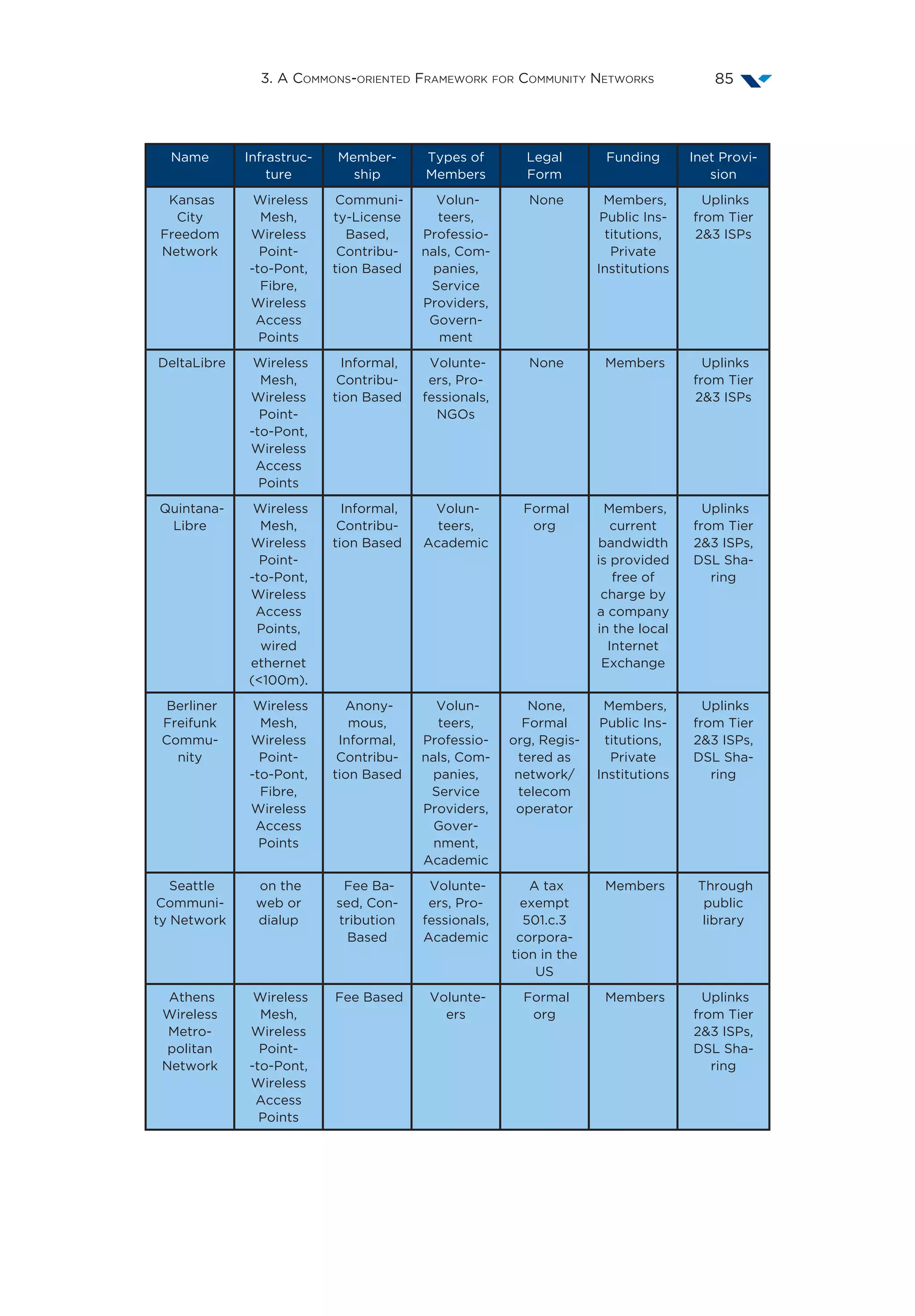
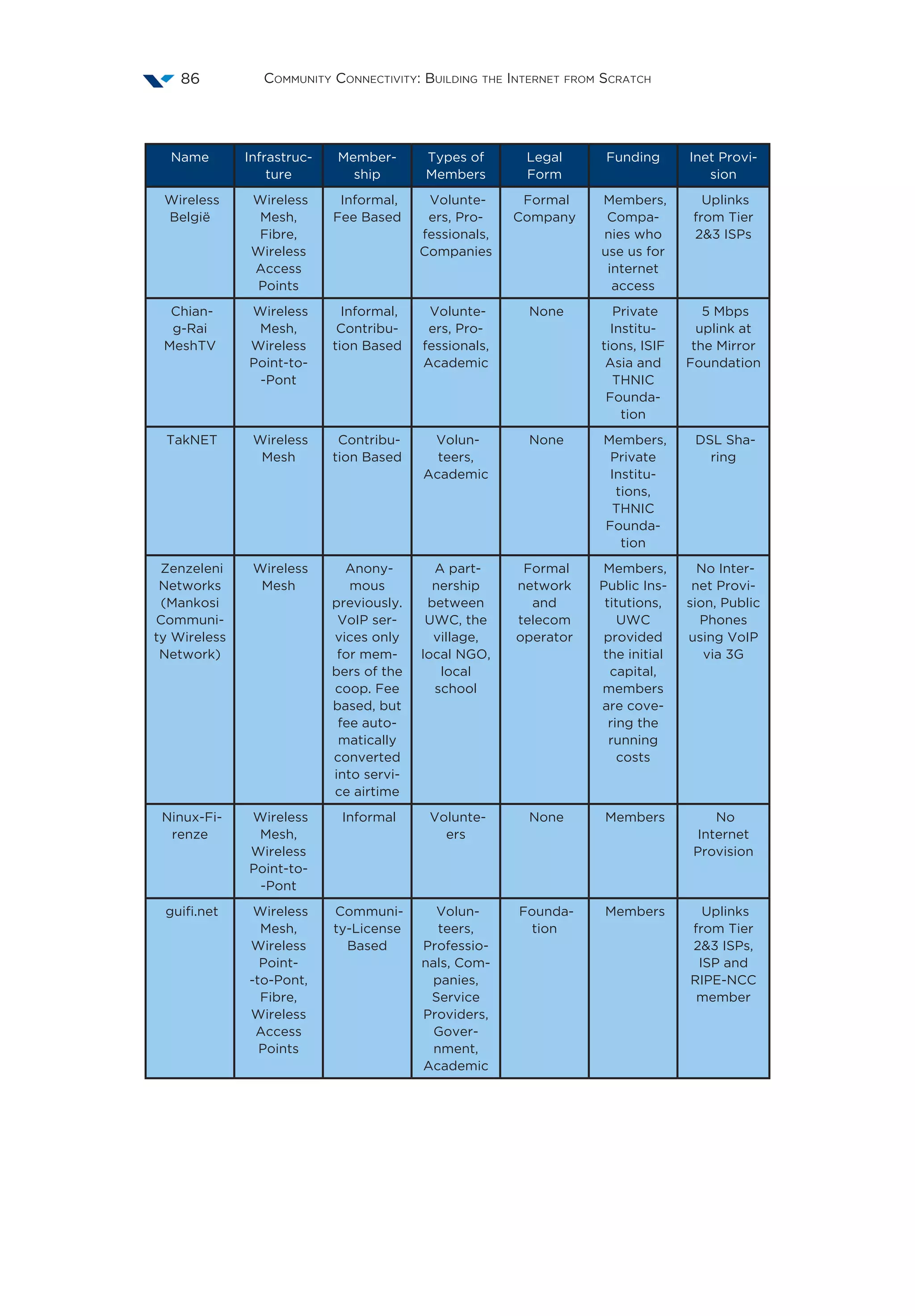
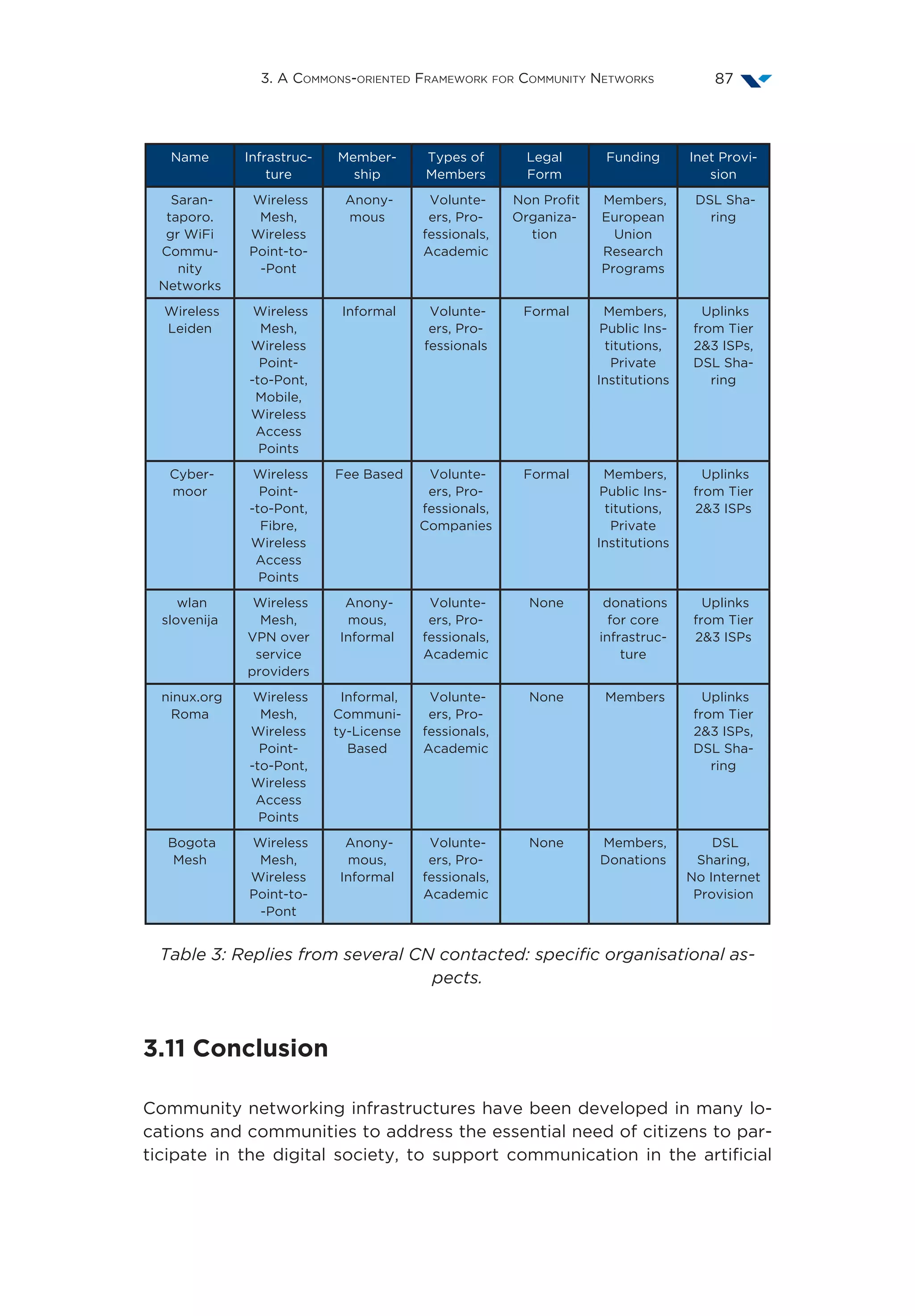
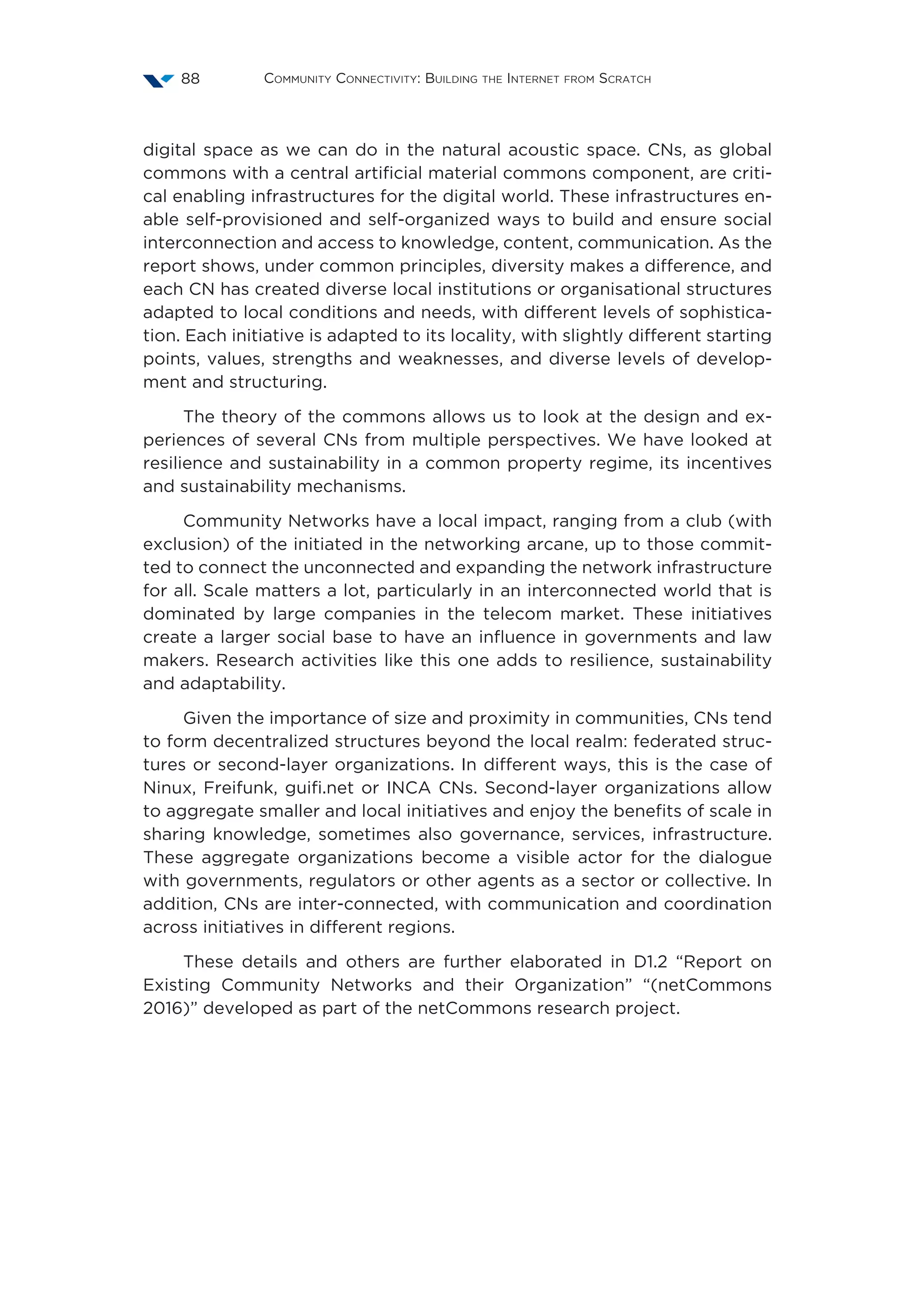
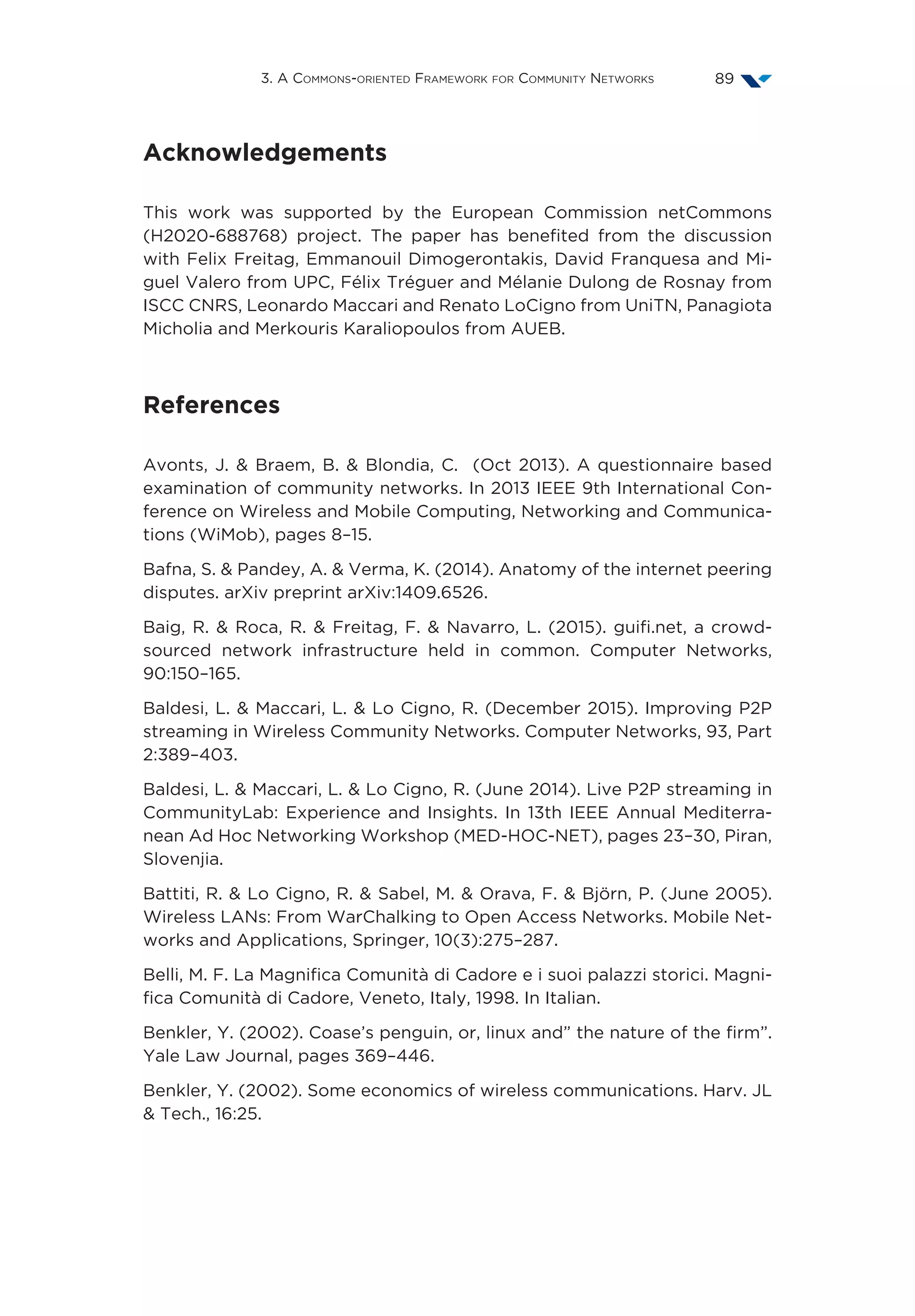
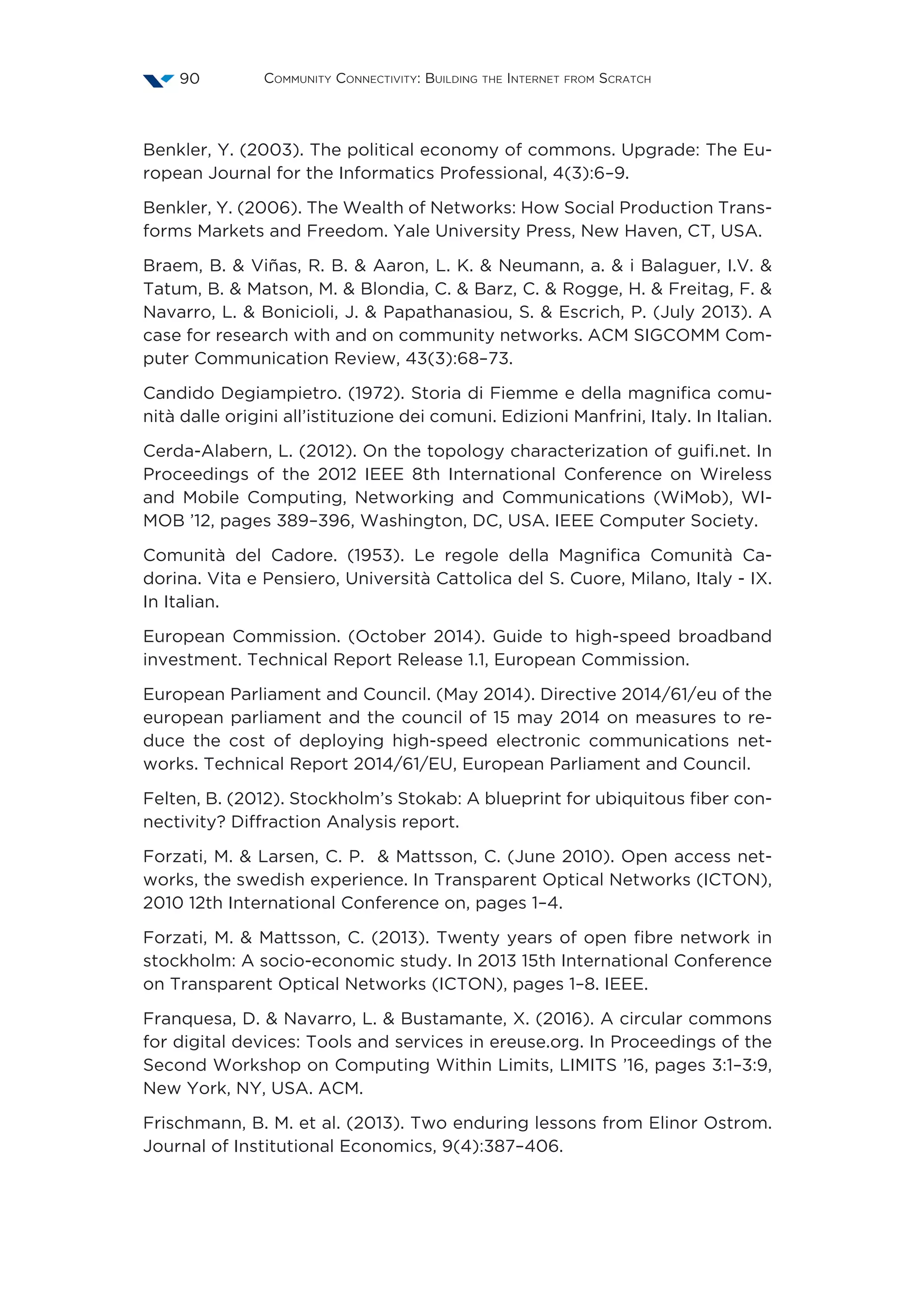

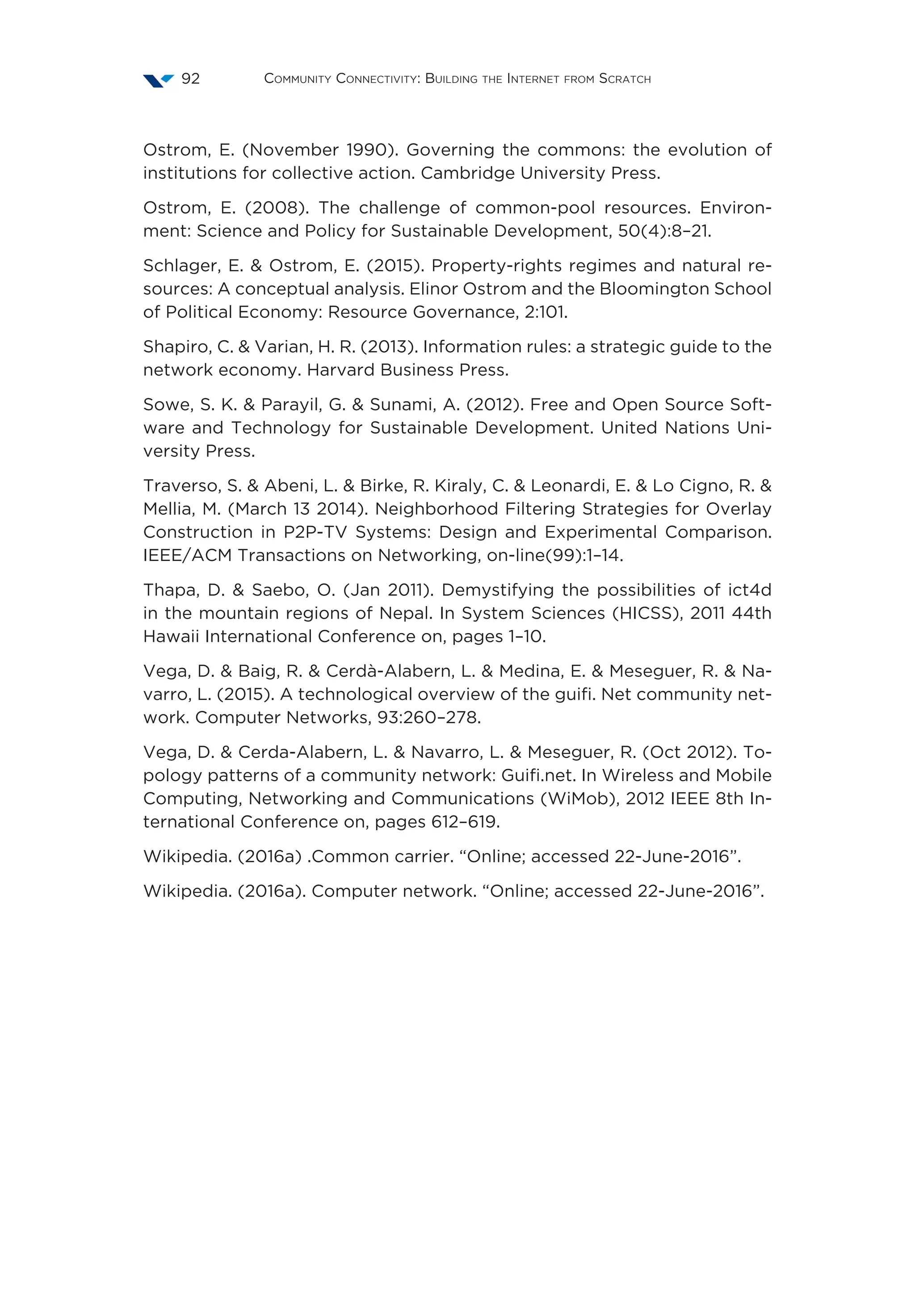
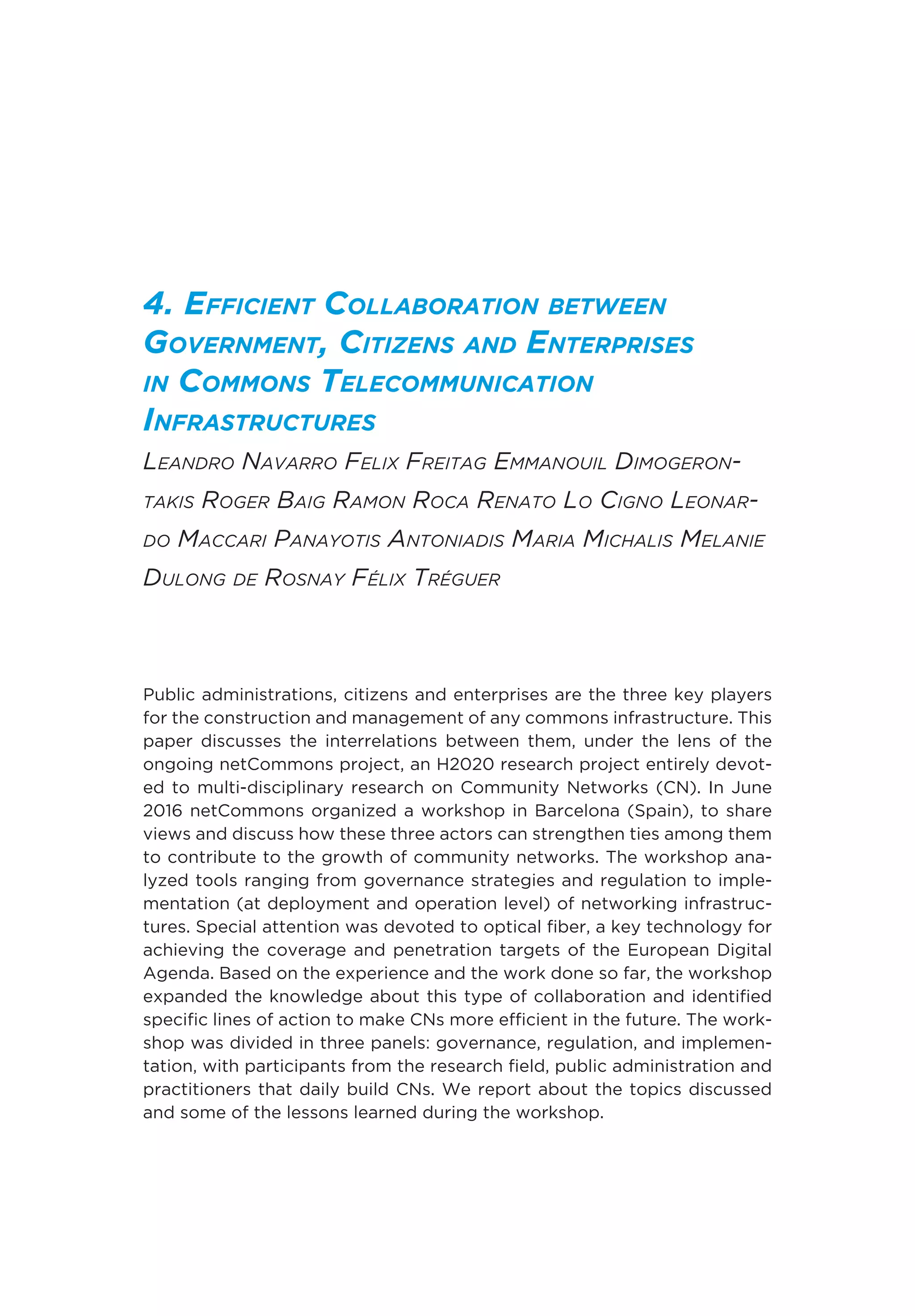
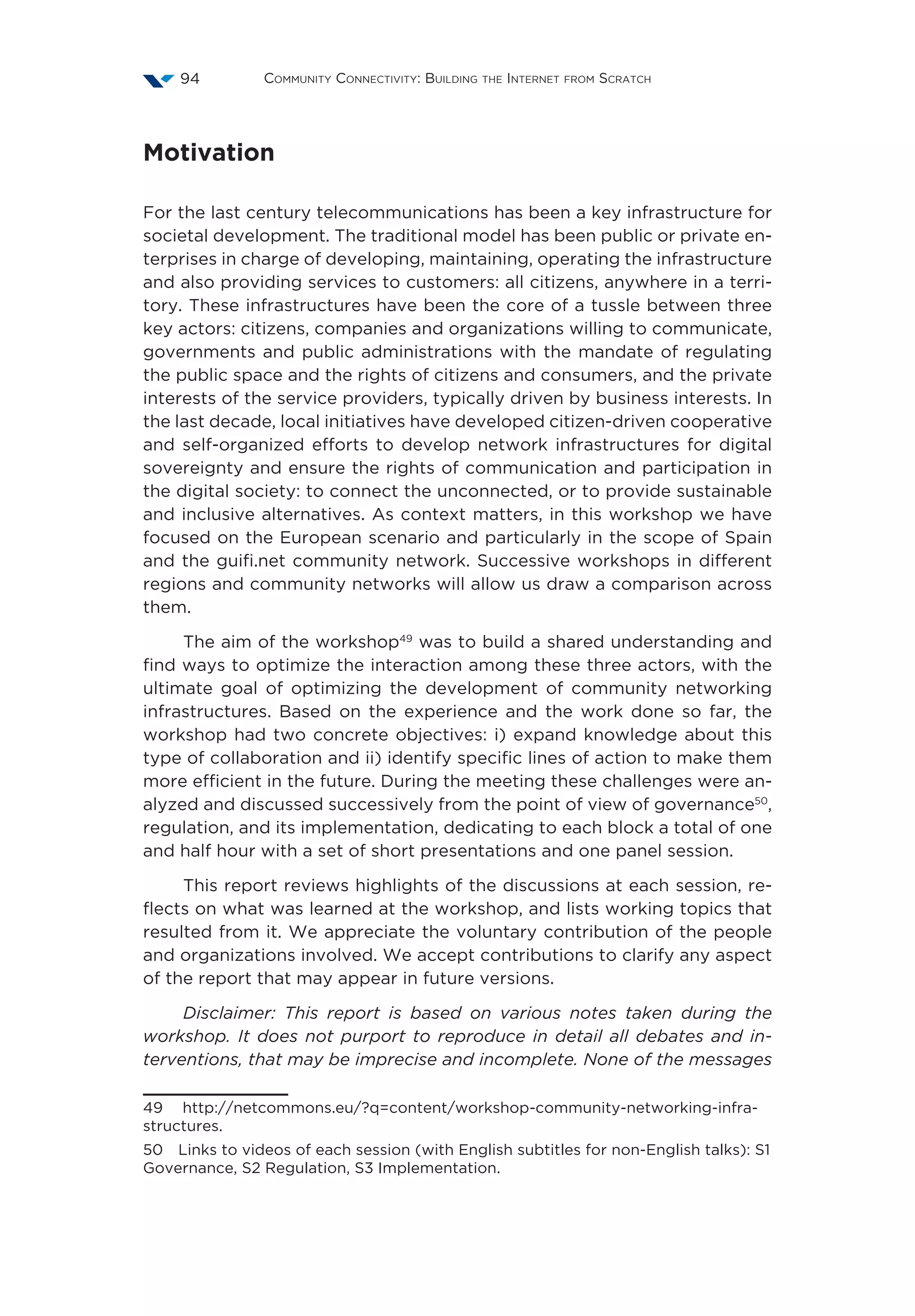
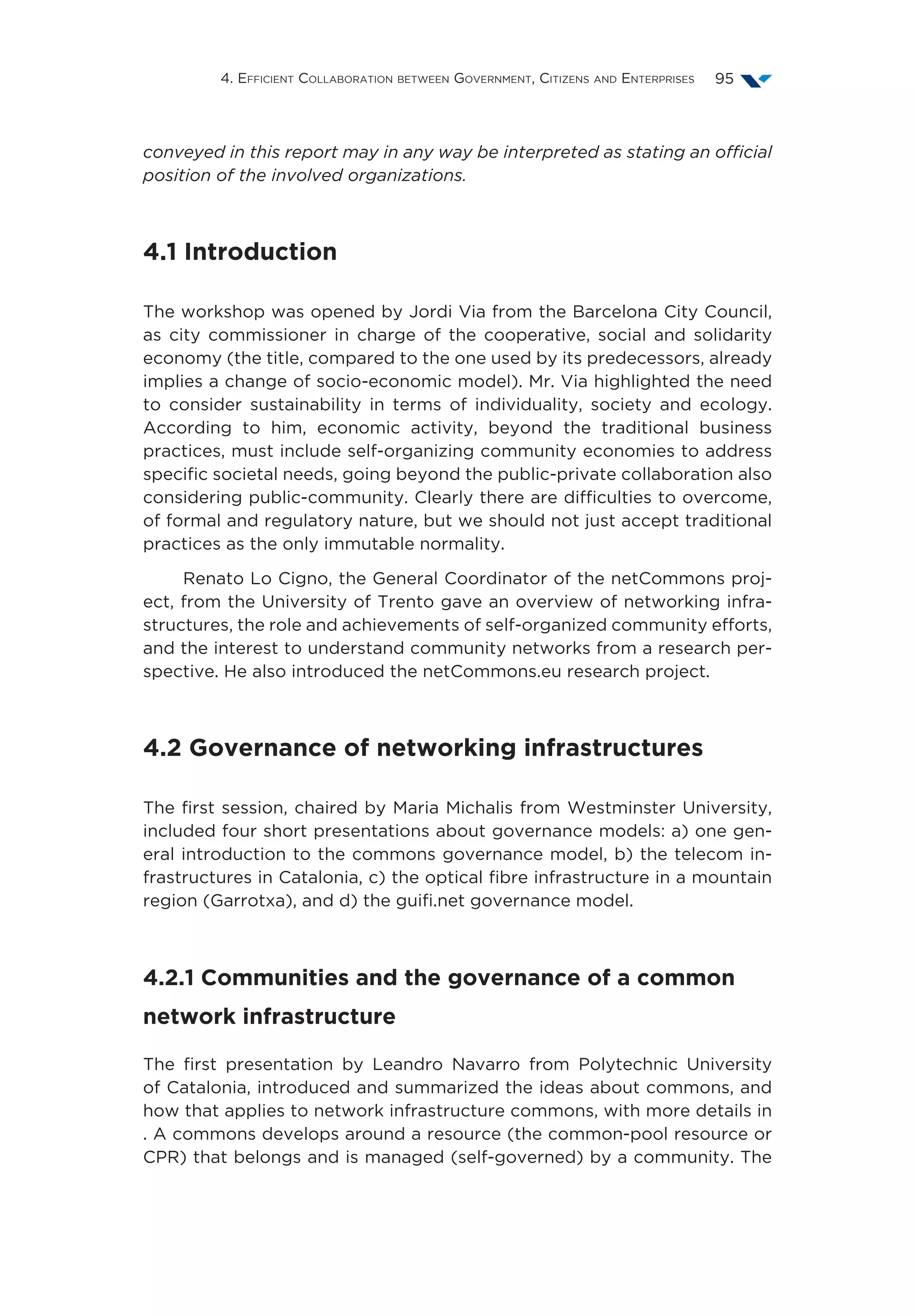
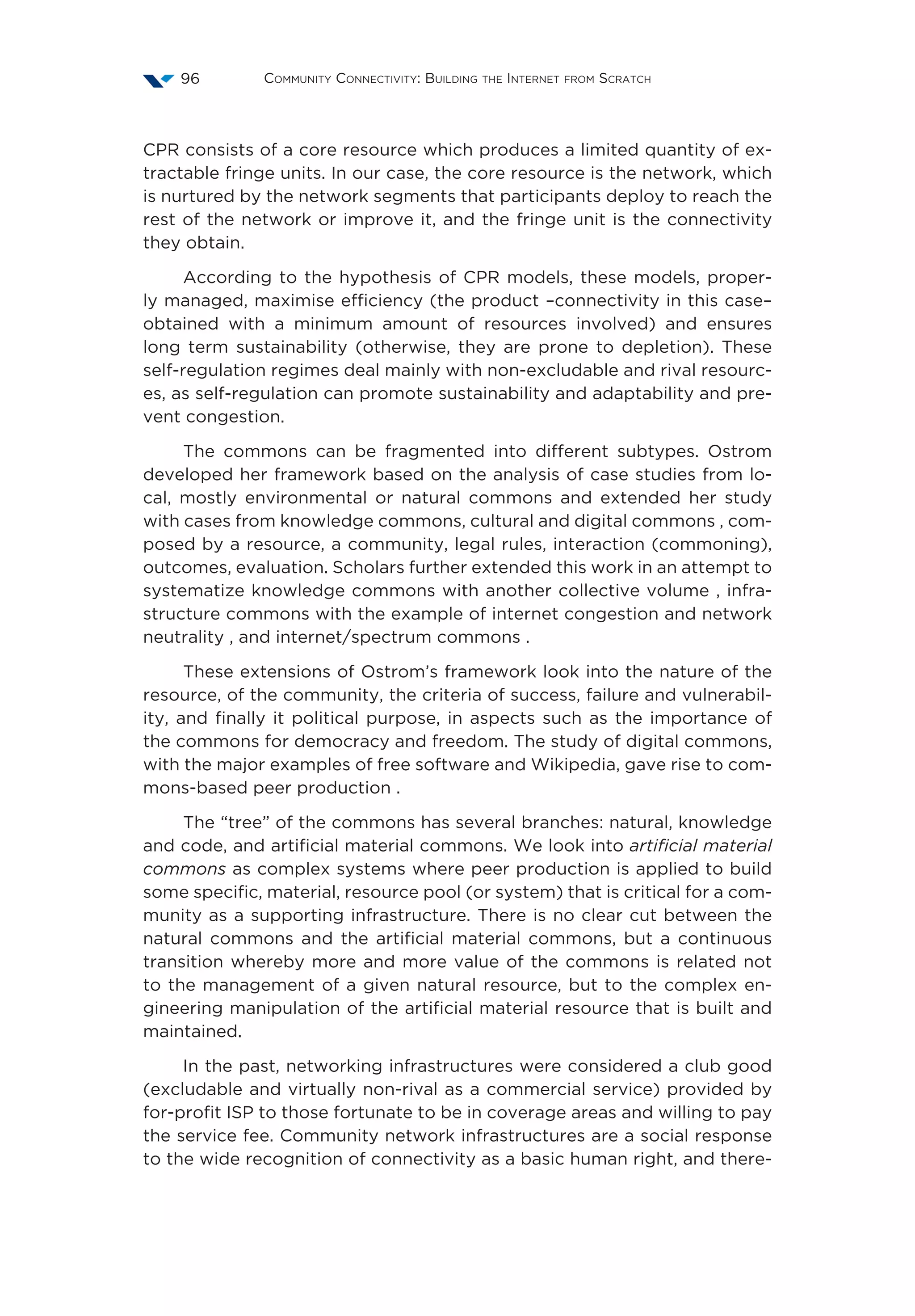
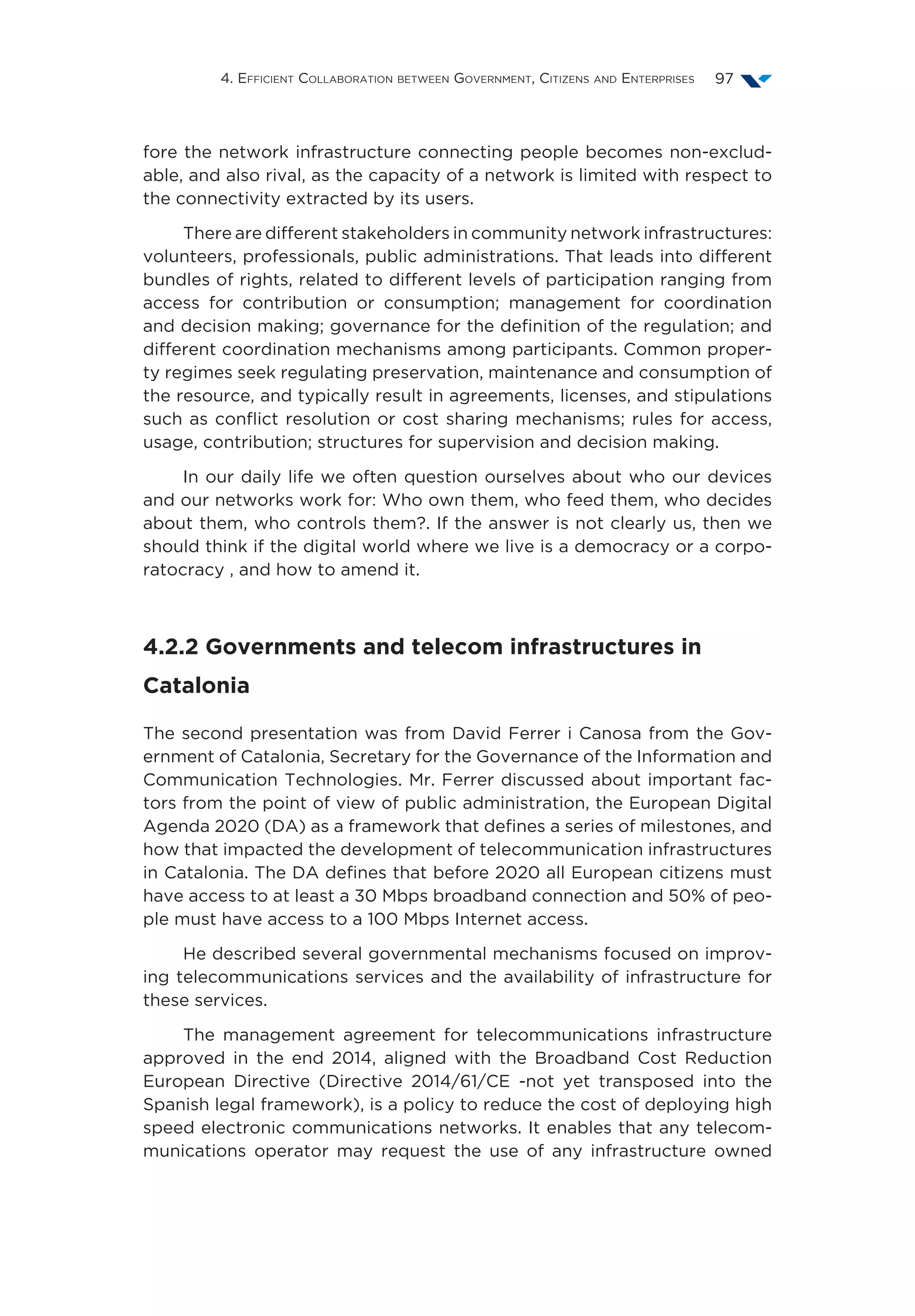
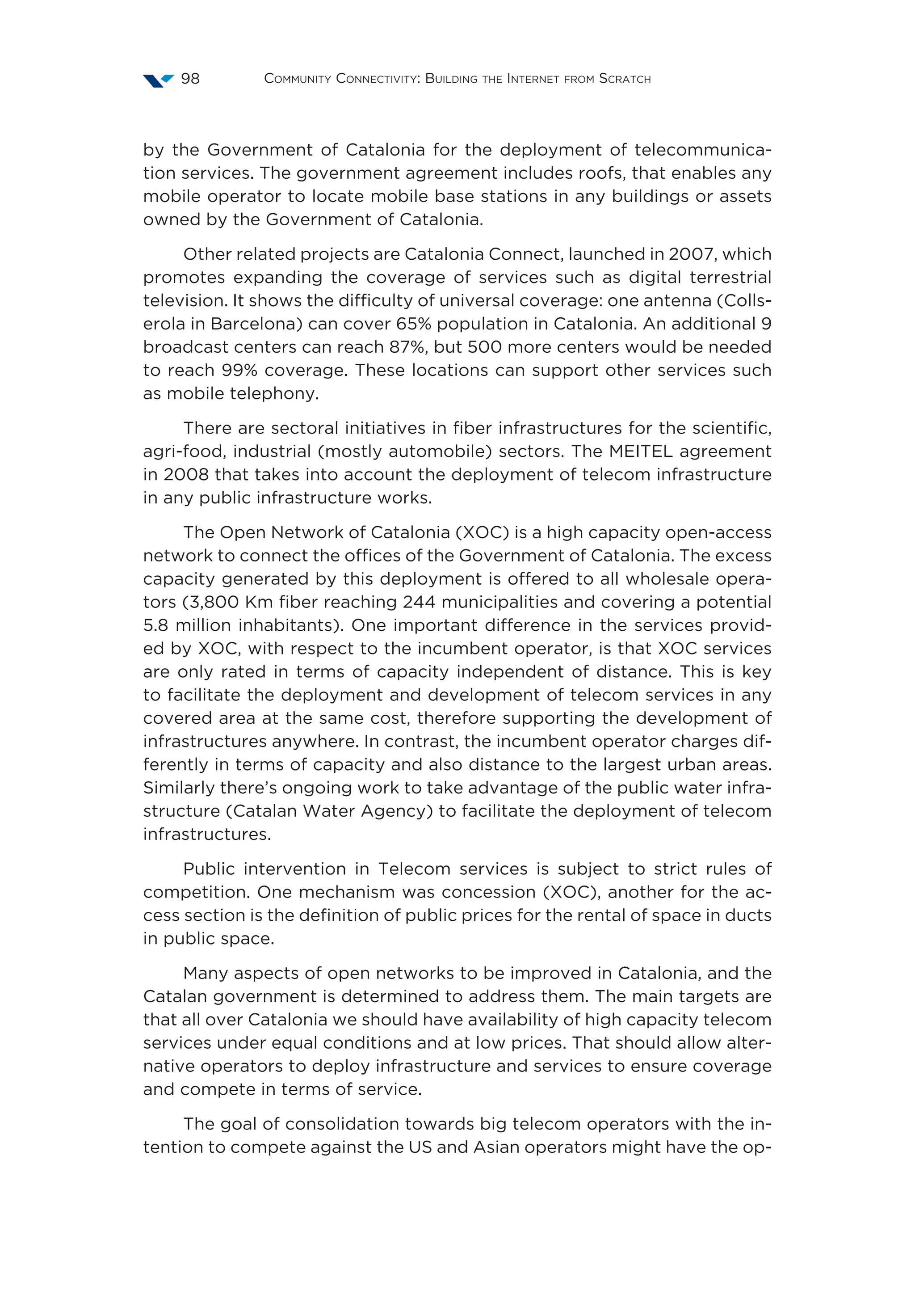
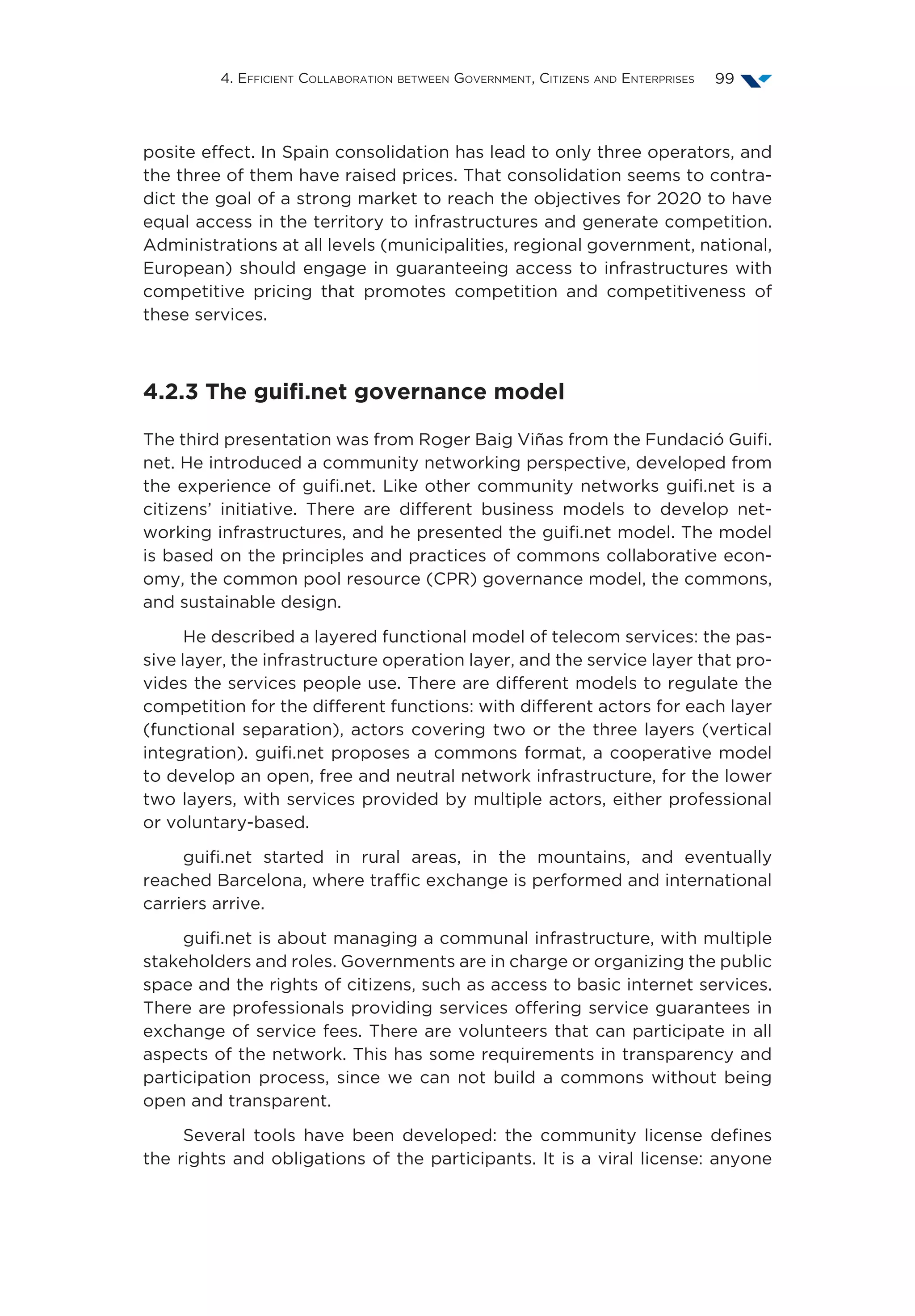
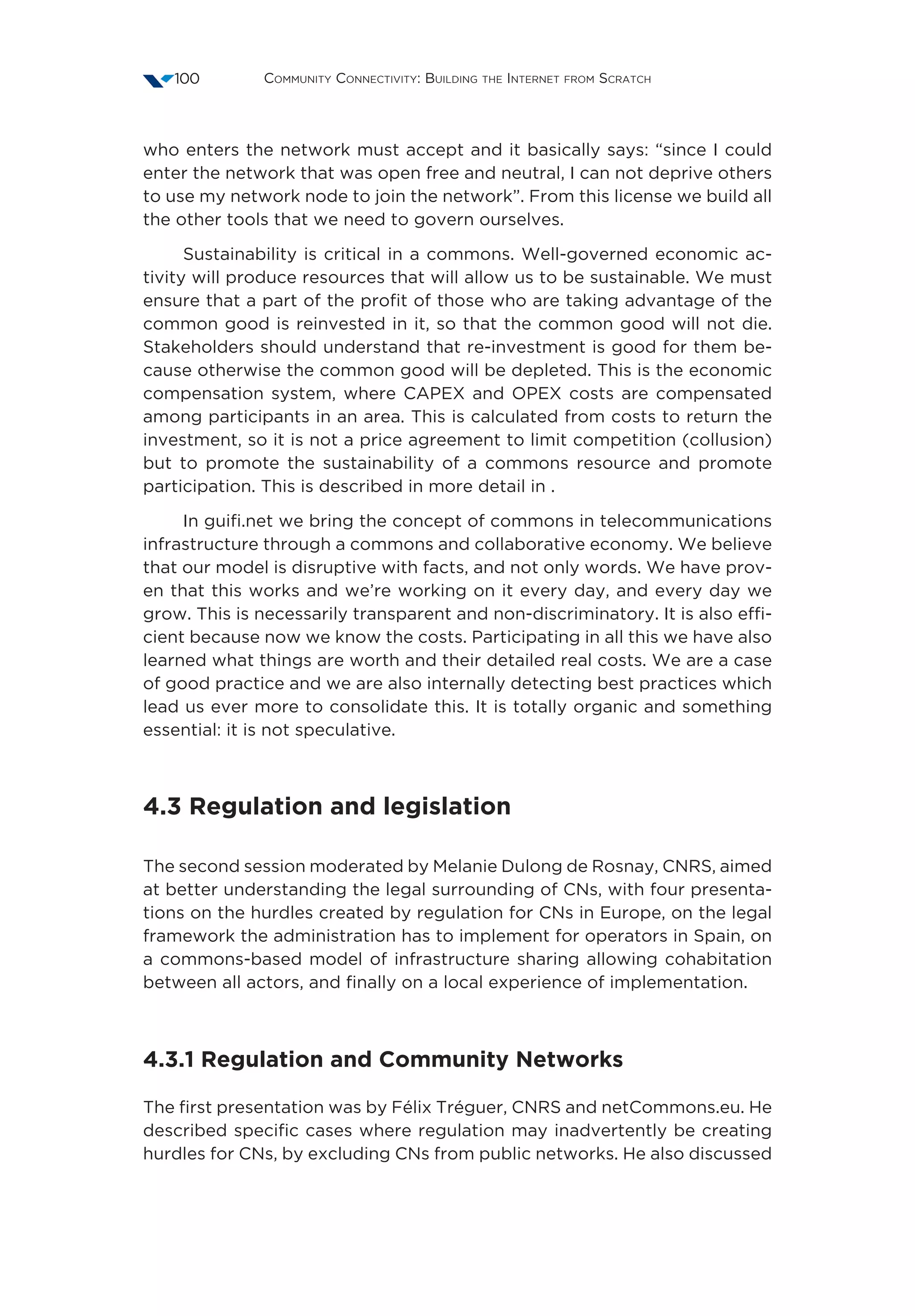
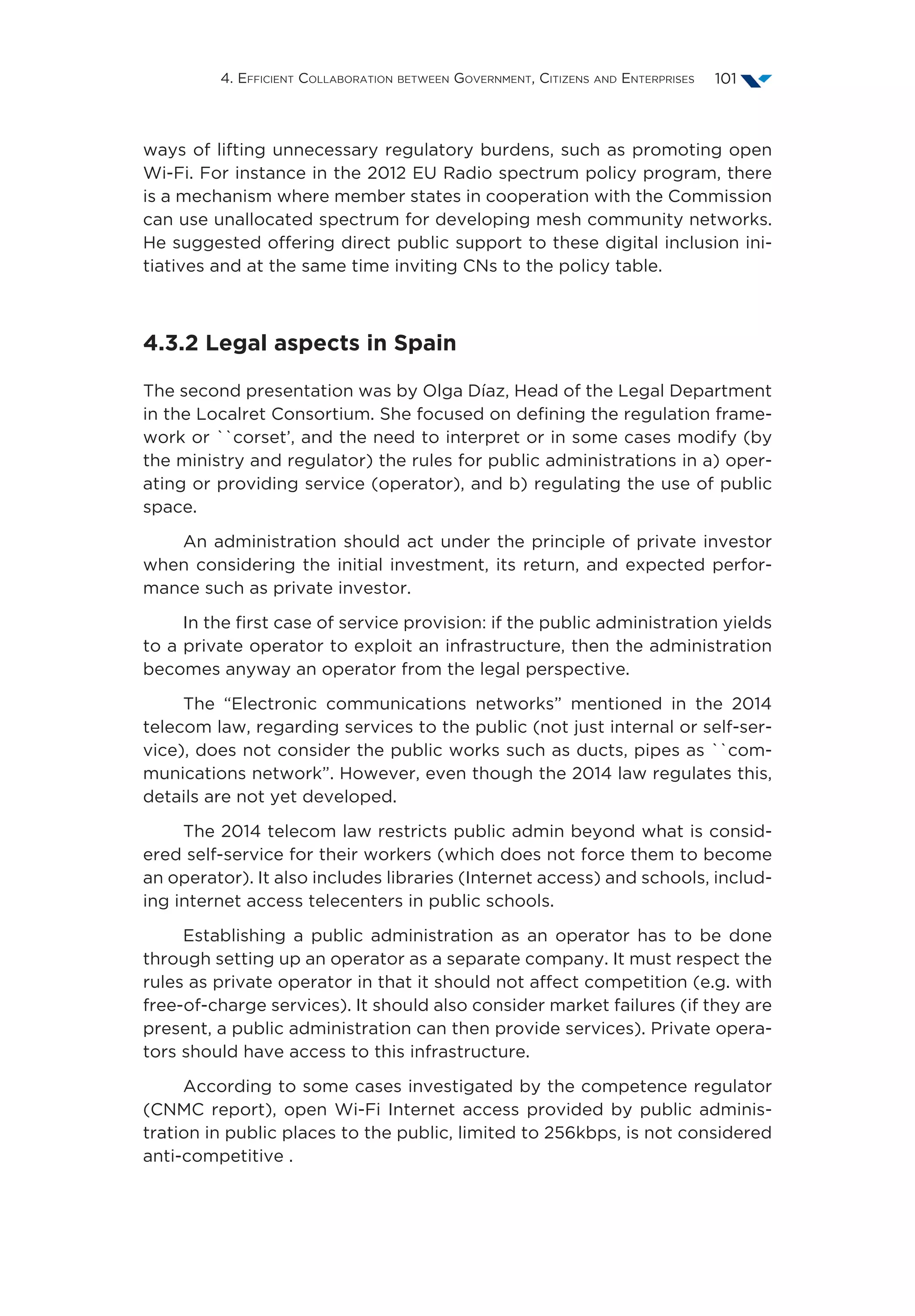
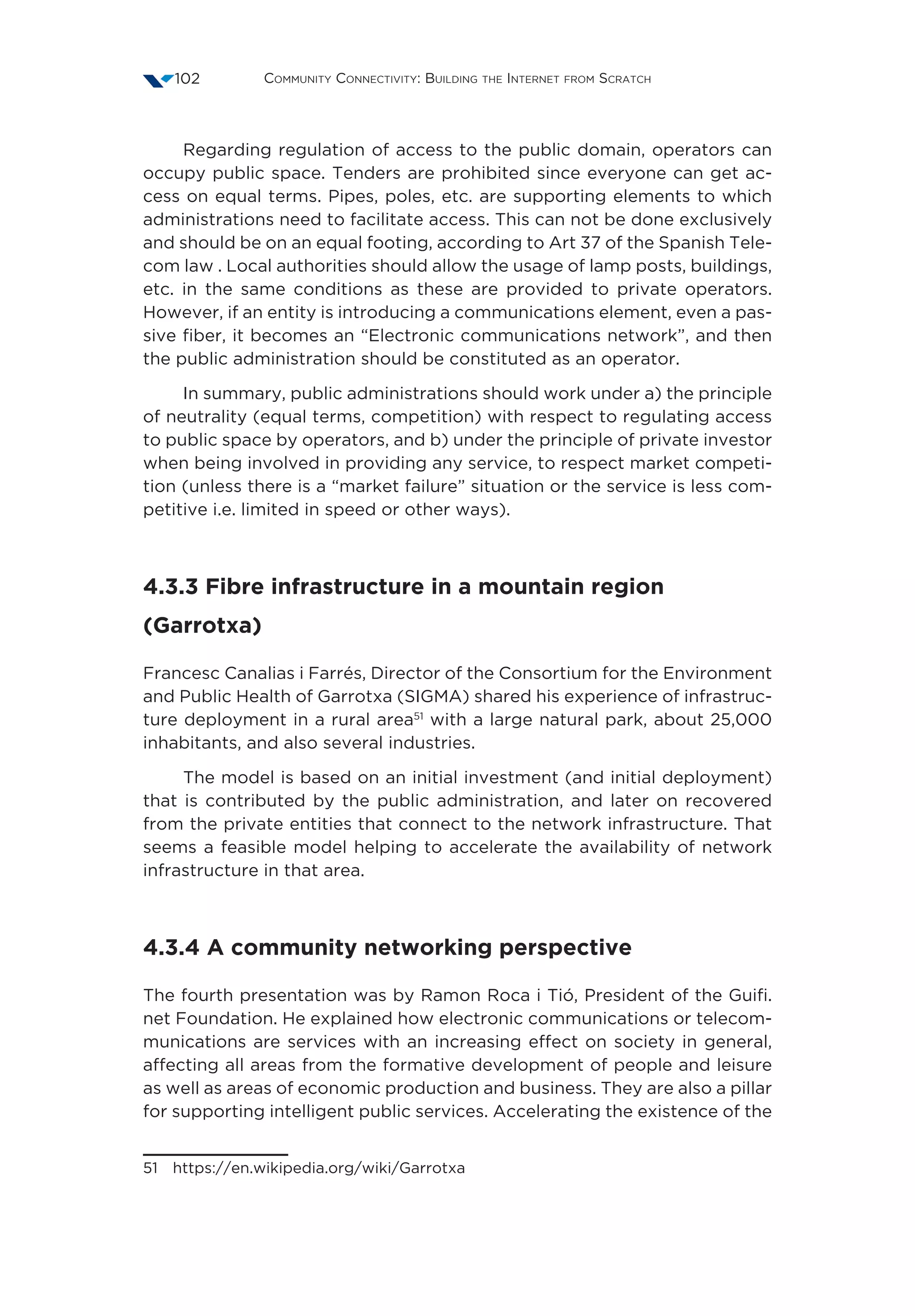
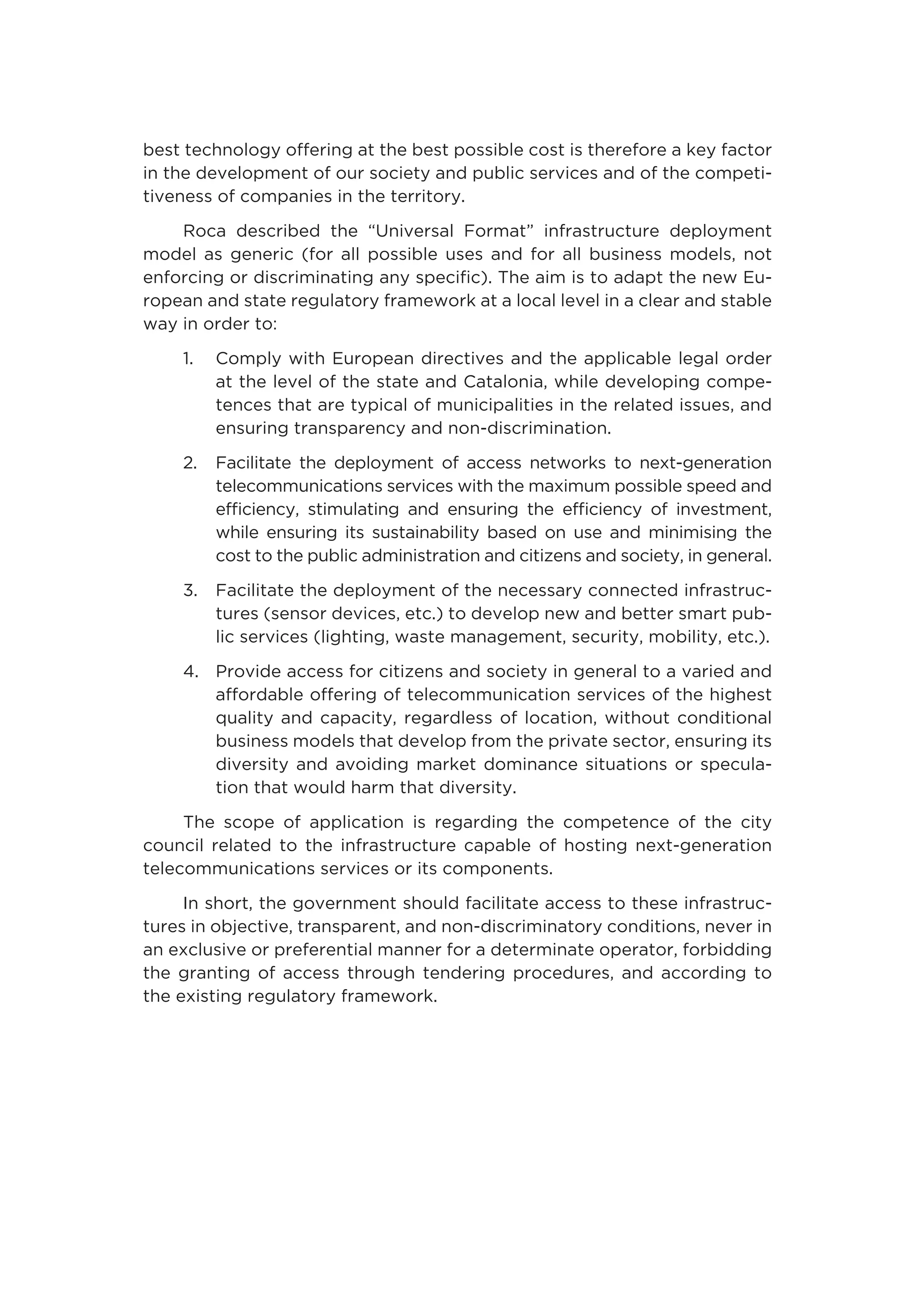
![Community Connectivity: Building the Internet from Scratch104
The Universal format for fiber cables
Deployment in Universal format is deployment that simultaneously
allows for the three classes of uses (self-service for the city council, pri-
vate, and shared or common use). To do so, a cable (with several buffers,
buffers with several fibers) is divided into three parts, one for each use.
At the start, each part has a minimal structural unit. The rest of the free
structural units will be available for upgrades for those who need them,
and who have irrefutably proved that they have exhausted the initially
reserved capacity. See the figure [fig:univf] for an example of the initial
distribution of the reserves of use of an optic fiber cable in three parts
(self-service for the city council, private, and shared), using fiber tubes as
the minimal structural units.
This model has been developed as a template for a municipal ordi-
nance. The purpose of this ordinance is to serve as a basis for municipal-
ities to regulate the deployment of infrastructure that could be used for
advanced networks, which is the responsibility of the city council.
4.5 Implementation: Challenges in carrying it into
practice
The third session moderated by Leonardo Maccari, University of Trento,
aimed at raising the challenges in deploying and managing network infra-
structures from the experience in specific cases. There were four presen-
tations from different scopes: European broadband infrastructures, public
financing from the European Commission, Barcelona from the City Coun-
cil, the guifi.net Foundation in Spain.
4.5.1 European Broadband infrastructures
Wolter Lemstra, Senior Research Fellow at the University of Delft, de-
scribed an analysis of the development of broadband network infrastruc-](https://image.slidesharecdn.com/communityconnectivity-buildingtheinternetfromscratch-170106183237/75/Community-connectivity-building-the-Internet-from-scratch-104-2048.jpg)
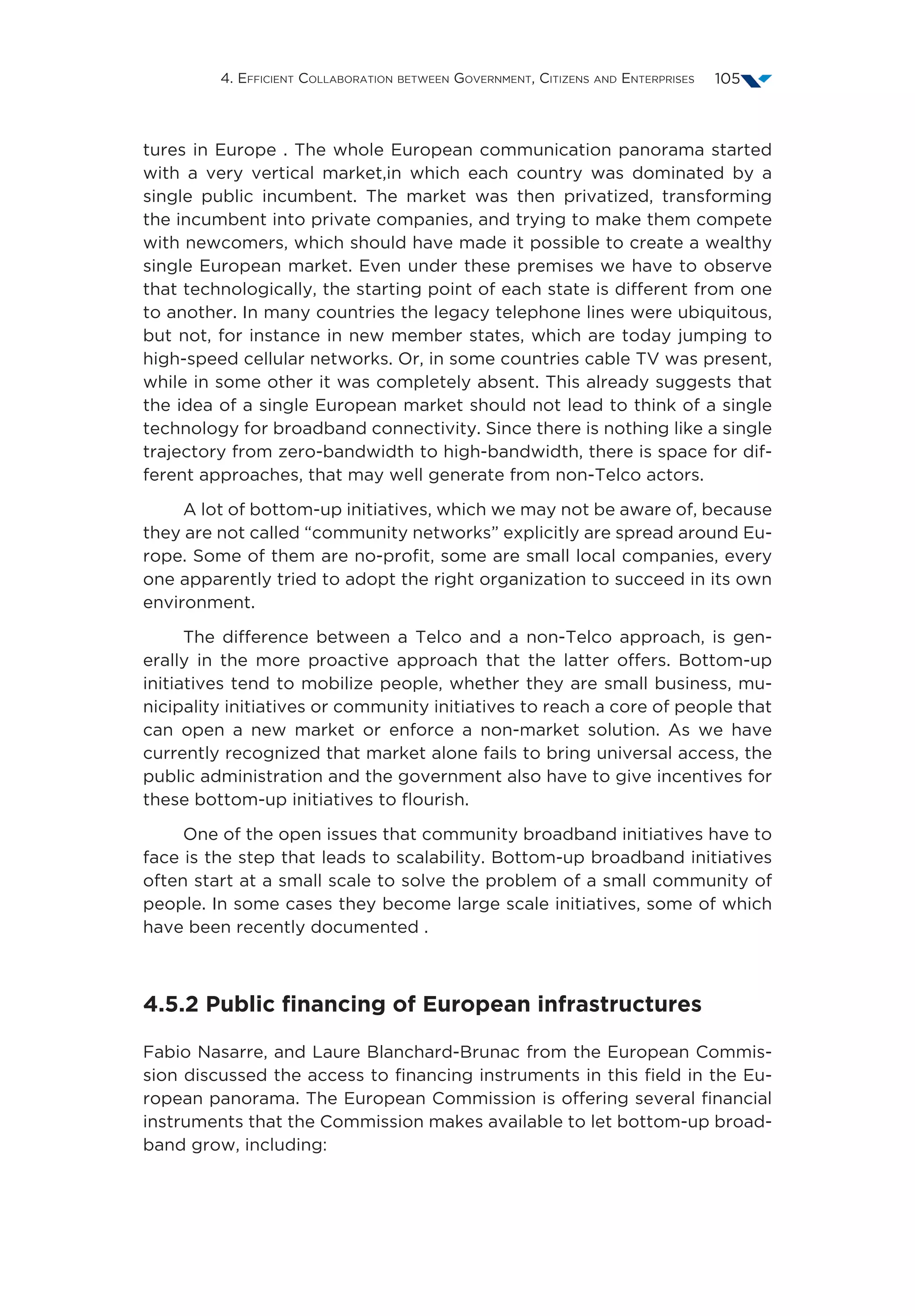
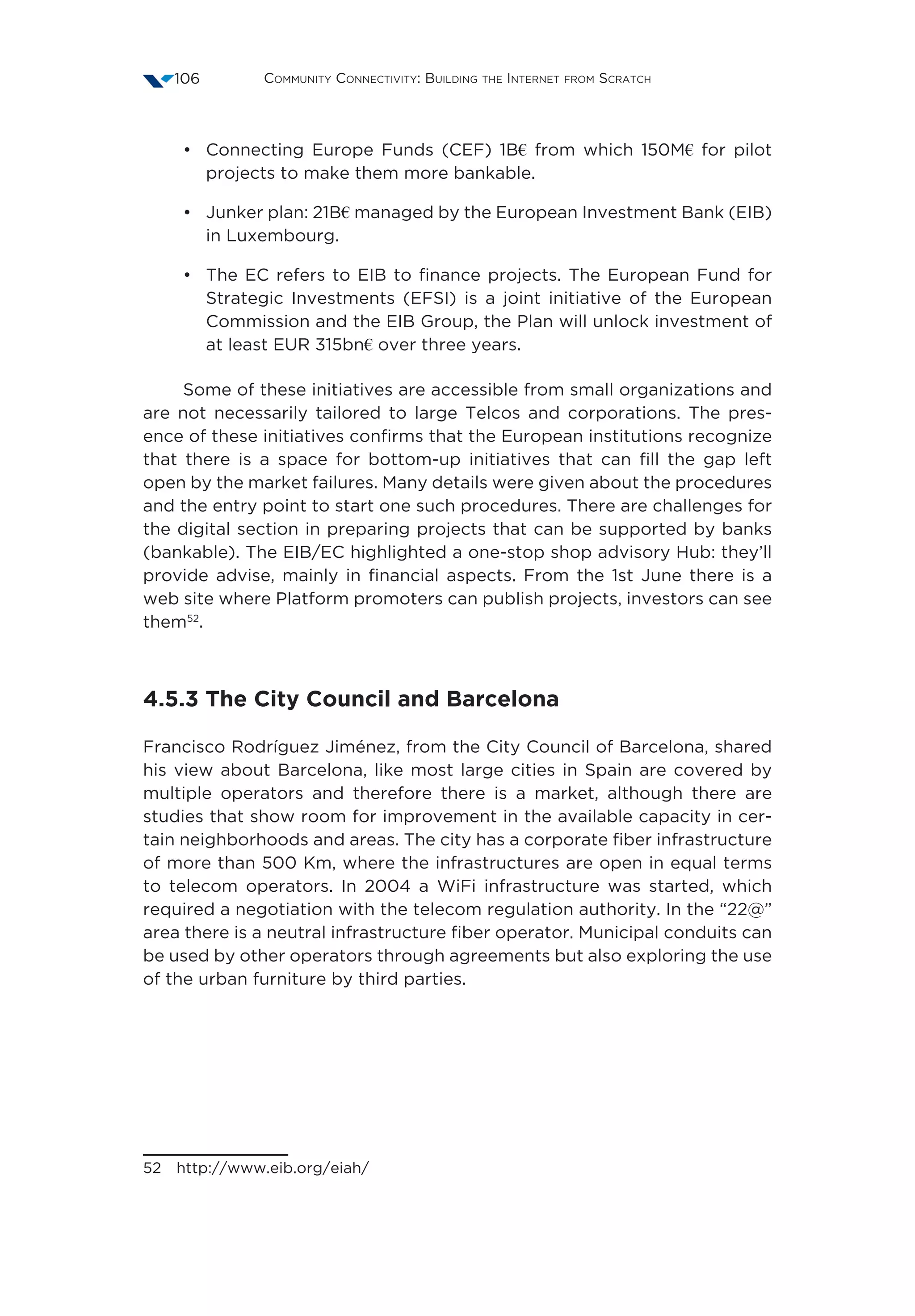
![4. Efficient Collaboration between Government, Citizens and Enterprises 107
4.5.4 The guifi.net deployment model
Lluís Dalmau i Junyent from the guifi.net Foundation presented the ap-
proach of guifi.net for the deployment and maintenance of network infra-
structures. We have also to recognize that a key point that distinguishes
the for-profit approach from the bottom-up commons approach is not
only the financial aspects, but, and most notably the way the resources are
organized, shared and managed. Under this point of view the experience
of Guifi is probably the one that produced the most in-depth analysis of
the “commons” concept and its application to networks. Guifi, interpret-
ed Ostrom principles and translated it into and the transparency [NOT
CLEAR] , definition of roles and a compensation system that accumulates
information about expenditure (CAPEX and OPEX) and resource con-
sumption (usage).
4.6 Discussion
There are multiple organizational models to develop a networking infra-
structure. Beyond the traditional commercial model (investor and prof-
it driven, extractive for the target service consumers), there are com-
mons-driven models that can develop community infrastructures in a
cooperative, cost sharing, and self-organized manner. Diversity of mod-
els contribute to ensure the availability of connectivity, the development
of sustainable networking infrastructures and ultimately boost local so-
cio-economic development. It has parallel features to free software, that
create viable alternatives, is developed cooperatively, and can create
opportunities to develop higher added-value in the volunteer, in the pro-
fessional or commercial sector too. Cooperative models have developed
ways to create economies of scale (grouping individual entrepreneurs and
professionals sharing risks, aggregating costs, sharing infrastructures),
create economies of knowledge and tools (sharing the effort to develop
know-how, procedures, software tools and services).
Public administrations (city councils, municipalities, and governments
at all levels) have the responsibility of regulating the offer of networking
services to citizens, the occupation of the public space, preventing dis-
crimination: towards citizens under objectives of fair (universal) service to
ensure communication rights, and towards network operators to ensure
market rights. Competition should be preserved when available, but the
role of public administrations is also to promote the offer or alternatives in
cases of “market failure” including public investment. However these inter-
ventions should be under the principle of the public administration acting
as a “private investor”. In any case the regulation of occupation of public](https://image.slidesharecdn.com/communityconnectivity-buildingtheinternetfromscratch-170106183237/75/Community-connectivity-building-the-Internet-from-scratch-107-2048.jpg)
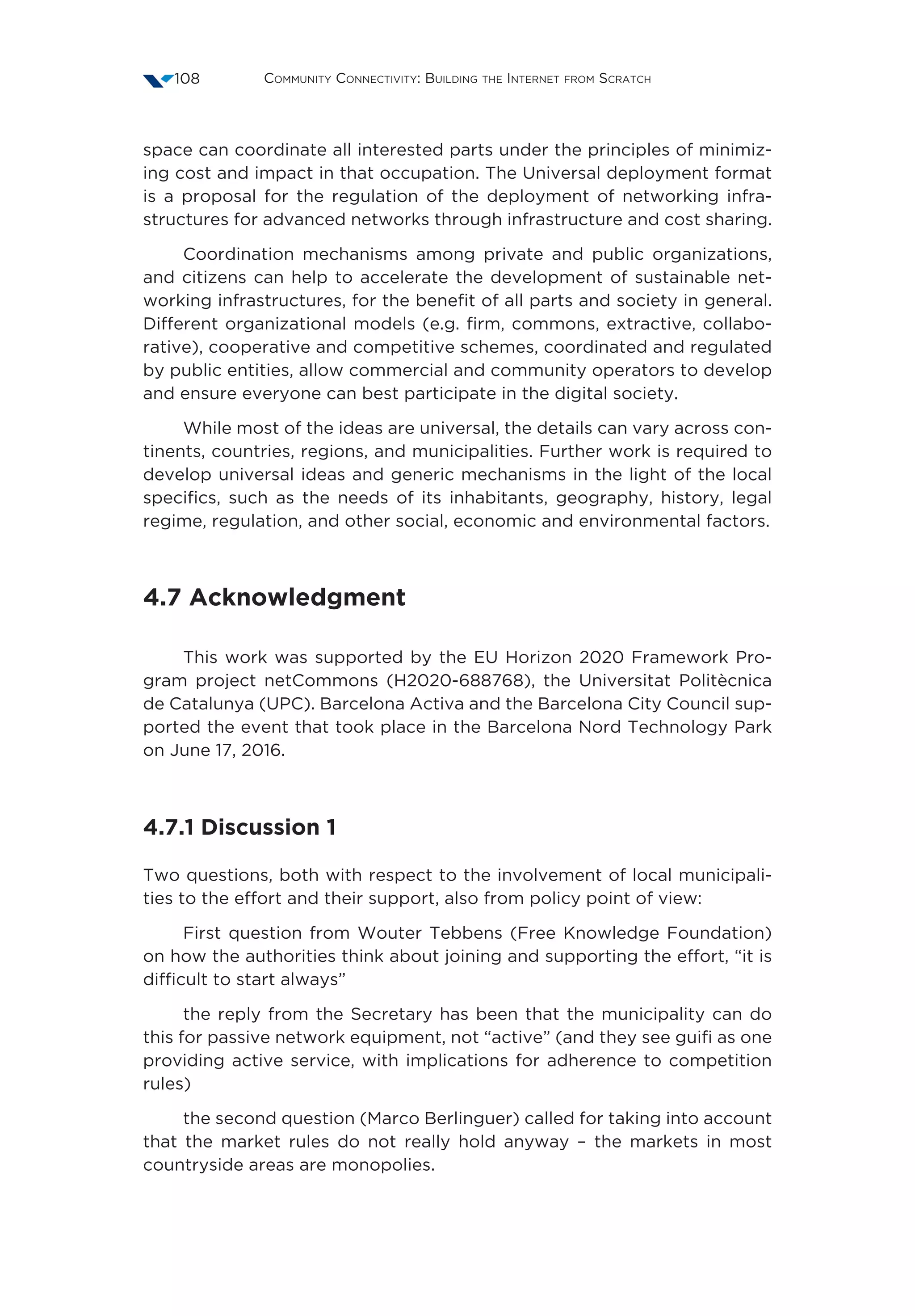
![4. Efficient Collaboration between Government, Citizens and Enterprises 109
Roger: “at first hand, we ask for equal treatment, i.e., get the right to
use ground and terrace for the deployment of equipment”
4.7.2 Discussion 2
Two important issues raised:
We have to be more attentive to gender issues. Only one woman was
among the speakers. We will have to rebalance this in future workshops.
Ostrom principles deal with the definition of successful commons ex-
periences, more research has been done in the following to describe the
governance of such commons and in particular, of digital commons. I think
the reference that was given is the following one: Governing Knowledge
Commons, Brett M. Frischmann, Michael J. Madison, Katherine J. Strand-
burg
References
Baig, R., Dalmau, L., Roca, R., Navarro, L., Freitag, F., Sathiaseelan, A.
(2016). Making community networks economically sustainable, the gui
.net experience. In Proceedings of the 2016 workshop on global access to
the internet for all (pp. 31{36). New York, NY, USA: ACM. Retrieved from
http:// doi.acm.org.recursos.biblioteca.upc.edu/2940157.2940163 doi:
2940157.2940163
Balkan, A. (2016). The nature of the self in the digital age. Retrieved from
https://ar.al/notes/the-nature-of-the-self-in-the-digital-age/ ([Online; ac-
cessed 22-June-2016])
Benkler, Y. (2002). Some economics of wireless communications. Harv. JL
Tech., 16 , 25. Retrieved from http://heinonlinebackup.com/hol-cgi-bin/
get pdf.cgi?handle=hein.journals/hjlt16section=7
Benkler, Y. (2006). The wealth of networks: How social production trans-
forms markets and freedom. New Haven, CT, USA: Yale University Press.
CNMC. (2014, October). Contestacion a la consulta planteada por el ayun-
tamiento de santander sobre la cesion de la red wi municipal (Tech. Rep.
No. 141009ConCNS DT SA 560 14). Retrieved from https://www.
cnmc.es/Portals/0/Ficheros/Telecomunicaciones/Resoluciones/2014/
Octubre/141009 Con CNS-DTSA-560-14%20Cesi%C3%B3n%20red%20
Wifi%20Ayto%20Santander.pdf](https://image.slidesharecdn.com/communityconnectivity-buildingtheinternetfromscratch-170106183237/75/Community-connectivity-building-the-Internet-from-scratch-109-2048.jpg)
![Community Connectivity: Building the Internet from Scratch110
Frischmann, B. M. (2012). Infrastructure: The social value of shared resourc-
es. Oxford University Press. Frischmann, B. M., Madison, M. J., Strandburg,
K. J. (2014). Governing knowledge commons. Oxford University Press.
Hess, C., Ostrom, E. (2011). Understanding Knowledge as a Commons:
From Theory to Practice. MIT Press
Lemstra, W., Melody, W. H. (2014). The dynamics of broadband markets
in europe: realizing the 2020 digital agenda. Cambridge University Press.
MINETUR. (2016). Acceso a infrastructuras. Retrieved from http://www.
minetur.gob.es/ telecomunicaciones/urbanismo-despliegue-redes/Pagi-
nas/acceso-infraestructuras.aspx ([On-line; accessed 22-June-2016])
Navarro, L. et al. (2016, October). Report on the existing cns and their
organization (Tech. Rep. No. D1.1). Retrieved from http://netcommons.eu
/?q=content/report-existing-cns-and-their-organization -v2
Ostrom, E. (1990). Governing the commons: the evolution of institutions
for collective action. Cam-bridge University Press. Paperback. Retrieved
from http://www.cambridge.org/us/academic/ subjects/politics-interna-
tional-relations/political-economy/governing-commons-evolution -insti-
tutions-collective-action
Ostrom, E. (2008). The challenge of common-pool resources. Environ-
ment: Science and Policy for Sustainable Development, 50 (4), 8-21. doi:
10.3200/ENVT.50.4.8-21
Zubo, S. (2015). Big other: surveillance capitalism and the prospects of an
information civilization. Journal of Information Technology, 30 (1), 75{89.](https://image.slidesharecdn.com/communityconnectivity-buildingtheinternetfromscratch-170106183237/75/Community-connectivity-building-the-Internet-from-scratch-110-2048.jpg)
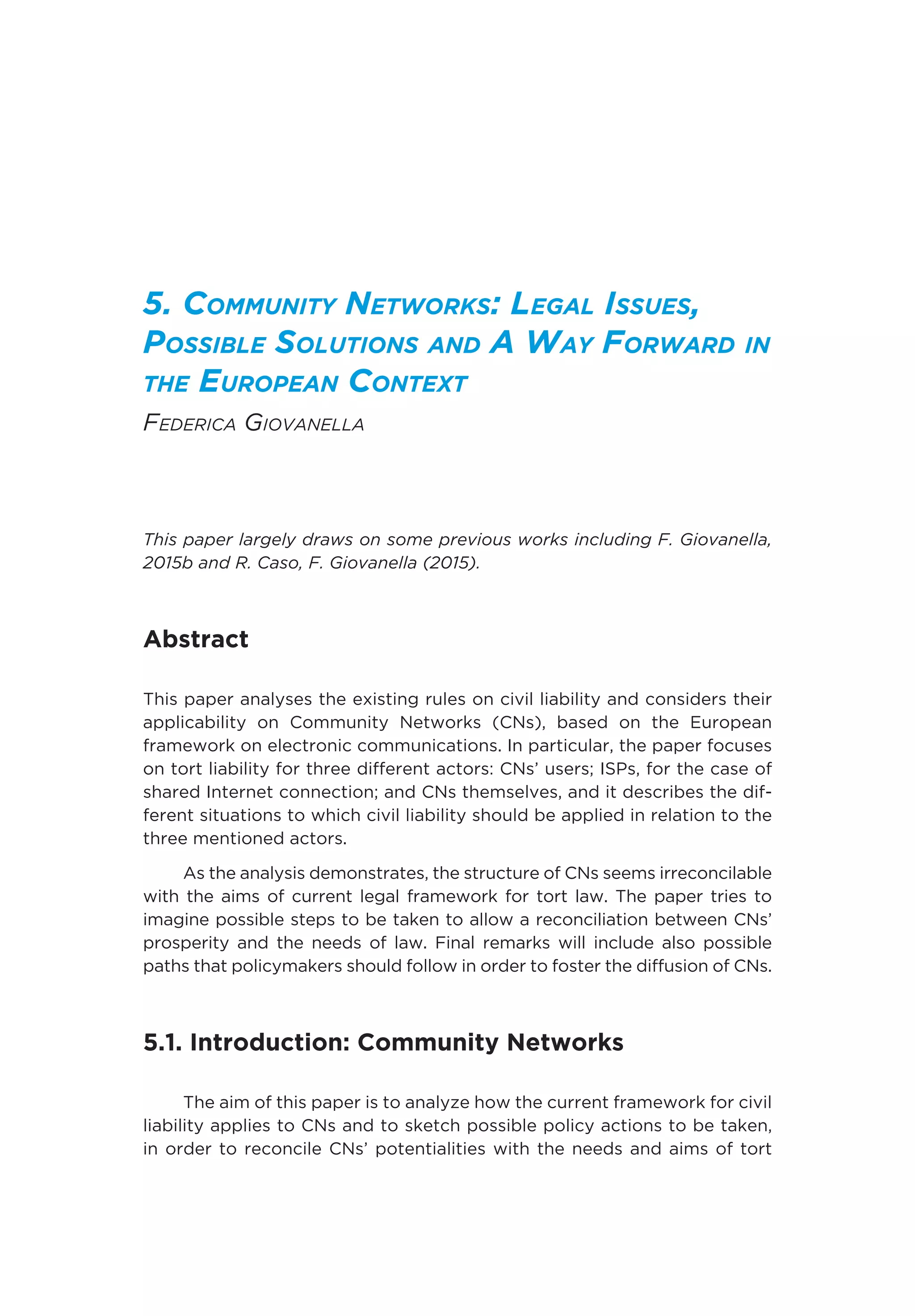
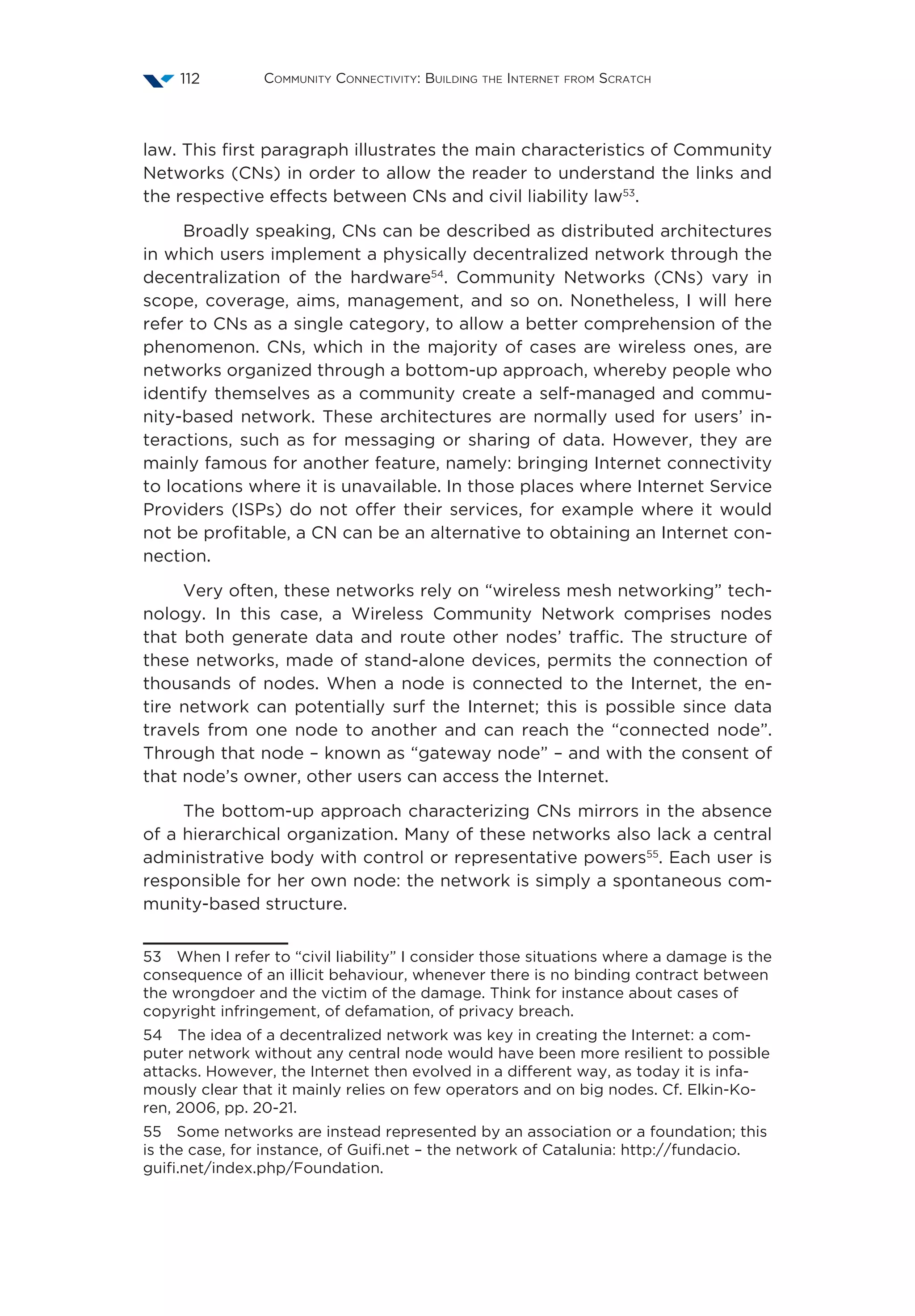
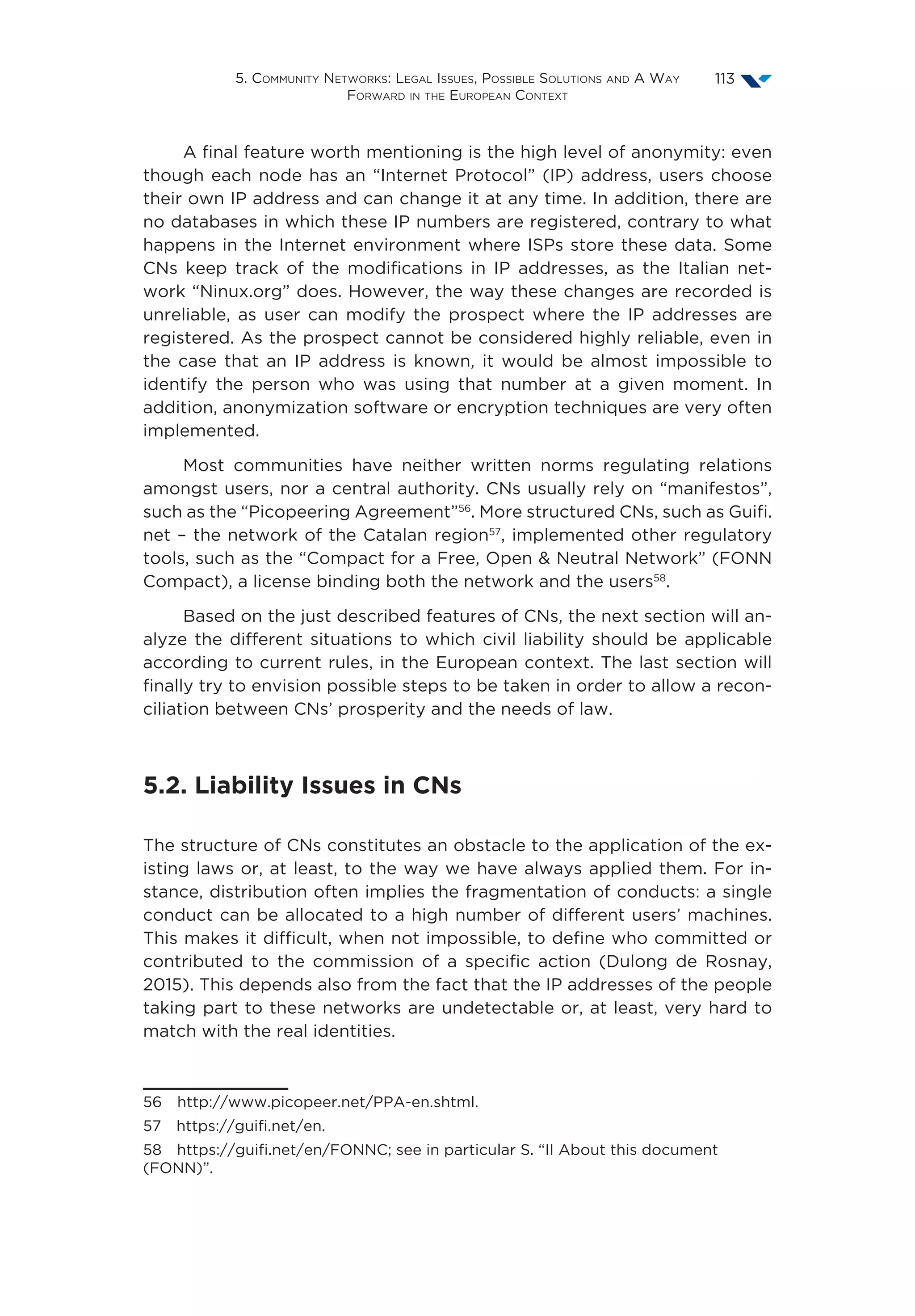
![Community Connectivity: Building the Internet from Scratch114
As above mentioned, this paper concentrates only on civil liability
matters, which will be briefly explained in this section. Following CNs’ de-
scription, three different cases can be envisioned, each involving a differ-
ent subject: the user, the ISP, the network (Giovanella, 2015, pp. 52-63).
A user could be held liable for her own conduct or, if routing another
user’s information, be considered jointly or indirectly liable for the action
of the other user. In this case, ordinary rules of civil liability of each Euro-
pean state would apply, such as art 2043 of the Italian civil code, § 823 I
of the German Bürgerliches Gesetzbuch (BGB) or the general “tort of neg-
ligence” or other specific figures of tort law in the English system. In the
second situation, general clauses of civil liability will be applicable along
with those providing for joint and several liability59
. In both cases, to en-
force the infringed right, the first step would be to identify the person be-
hind the screen, i.e. the owner of the node from which the wrongful action
came. However, if we consider what above said on anonymity and IP ad-
dresses, the possibility of identifying the wrongdoer diminishes consider-
ably. As a consequence, there would be no legal protection for the victim.
The classical and most straightforward approach would be to act di-
rectly against the final user; however, from a technological point of view
this solution seems unfeasible.
A partially different case would be one in which the wrongful action
took place through the gateway. In such a case, could the ISP be held liable
for the user’s wrongful behavior? At a European level, Directive 2000/31
on Electronic Commerce and its national transpositions would apply60
.
According to the Directive, if the ISP complies with the specific conduct
required of it by the law, it will not be held liable for a third party’s wrong-
ful action. The Directive subdivides ISPs’ activities into three different cat-
egories: mere conduit (art. 12), caching (art. 13), and hosting (art. 14). The
three activities entail an increasing level of involvement by the intermedi-
ary; this implies, for example, that it is generally more difficult for a hosting
ISP than for a mere conduit ISP to be exempt from liability in relation to a
user’s wrongful behavior.
Articles 13 and 14 of the Directive define “caching” and “hosting” pro-
viders; both are held liable for the activity of storing information (albeit
in different ways) upon the request of a user, and for not removing the
59 See art. 2055 of the Italian civil code; § 830 I of the BGB; the English Civil Lia-
bility (Contribution) Act of 1978, sec 1(1).
60 Directive 2000/31/EC of the European Parliament and of the Council of 8
June 2000 on certain legal aspects of information society services, in particular
electronic commerce, in the Internal Market [2000] Official Journal (OJ) L 178,
17.7.2000, 1–16. About ISPs’ liability see: Julià-Barceló and Koelman, 2000; Baistroc-
chi, 2002; Verbiest et al., 2007.](https://image.slidesharecdn.com/communityconnectivity-buildingtheinternetfromscratch-170106183237/75/Community-connectivity-building-the-Internet-from-scratch-114-2048.jpg)
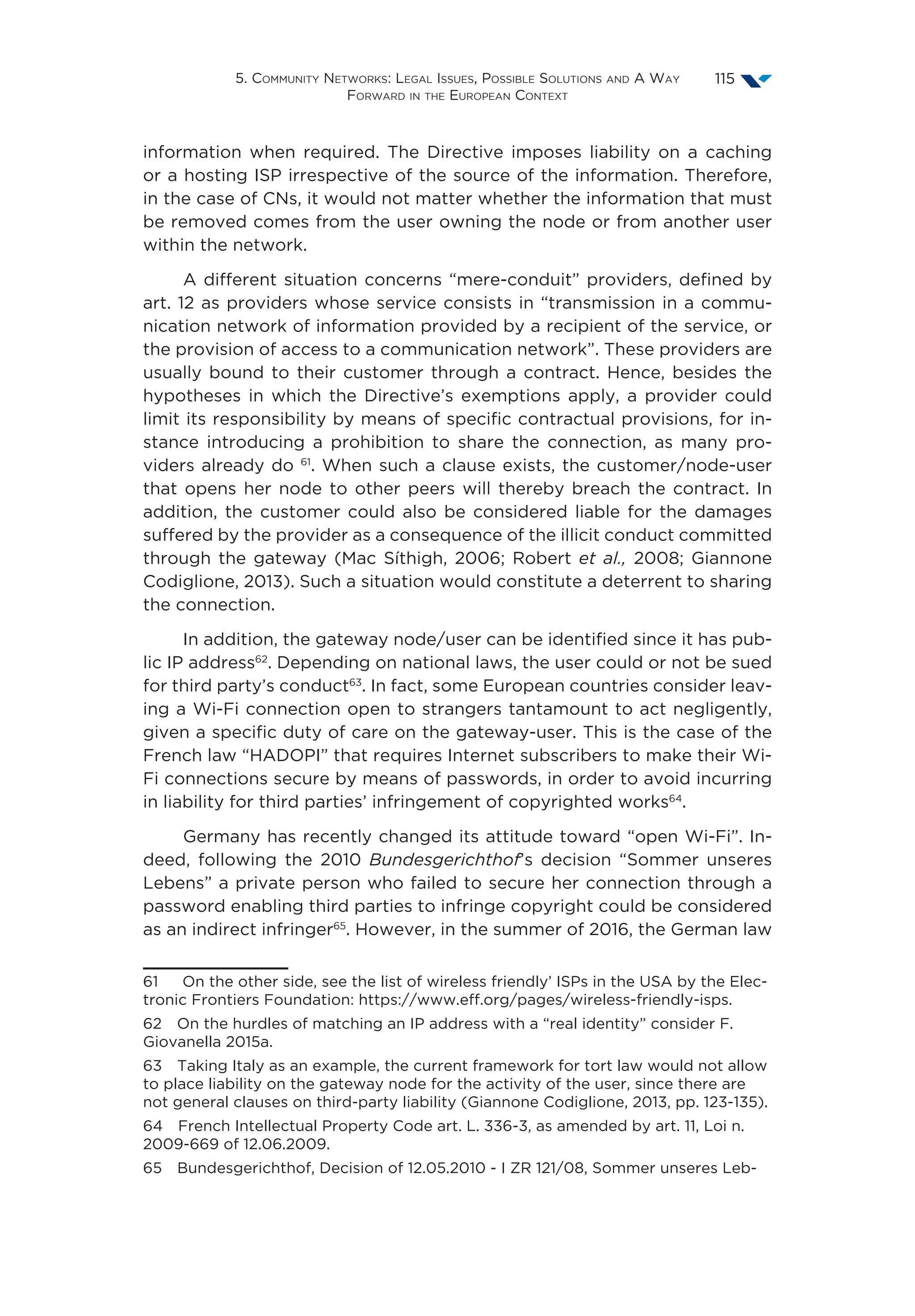
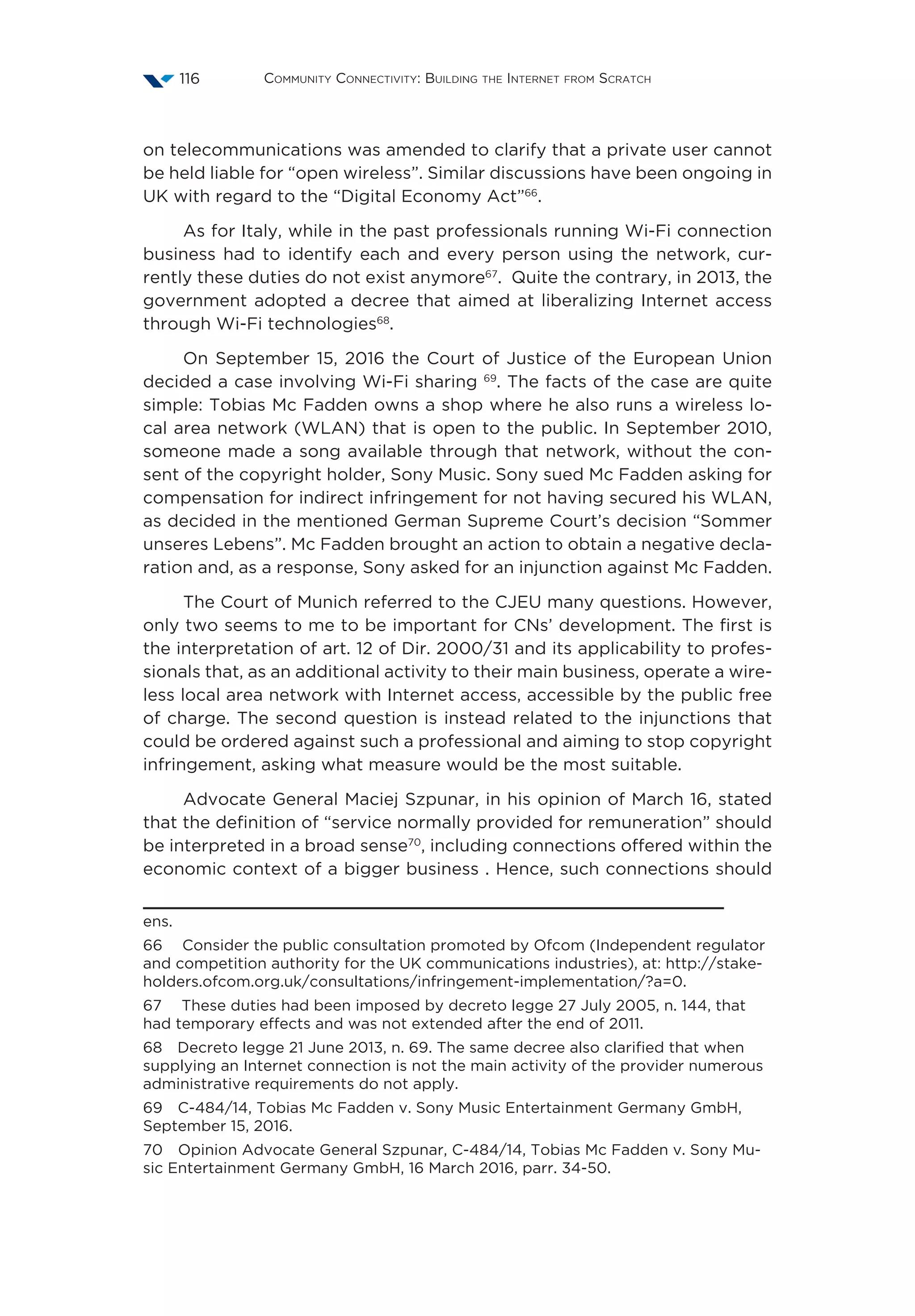
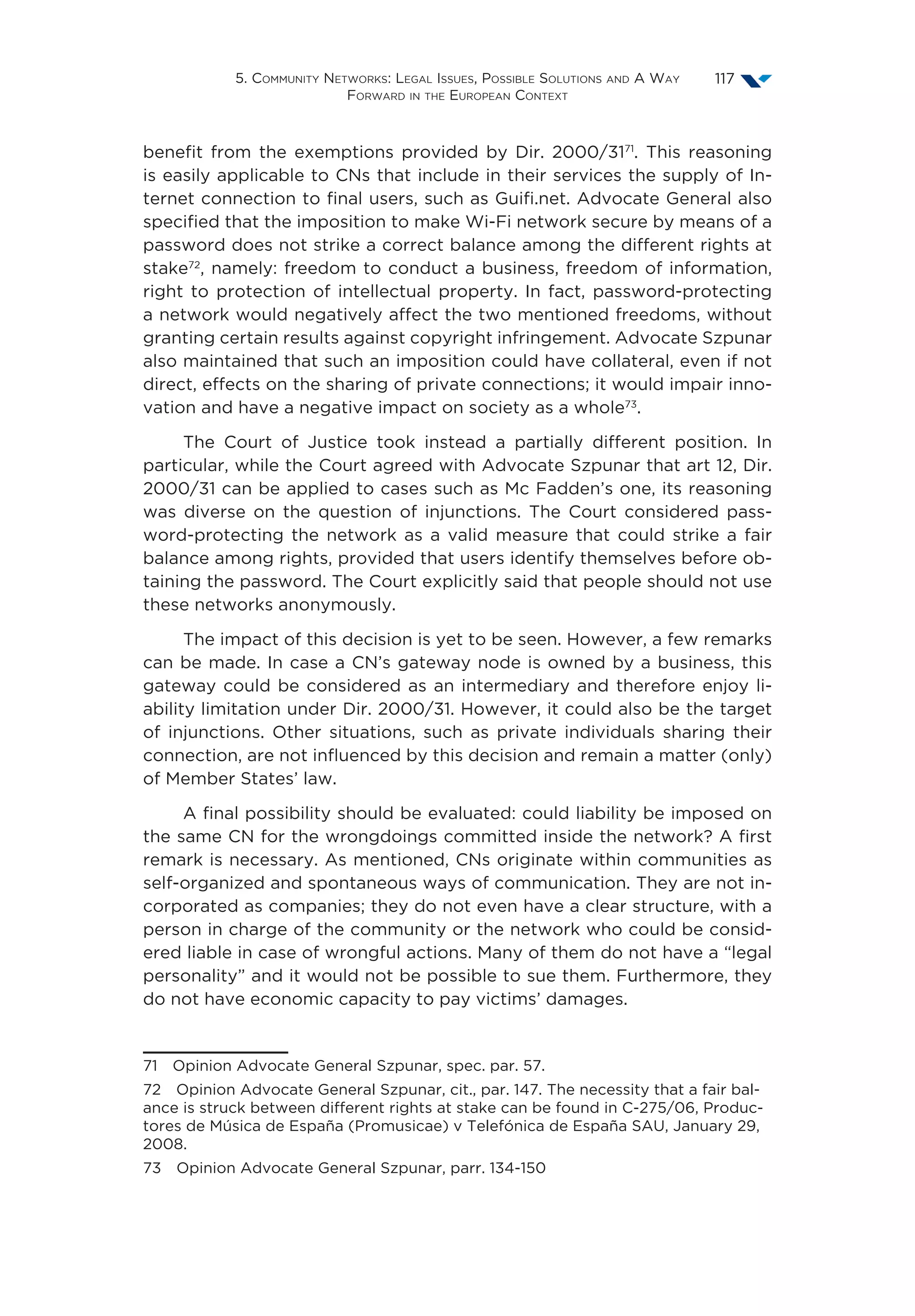
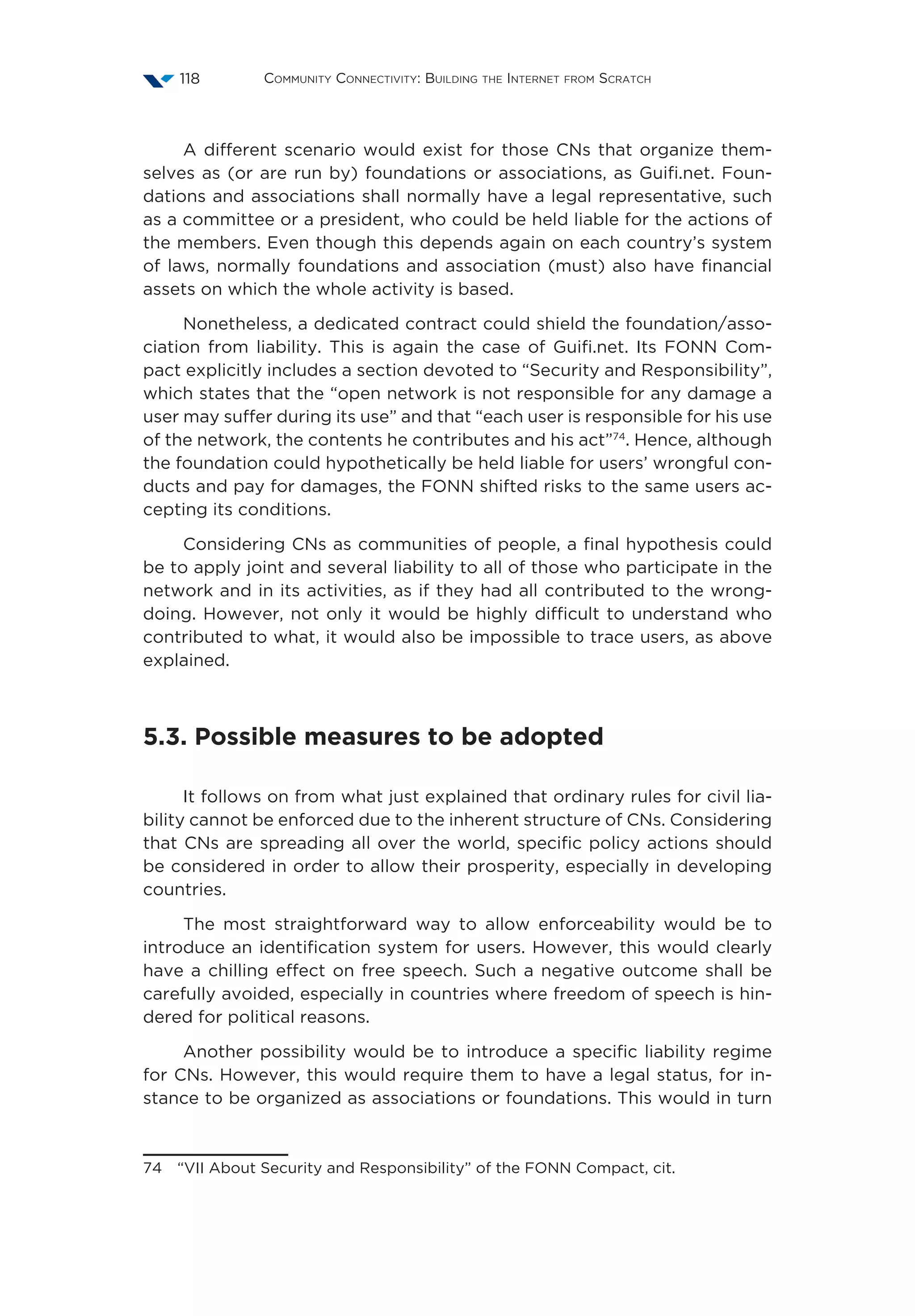
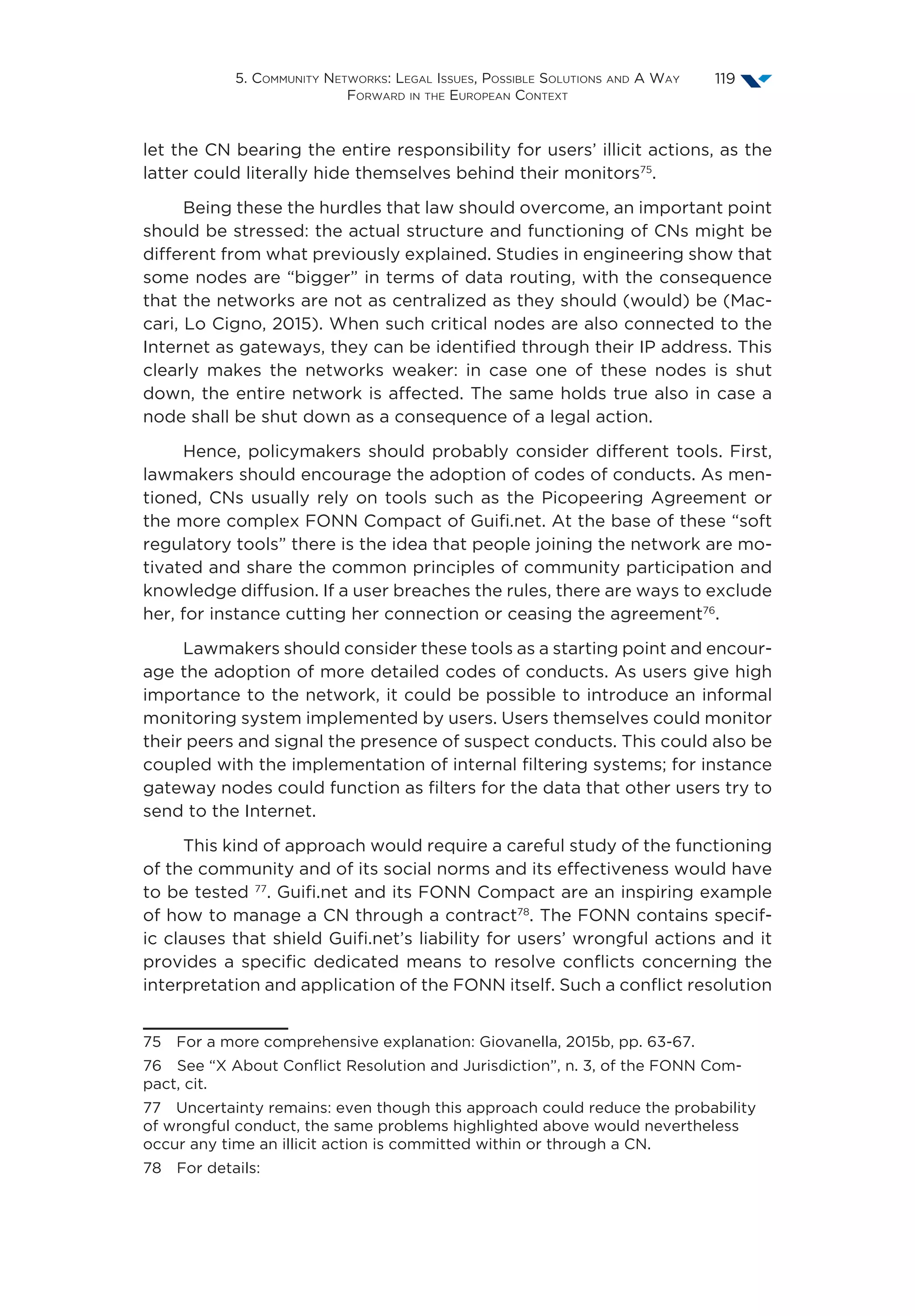
![Community Connectivity: Building the Internet from Scratch120
system strengthens the FONN and allows its enforceability at an internal
level and not only before national courts79
.
The adoption of a license such as the FONN would in the end need the
community to organize as an association or a foundation, to obtain legal
personality. However, it would be a useful tool to regulate liability issues
for the CN, in order to preserve it without compromising its core, positive
features, especially when the size of the CN is increasing.
Whatever the solution adopted, the main challenge will be balancing
the protection of the network with the protection of individuals’ rights.
This is relevant given that CNs are recognized as representing a remark-
able tool to foster democracy, especially in developing countries, where
these networks are gradually diffusing.
The future might or might not bring cases involving the liability of
CNs. But if there might be cases, it will be necessary to understand how
best to balance these apparently irreconcilable needs for protection.
5.4. Policy Suggestions to Enhance CNs’ Diffusion
A part from the questions related to liability, policymakers should start
considering the adoption of regulations that could foster CNs. More pre-
cisely, lawmakers should implement specific laws and exceptions thought
for CNs, in order to enhance their prosperity.
Let us consider two examples. The first is related to the so called
“Radio equipment Directive” of 201480
. The Directive harmonizes existing
regulations on radio equipment with the aim of improving security and
protecting health and safety. According to Recital 16, “[t]he compliance
of some categories of radio equipment with the essential requirements set
out in this Directive may be affected by the inclusion of software or mod-
ification of its existing software. The user, the radio equipment or a third
party should only be able to load software into the radio equipment where
this does not compromise the subsequent compliance of that radio equip-
ment with the applicable essential requirements”. The text of the Directive
has been read as a threat to free software and, in turn, as a threat to proj-
ects like CNs81
. In fact, CNs usually rely on hardware (routers) run through
79 See “X About Conflict Resolution and Jurisdiction” of the FONN Compact, cit.
80 Directive 2014/53/EU of the European Parliament and of the Council of 16
April 2014 on the harmonisation of the laws of the Member States relating to the
making available on the market of radio equipment and repealing Directive 1999/5/
EC Text with EEA relevance.
81 See the Free Software Foundation statement: https://fsfe.org/activities/radio-](https://image.slidesharecdn.com/communityconnectivity-buildingtheinternetfromscratch-170106183237/75/Community-connectivity-building-the-Internet-from-scratch-120-2048.jpg)
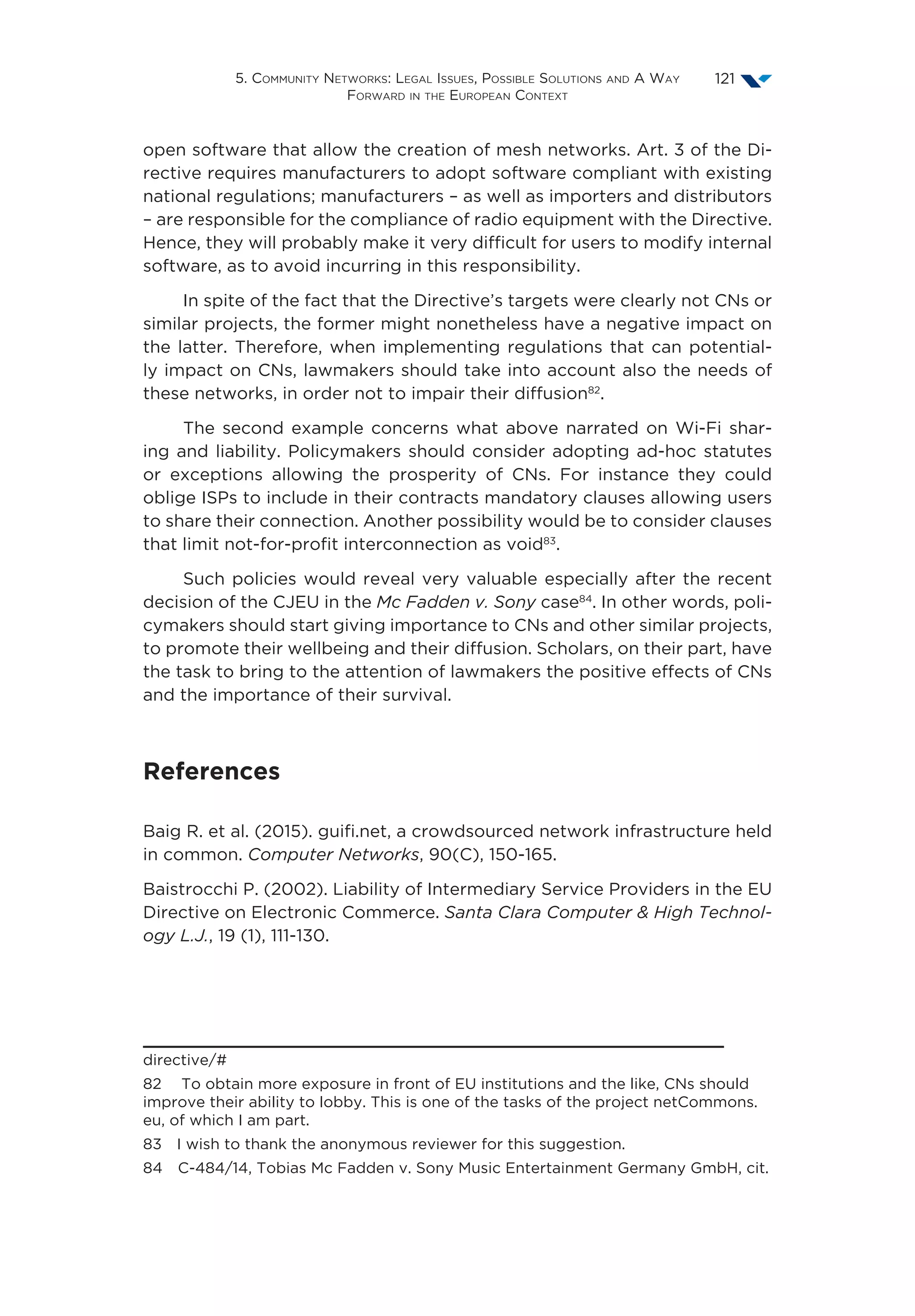
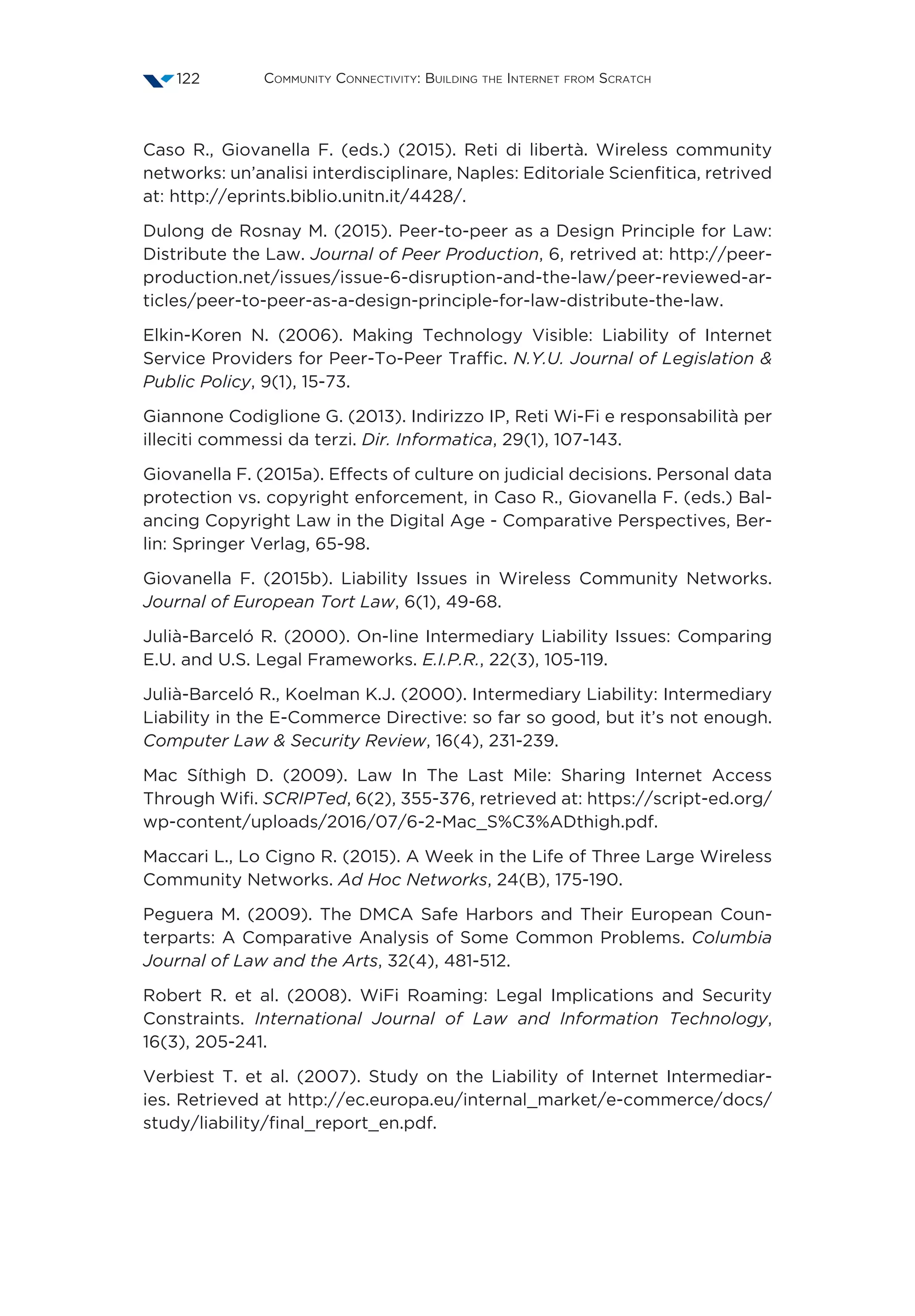
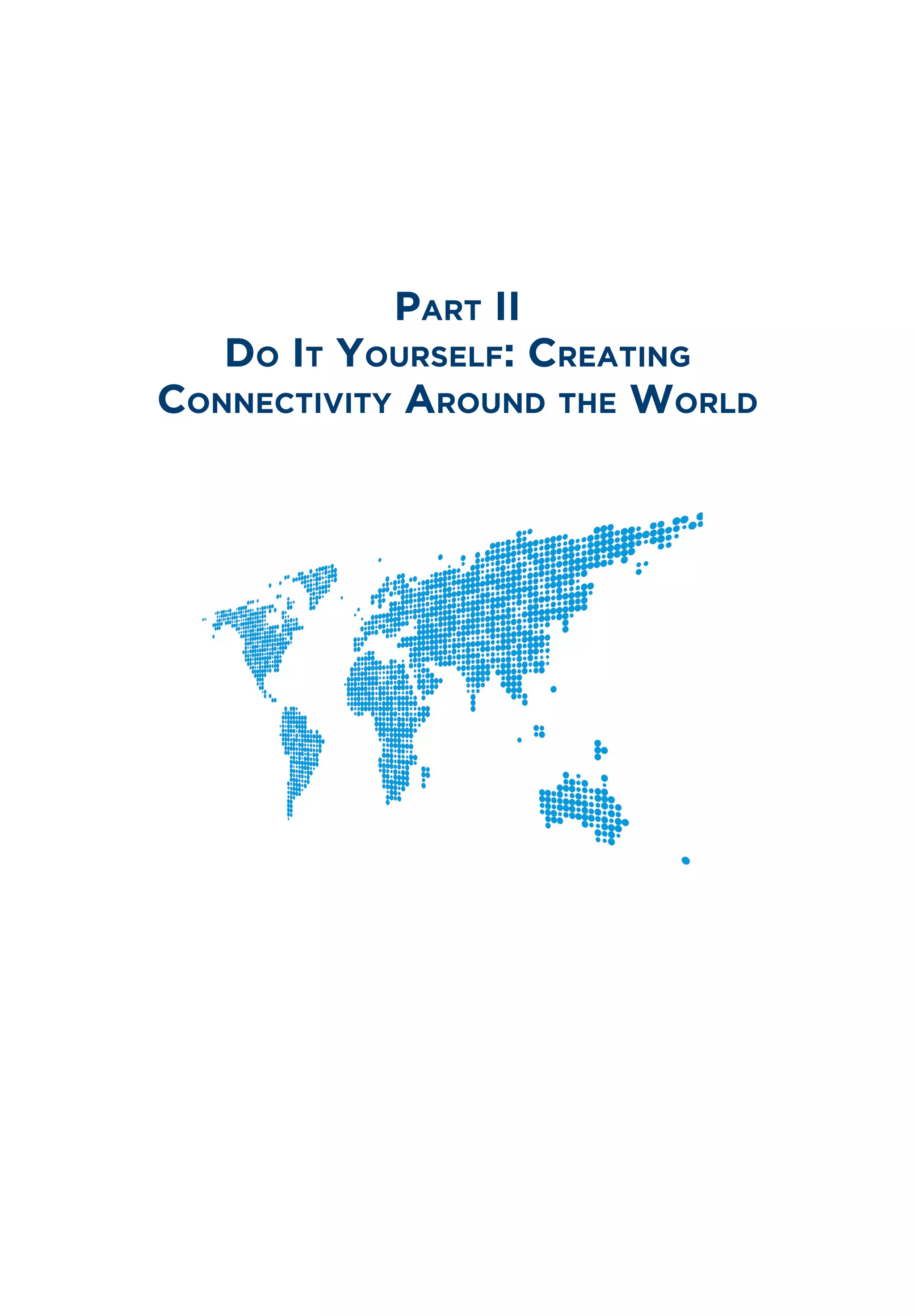

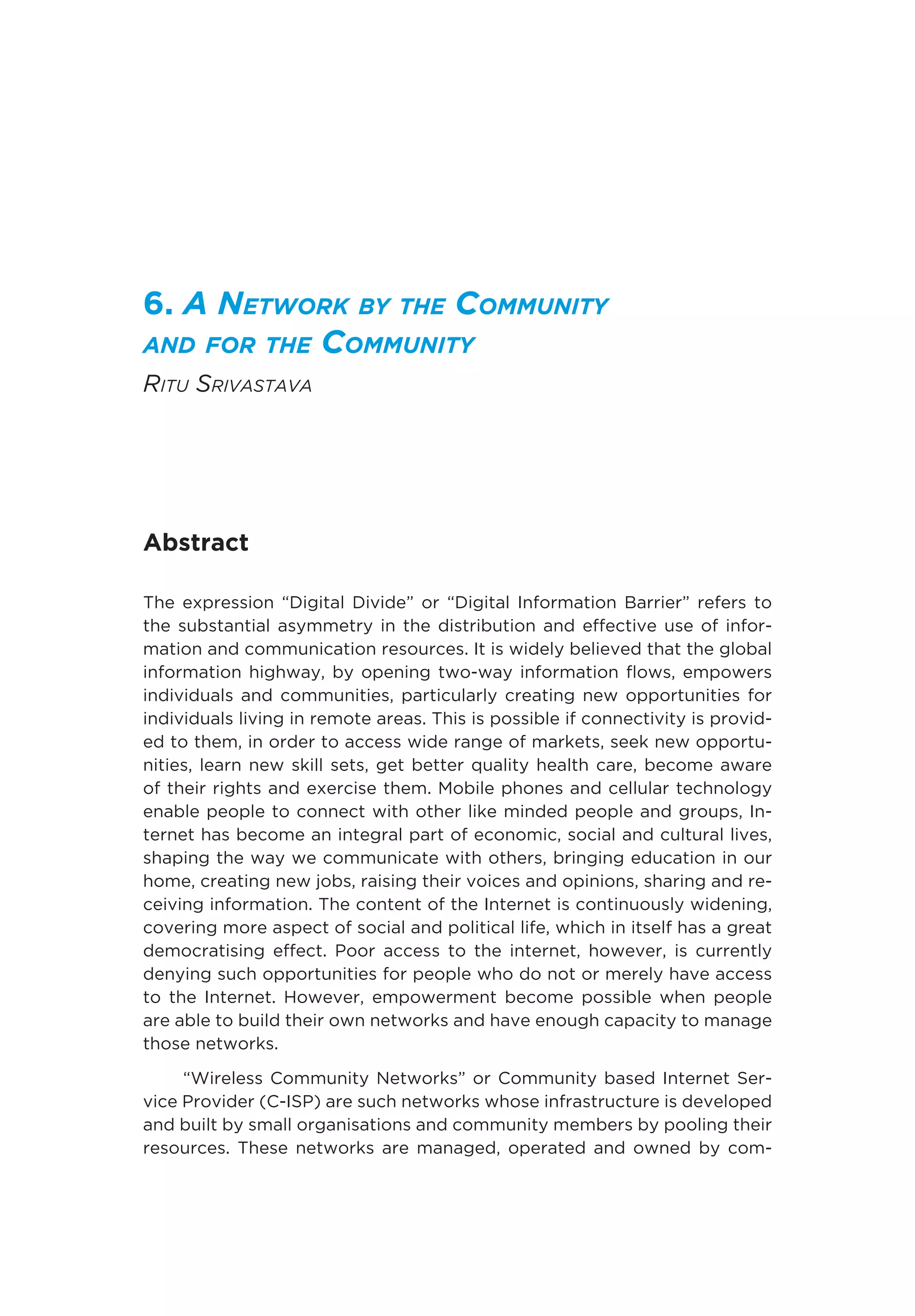
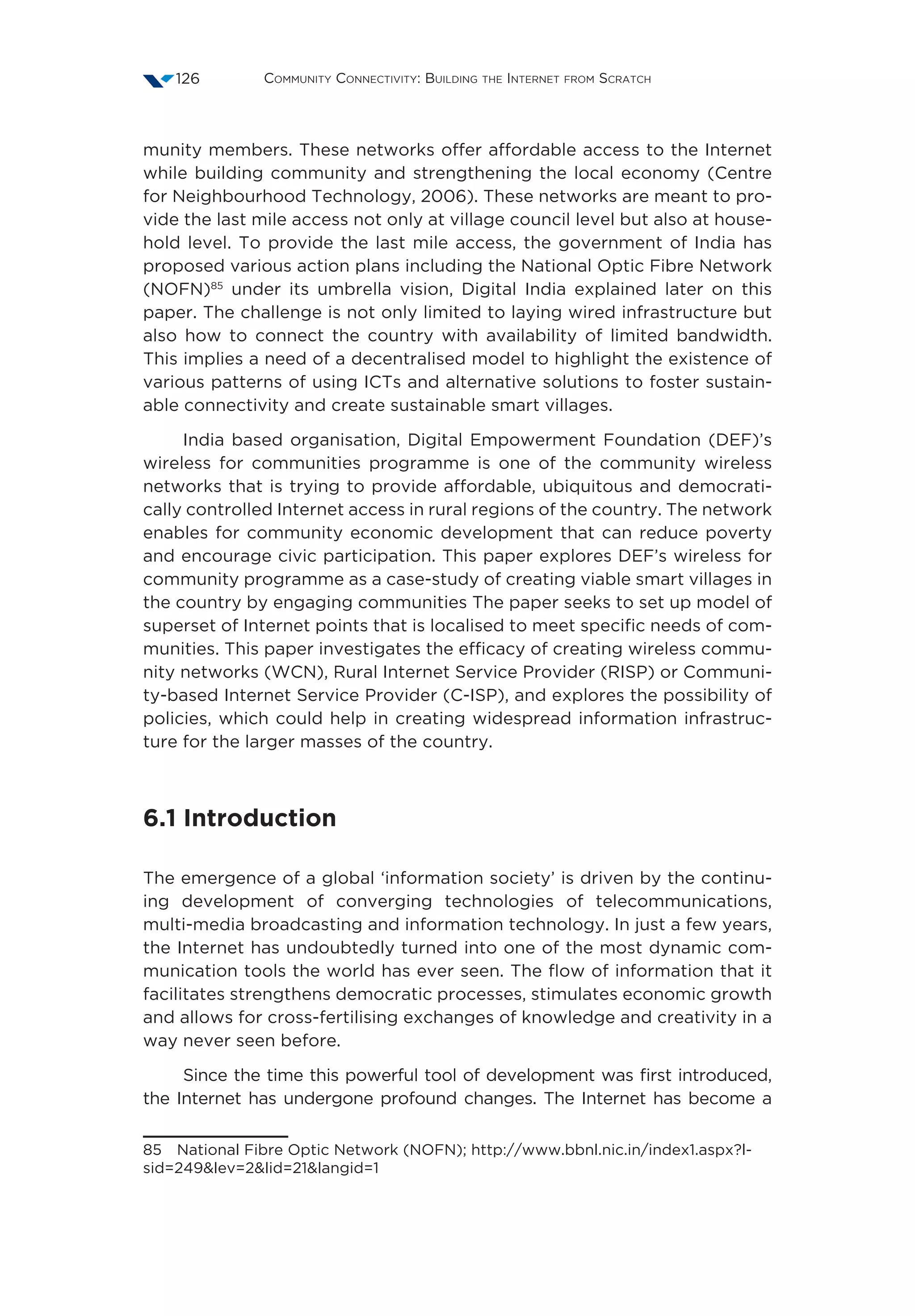
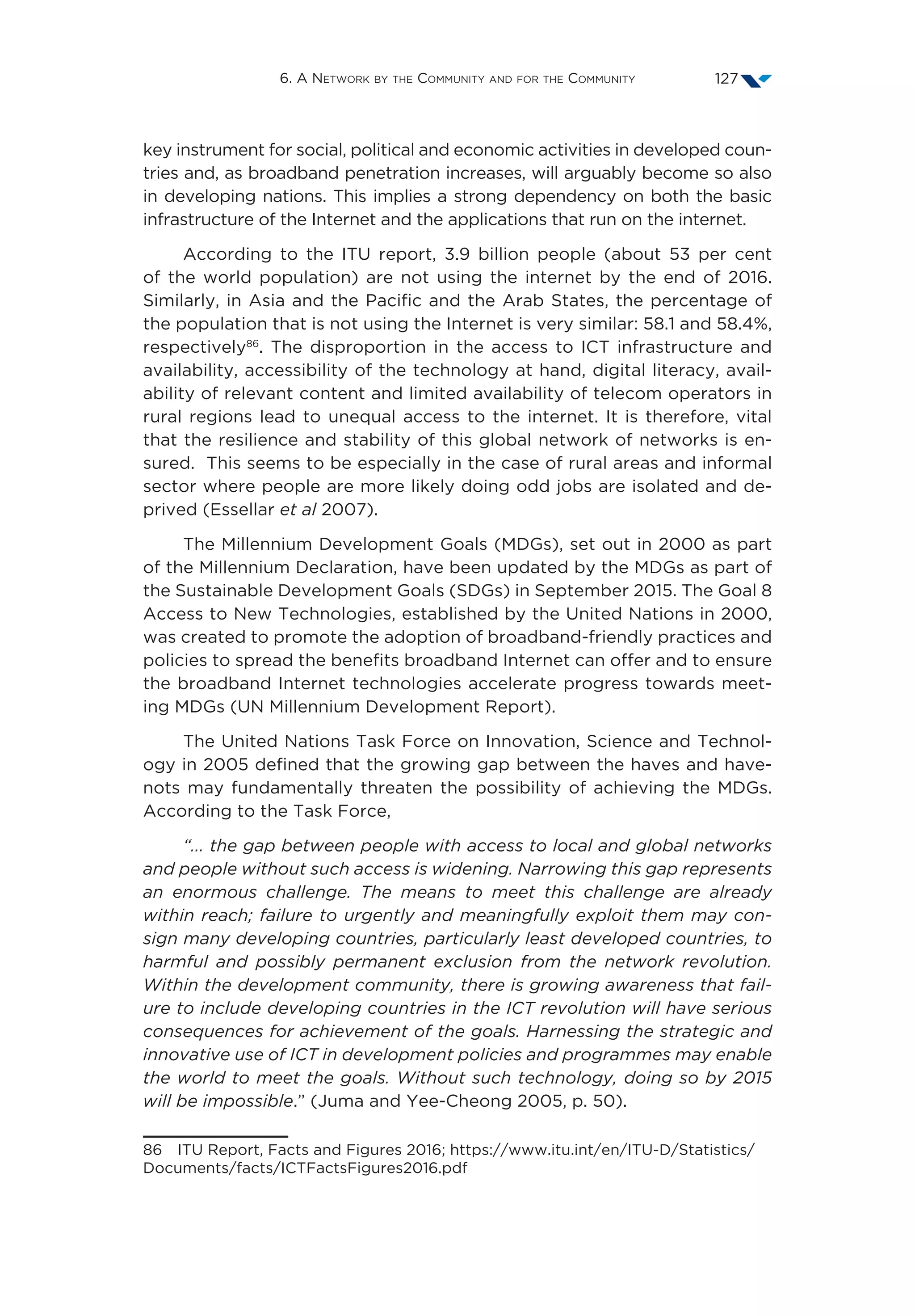
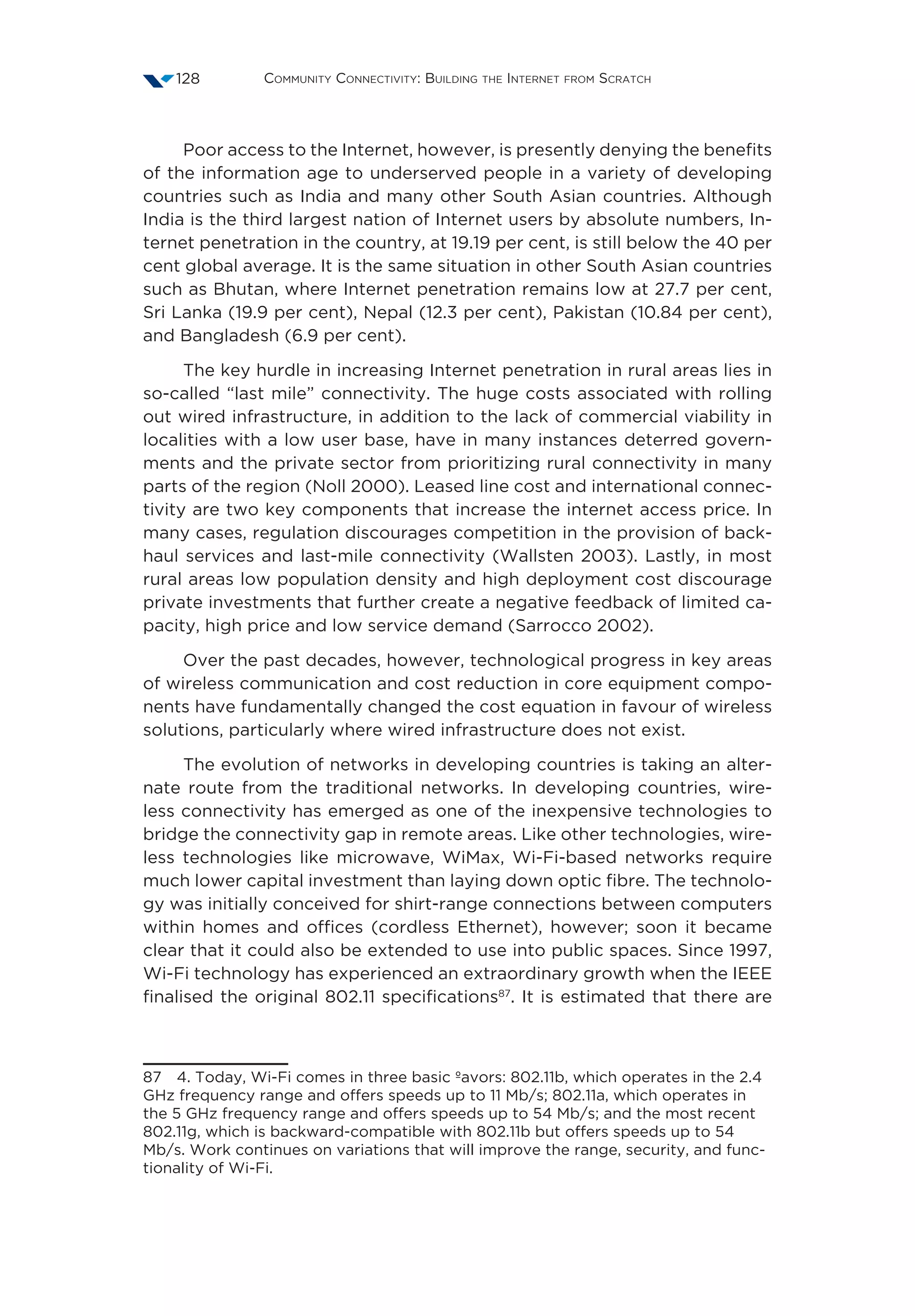
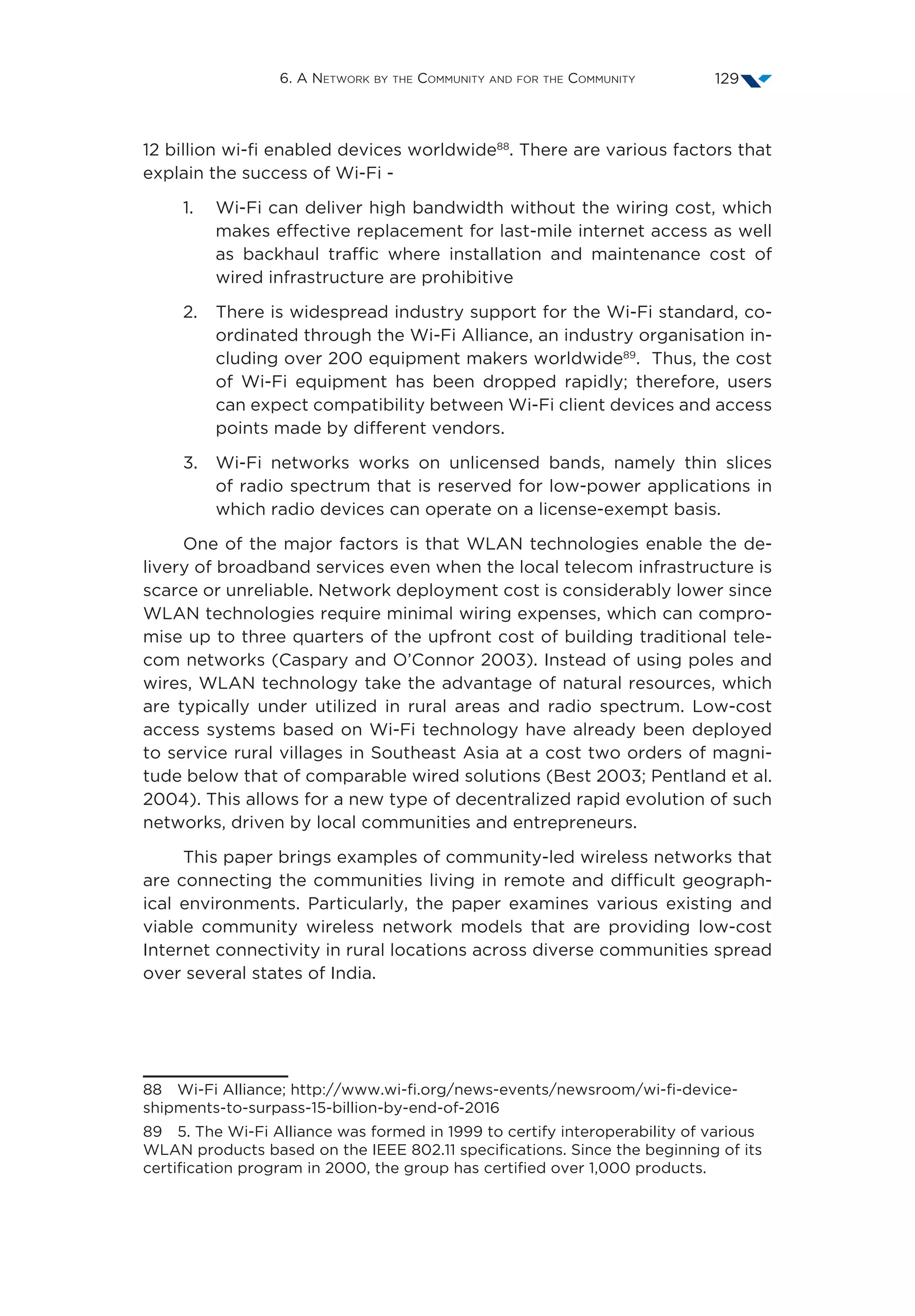

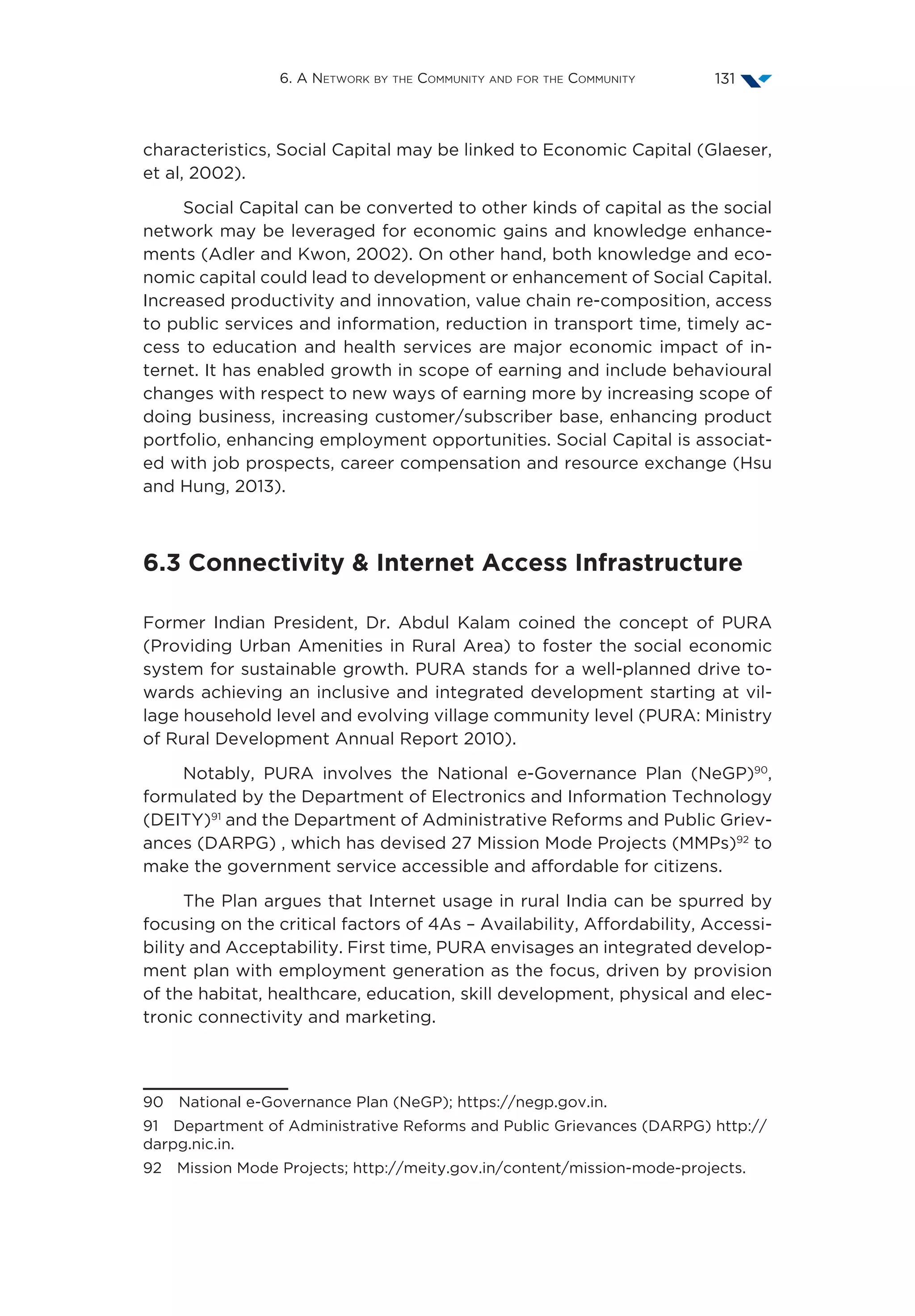
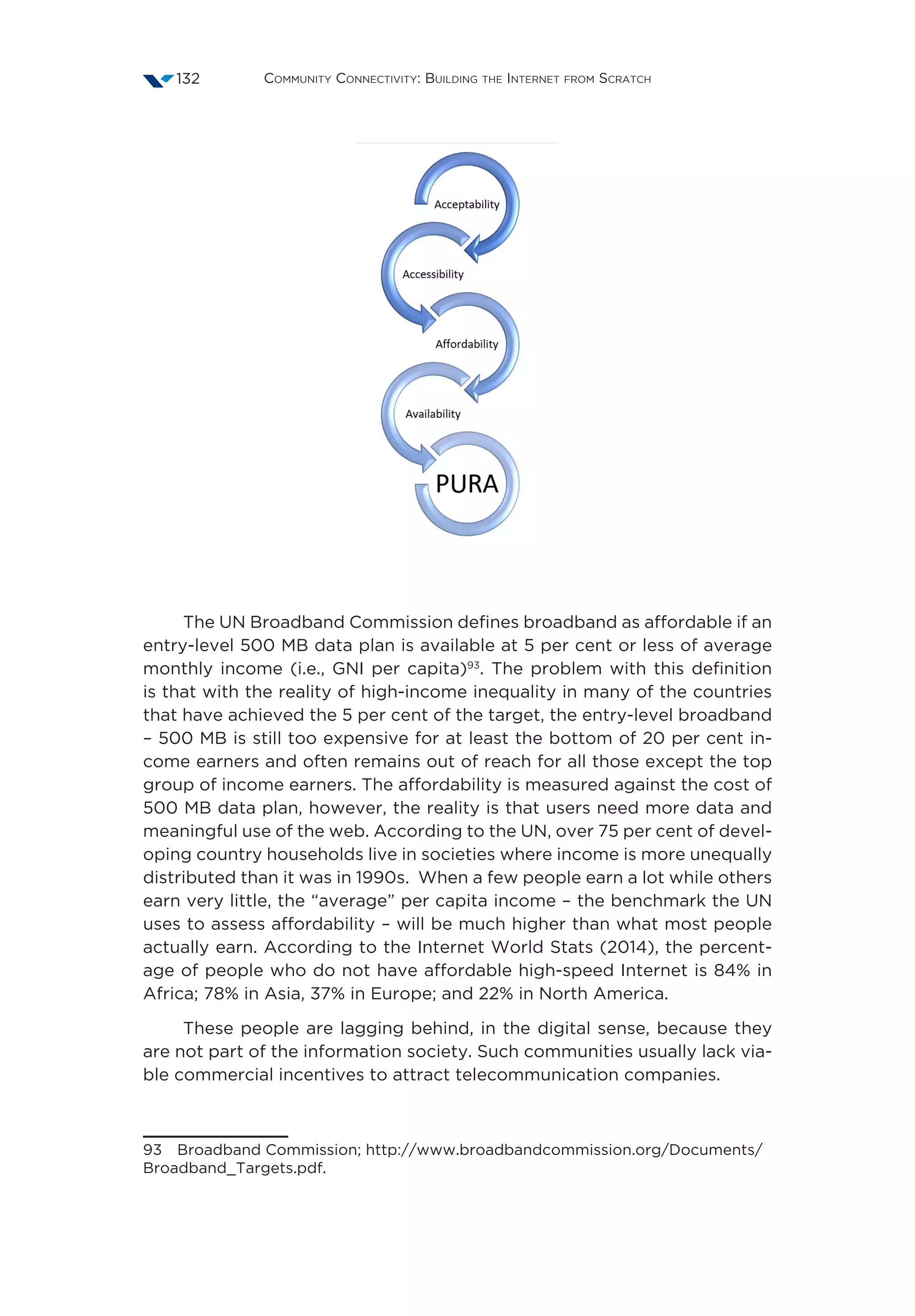
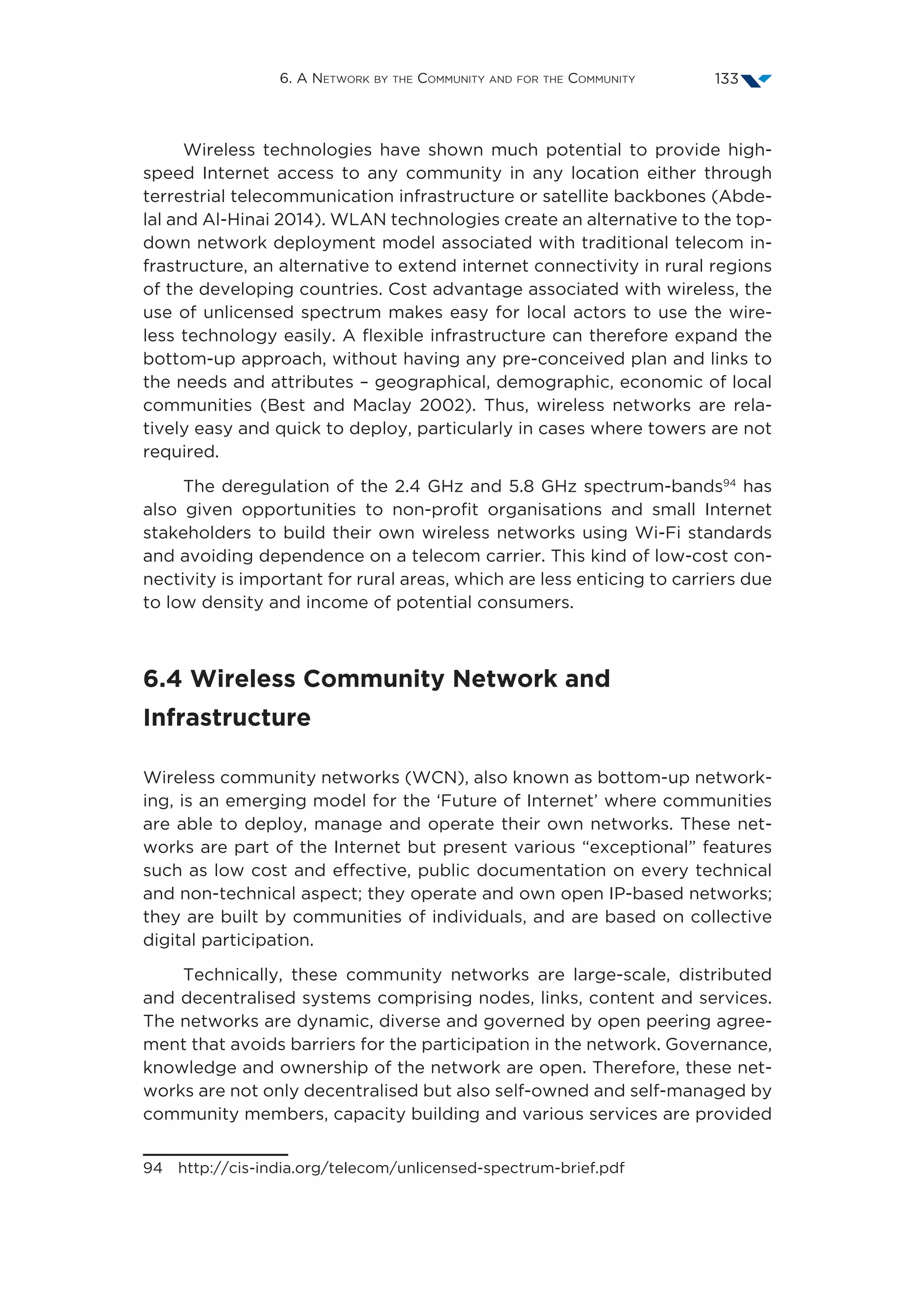
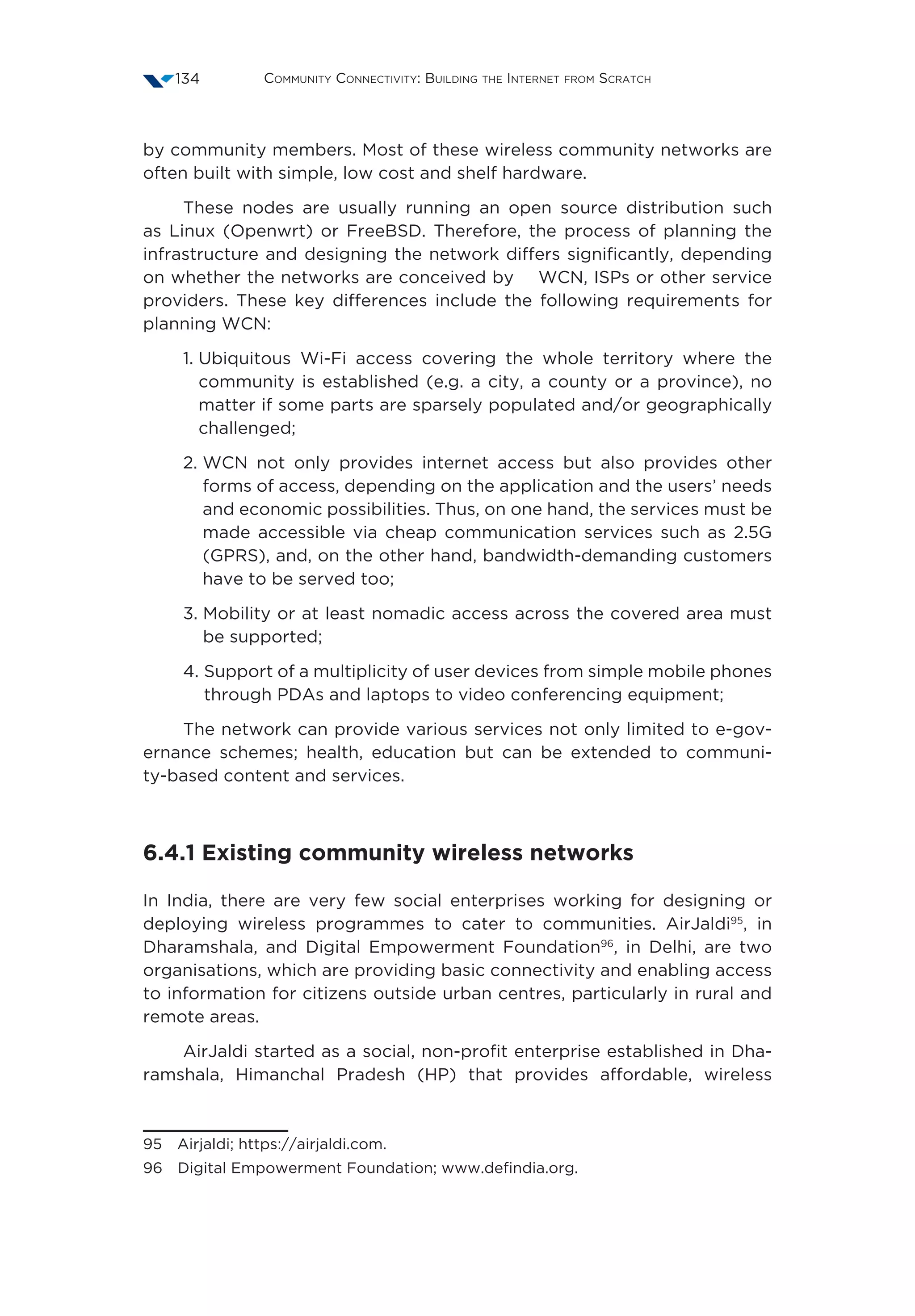
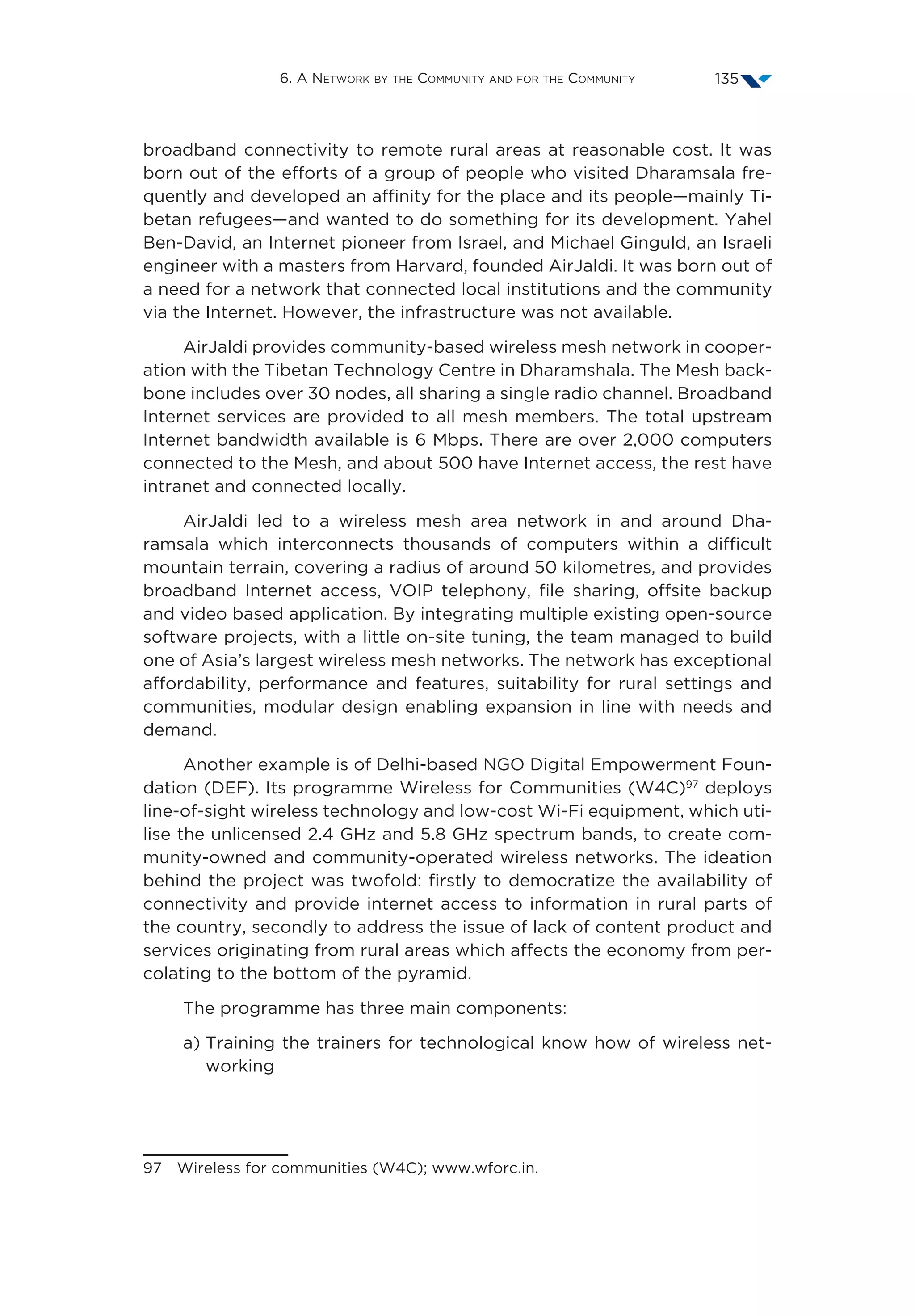
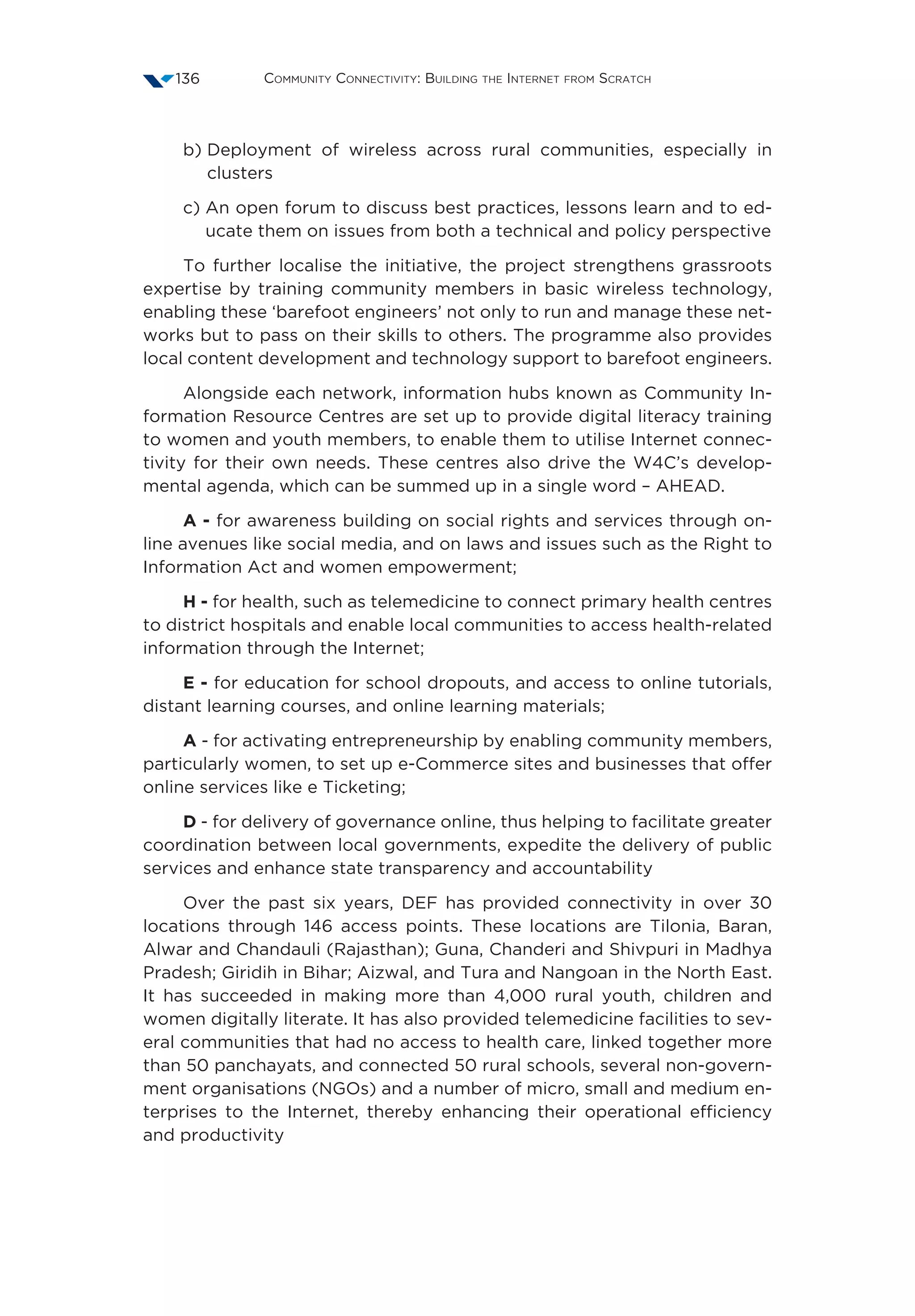
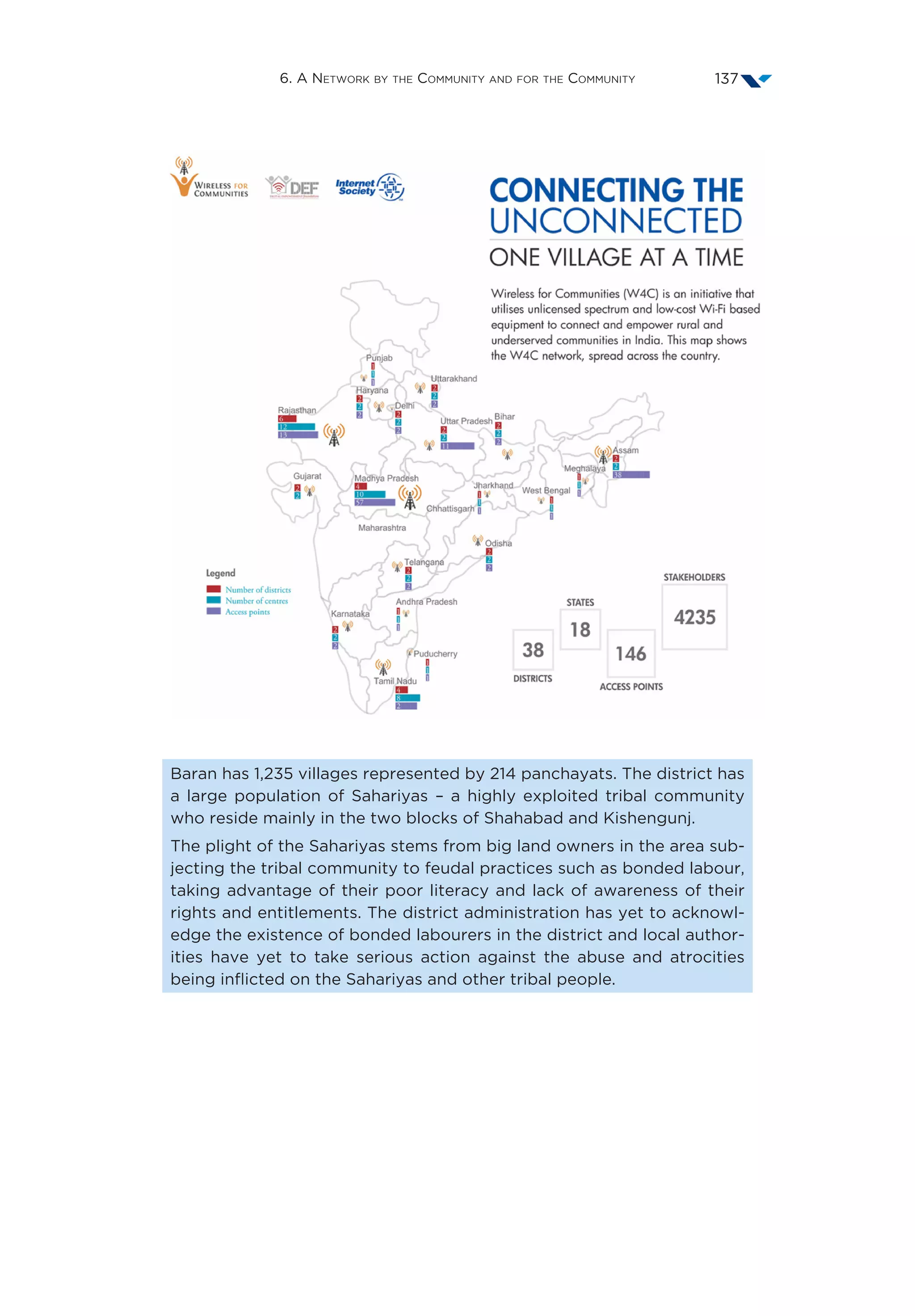
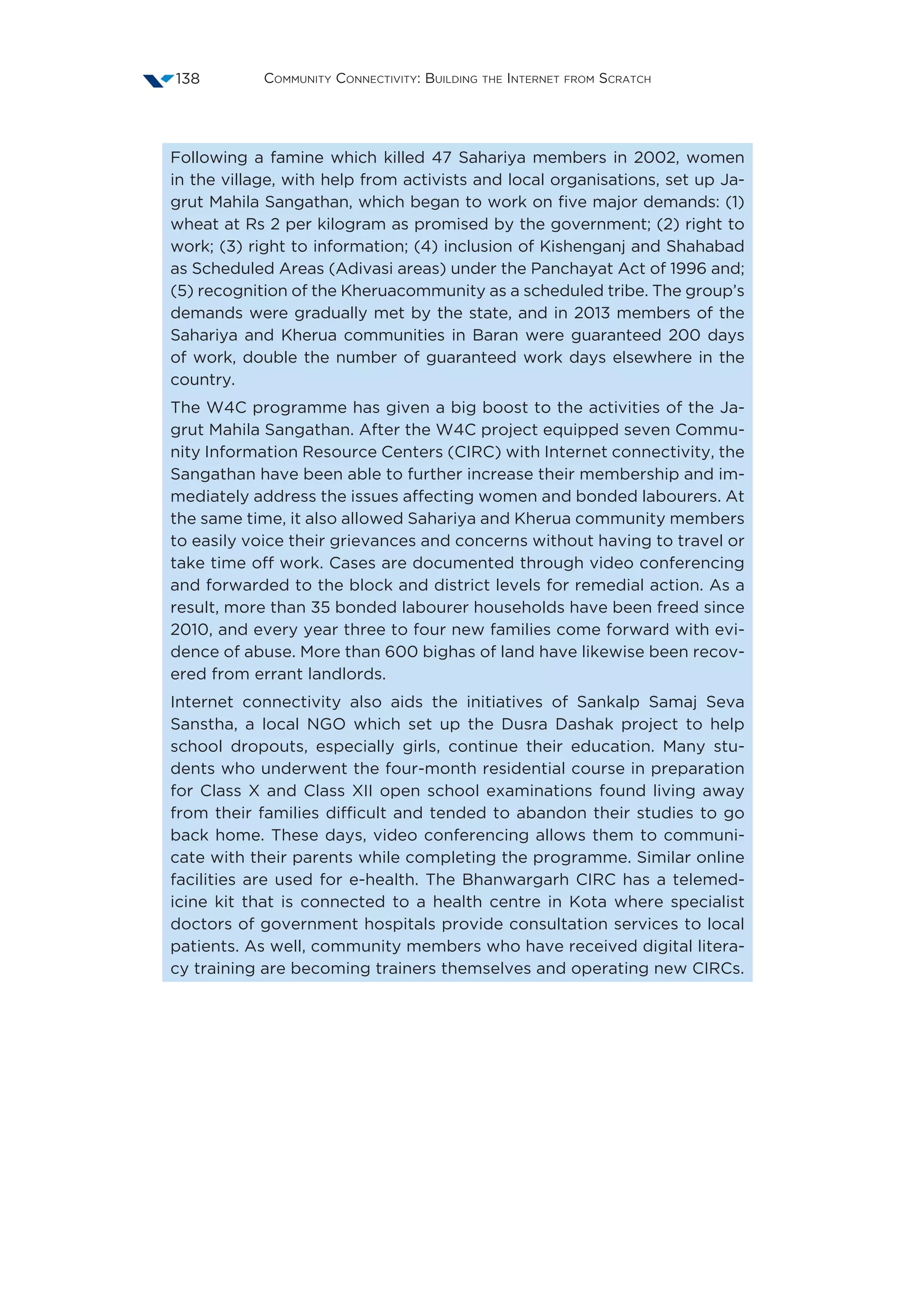
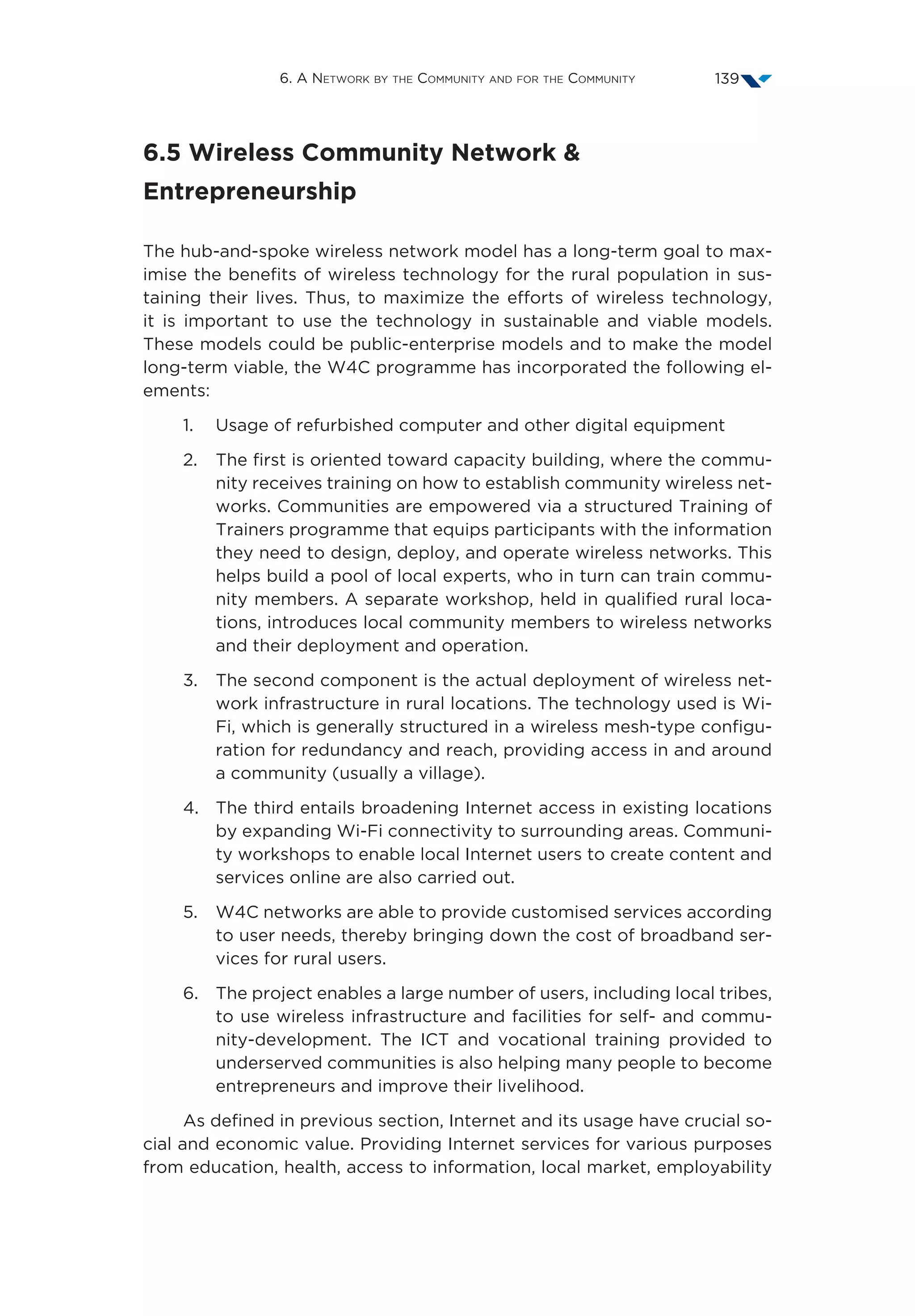
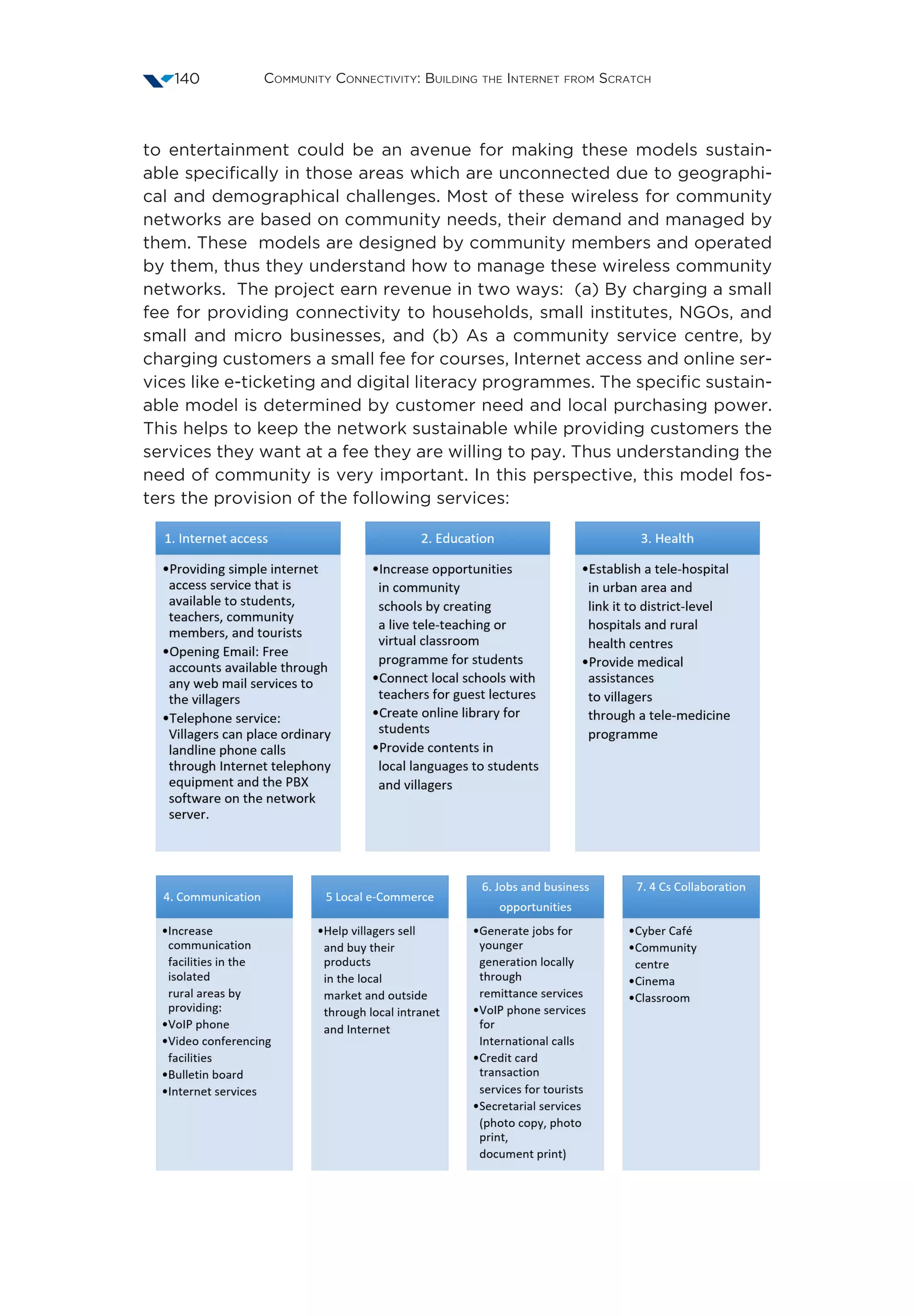
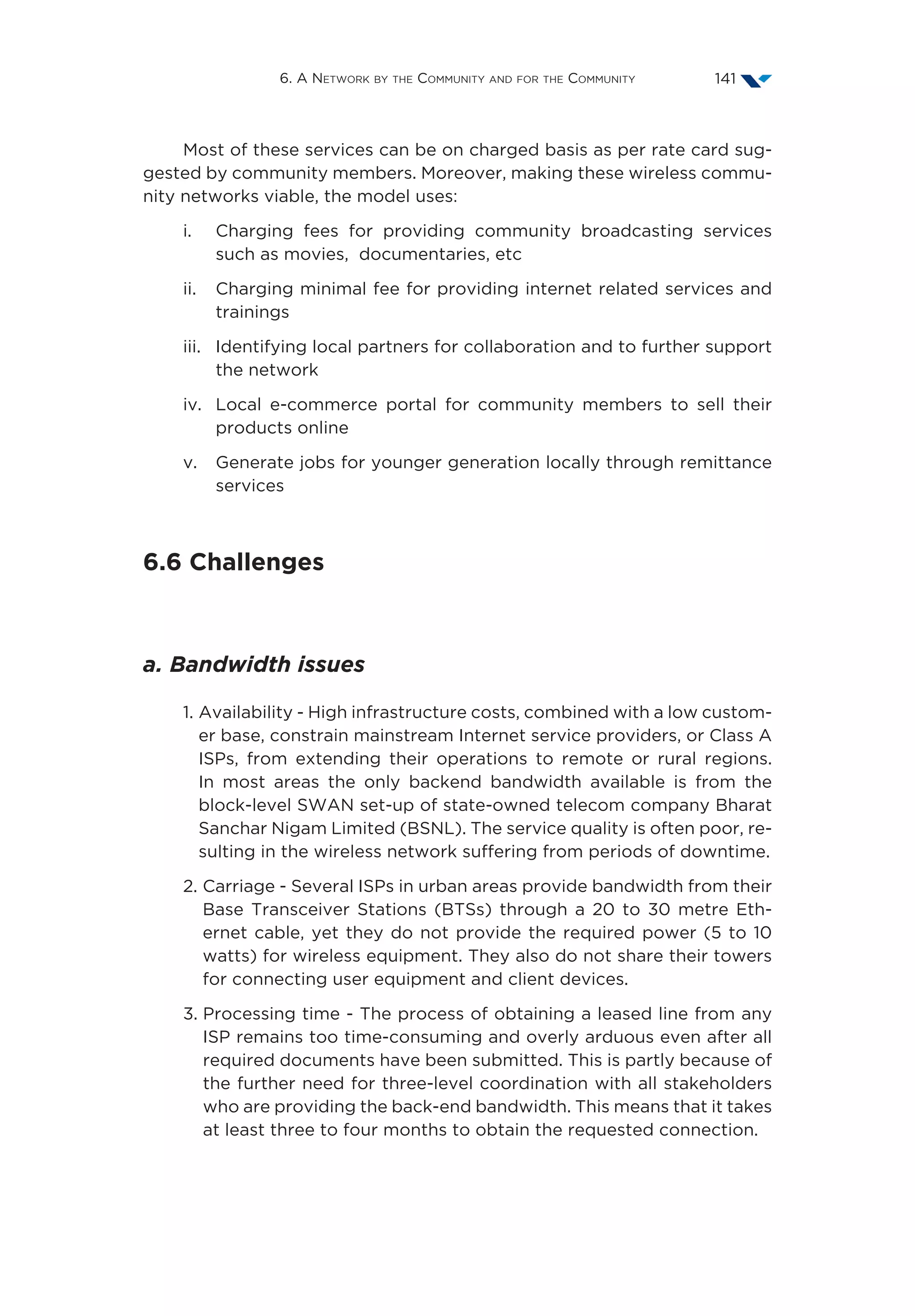

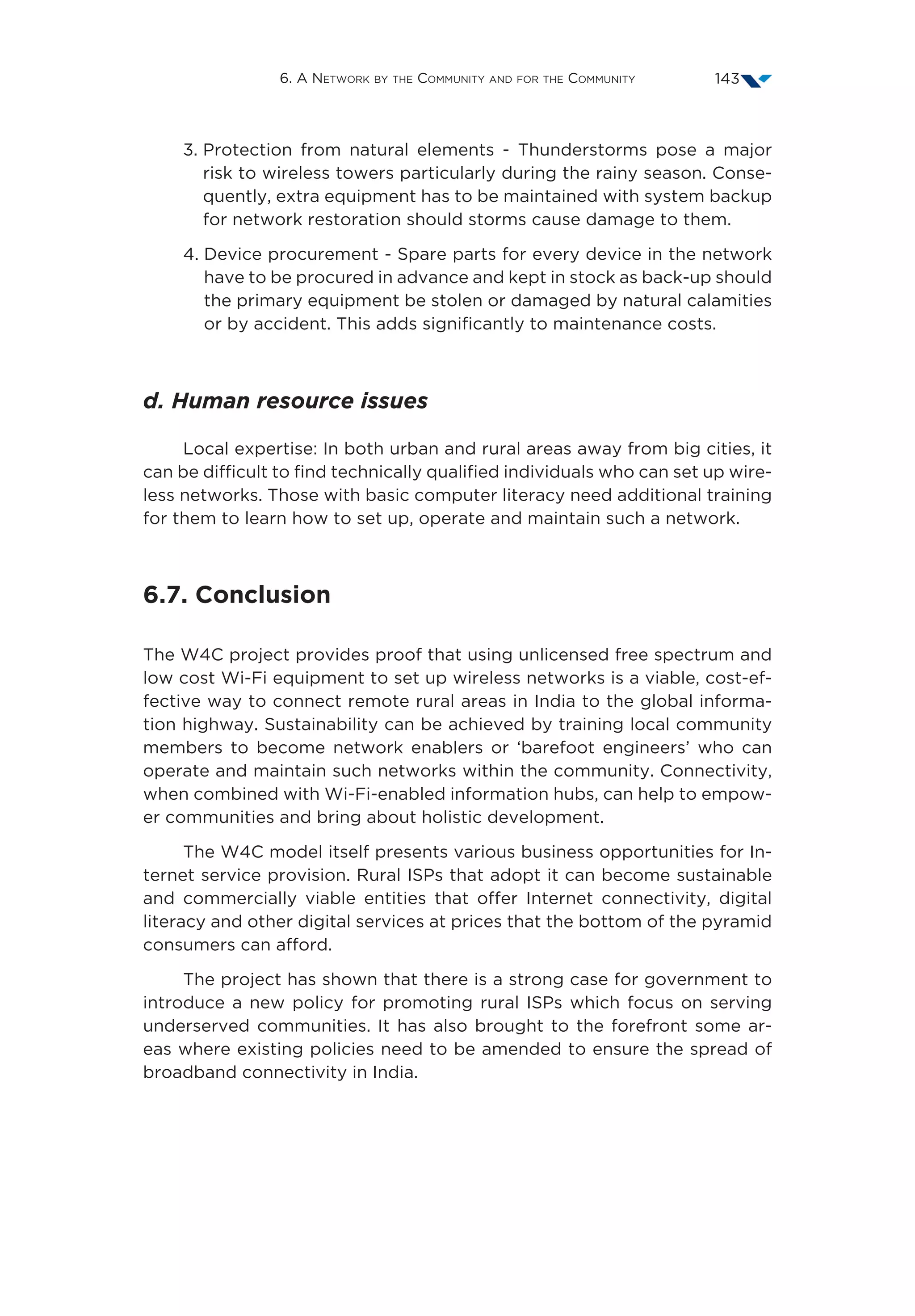
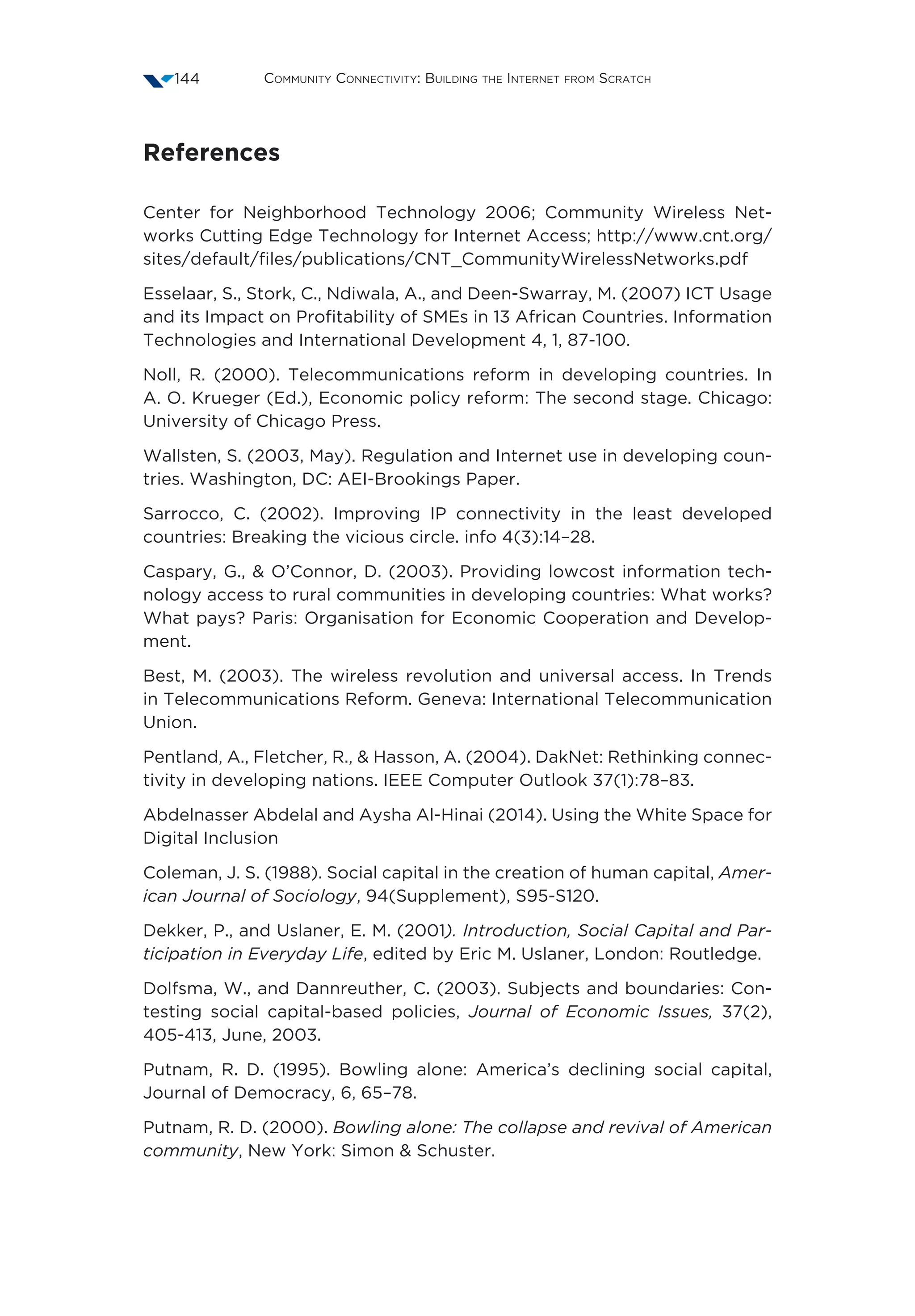
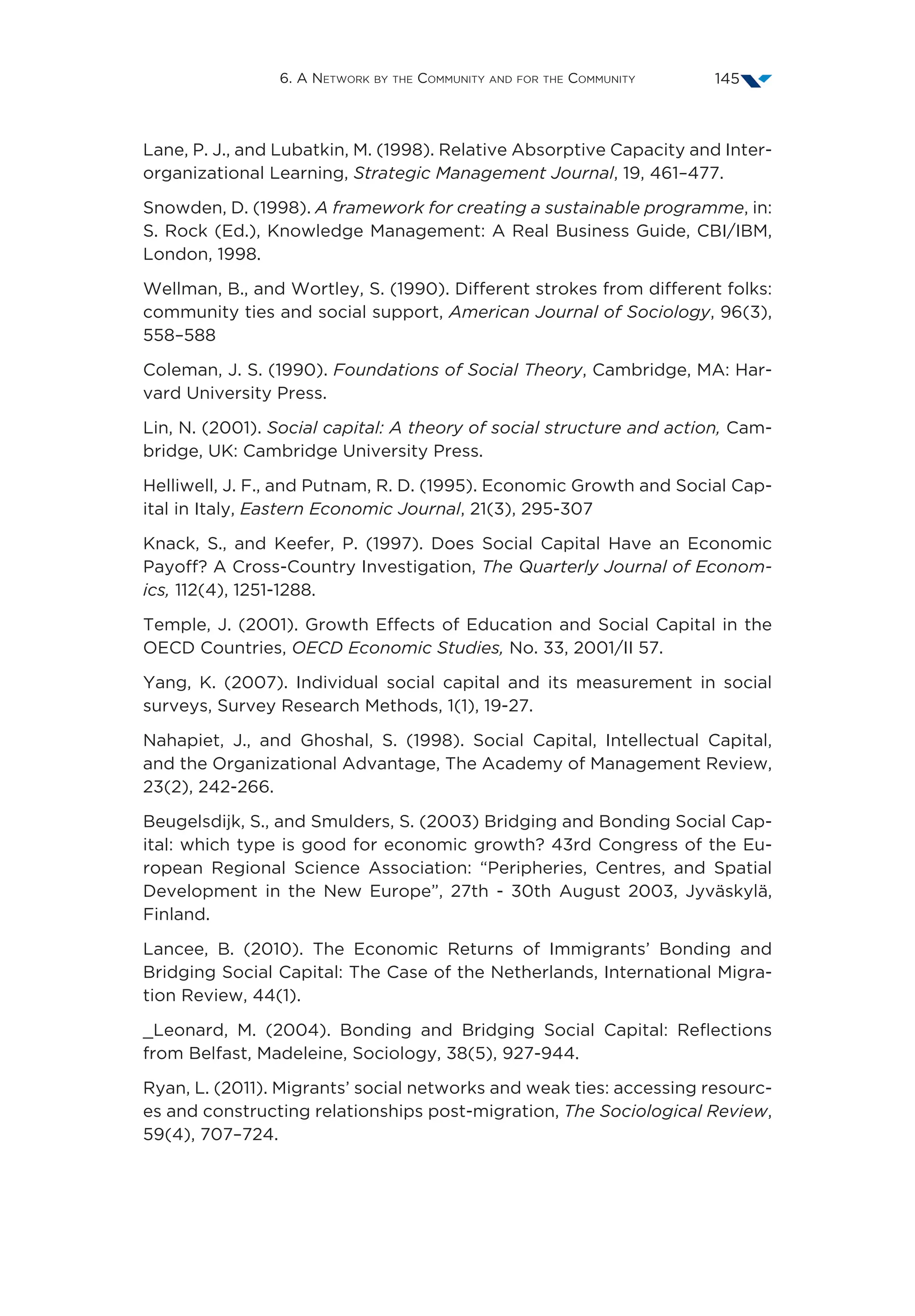
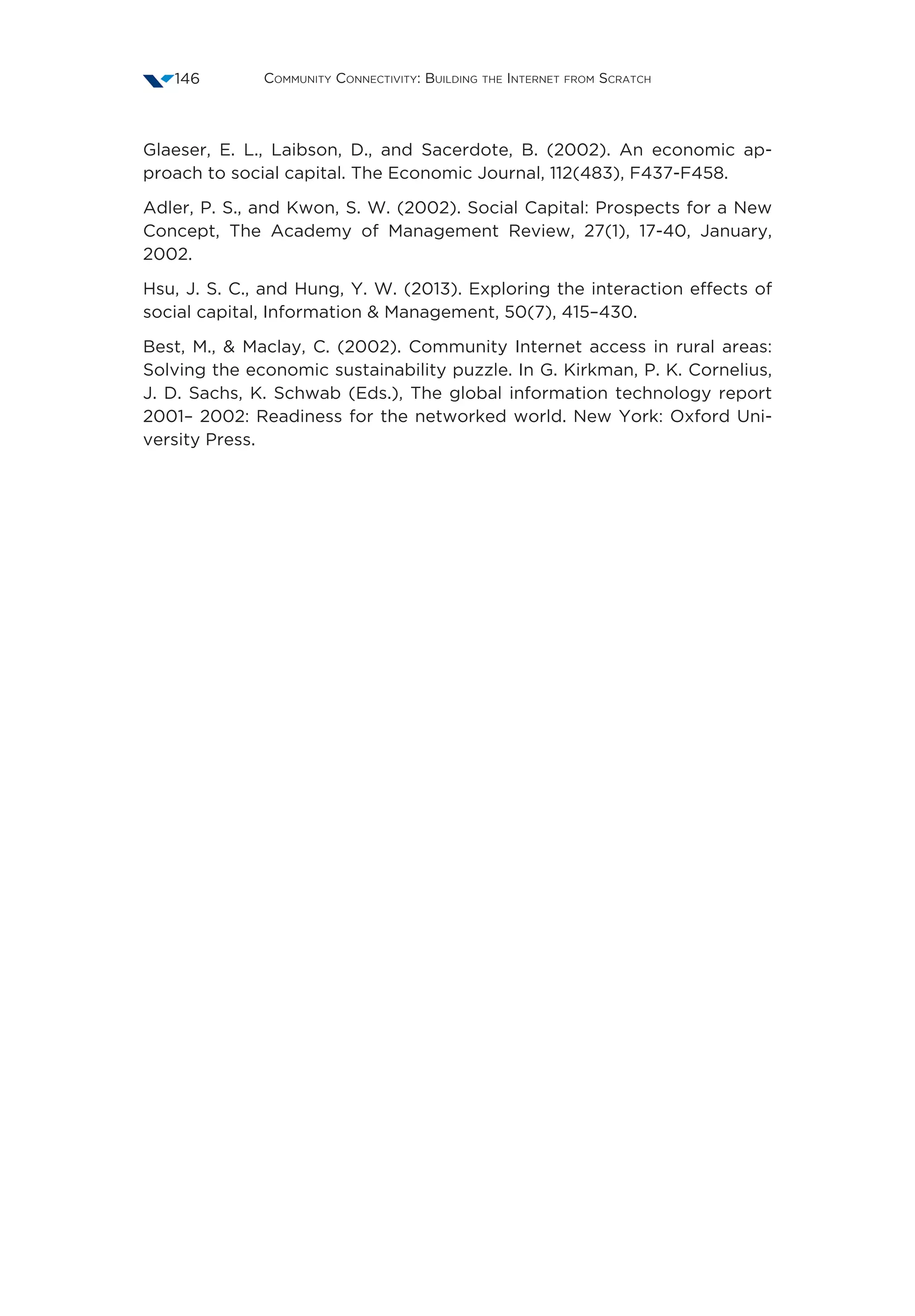
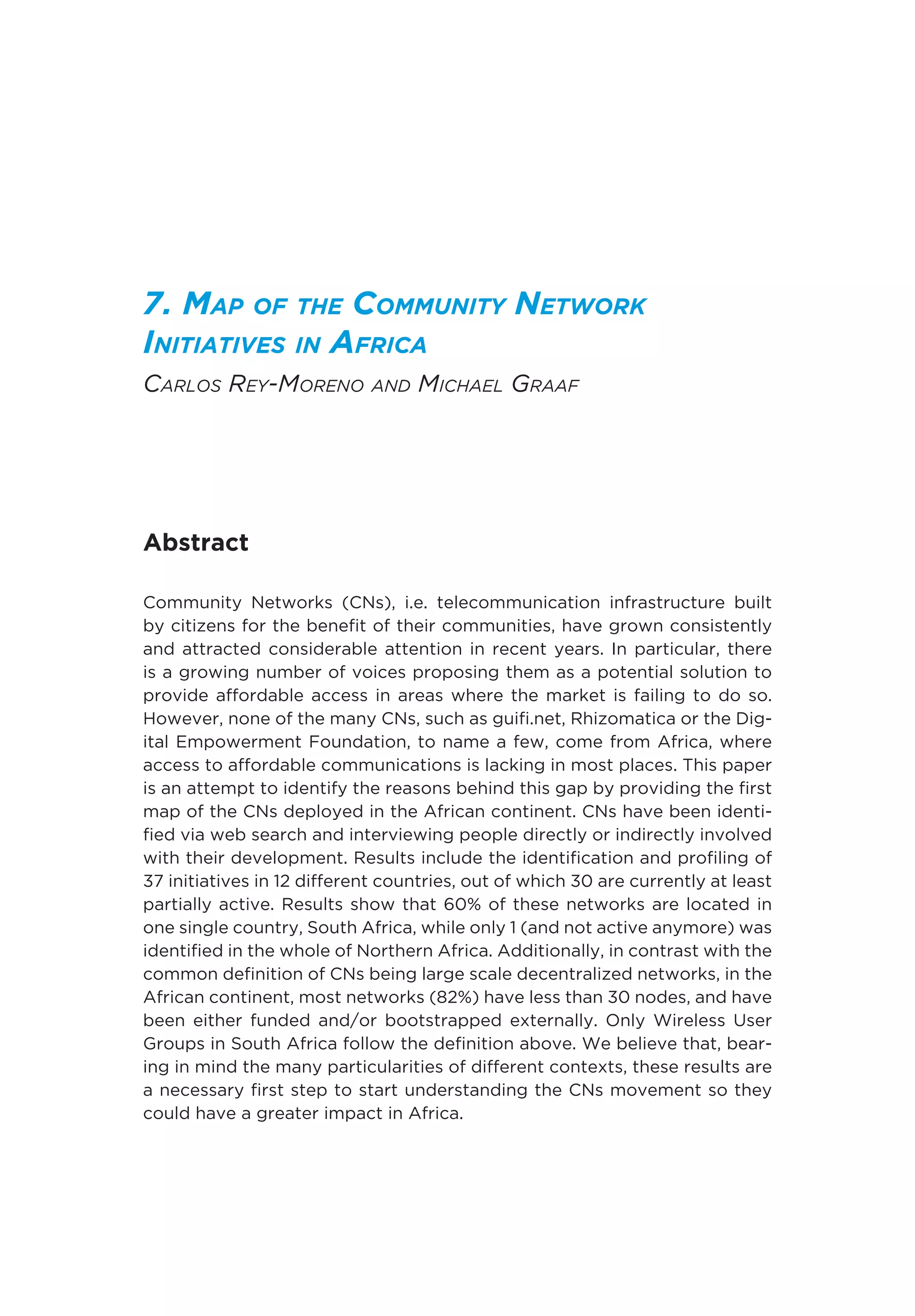
![Community Connectivity: Building the Internet from Scratch148
7.1. Introduction
In recent years the community networks movement has grown consistent-
ly and attracted considerable attention from both funding [1] and academ-
ic bodies [2, 3]. The common understanding that the market forces are
unable to provide affordable access to communications in remote areas
[4] has led some to start advocating for community networks as the solu-
tion [5]. Countries such as South Africa have echoed this trend and incor-
porated them as part of their digital strategy in their National Broadband
Plan [6].
However, the almost total majority of examples that are used to high-
light the benefits of this model come either from Europe [7], and more
recently from Latin America [8, 9] and Asia [10, 11, 12]. In the African con-
tinent, where the affordable access to communications is far from being
a reality, very little is known about what is happening at the community
networks space. Despite the efforts from some of the academics involved
in these projects to disseminate their results in international venues [12, 13,
14], a map of the different initiatives and their current state is missing. Ac-
tually the Wikipedia entry for Community Networks in English was empty
until one of the authors of this paper linked it to the entry about Communi-
ty Networks in South Africa [15], which was itself outdated [16].
Identifying the different initiatives per country will allow an easier
communication with the main actors involved in their development should
other people want to engage with the movement in a specific location and
get a sense of the challenges they may encounter. Additionally, it could
serve as a point of departure for future studies about community networks
in the continent to inform policy, donor strategies to fund similar initiatives
and civil society organizations willing to replicate them.
This paper its a first attempt at filling this gap. In the next section the
methodology to create this map is described. This is followed by the map
itself, including the initiatives identified in each country and their current
operational state. The final section includes the conclusion of this research
exercise and the future works that will follow.
7.2. Methodology
The first author of this paper has been involved in different action research
initiatives aiming at providing access in remote communities for more than
ten years. This, together with an active engagement in two community
networks in Southern Africa and the Village Telco community in the past](https://image.slidesharecdn.com/communityconnectivity-buildingtheinternetfromscratch-170106183237/75/Community-connectivity-building-the-Internet-from-scratch-148-2048.jpg)
![7. Map of the Community Network Initiatives in Africa 149
5 years has allowed a preliminary identification of the different initiatives
and actors in the continent.
This has been complemented by a Google search in both English and
French for the terms “community network”, “community wireless net-
work”, “community mesh network”, “wireless mesh network” and “Africa”.
Additionally, the people identified in both steps have been contacted
to get an updated picture of the community network they are involved
with, to identify other community networks in the continent and to pro-
vide their views on the main opportunities and barriers around this type
of initiatives. Due to lack of space the latter could not be included in this
paper. In total 60 people/entities were contacted, of which 35 answered
the request (although sometimes only partially). Additionally, the request
was sent to 5 mailing lists with potential knowledge on the topic.
Profiles of each community network identified has been sent back to
the main people involved in each of them for confirmation. We would like
to apologize in advance to any community network that has not surfaced
in the process described above and so, not included here.
7.3. Map of the Community Networks in Africa
Democratic Republic of Congo
Mesh Bukavu [17]:
This network is a project of News for Peace, which among other things
runs Radio Maendeleo, a community radio station. It is the result of a col-
laboration of Free Press, a Dutch organization, and was bootstrapped with
funding and training from the Open Technology Institute (OTI). The train-
ing took place in November 2014 and the network was deployed in Janu-
ary 2015. It has a strong emphasis on local hosting of content (Wikipedia,
blogs, audio lessons, e-books), and also other local services like a local
chat. It is valued also as a standby when official net shutdowns occur, e.g.
at election times.
The network, which is still operational, consists of 10-15 nodes, (Ubiq-
uiti NanoStation and Rockets) running Commotion firmware. Equipment is
mounted on rooftops of participant organisations especially if they have
backup electricity (solar is being phased in).](https://image.slidesharecdn.com/communityconnectivity-buildingtheinternetfromscratch-170106183237/75/Community-connectivity-building-the-Internet-from-scratch-149-2048.jpg)
![Community Connectivity: Building the Internet from Scratch150
Mesh Goma [17]:
Mesh Goma was initiated as an experiment of a local organization, the
Collective of Community Radio and TV in North Kivu (CORACON), in part-
nership with Free Press Unlimited and inspired by Mesh Bukavu. It also
received Seed funding from the OTI.
The network was initially deployed in January 2015 with the idea of
providing access to information to the areas in the city of Goma which
lacked this access. It consisted of 15 nodes (14 Ubiquiti and 1 Tp-Link).
It is no longer operational due to the problems with access and costs of
reliable electricity in Goma, and the lack of digital stewards keen to work
voluntarily in maintaining the network. Additionally, the network was only
providing intranet services, which did not make it attractive to the majority
of the population in Goma.
Pamoja Net [18]:
Pamoja Net (pamoja means ‘together’ in Swahili) is a local mesh on the
island of Idjwi in Lake Kivu, between the DRC and Rwanda. It reports 200
regular WiFi users, as well as institutions such as a radio station, the police,
and the electoral commission. It also has a public display screen and tab-
lets for casual users in a kiosk. Interestingly its backhaul is via line-of-sight
links to Bukavu, where another community network is located (although
Pamoja’s gateway is via an internet cafe there).
The network was created in 2015 by Project First Light, a partner-
ship of NGOs and businesses. The partnership still oversees operations,
although it has trained local “guardians” to conduct day-to-day running. In
terms of governance, the local traditional leader (who originally requested
internet connectivity) is committed to operating Pamoja as a commons.
Ghana
Akwapim Community Wireless Network [19]:
This is located in Eastern Ghana and was installed and maintained by a
small group of volunteers associated with the Apirede Community Re-
source center. Both the resource centre and the community network are
projects of the Community-Based Libraries and Information Technology
(CBLit), a non-government organization based in both Ghana and the
United States. It started in 2005 in response to the local community’s re-
quests for connectivity to help them break their isolation, as an extension](https://image.slidesharecdn.com/communityconnectivity-buildingtheinternetfromscratch-170106183237/75/Community-connectivity-building-the-Internet-from-scratch-150-2048.jpg)
![7. Map of the Community Network Initiatives in Africa 151
of a public library initiative, with the support of the US Peace Corps. Its first
phase had 10 nodes, and the second was to have another 10. The second
phase was also to use a V-Sat link. Most nodes use old PCs as routers, with
new WiFi cards (Dell OptiPlex units and D-Link DWLG520 cards). Within
this research, it was impossible to determine the current status of the net-
work. However, its website is down and no information after 2009 can be
found online, which lead us to believe is no longer active.
Kenya
Tunapandanet [20]:
This was started and funded in the last 5 years by an educational-devel-
opment NGO (Tunapanda Institute, which got early funding via Indiego-
go, and had high input from American “backpacker” volunteers). Network
serves to further its outreach (educational activities centre on Edubuntu
thin client system) into large, high-density slum. Of particular interest is
the organisation’s emphasis on cached/recorded content to avoid external
data costs. Base station and 3 nodes: Ubiquity PicoStation (short range,
omnidirectional), Ubiquiti NanoStation (medium range, directional), Ubiq-
uiti Rocket. Network likely expanding as organisation is active.
Namibia
Connecting Eenhana [17]:
This was created in 2015 by partnership between the University of Namib-
ia and the Glowdom Educational Foundation with a grant from the OTI
to support learning amongst community members of the small town of
Eenhana and surrounding villages . In particular it aimed at supporting the
generation and sharing of local content and to increase access of schools
to educational content, including for learners and students at a Special
school for Deaf learners. Additionally, the local content creation was ex-
tended to provide local government information, as well as transparency
and accountability of local government.
It connects 7 sites using Ubiquiti routers and Mesh Potato devices
which also provide VOIP services. All the network runs SECN firmware. It
is only partly functional at the moment, due to equipment failure due to](https://image.slidesharecdn.com/communityconnectivity-buildingtheinternetfromscratch-170106183237/75/Community-connectivity-building-the-Internet-from-scratch-151-2048.jpg)
![Community Connectivity: Building the Internet from Scratch152
overheating and difficult terrain (very flat and with tall trees, which pre-
vent Line of Sight between the nodes).
Nigeria
Fantsuam Foundation [17]:
Started in 2009 with SEED funding and having only 2 nodes, ZittNet is a
department of Fantsuam Foundation (an NGO in Kaduna State), and fo-
cuses mainly on ICT training and Last Mile Connectivity; nonetheless it was
honoured as Nigeria’s first rural ISP. It was also intended to provide rural
students with access to (downloaded) offline study materials. It started
off having a VSat connection but due to cost is trying to replace this with
a fibre connection. It notably uses solar backup to maintain service in the
absence of reliable grid power.
Ibadan WUG [21]:
Started by one of the Mesh Potato project’s earlier contributors in a resi-
dential precinct in Ibadan. It is still actively providing connectivity largely
to home owners and students. It consists of 22 Mesh Potatoes.
Somalia
Abaarso [22]:
Initiated by an American working as ICT instructor in Somalia to serve the
Abaarso School of Science and Technology due to poor and at times non-
existent internet. Also involved some local cloud hosting. Used Ubiquity
Commotion. Current status unknown.
South Africa
Siyakhula Living Labs [22]:
It started in 2005 project involving the Telkom Centre of Excellence at
two universities, Rhodes and Fort Hare. The first network was intended to](https://image.slidesharecdn.com/communityconnectivity-buildingtheinternetfromscratch-170106183237/75/Community-connectivity-building-the-Internet-from-scratch-152-2048.jpg)
![7. Map of the Community Network Initiatives in Africa 153
provide exposure to international markets to the local arts and craft en-
trepreneurs within the Dwesa community; and started off with 3 nodes at
schools, consisting of WiMAX backbone with WIFI hotspots around each
node, and a VSAT backhaul and later growing to at least 14 nodes. From
the initial offering of e-commerce services this grew to providing infor-
mation and communication services (including telephony services, email-
ing, school administration, etc.) both for the schools and the surrounding
communities. The network grew from the three nodes to about 14+ (might
have actually been 17 schools at the end) and offering a whole plethora of
services to the schools and the communities. The network is still opera-
tional but barely, largely due to funding challenge.
The second network was started by a researcher from the University
of Fort Hare (UFH) who deployed a community wireless mesh network
consisting of seven nodes using nanostations m2 (3) and picostations m2-
hp (4) connected through a VSAT sponsored by Sifunda Kunye Educa-
tional Foundation in a location called Ntselamanzi, Alice, Eastern Cape.
Its operation is linked to a research project by a student at UFH, which
meant that its active management and administration has slowed down
since the student completed his work. Still, it has plans to be extended to
neighbouring communities.
Rural Telehealth [24]:
The University of Western Cape led a series of rural wireless projects, last-
ing several years each, between 2003-2012, connecting remote hospitals
and clinics in the Eastern Cape province. There was also an initial try at
rural community networks, even mesh. These involved long range (up to
15km) line-of-sight WiFi links, in both 2.4 and 5GHz. At times, they were
connected to one or two expensive VSAT links. All were powered by deep
cycle 12v batteries, charged either by solar panels or trickle charged from
unreliable mains. Despite robust technical performance, the networks and
apps created for them were not fully utilised mainly due to social reasons,
e.g. power relations, suspicion of our motivation and the single champion
problem.
Peebles Valley Mesh Network [12]:
This mesh network in Peebles Valley, Mpumalanga consisted of 6 nodes
and provided connectivity (Internet, local Wikipedia content and local free
VoIP) to homes, farms, a school and other clinic infrastructure. The Inter-
net link was provided by spare capacity on a VSAT link at an AIDS clinic
in the area. The project was supported by an IDRC funded project called
First Mile First Inch that included Meraka and various academic institutions](https://image.slidesharecdn.com/communityconnectivity-buildingtheinternetfromscratch-170106183237/75/Community-connectivity-building-the-Internet-from-scratch-153-2048.jpg)
![Community Connectivity: Building the Internet from Scratch154
and NGOs across Africa. The project lapsed due to the high cost of VSAT,
legal uncertainty around community-built wireless networks and lack of
continued support.
Bo-Kaap [25]:
A now-defunct “testbed” experiment in a historic inner-city precinct in-
volving 75 of the early Mesh Potatoes and an internet gateway, funded
by the Shuttleworth Foundation. The network was intended to test the
capabilities of and debug evolving mesh WiFi voice technology in a live
environment. Technology development challenges and a failure to build
community ownership in from the beginning led to the project lapsing.
Orange Farm [26]:
Another pilot project in the development of the Village Telco technology/
business model, in a township near Johannesburg. Social enterprise Dabba
installed Mesh Potatoes and cheap VoIP handsets. However the network
seems to have lapsed after the rapid proliferation of cellular telephony cre-
ated a more powerful “network effect” so the micro-entrepreneurs Dabba
anticipated were not forthcoming.
Kranshoek Mesh, South Africa [27]:
A truly community-driven network in a historic coastal village occupied by
an ethnic minority. Using Mesh Potatoes, it promised to bring relief from
high communications cost in a context of high unemployment, but current
status is unknown.
Zenzeleni Networks [14]:
Formed with technical assistance from the University of the Western Cape,
it is registered as a co-operative and an Internet Service Provider, oper-
ated and managed by members of Mankosi, a rural community in one of
the most disadvantaged areas of South Africa. It has 12 nodes linked to a
3G gateway. Each node consists of a Mesh Potato connected to a solar
power supply. It provides access to voice services at a fraction of the cost
offered by incumbent operators. Currently under way are the provision of
WiFi hotspots and connection of local schools’ computer labs, as well as
backhaul improvement.](https://image.slidesharecdn.com/communityconnectivity-buildingtheinternetfromscratch-170106183237/75/Community-connectivity-building-the-Internet-from-scratch-154-2048.jpg)
![7. Map of the Community Network Initiatives in Africa 155
Scarborough Wireless User Group [28]:
A middle-class peri-urban DIY community was sharing internet access by
mesh with each other and some poorer neighbours near Cape Town, S.
Africa. At its peak it had about 200 nodes. Used Linksys WRT54GL, Ubiq-
uity Nanostations and Mesh Potato V1’s routers. Defunct due to arrival of
cheaper, faster ADSL fibre.
SoWUG [29]:
Hybrid CN/ISP in Soweto, South Africa. Started in 2010 with corporate
sponsorship and technical support from the Johannesburg Area WUG. It
provides WiFi hotspots in public spaces in Soweto and nearby peri-urban
areas. The organisation’s website maps out several operations it intends to
expand into such as educational support.
Cape Town WUG [30]:
Although using the term “mesh” this large urban network (registered as a
nonprofit organisation) is more correctly described as decentralised. With
some hundreds of members, its only official connection to the internet is
for POP email; otherwise, the main functions are offline file-sharing and
gaming. It has a progressive constitution regarding sharing of skills and
resources and some cross-subsidisation is evident between richer and
poorer areas.
Johannesburg Area WUG [31]:
Similar to above; interestingly, is a member not only of Wireless Applica-
tion Providers Association, but Internet Service Providers Association.
Durban Wireless Community (DWC) [32]:
Smaller (approx 50 nodes) and more sporadically active; founded 2004
and recently revived; a non-profit promoting wireless technology and
computer networks.
Other WUGs [33]:
Another five nuclei of smaller, sporadic groups.](https://image.slidesharecdn.com/communityconnectivity-buildingtheinternetfromscratch-170106183237/75/Community-connectivity-building-the-Internet-from-scratch-155-2048.jpg)
![Community Connectivity: Building the Internet from Scratch156
Pretoria Mesh [34]:
This is an experimental project started in 2006 in the suburbs next to the
CSIR, to test hardware and software deployed in other projects through-
out the country. It has about 20 nodes and is still active.
BB4All / Broadband-for-All [35]:
This is an abbreviation of Broadband Community Wireless Mesh Network
which was a government sponsored research and demonstration program
targeting the digital divide in rural areas. The implementation, launched in
2009 in Mpumalanga and Limpopo was transferred in 2014 to a commer-
cial organisation providing school connectivity and public hotspots [36].
ICT4RED [37]:
The ICT for Rural Education (ICT4RED) project (2012-2016), undertaken
by CSIR Meraka, was the largest research, development, innovation and
implementation project of its kind in South Africa. It formed the ICT aspect
of the larger Cofimvaba Technology for Rural Education Development
(TECH4RED) project, a joint initiative between the Department of Sci-
ence and Technology, the Department of Basic Education and the Eastern
Cape Department of Education. TECH4RED is aimed at contributing to the
improvement of rural education through technology-led innovation. IC-
T4RED was particularly successful in implementing technology in schools
and in empowering rural teachers to comfortably use tablets in their day-
to-day teaching activities, by using gamification principles and an “earn-
as-you-learn” approach. ICT4RED employed a mesh network connecting
26 schools, with internet connectivity provided via shared satellite infra-
structure. In 2016 the project has been handed over to the district and the
province authorities to institutionalize the initiative
Home of Compassion [38]:
Home of Compassion, an NPO based in Delft (Cape Town), has piloted a
community network since 2015.It started with funding from the Western
Cape Government and the support of an external ISP to roll out the net-
work but once they built enough technical capacity, they decided to be-
come an ISP themselves. By November 2015, it had 20 active access point
and 17,150 active devices. They offer 50MB allowance a day per device
and once users reach their cap, they sell prepaid top-up vouchers though
a network of local resellers. In addition to the provision of Wi-Fi connec-
tivity, Home of Compassion provides IT training and through its network](https://image.slidesharecdn.com/communityconnectivity-buildingtheinternetfromscratch-170106183237/75/Community-connectivity-building-the-Internet-from-scratch-156-2048.jpg)
![7. Map of the Community Network Initiatives in Africa 157
it is able to set up “call centres on-demand”. Finally, Home of Compassion
has developed an app, which is zero-rated across its network, to purchase
goods and services within the community.
Tanzania
The ICT for Rural Development Project (ICT4RD) [39]:
This nationwide initiative had 2 pilot networks set up in Bunda and Seren-
geti in 2006. Assistance came from Swedish researchers and the agency
SIDA. Both pilots were motivated by existence of fibre optic cables owned
by other entities, however use was also made of a VSat connection at Bun-
da. Local governments were involved to create ownership and sustainabil-
ity but contributed to the demise of the first. The remaining one connects
schools and hospitals.
Sengerema Wireless Community network:
A project of the Sengerema multi-purpose Telecenter which provides
computer services, printing, office, internet, education, FM Radio Station
(reaching 400 000 people) with support from Dutch NGO, IICD. In 2012 it
had an internet connection - VSAT 128/64 kbps through COSTECH (Tan-
zania Commission for Science and Technology). The network served a
large number of civil society and official organisations including schools.
It featured wireless routers: Linksys WRT54GL; firmware OpenWRT/
Freifunk; self-built antennas (with some exceptions) and locally built
masts. Current status unknown, believed to be lapsed.
Tunisia
Mesh SAYADA [40]:
A project of Clibre (a local open-web advocacy group) that started in
2012. The networking equipment (12 nodes) was donated by the Open
Technology Institute, and the time was volunteer. The network is not really
operating currently, largely due to the unstable sociopolitical situation.](https://image.slidesharecdn.com/communityconnectivity-buildingtheinternetfromscratch-170106183237/75/Community-connectivity-building-the-Internet-from-scratch-157-2048.jpg)
![Community Connectivity: Building the Internet from Scratch158
Uganda
Bosco Network [41]:
Battery Operated System for Community Outreach (BOSCO)-Uganda is a
Non-Profit Organization (NGO) under the trusteeship of the Archdiocese
of Gulu. Funded and operational since the year 2007 the organization start-
ed in installing wireless Internet and VoIP telephony in internally displaced
persons (IDP) camps with reliable eco-friendly energy. 9 years later BOS-
CO-Uganda is managing 32 Information and Communication Technology
(ICT) Centers situated in rural communities and former internally displaced
persons camps, consist of low-power, solar powered PCs connected to
a high-speed, long-range WiFi Internet connection. Each communication
station is linked to other BOSCO sites via a free VoIP telephony network
and through a high-speed internal network (INTRANET) content manage-
ment page that are all powered by solar energy and enabling thousands
of Ugandans in acquiring ICT and entrepreneurship knowledge, connect-
ing them with other communities (e.g. market platform) and the outside
world.
Zambia
Macha Works [42]:
Macha Works’ LinkNet internet provisioning in the rural community of
Macha, in Choma District, Southern Zambia, is a renowned example of
community networking in Southern Africa. The first internet connection
became available for the community in early 2004, by means of a shared
satellite internet connection with a medical research center in the com-
munity.
From its start, so-called ‘local talent’ gained experience in collabora-
tion with international partners but always approached realities from the
local perspective first. The networking morphs continuously, utilising a
variety of available technologies. These (did) include mesh network tech-
nologies and direct WiFi links, the use of second-hand computers, and the
deployment of locally refurbished sea containers for raising awareness of
the internet in other rural communities in Zambia and Zimbabwe. With the
implementation of a WiMax network by a commercial operator and with
debilitating donor-led intrusions of the LinkNet developed ‘market’ in its
community, Macha Works focuses more on user training, technical train-
ing, and the maintenance of ICT equipment.](https://image.slidesharecdn.com/communityconnectivity-buildingtheinternetfromscratch-170106183237/75/Community-connectivity-building-the-Internet-from-scratch-158-2048.jpg)
![7. Map of the Community Network Initiatives in Africa 159
The Macha network inspired and trained local leadership in both the
technical and communal aspects of the provisioning of internet access in
rural area. At least 7 other communities in Zambia emulate Macha’s exam-
ple and run a plethora of community networks and ICT services.
Zimbabwe
Murambinda Works [43]:
Established in the early 2000s, Murambinda Works at Buhera in Zimbabwe
is focused on bridging the digital divice between rural and urban settings.
In this sense, Murambinda works provides ICT training in rural communities
where most schools lack relevant computer facilities. It is affiliated with
Macha Works in Zambia and has various operations, including internet ser-
vice provision and an internet cafe.
After using dial-up internet until 2015, it now has a fibre link to the
national backbone. Training is provided for public officials including teach-
ers, and any surplus revenue is channeled to a local foster home. Plans
are afoot to extend to remote access points, perhaps even by satellite
although for now costs are prohibitive.
Other initiatives related to community networks
identified
The list below presents other projects identified in the search that either
did not ever deploy a community network per se, or no data could be
found to confirm that they were indeed deployed.
Comoros [44]:
This was to be an academic project funded from Qatar but its status is
unknown.
Brubru, Kenya [45]:
The project seems to involve two brothers based in California (hence Bru-
Bru). But a query to their contact page was not responded to in time to be
incorporated to this article.](https://image.slidesharecdn.com/communityconnectivity-buildingtheinternetfromscratch-170106183237/75/Community-connectivity-building-the-Internet-from-scratch-159-2048.jpg)
![Community Connectivity: Building the Internet from Scratch160
In the Wikipedia list of Community Wireless Networks in French [46],
the following networks appear listed (for the first two no further informa-
tion has been found online about them):
Agadir, Maroc Hotspot.ma, Dcheira, Casablanca
VIRTU@L CYBER, BUROCI Sarl - Abidjan, Cocody RCI
Cybervillage Africa, Cameroon [47]
This is not really a community network, but provides training workshops
in wireless network construction, including solar power supplies. It aims
at reducing the barrier for communities to deploy their own networks and
bridge the digital divide. In 2016 they have provided several workshops
across Cameroon.
Cotonou, Benin [48]
A Do it yourself project by a group of friends who wanted to bypass pro-
hibitive prices.Additionally, two other initiatives had been identified where
the infrastructure was created by mobile phones:
Mesh-Casting, Nigeria [49]:
Initially funded by Amnesty International and Internews, Rhizomatica,
in conjunction with the Media for Justice Project, coordinated a mobile-
mesh-based solution for a group of activists, citizen journalists and human
rights monitors working in the Niger Delta region of Nigeria. The mesh part
is no longer working, but the Media for Justice Project is still active.
Shika Moto, South Africa, [50]
An experiment by an NGO, Media Monitoring Africa, which was still in very
early stages at the time of going to press.
7.4 Discussion and Conclusion
Information provided in the profiles above has been summarized in the
Table and Figure below, for an easier visualization of the results.](https://image.slidesharecdn.com/communityconnectivity-buildingtheinternetfromscratch-170106183237/75/Community-connectivity-building-the-Internet-from-scratch-160-2048.jpg)
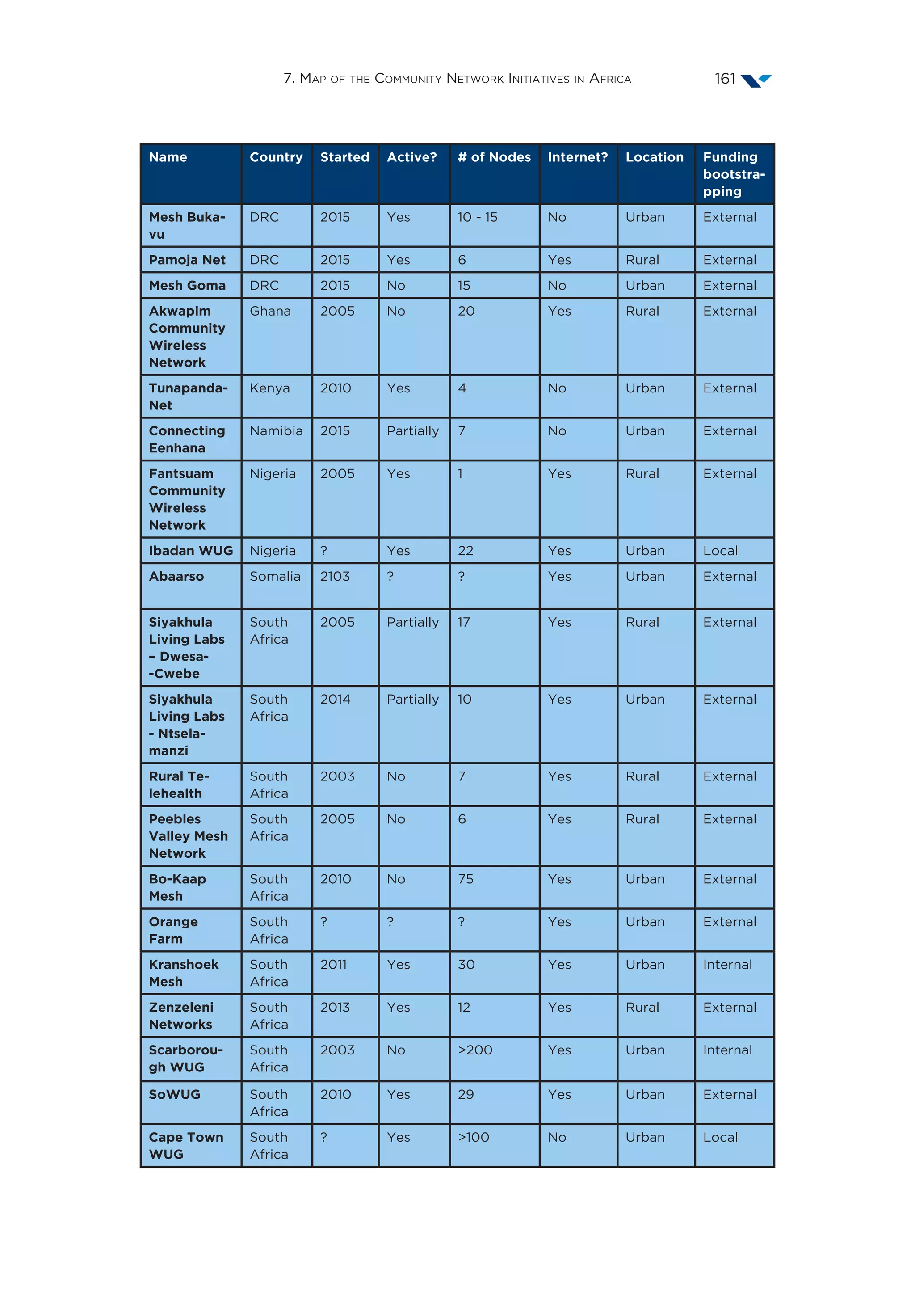
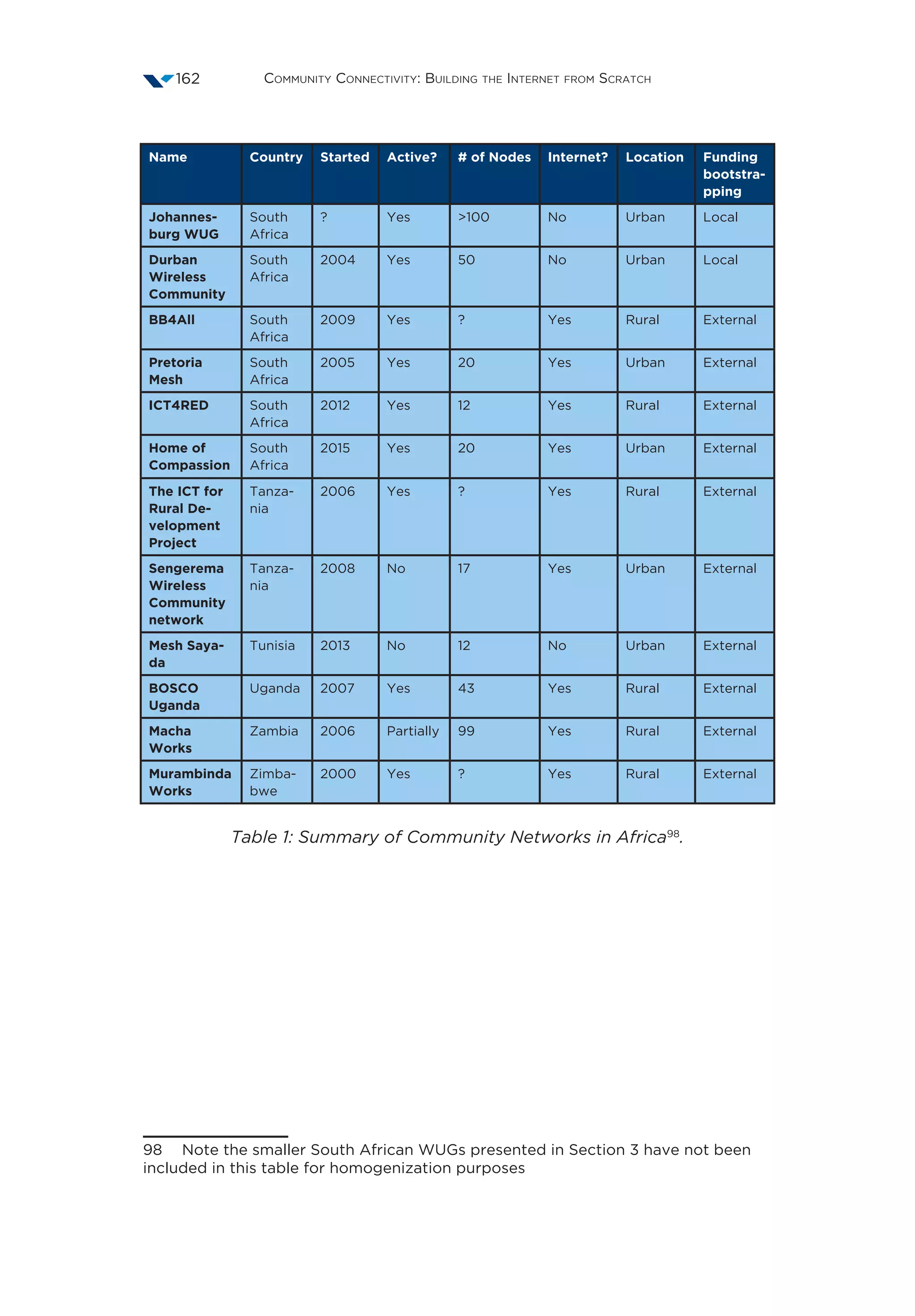
![7. Map of the Community Network Initiatives in Africa 163
Community Networks in Africa
To our knowledge this is the first initiative producing a map of the
Community Networks deployed in Africa. Results include the identification
and profiling of 372 initiatives in 12 different countries, out of which 25 are
currently at least partially active. Results show that 60% of these networks
are located in one single country, South Africa, while only 1 (and not active
anymore) was identified in the whole northern Africa. Provided that the
authors are based in South Africa, results may show a bias in this respect.
Still, it is would be worth exploring what other factors are behind these
skewed results.
2 The 32 networks in Table 1 plus 5 small WUGs identified in South
Africa.
It is the intention of the authors to use all this data with the contact
information from each of the CNs that granted us permission to do so to
update the existing Wikipedia article [15]. This would allow a dynamic up-](https://image.slidesharecdn.com/communityconnectivity-buildingtheinternetfromscratch-170106183237/75/Community-connectivity-building-the-Internet-from-scratch-163-2048.jpg)
![Community Connectivity: Building the Internet from Scratch164
date of the information presented here, including new CNs as well as those
that have not been identified during this research.
In the interviews conducted it was surprising how little people in-
volved in a CN know about other networks in the continent (to the point of
not knowing about two networks in the same city in some instances). This
open space to create some sort of Coalition to share experiences, tools,
etc, and, most importantly, to make sure that they form part of a much
bigger movement.
Additionally, in contrast with the common definition of CNs being
large-scale, self-organised and decentralised networks, built and operated
by citizens for citizens [51], in the African continent, most networks (83%)
have less than 30 nodes. Another interesting fact is that 76% of them are
either funded and/or bootstrapped externally. Only Wireless User Groups
in South Africa and Nigeria follow the definition above. This is a result
of having used a broad definition of Community Networks, as initiatives
presented here where idenfied by their representatives as such. Mapping
these initiatives to the taxonomical categories for alternative infrastruc-
tures developed in [52] could show if there is need for a new category
for the African context. In this sense, existing research has looked into the
build-up of local ownership in an externally initiated CN [53], however,
more research is required to characterize this particular phenomenon of
the CN movement in the continent. Understanding how other barriers are
limiting a more organic growth of the movement it is also required and will
follow up the research presented here.
We believe that, bearing in mind the many particularities of different
contexts, these results are a necessary first step to start understanding the
CNs movement so their potential can be maximized for a greater impact
in Africa.
7.5 Acknowledgements
We would like to thank everyone who has contributed with their answers
to make this map possible: S. Song, E. Wagenrad, G. Nhinda, N. Bidwell, S.
Büttrich, A. Terzoli, T. Mfikwe, A. Gunn, R. Gerety, G. van Stam, A. Nungu,
D. Carman, W. Tucker, M. Thinyane, J. Larson, J. Atkinson, B. Murhesa, P.
Zikomangane, M. Siya, J. Bishi, M. Marais, M. Adeyeye, J. M. Youmbi, R.
Lissoos, D. Johnson, K. Roux, M. Ford, N. Kerkeni, M. Jensen, M. T. Makawa,
J. Miliza, P. Gichini, A. Phokeer, M. Beeston, V. Ndzengu, J. Dada, D. Thak-
ur, P. Bloom, E. Penfold, T. Okwonga, E. Calandro, B. Rademan, and T. T.
Mutapay.](https://image.slidesharecdn.com/communityconnectivity-buildingtheinternetfromscratch-170106183237/75/Community-connectivity-building-the-Internet-from-scratch-164-2048.jpg)
![7. Map of the Community Network Initiatives in Africa 165
References
[1] Open Technology Institute, “Call for Proposals: International Commo-
tion Mesh Wireless Projects”, 15th August 2014, last accessed 9th August
2016, [Online] https://www.newamerica.org/oti/blog/call-for-propos-
als-international-commotion-mesh-wireless-projects/
[2] Community Networks Testbed for the Future Internet (Confine proj-
ect), n.d., last accessed 9th August 2016, [Online] http://confine-project.
eu/
[3] netCommons project, n.d., last accessed 9th August 2016, [Online]
http://netcommons.eu/
[4] J. Navas-Sabater, A. Dymond, and N. Juntunen, Telecommunications
and information services for the poor: Toward a strategy for universal ac-
cess. Washington, DC: World Bank, 2002.
[5] Alliance for Affordable Internet, “Affordability Report 2015/2016”,
2015, available at: http://a4ai.org/wp-content/uploads/2016/04/
A4AI-2015-16-Affordability-Report.pdf
[6] Republic of South Africa, “South Africa Connect: Creating Opportuni-
ties, Ensuring Inclusion,” South African Government Gazette, vol. 953, no.
37119, December 2013.
[7] R. Baig, R. Roca, F. Freitag and L. Navarro. “guifi.net, a crowdsourced
network infrastructure held in common”. Computer Networks. 29;90:150-
65, 2015.
[8] L. Wade, “Where cellular networks don’t exist, people are building their
own,” January 2015, last accessed 19 July 2015. [Online]. Available: http://
www.wired.com/2015/01/diy-cellular-phone-networks-mexico/
[9] Altermundi, “Altermundi: … la pata tecnológica de ese Otro Mundo
Posible”, n.d., last accessed 9th August 2016, [Online] http://altermundi.
net/
[10] Nepal Wireless, “Nepal Wireless”n.d., last accessed 9th August 2016,
[Online] http://nepalwireless.net
[11] Digital Empowerment Foundation, “About DEF”, n.d., last accessed 9th
August 2016, [Online] http://defindia.org/
[12] D. Johnson and K. Roux, “Building Rural Wireless Networks: Lessons
Learnt and Future Directions,” WiNS-DR’08, pp. 17–22, 2008.
[13] J. Backens, G. Mweemba, and G. van Stam., “A Rural Implementa-
tion of a 52 Node Mixed Wireless Mesh Network in Macha, Zambia,” in
Africomm’09, 2009.](https://image.slidesharecdn.com/communityconnectivity-buildingtheinternetfromscratch-170106183237/75/Community-connectivity-building-the-Internet-from-scratch-165-2048.jpg)
![Community Connectivity: Building the Internet from Scratch166
[14] C. Rey-Moreno, Z. Roro, W. Tucker, M. Siya, N. Bidwell, and J.
Simó-Reigadas, “Experiences, challenges and lessons from rolling out a
rural WiFi mesh network,” in 3rd ACM Symposium on Computing for De-
velopment. ACM, 2013.
[15] Wikipedia, “List of wireless community networks by region: Africa”
n.d., last accessed 9th August 2016, [Online] https://en.wikipedia.org/
wiki/List_of_wireless_community_networks_by_region#Africa
[16] Wikipedia, “South African wireless community networks” n.d., last ac-
cessed 9th August 2016, [Online] https://en.wikipedia.org/wiki/South_Af-
rican_wireless_community_networks
[17] Open Technology Institute, “(Re)Building Technology: Community
Technology Fieldguide”, AMC, 2015. Available at: https://www.newameri-
ca.org/documents/1371/rebuilding-technology.pdf
[18] Ensemble Pour La Difference and Fjord, “Bringing The Internet
To Africa’s Forgotten Island”, n.d., last accessed 7th August 2016, [On-
line]. https://www.fjordnet.com/workdetail/bringing-the-internet-to-af-
ricas-forgotten-island/
[19] B. Ebenezer, G. Amoah and J. Atkinson, “Wireless Ghana: A Case
Study”, Community Based Libraries and Information Technology (CBLit),
2006. Available at: http://www.schmoller.net/documents/Wireless_
Ghana_A_Case_Study.pdf.
[20] Tunapanda, “Tunapanda Institute”, n.d., last accessed 10th August
2016, [Online] http://www.tunapanda.org/
[21] Village Telco, “Ibadan Wireless User Group”, n.d., last accessed 10th
August 2016, [Online] https://villagetelco.org/2013/02/ibadan-wireless-
user-group/
[22] D Hastings “Building a Mesh Network in Rural Somaliland”, n.d., last
accessed 7th August 2016, [Online] https://commotionwireless.net/
blog/2013/12/12/building-mesh-network-rural-somaliland/
[23] Siyakhula Living Labs, n.d., last accessed 7th August 2016, [Online]
http://www.siyakhulall.org/
[24] W. D. Tucker, E. H. Blake, G. Marsden, M. Pearson, and R. Westerveld,
“Reflection on three years of rural wireless Internet Protocol communi-
cation,” Southern African Telecommunication Networks and Applications
Conference (SATNAC), pp. 452–457, 2007
[25] Village Telco, “Bo Kaap”, n.d., last accessed 7th August 2016, [Online]
https://villagetelco.org/deployments/bokaap/](https://image.slidesharecdn.com/communityconnectivity-buildingtheinternetfromscratch-170106183237/75/Community-connectivity-building-the-Internet-from-scratch-166-2048.jpg)
![7. Map of the Community Network Initiatives in Africa 167
[26] Balancing Act, “Dabba looks set to make micro low-cost voice telco
operations a reality”, n.d., last accessed 7th October 2016, [Online], http://
www.balancingact-africa.com/news/en/issue-no-412/top-story/dabba-
looks-set-to-m/en
[27] Village Telco, “Wayne Abroue – South Africa”, n.d., last accessed
7th October 2016, [Online] https://villagetelco.org/deployments/wayne-
abroue-south-africa/
[28] SWUG Frequently Asked Questions, n.d., last accessed 7th October
2016 , [Online], http://www.prospect.ac.za/wifi/faq.html
[29] SoWUG, “Transforming Communities Through ICT Development”,
n.d., last accessed 7th October 2016 , [Online], http://www.sowug.org.za/
home/
[30] CTWUG, “Welcome to Cape Town Wireless User Group!”, n.d., last
accessed 7th October 2016 , [Online], ctwug.za.net
[31] JaWUG, “About JAWUG”, n.d., last accessed 7th October 2016 , [On-
line], http://www.jawug.org.za/
[32] Durban Wireless Community, n.d., last accessed 7th October 2016 ,
[Online], http://www.dwc.za.net/
[33] Welcome to WugNet, n.d., last accessed 7th October 2016, [Online],
www.wug.za.net
[34] Wireless Africa, “Pretoria Mesh”, n.d., last accessed 7th October 2016,
[Online], http://wirelessafrica.meraka.org.za/wiki/index.php/Pretoria_
Mesh
[35] M. Marais, H. Lotriet, M. Matthee, “Social Capital as a Resource in an
Entrepreneurial Model for Rural Internet Access and Use” Electrocnic Jour-
nal of Information Systems in Developing countries, 2016. In press.
[36] E-mbizo, n.d., last accessed 7th October 2016, [Online], http://embi-
zounify.com/? v=68caa8201064
[37] ICT4RED Enhancing education, n.d., last accessed 7th October 2016,
[Online] http://www.ict4red.co.za/
[38] Geerdts, C., Gillwald, A., Calandro, E., Rademan, B., and Chair, C.
(2016). Developing Smart Public Wi-Fi in South Africa. Under publication.
[39] Nungu, T. Brown, and B. Pehrson, “Challenges in Sustaining Municipal
Broadband Networks in the Developing World,” ICeND 2011, pp. 24–40,
2011](https://image.slidesharecdn.com/communityconnectivity-buildingtheinternetfromscratch-170106183237/75/Community-connectivity-building-the-Internet-from-scratch-167-2048.jpg)
![Community Connectivity: Building the Internet from Scratch168
[40] Clibre an Open Technology Intitute, “Case Study: Mesh Sayada, Build-
ing a Community Wireless Network”, Febrery 2014. Available at https://
commotionwireless.net/files/posts/041814-Case-Study-Sayada.pdf
[41] BOSCO Uganda, “BOSCO Network”, n.d., last accessed 7th October
2016, [Online] http://boscouganda.com/our-approach/bosco-network/
[42] van Stam, G. (2014). Participatory Networks: Observations from Ma-
cha Works. In Participatory Networks Workshop at PDC 2014, 6 Oct 2014,
Windhoek, Namibia. Windhoek, Namibia.
[43] Bish, J., Bishi, S., van Stam, G. (2016). ICT Training in Rural Zimba-
bwe: The Case of Murambinda Works. In 1st Institute of Lifelong Learning
and Development Studies International Research Conference, Chinhoyi
University of Technology, 2-5 August 2016, Chinhoyi, Zimbabwe.
[44] Iwem Labs, “Wireless for Inclusion in Africa”, n.d., last accessed 7th
October 2016, [Online], http://www.ixem.org/research/comoros/co-
moros.php?language=en
[45] Brubru, n.d., last accessed 7th October 2016, [Online], http://brubru.
org/solve/
[46] Wikipedia, “Réseaux_sans_fil_communautaires” n.d., last accessed
10th August 2016, [Online] https://fr.wikipedia.org/wiki/R%C3%A9seaux_
sans_fil_communautaires
[47] TIC AFRICA, n.d., last accessed 7th October 2016, https://tic-africa.
blogspot.co.za/
[48] Balancing Act, “Benin –DIY wireless enthusiasts launch Wi-Fi broad-
band and IP-to-IP calling”, n.d., last accessed 7th October 2016, “http://
www.balancingact-africa.com/news/en/issue-no-302/top-story/be-
nin-diy-wireless-e/en
[49] Rhizomatica, n.d., last accessed 7th October 2016, https://rhizomati-
ca.org/projects/mesh-networking/
[50] ShikaMoto, “Shika Moto: Villa Liza”, n.d., last accessed 7th October
2016, http://www.shikamoto.org/index.php
[51] B. Braem, C. Blondia, C. Barz, H. Rogge, F. Freitag, L. Navarro, J. Boni-
cioli, S. Papathanasiou, P. Escrich, R. B. Viñas, A. Kaplan, A. Neumann, I.
Vilata, I. Balaguer, B. Tatum, and M. Matson, “A case for research with and
on community networks,” SIGCOMM Comput. Commun. Rev, vol. 43, no.
3, pp. 68–73, 2013.
[52] Saldaña Medina, J. M., Arcia-Moret, A., Pietrosemoli, E., Zennaro, M.,
Braem, B., Sathiaseelan, A. “Alternative Network Deployments: Taxono-](https://image.slidesharecdn.com/communityconnectivity-buildingtheinternetfromscratch-170106183237/75/Community-connectivity-building-the-Internet-from-scratch-168-2048.jpg)
![7. Map of the Community Network Initiatives in Africa 169
my, Characterization, Technologies, and Architectures”. Internet Research
Task Force RFC 7962, 2016.
[53] C. Rey-Moreno, A. Sabiescu, M. Siya, and W. Tucker, “Local Owner-
ship, Exercise of Ownership and Moving from Passive to Active Entitle-
ment: A practice-led inquiry on a rural community ne](https://image.slidesharecdn.com/communityconnectivity-buildingtheinternetfromscratch-170106183237/75/Community-connectivity-building-the-Internet-from-scratch-169-2048.jpg)

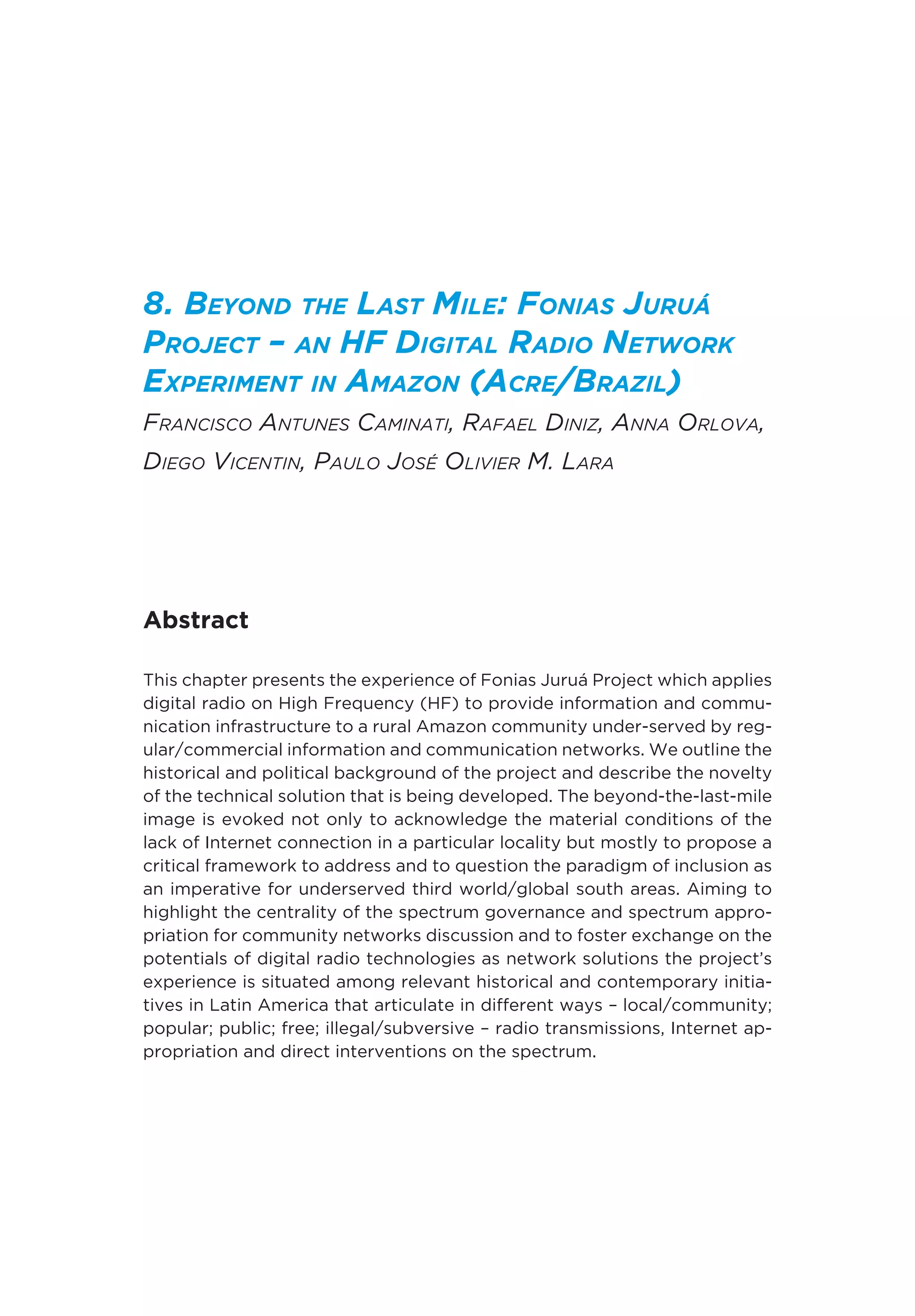
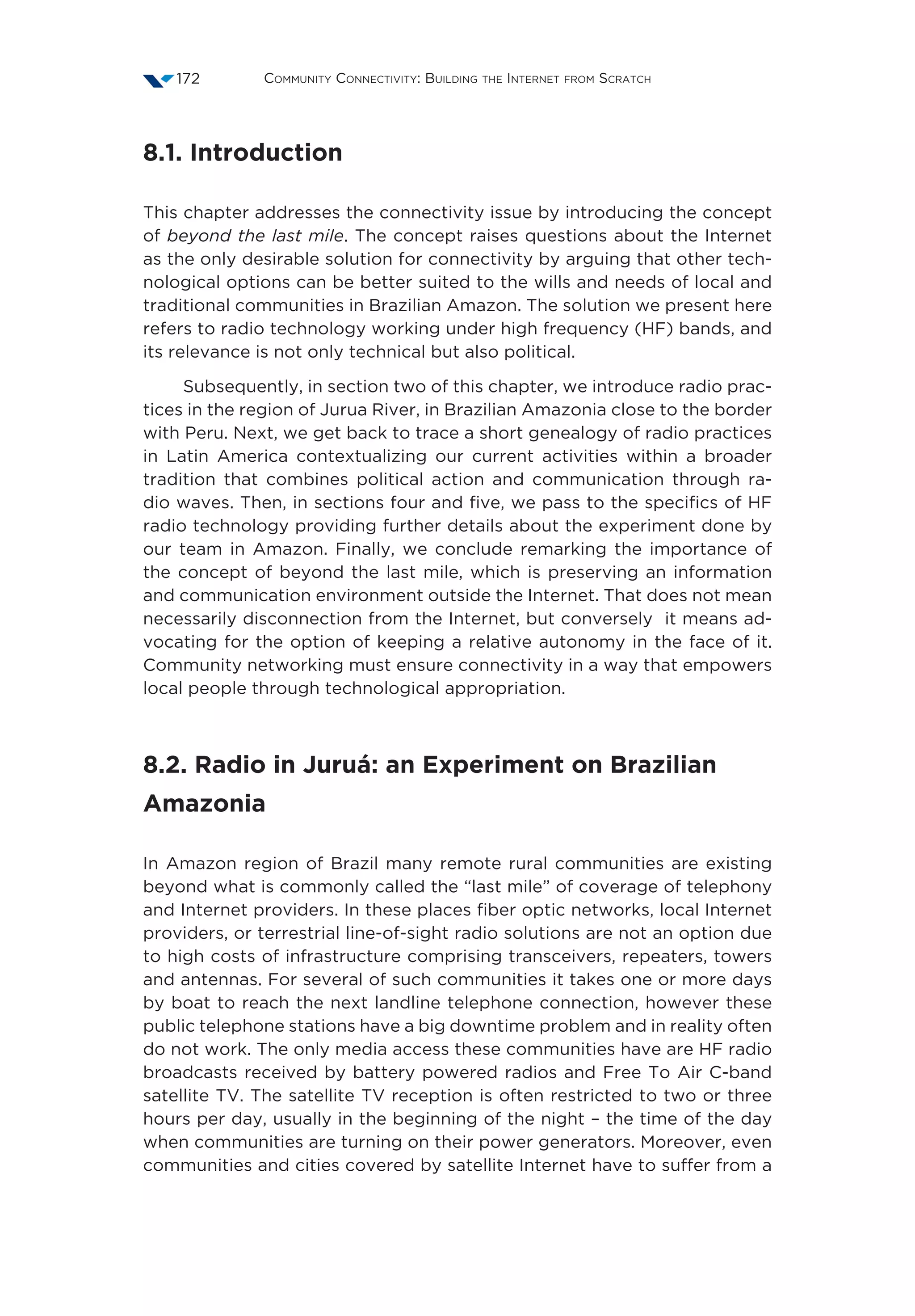
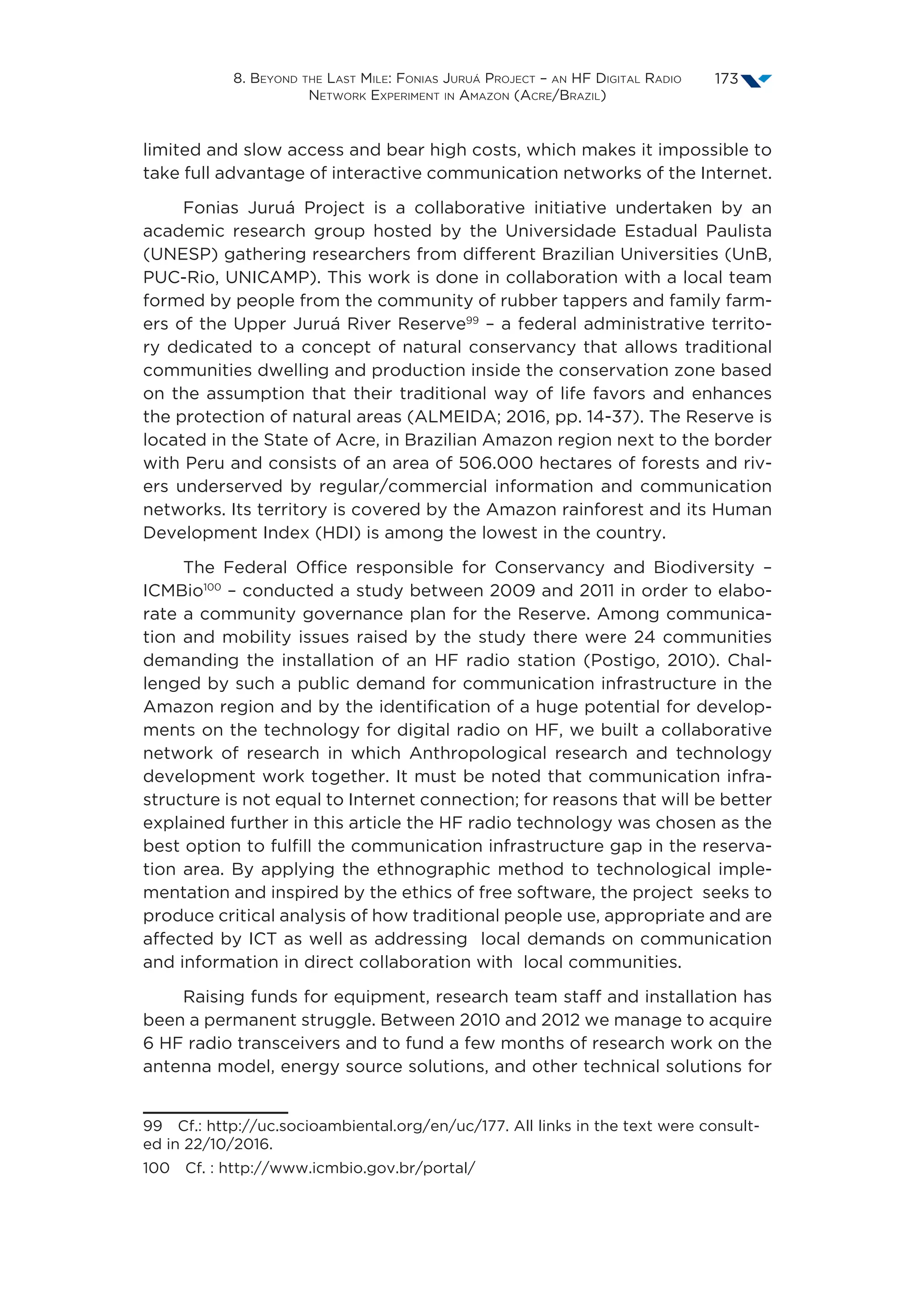
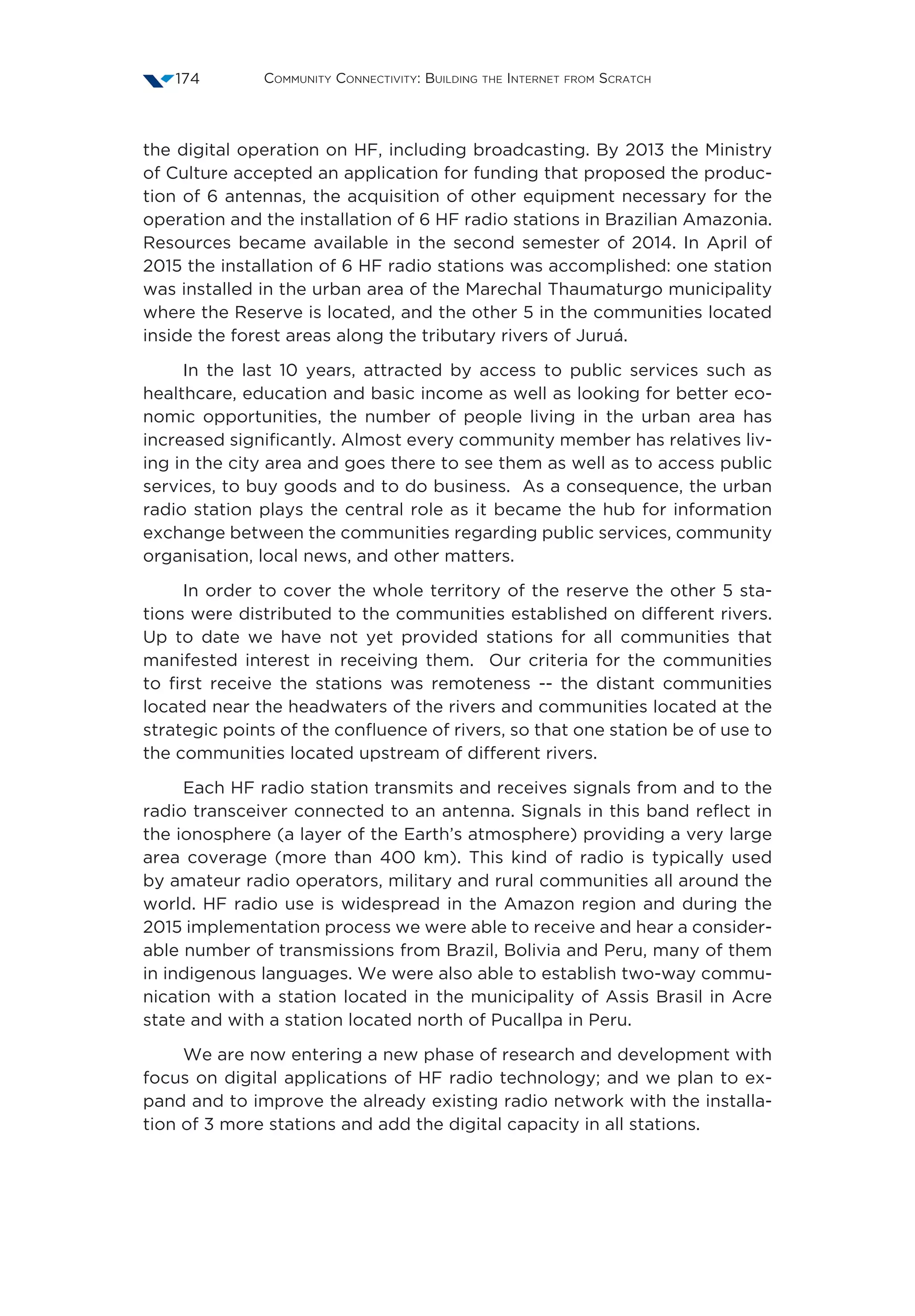
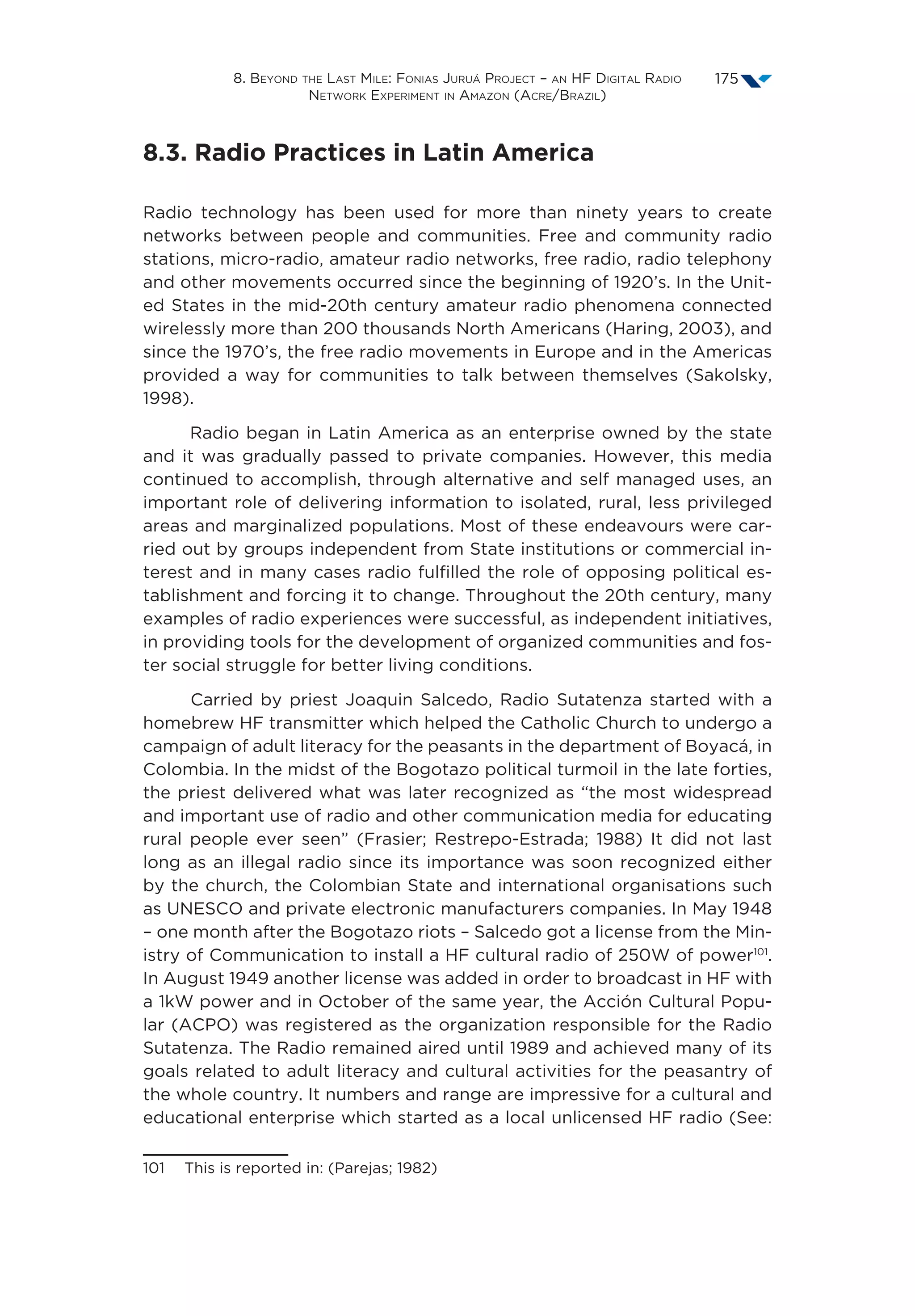
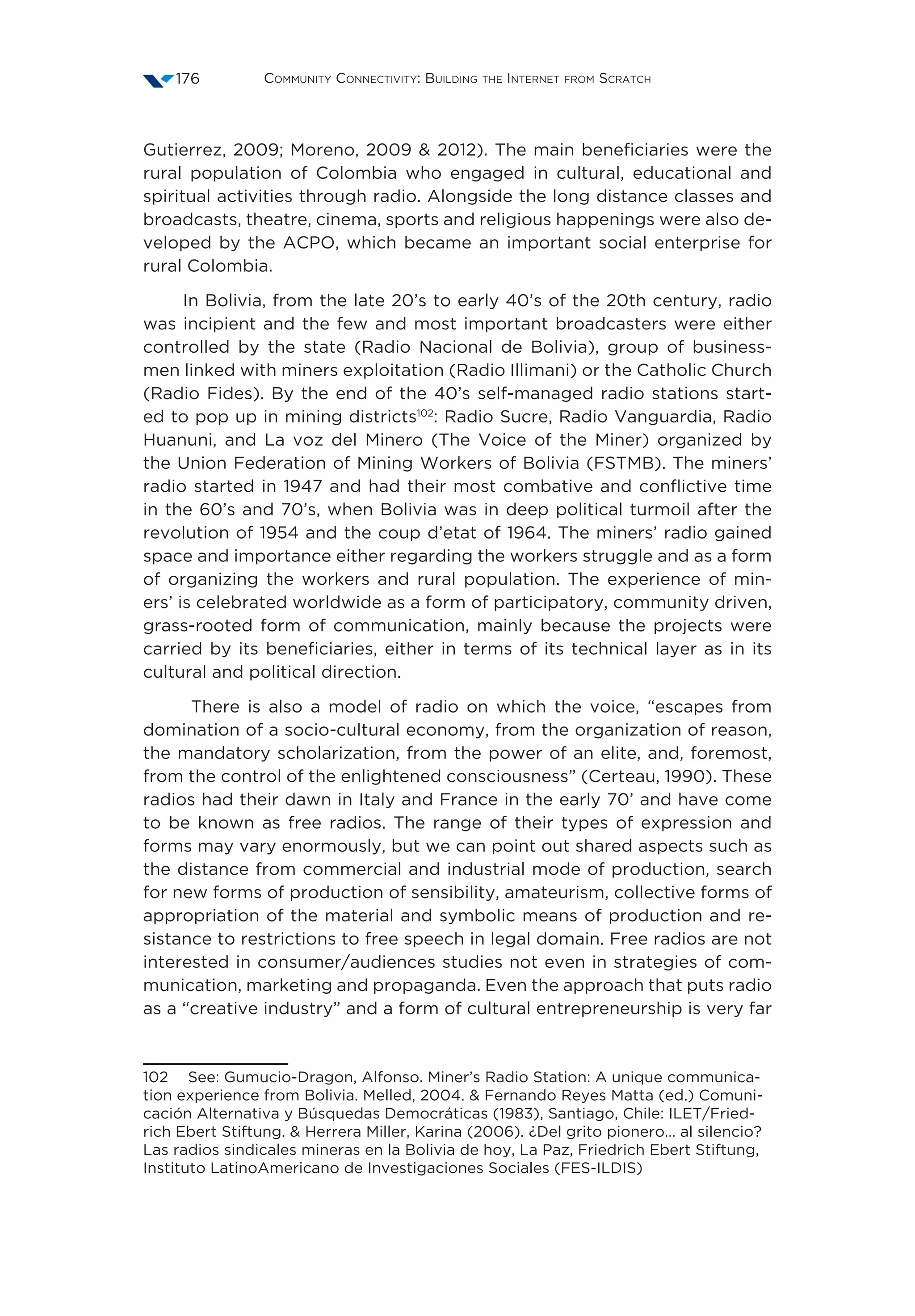
![8. Beyond the Last Mile: Fonias Juruá Project – an HF Digital Radio
Network Experiment in Amazon (Acre/Brazil)
177
from the point of view defended by them. The political approach of uncon-
ventional and of illegal radios uttered a clear position that distances them
either from Capitalist Market and from institutional forms of governance:
“a word finally found. Seemed plausible to invert the official information
and make another true to be heard, free from money and power”103
.
In Brazil, since the tradition of community radio was less significant
than in other South American countries (the first bill for community radios
in Brazil was passed only in 1998), the appearance of the Free Radio move-
ment was embraced largely in cities and intellectual circles countrywide
(Magri, Masagão Machado, 1986). In the 80’s, French thinker and free
radio activist Felix Guattari spent some time in Brazil in debates, confer-
ences and other academic and cultural activities. Amongst his main in-
terests was subjective production through “minor voices” and Free Radio
such as the Italian and French radios appeared to be be good references
for the Brazilian scenario at the time. Throughout that decade, many Free
Radio experiences appeared in the cities of the Rio de Janeiro and São
Paulo states, notably in educational and cultural institutions. Most of them
lasted long enough to mark the free radio movement as one of the most
significant in the media activism landscape of Brazil until today104
.
Also based on the same principles of community and free media, in
Argentina, a group of activist initiated a movement for providing autono-
mous wireless infrastructures for communities mostly in the countryside.
Some initiatives of Free/Community radios and television organized by
the network share technical, political, editorial and artistic contents so the
whole network can replicate their knowledge and apply it for their own
needs. The RNMA105
(Red Nacional de Medios Alternativos) is an initiative
to congregate the experiences and lists radios, televisions, news agencies,
graphical and technical support as part of the broad network106
. DTL107
, as
one of the technical supporters, provides collective workshops on build-
ing transmitters, antenna as well as community engagement and media
politics.
The radio technology of VHF and HF transceivers (two-way com-
munication system, on which you can talk and listen through the same
device) for voice and radiotelegraphy was used by Cuban revolutionaries
103 Collectif radios libres populaires, Les radio Libre. Petite collection Maspero,
1, Place Painlevé - Paris V, 1978. [Translated from brazilian portuguese] translation
by Novaes, Thiago Maureau, Raphael, As Rádios Livres, cf.: http://radiolivre.
org/?q=node/777 .
104 Cf.: Cf. http://www.radiolivre.org/
105 Cf. : National Network of Aternative Media: http://www.rnma.org.ar/
106 Cf. : http://www.rnma.org.ar/quienes/compartimos-la-red
107 Cf. : https://dtlcomunicacion.wordpress.com/](https://image.slidesharecdn.com/communityconnectivity-buildingtheinternetfromscratch-170106183237/75/Community-connectivity-building-the-Internet-from-scratch-177-2048.jpg)
